The Marvels (PG-13)
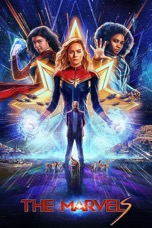
Starring: Nia DaCosta
November 2023
Warning! This is NOT a movie review. This is a critique of the film. Intended to initiate a dialogue, the following analysis explores various aspects of the film and may contain spoilers. For concerns over objectionable content, please first refer to one of the many parental movie guide websites. Ratings are based on a four star system. Happy reading!
Marvel’s The Marvels is a bizarre blend of The Powerpuff Girls and Fantastic Four: Rise of the Silver Surfer (2007). What in the universe does Marvels have to do with those other, disparate properties? As with the trio of female superheroes in this movie, The Powerpuff Girls animated series features three females who use their superpowers to fight evildoers. More germane to Marvels is the second Fantastic Four flick; Johnny Storm/The Human Torch (Chris Evans) makes contact with the titular Surfer’s “flux,” which allows the Torch to switch powers with his other three teammates by touching them.
Here, the movie’s main gimmick is that Carol Danvers/Captain Marvel (Brie Larson), Captain Monica Rambo (Teyonah Parris) and Kamala Khan/Miss Marvel (Iman Vellani) are linked through a quantum level incident (administer 2 ccs of David Gerrold’s “bolognium”), which forces them to switch realities with each other every time one of them uses their superpowers. At first, this location-swapping gimmick is an exhilarating plot device. But then the novelty wears off and we realize that, behind the veneer of slick CGI, there’s very little story here.
The movie gets a little dramatic mileage out of Capt. Rambo’s bitterness toward Capt. Marvel. Capt. Rambo was a young girl when Capt. Marvel told her she’d be right back…now she’s a grown woman. But in a universe where 5-year “blips” occur, shouldn’t people expect the periodic absence of their heroes?
A more enjoyable story element is Miss Marvel’s idolization of Capt. Marvel—the former’s bedroom is a veritable shrine to the latter. However, as with the randomized reality-jumping gag, this hero worship subplot grows tired midway through the movie. At least Miss Marvel apologizes to Capt. Marvel at one point, saying, “I didn’t give you enough space to be a person.” Guess Miss Marvel is a budding psychiatrist.
For my money, the most engaging part of the story is when Dar-Benn (Zawe Ashton, who plays one of the weakest villains in the Marvel panoply) uses quantum singularities to steal air from one planet, water from another and sunlight from still another planet, in order to restore her devastated planet. To quote Spock, this is a “fascinating” concept. Most Marvel movies feature the destruction of cities and planets. Here, it’s about ravaging worlds by siphoning their natural resources. It’s like water, horse or cattle theft in the Old West, but on an epic scale.
Other than exuberant Vellani and her lively Pakistani-American family (who steal the show), most of the actors sleepwalk through the film. Larson looks bored. And why wouldn’t she be…her character is virtually indestructible (the “Superman Paradox” but without even a shard of kryptonite to serve as a check to her invincibility). Parris does her best to look miffed, but Capt. Rambo’s anger toward Capt. Marvel feels forced and petty.
The most tenured member of the troupe, Samuel L. Jackson, delivers a “wooden” performance that’s redefined the meaning of the term. His acting is as stiff as his gait. The writers (Nia DaCosta, Megan McDonnell and Elsa Karasik) also fail Jackson since much of Nick Fury’s dialog consists of snarky one-liners, most of which land with all the subtlety of Thor’s hammer.
The biggest laughs in the movie involve the alien cats (relax, this isn’t a spoiler since we’ve seen one of them in an earlier Marvel movie). Though the frenetic feline fire drill on the space station provides some much-needed levity, their role in saving the station’s passengers is as obvious as Capt. Rambo’s fate at the end of the film (a major nitpick since, as an astronaut, she should know that spatial rifts have two sides).
Though the film’s “girl power” aspect will appeal to some audience members (but is this movie really just a corrective to the largely male-dominated Avengers movies?), there isn’t anything ground-breaking here. Sadly, the movie’s amazing production values are offset by a weak script and uninspired acting. It’s another mediocre outing by a studio that, more times than not in recent years, has failed to live up to its name.
Rating: 2 out of 4
Strange World (PG)
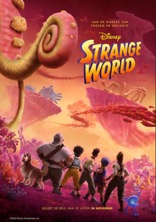
Starring: Jake Gyllenhaal
November 2022
Warning! This is NOT a movie review. This is a critique of the film. Intended to initiate a dialogue, the following analysis explores various aspects of the film and may contain spoilers. For concerns over objectionable content, please first refer to one of the many parental movie guide websites. Ratings are based on a four star system. Happy reading!
“To explore strange new worlds. To seek out new life and new civilizations.”
That was always my favorite part of the opening narration from the original Star Trek TV series.
It seems clear that the new Disney animated sci-fi film, Strange World, derives its name from the above quote.
Unfortunately, Star Trek this ain’t.
The film opens with a back story involving a group of explorers ascending an icy peak. The headstrong leader of the expedition, Jaeger Clade (Dennis Quaid), is adamant about searching beyond the mountains. His son, Searcher Clade (Jake Gyllenhaal), wants to return home to study a plant he found that gives off energy. Jaeger strikes out on his own, leaving his son behind with the rest of the team.
25 years later: Searcher is hailed as the discoverer of pando, the “power plant” that provides electricity for the entire city of Avalonia. But when the energy-producing green pods on the pando plant start dying, Searcher is enlisted to join a team that will determine the root of the problem deep below the planet’s surface. When their ship arrives at a strange new world, Searcher and his fellow explorers, including his son Ethan Clade (Jaboukie Young-White) and wife Meridian Clade (Gabrielle Union), encounter an array of bizarre creatures—some benign and others hostile.
You guessed it; Strange World is riddled with clichés and references to classic adventure yarns of yore.
When the ship descends through a giant hole and enters the bowels of the planet, we’re reminded of Journey to the Center of the Earth (1959, 2008). When the explorers fight their way through gross creatures, we’re reminded of King Kong (particularly the disgusting giant insect scenes in Peter Jackson’s 2005 remake). When Searcher and Ethan learn that the island (eye-land) they live on is really a gigantic life form, they realize the creatures inside its body are merely red blood cells and antibodies; navigating the ship through these microorganisms to the being’s giant heart is reminiscent of Fantastic Voyage (1966).
Strange World weaves the theme of yet another classic novel into its story: Moby Dick. Jaeger’s obsessive quest to reach the other side of the mountain causes him to abandon his wife, son and the rest of his team. This Captain Ahab style character flaw was also present in the title character of this year’s Pixar release, Lightyear. Perhaps Disney/Pixar should give this particular literary allusion a rest for a while.
The movie’s creativity is one of its bright spots. Though the overall aesthetic is decidedly Seussian, some of the creatures in the strange land are cleverly and beautifully realized. This is particularly true of the blue, stretchy blob that Ethan names Splat (yep, a toy version of the creature has been mass produced by Disney in anticipation of the holidays).
What’s disappointing, though, is that the movie doesn’t take the time to properly showcase its many inventive invertebrates. Writer/Director, Qui Nguyen, must have ADD, because he rushes from one bizarre creature to the next without giving us a chance to really enjoy the teeming life or immersive environment of the imaginary world. Despite its cornucopia of colorful creatures, the movie fails to awe…which is a prerequisite when constructing a strange new world.
The movie also shortchanges the dramatic potential of having three generations of men as its central characters. Yes, there are a few meaningful moments, like when Jaeger teaches Searcher how to throw and Ethan how to use a flamethrower, but the movie’s attempt at establishing generational reconciliation as a theme falls flat. At different points in the movie, Searcher calls Jaeger a bad dad and Ethan says the same to Searcher, despite the fact that Searcher has spent his entire life trying to be the opposite of Jaeger. It’s ironic how we often become that which we despise.
The closest we get to a warm fuzzy ending is when Jaeger tells Searcher, “My legacy isn’t those mountains, it’s you.” Since Jaeger never made an attempt to return to his wife and son during his 25 year absence, that sentiment seems hollow and too little too late. Ultimately, the movie doesn’t deliver that one satisfying moment to button up the story and leave us with a smile on our face as we exit the theater.
The ending isn’t the only area of the movie that wasn’t satisfying.
Personal confession: there are few things in life that infuriate me more than adult advocates forcing their politics and worldview onto kids by using an animated movie as a vehicle. Such an approach is pathological. Sadly, it’s nothing new.
Perhaps you’ll recall FernGully: The Last Rainforest (1992), an animated movie that glorifies magical fairies who live in a forest, and vilifies humans who are polluting the environment and cutting down trees with a “monster” bulldozer.
In Happy Feet (2006), Mumble’s (Elijah Wood) inability to sing, and ability to tap-dance, makes him a deviant among fellow penguins…a thinly-veiled reference to homosexuality. Also, the movie casts humans in the role of the antagonists both when human researchers invade the penguin’s island and imprison Mumble in an arctic exhibit, and when overfishing practices in the Antarctic are called into question.
What marred those earlier animated films also afflicts Strange World. In fact, my harsh critique of Happy Feet also applies to this film. In my review I wrote:
“…the movie’s political slant is so transparent and so in-your-face, it’s almost nauseating. How cowardly of leftist Hollywood and environmentalist wackos to use an animated film to espouse, disseminate and otherwise foist their alarmist and fear-mongering doctrine upon audiences; offending many adults and unduly influencing the minds of future generations with a ‘green’ theology.”
My, how I miss that fiery young man!
(Note: Spoilers in this section). So how does Strange World seek to corrupt the minds of youngsters? In a very crafty way.
As the source of all power in Avalonia, harvesting pando is vital for the society to function. When the characters learn that their civilization has been built upon a living being, they’re faced with a fateful decision: in order to save the creature, they must destroy the pando roots that are killing the creature’s heart.
The movie ends one year after the pando roots have been eradicated. A voiceover narration praises people for their ability to be resourceful in the face of hardships. Everyone lights a candle and the entire village has a Kumbaya moment, happy in the knowledge that their sacrifice has saved their planet.
To the discerning eye, the analogy here is plain: pando = petroleum/oil/fossil fuels. Fossil fuels, the movie (and liberals) argue, is killing our planet (Mother Earth/Gaia). The only way to save our planet, then, is to go back to the way things were before we started using fossil fuels, or to embrace Green sources of energy.
Aside from the fact that the science behind Green energy (wind turbines, electric vehicles, etc.) hasn’t been satisfactorily explained or verified, most conservative estimates suggest it will take us at least 20-30 years to fully switch over to Green energy.
But the movie paints a very different picture. It suggests that we should just turn off the electricity and light a candle—the transition from fossil fuel-based energy to Green energy is just the easy. The movie’s conviction that a shift from one form of energy to another can be accomplished in just a year without any major complications (such as a breakdown in society that can lead to a violent upheaval) isn’t just egregiously disingenuous, it’s downright dangerous.
But don’t just take my word for it. Director Nguyen says, “Two things that are always a battle are the conveniences of today versus the need for tomorrow. If we lost certain energy sources, it would make things harder, but ultimately might be better for the world and make the future last.” There you have it; the movie is conditioning our children to prepare for less convenience and more hardship in the future.
No matter which side of the debate you fall on, you have to admit that this underhanded dig at fossil fuels is done in a deceptive manner, and is propagated for the sole purpose of indoctrinating young viewers. The movie is trying to convince them that to save the planet, we must end fossil fuels and adopt Green energy. Anyone who disagrees with that agenda is complicit in dooming the planet. You can see how this flawed ideology can create a militant activism in today’s kids/tomorrow’s leaders.
This begs the question: why is such a controversial subject being broached in an animated movie? Also, is it fair to take sides on an issue that kids should be given the right to choose on their own, preferably when they’re older? The way this film seeks to indoctrinate young members of the audience is downright malicious.
At the risk of overstating my central thesis, I’d like to share another tidbit from my Happy Feet review, which is also germane to this film: “…it’s really children who are losing out the most here; for their sake, why can’t Hollywood check its politics at the door and let kids make up their own minds about where they stand on environmental issues…when they’re old enough to do so?” Of course, this argument also applies to the film’s (and our government and education system’s) aggressive push to hypersexualize young people and make alternative lifestyles attractive to kids who are still learning their multiplication tables.
Despite its innocent trappings, this film is the Green New Deal writ large. By packaging its blatant, heavy-handed message into a disarming, cutesy kid’s story, the studio has made its mission clear: to indoctrinate the next generation with a pro-homosexual, pro-Green energy agenda. It’s insidious!
In the end, the only thing strange about Strange World is its twisted, perverse and overly-ideological worldview.
A more fitting title would’ve been Woke World.
Last Item: The new “Disney 100” opening animation is beautiful and magical; a jaw-dropping sequence that would make Walt proud. But the way his studio is propagandizing innocent, young kids is surely causing poor ole Walt to roll over in his grave.
Rating: 2 ½ out of 4
Black Panther: Wakanda Forever (PG-13)

Starring: Letitia Wright
November 2022
Warning! This is NOT a movie review. This is a critique of the film. Intended to initiate a dialogue, the following analysis explores various aspects of the film and may contain spoilers. For concerns over objectionable content, please first refer to one of the many parental movie guide websites. Ratings are based on a four star system. Happy reading!
The sequel to Black Panther (2018) opens with T’Challa’s (Chadwick Boseman, a fine actor who left us far too soon) funeral. Though appropriately somber, the sequence is beautifully filmed.
Sadly, the melancholic opener permeates the entire film. Much of the movie is bleak and dark—director Ryan Coogler carried the theme of mourning too far by shooting most of the first hour at night. These scenes include an assault on a deep sea drill platform, a showdown on a city bridge and Shuri (Letitia Wright) and Ramonda’s (Angela Bassett) first encounter with Namor (Tenoch Huerta).
For those unfamiliar with that name, Namor (aka The Sub-Mariner) is to Marvel what Aquaman is to DC. One twist with the Marvel character is that he can achieve flight with the assistance of tiny flapping wings on his ankles…why not? A curious decision by the studio was to make Namor of South American descent (a decision based on diversity?). Another unexpected twist is when Namor reveals his true identity as a Mayan god.
Many of the movie’s scenes take place in Namor’s underwater kingdom or in/around water. Is there a theme here, or just a plot device to keep the audience feeling the pressure and gasping for air (psychologically)? One wonders if the extensive water scenes were a conscious decision to contrast the action here with the largely landlocked original film.
One also wonders if the epic battle at the end of the film is symbolic. Namor’s soldiers of South American descent and Wakanda’s warriors of African ancestry battle it out with nary a Caucasian in sight—Everett Ross (Martin Freeman), the token white guy, has a few scenes in the movie but nothing substantial. Though white people, typically vilified as warmonger colonizers, aren’t directly involved in the conflict, some of them are the instigators of the massive melee; they’re mining a recently-discovered vein of vibranium, the mineral that allows Wakanda to remain a hidden, technologically-advanced society.
It never dawns on Namor’s brackish brawlers or Wakanda’s fierce fighters that they should join forces against their true enemy…the American government, which seeks to exploit vibranium for its own nefarious purposes. Namor and Shuri finally come to an agreement, but only after thousands have died; the resolution itself is so obvious, any simpleton could’ve come up with it at least an hour earlier in the story.
Shuri’s character arc is similar to T’Challa’s in the first film—a journey of loss and self-discovery that eventually leads to the fateful decision to accept the mantle of Black Panther. These character moments help to ground a film that lists on the ocean of story possibilities, casting about until it settles on the clichéd climactic conflagration. In the end, I’m really not sure what message the film seeks to impart or what it accomplishes, other than to anoint another eponymous hero to fight evil and defend Wakanda…in yet another sequel.
Marvel’s end credits bonus scenes are typically “Ah ha!” moments for comic book junkies; revealing some object, character or story point to tease a future film. In Black Panther: Wakanda Forever, the coda is a really good character scene (perhaps the best in the film) that features some real emotions and answers a nagging question posed earlier in the story.
This Hallmark moment is a radical departure from the standard tag scenes and is a welcome change for anyone like me, who long ago succumbed to Marvel Fatigue.
Rating: 2 out of 4
Jurassic World: Dominion (PG-13)
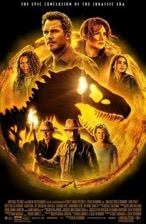
Starring: Chris Pratt
June 2022
Warning! This is NOT a movie review. This is a critique of the film. Intended to initiate a dialogue, the following analysis explores various aspects of the film and may contain spoilers. For concerns over objectionable content, please first refer to one of the many parental movie guide websites. Ratings are based on a four star system. Happy reading!
Believe it or not, Ripley, this is the sixth movie based on Michael Crichton’s 1990 novel “Jurassic Park.” What’s more, this is the third movie in the Jurassic World trilogy—the supersized spawn of the Jurassic Park trilogy.
Jurassic World: Dominion opens in the same globetrotting manner as Crichton’s original book. From a giant locust swarm in South Texas, to the snow-covered Dolomite Mountains in Italy, to the forested Sierra Nevada Mountains, to the sweltering Mediterranean island of Malta, the movie covers a lot of territory. Sadly, despite its many exciting locations and events, the movie fails to blaze any new territory narratively.
The story eventually brings us to characters we know; Owen Grady (Chris Pratt) and Claire Dearing (Bryce Dallas Howard) are raising clone girl Maisie Lockwood (Isabella Sermon). Much like Ariel from The Little Mermaid or Hanna from the eponymous 2011 movie and 2019 TV show, Maisie wants to be where the people are. Owen and Claire are overprotective parents, but who wouldn’t be when every tech company on the planet would love to get their hands on Maisie, the first human clone? Oh, and pay no mind the raptors romping through the forest near Owen’s cabin. They’re trained.
Jump to a reunion scene with Alan Grant (Sam Neill) and Ellie Sattler (Laura Dern). Ellie tells Alan she’s recently divorced—cue the love story. The doctors are invited to visit the top-secret genetics lab, Biosyn (what a pun! Bio-sin, i.e., messing with the natural world is a transgression).
At Biosyn, Alan and Ellie are reunited with another long-lost friend, Ian Malcolm (Jeff Goldblum). They also meet the head of Biosyn, Dr. Lewis Dodgson (Campbell Scott). You might recall that name from the first Jurassic Park (1993). He’s the one who paid Dennis Nedry (Wayne Knight) to steal the dino embryos and deliver them in a Barbasol shaving cream can. Picking up this loose narrative thread from the original film is one of the movie’s finest moments.
But the thrill of getting the band back together again soon wears off and we realize that Ian’s quirky sense of humor hasn’t aged well (unlike the svelte actor portraying him). Though the romantic tension between Alan and Ellie is sweet, it’s also terribly predictable with nary a complication to keep us guessing.
And speaking of predictable, the paint-by-numbers plot has a chronic case of ADD—its focus constantly shifts between sets of heroes. Regrettably for Owen and Claire, they’re frequently upstaged by the old guard…in their own movie. Plus, the action scene in Malta looks like it was borrowed from a James Bond movie, only with raptors feasting on tourists subbed in for hero vs. villain shootouts.
One of the central themes of these Jurassic Park movies is the dangers of playing God, and “Genetics Gone Wrong” is front and center in the trilogy capper. Dr. Henry Wu (BD Wong) is up to his old tricks, creating giant locusts and other DNA-spliced creatures. Hasn’t he learned from his mistakes by now? Whatever the latest catastrophe is involving dinosaurs, you can bet Henry is at the center of it. As Ian rightly points out, “It’s always him!”
Of course, these films wouldn’t keep attracting large audiences without terrifying dinosaurs rampaging through amusement parks and gobbling up humans. Many of director Colin Trevorrow’s sequences draw too much inspiration from the earlier films, i.e., characters trying to hide from a large, carnivorous dinosaur behind an overturned SUV, a la the OG film. Though this movie sees the return of the dilophosaurus, the attack scenes involving these frilled creatures are nearly identical to those in the original Jurassic Park.
Based on Alan’s theory that dinosaurs were more bird-like than reptile-like, some of Henry’s new GMDs (genetically modified dinosaurs) are avian in appearance. Unfortunately, a giant creature with feathers doesn’t evoke the same sense of dread that a “terrible lizard” does.
In the end, even the team lift of old and new characters can’t hoist Dominion out of the swamp of failed creature features. It will go down as the worst of the lot.
However, depending on how current events play out, Dominion’s warning of an impending global food shortage may give it unforeseen relevance.
So, now that we’ve had Jurassic Park and Jurassic World, what’s next? Jurassic Universe?
Rating: 2 out of 4
Lightyear (PG)
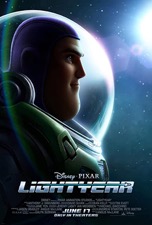
Starring: Chris Evans
June 2022
Warning! This is NOT a movie review. This is a critique of the film. Intended to initiate a dialogue, the following analysis explores various aspects of the film and may contain spoilers. For concerns over objectionable content, please first refer to one of the many parental movie guide websites. Ratings are based on a four star system. Happy reading!
Buzz Lightyear (Chris Evans), Commander Hawthorne (Uzo Aduba) and Rookie Featheringhamstan (Bill Hader) explore an unknown planet, but are forced to make a hasty departure when they’re attacked by vine creatures. Buzz can’t quite steer the ship over the top of a jagged peak and the vessel crash lands on the inhospitable world.
One year later, a small base has sprung up around the ship, constructed by the ship’s crew who’ve been roused from their suspended animation naps. These industrious colonizers also have designed an experimental spaceplane that might be able to achieve hyperspeed, which will allow Buzz to bring his crew home and complete his mission.
With each unsuccessful mission, Buzz returns to the base to find that everyone has grown older. When Buzz finally achieves hyperspeed, he comes home, not to pomp and circumstance, but to the grim reality that the descendants of his original crew have been wiped out by an army of malevolent robots.
Does that synopsis make Lightyear sound kinda’ ho-hum and hard to follow for a kid’s movie? It is.
If you find the story difficult to track, try to understand the reasoning behind the movie’s “meta” introduction, which tells us that young Andy from Toy Story (1995) first idolized his favorite toy (Buzz, not Woody apparently) by watching a movie starring the Space Ranger, and that “This is that story.” So, just to be clear, we’re watching an animated movie about an action hero that a kid in another animated movie once watched; and his toy, based on that action hero, becomes the co-star of four films. Somebody pass the Advil.
The opening sequence of Toy Story 2 (1999) features a brief episode where Buzz takes out an army of robots and encounters the villainous Zurg. The action-packed sequence cleverly sets up the climactic confrontation and starts the movie off with a bang.
As exhilarating as the pulse-pounding preamble is in Toy Story 2, I couldn’t have handled an entire movie in the same format and style. Though the story here isn’t nearly as pedestrian as the breakneck pace of the dramatized video game in Toy Story 2, there’s an overall campiness the film’s handful of decent character moments can’t quite overcome.
Lightyear serves as an origin story for Buzz Lightyear and a loose prequel to the Toy Story movies. It gives us more details about the way Star Command and its Space Rangers operate. However, despite some nifty weapons, like the laser blade, and sweet-looking ships, like the XL-15, much of the movie is a pastiche of other sci-fi franchises, particularly Star Wars and Star Trek.
Buzz’ mission logs are an obvious rip-off of the captain’s log in Star Trek. Also, the visuals when the XL spaceship attempts to slingshot around a sun are remarkably similar to the slingshot sequences in Star Trek IV: The Voyage Home (1986).
Other than their bright yellow paint-job, the hulking Zyclops robots bear more than a passing resemblance to the super battle droids in the Star Wars prequels. The capital ship Zurg commands is reminiscent of an Imperial Star Destroyer (the Arquitens Class command cruiser in particular). Buzz and his team come up with a plan to destroy the mother ship, which will deactivate all the robots. This plan is virtually identical to the one hatched by the Gungans and the Naboo to destroy the Trade Federation ship, which deactivates all the battle droids in Star Wars: Episode I – The Phantom Menace (1999).
Aside from leaning on well-worn sci-fi tropes, the movie attempts to explore some adult themes, with varying degrees of success. The challenges inherent in colonizing an alien planet are addressed obliquely and the dome-like protection, called “Laser Shield,” prevents a lot of dramatic tension and potential action scenes.
Adding some literary heft, the movie weaves an allusion to Moby Dick into its plot. After repeated failed attempts to reach hyperspeed, Buzz realizes his friends are getting older and are having kids and grandkids. At some point you’d think Buzz would stop, turn the mission over to a younger pilot and spend some quality time with his aging friends. But no, Buzz’ pride won’t allow that.
Breaking the hyperspeed barrier in his spacecraft is Buzz’ white whale. He risks everything to reach that goal. In the end, his obsession blinds him to what’s most important in his life.
Sadly, Buzz never gets to say goodbye to Hawthorne and his other friends because he’s off flying a mission when they pass away. It’s a poignant moment for the audience, as we place ourselves in Buzz’ boots and consider the brevity of life—if the movie has an emotional core, this is it.
Other than the secondary themes of obsession and growing old, the movie’s main theme, which is hammered home over and over again in the dialog, is Buzz’ independence.
Buzz isn’t very likable at the beginning of the film. He’s arrogant, controlling (he resists turning things over to an autopilot) and overconfident (Buzz’ overestimation of his piloting abilities is what causes the ship to crash, which is the inciting incident for the movie’s many complications). He makes condescending remarks about the rookie and ignores the young man’s frequent offers to lend a hand. In essence, Buzz is John Wayne in space.
Buzz’ narcissism is on full display when he makes mission logs. Dictated like a dramatic reading, these oft-embellished recordings are just to make him look good in the eyes of his superiors. Hawthorne calls out Buzz’ compulsion to record their missions and refers to his habit as “narrating” (not to be confused with “monologuing” in The Incredibles). The fact that Hawthorne tells him no one listens to his recordings fails to dissuade Buzz from making log entries throughout the rest of the movie. Add stubbornness to Buzz’ list of negative character traits.
As was mentioned earlier, the movie’s writers work overtime to highlight Buzz’ independent nature. At one point, Buzz says, “I’m better off doing the job by myself.” Later, he says, “I’m always sure.”
Fortunately, Buzz comes to see the value of team. He gradually abandons his desire to control everything. He learns to accept the ideas of others and even delegates responsibilities he’d normally shoulder himself. Buzz’ loner leader turned team player story arc culminates with this admission, “I can’t do it alone. I need help.” Buzz’ transformative realization is also germane for the audience; we all need others in our life.
Lightyear is a disappointment on many levels. It contains the merest fraction of the movie magic that made the Toy Story franchise so wildly popular with kids, parents and critics alike.
Thematically, the movie is very adult; aesthetically, it’s very dark. There’s little levity, and only a few funny lines, in the movie. Plus, the hero isn’t very heroic for the first half of the film.
Though the production elements are top-notch, the story is lacking. I expect much more from Pixar (the quality of their movies has steadily declined since Disney bought the animation studio).
Still, Lightyear is educational. It teaches us the proper way to make a meat sandwich. It references some real science too, like relative velocity and time dilation…pretty ambitious for a kid’s movie.
It also leaves us pondering the big questions about life and the universe.
Like, what’s beyond infinity?
Rating: 2 ½ out of 4
Doctor Strange in the Multiverse of Madness (PG-13)
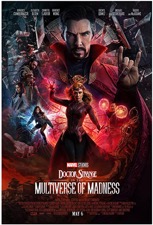
Starring: Benedict Cumberbatch
May 2022
Warning! This is NOT a movie review. This is a critique of the film. Intended to initiate a dialogue, the following analysis explores various aspects of the film and may contain spoilers. For concerns over objectionable content, please first refer to one of the many parental movie guide websites. Ratings are based on a four star system. Happy reading!
Doctor Strange in the Multiverse of Madness definitely resembles its name. It’s equal parts strange and mad. As if that wasn’t bad enough, everything in the film feels…off.
There are very few funny lines, very few meaningful moments and very few exhilarating action sequences in the movie. Then there’s the 60/40 split between scenes centered on Doctor Strange (Benedict Cumberbatch) and Wanda Maximoff/The Scarlet Witch (Elizabeth Olsen). Strange had to share screen time in Spider-Man: No Way Home (2021) too, but that movie was a vehicle for the wall-crawler in the red spandex suit.
Taking Strange’s screen time in No Way Home and adding it to his screen time here, he almost gets an entire feature out of the two Multiverse movies. In short, it seems like Strange always ends up playing second fiddle to other characters in the Marvel panoply—he’s even sidekick to Wong, the Sorcerer Supreme (Benedict Wong), in his own movies.
As with the scribes of No Way Home, screenwriter Michael Waldron barely scratches the surface of the creative potential of the Multiverse here. In one of the alternate realities Strange visits, you “go on red” when crossing the street…a pretty mundane change from our reality. Yes, the tree-strewn city is an interesting concept, but the Mustafar-like hellscape and LOTR-style tower, where the Scarlet Witch takes her throne, are derivative and uninspired.
The one part of the movie that was cleverly conceived was Strange and America Chavez’ (Xochitl Gomez) plunge through several planes of the Multiverse; in one reality they become sentient splotches of paint. Though skillfully realized, this short segment is reminiscent of when the Infinite Improbability Drive is engaged in The Hitchhiker’s Guide to the Galaxy (2005)—the sequence where the crew of the Heart of Gold is turned into hand-knit toys is bloody brilliant!
As portrayed in the movie, the Multiverse fails to tap into the vast expanse of possibilities inherent in its name. I’d go on a rant about the lack of wonder, awe and imagination on display in the film, but I couldn’t possibly top the incisive remarks I made in my review of No Way Home (please reference it for a detailed drubbing of that movie’s mammoth mishandling of the Multiverse).
So, what’s this movie about? Good question.
The story’s character arcs are pedestrian and prosaic. Wanda must let go of her obsessive maternal instinct—she’s willing to destroy anything that prevents her from raising her two boys, including alternate versions of herself. Not very rational.
Doctor Strange’s integrity is called into question…will he turn to the Dark Side (a la, Anakin Skywalker) or will he prove to be virtuous, unlike many of his counterparts from other realities? As if there could be any doubt.
These ho-hum challenges for the central characters provide little opportunity for personal growth—this is as complicated as the film gets. I wish America, who has the ability to open star-shaped portals into the Multiverse, would’ve transported us into a more compelling story.
The secret group called the Illuminati, brings some much-needed energy and levity to the proceedings. The casting of this team of eclectic heroes is superb and offers more than a few surprises.
Multiverse of Madness squanders the solid handoff from the first film. Even the Doctor Strange spotlight episode in the animated series What If…? is superior to this film.
In the end, this latest foray into the Mediocre-verse is another indication of how the studio is failing to live up to its name.
Rating: 2 ½ out of 4
Spider-Man: No Way Home (PG-13)
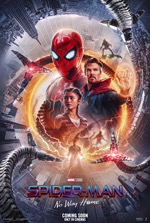
Starring: Tom Holland
December 2021
Warning! This is NOT a movie review. This is a critique of the film. Intended to initiate a dialogue, the following analysis explores various aspects of the film and may contain spoilers. For concerns over objectionable content, please first refer to one of the many parental movie guide websites. Ratings are based on a four star system. Happy reading!
Spider-Man: No Way Home has opened up a whole new narrative dimension for the MCU—the multiverse.
The multiverse concept certainly isn’t new; the earliest physics-related usage of the word can be traced back to a 1963 sci-fi story. Of course, the notion of alternate or intersecting realities has been extensively plumbed in sci-fi and fantasy books/TV shows/movies such as Star Trek (the “Mirror Universe” and TNG’s “Parallels”) and Sliders…among many other examples.
Sadly, screenwriters Chris McKenna and Erik Sommers barely scratch the surface of the infinite plot possibilities inherent in the multiverse concept. Indeed, such a wide open story device should’ve been expanded to far greater creative frontiers (reference Piers Anthony’s “Mode” series) than what’s presented in this pedestrian yarn: a teenage angst opener gives way to a bleeding heart middle which sets up the mash-up melee ending.
In an ironic twist, the story is dependent on Dr. Strange (Benedict Cumberbatch) but conveniently sidelines him for most of the film (for fear that he’ll upstage the kid running around in red tights, no doubt). Strange’s spell, destabilized by Spider-Man/Peter Parker’s (Tom Holland) multiple modifications to his incantations, opens a rift in space/time that allows the multiverse to come spilling into our plane of reality. Moral: alter the witch’s brew at your own risk. Corollary: beware the consequences of playing God.
What begins as a clever assemblage of heroes and villains from every previous Spider-Man movie (and what a treat it is to see Willem Dafoe, Alfred Molina, Jamie Foxx, et al. together on one set!) morphs into a rehabilitation experiment gone wrong (of course). The resulting protracted battle, which is all over the place and isn’t nearly as exhilarating as it should’ve been, features too many confrontations with too many characters and ends up being a sticky, tangled mass…much like a spider web.
While it’s fun to see all three Spider-Men (Tobey Maguire, Andrew Garfield and Holland) sharing screen time, the dialog is often hokey, jokey and repetitive (why do McKenna and Sommers keep harping on the fact that Maguire’s Spidey can naturally produce webs while Garfield and Holland’s wall-crawlers must manufacture theirs?). In many of these arachno-trio sequences, the opportunity for the heroes to learn from each other is eschewed in favor of frivolity and fan service. So much character development could’ve been mined in these scenes. What a whiff!
The one aspect of the movie that stimulated my gray matter was talk show host J. Jonah Jameson’s (J.K. Simmons) blustery commentary that bookends the film. At the beginning, with Spider-Man’s identity recently revealed, Jameson regards Parker as public enemy #1. At the end, after the timeline has been (mostly) restored, Jameson calls Spider-Man a coward for hiding behind a mask.
Not only does such choleric rhetoric illustrate the plight of a hero in the eyes of a fickle public, it accidentally stumbles upon a telling socio-political message: the media, it would seem, is complicit in inciting bigotry and hostility in any universe.
This movie caps off a trilogy where each installment has gotten exponentially worse. Many aspects of the movie are gimmicky, which is fitting since the entire plot is built on a gimmick (the multiverse). No Way Home squanders a promising premise and underserves a tremendously talented cast.
The word “Home” appears in the titles of all three Holland Spider-Man movies. If the next film in the series isn’t any better than this one, they should name it Just Stay Home.
Rating: 2 out of 4
Dune (PG-13)
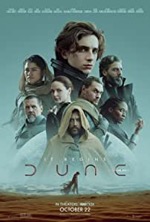
Starring: Timothee Chalamet
October 2021
Warning! This is NOT a movie review. This is a critique of the film. Intended to initiate a dialogue, the following analysis explores various aspects of the film and may contain spoilers. For concerns over objectionable content, please first refer to one of the many parental movie guide websites. Ratings are based on a four star system. Happy reading!
The Padishah Emperor has ordered House Atreides to pack up and move from temperate timberland, Caladan, to arid sandbox, Arrakis. The cosmic house swap is completed when rival House Harkonnen abandons Arrakis for the incoming House Atreides. And so begins an era of peace and prosperity on the Atreides-ruled Arrakis. Guess again!
A member of the Atreides’ inner circle is a traitor. The conspirator arranges for a combined Harkonnen and Sardaukar (Imperial elite soldiers) army to slip into the capital city, Arrakeen, at night. Many Atreides warriors are lost in the battle. Those who survive learn, too late, that they were set up from the start.
That bare bones description of Dune, the latest cinematic envisioning of Frank Herbert’s seminal science fiction novel, is only half of the overall story since this film is the first of two parts.
If you struggled to digest the above synopsis, know that it was even more challenging to summarize Herbert’s sprawling epic. Aside from its Machiavellian intrigue, planet-hopping plot, coming-of-age subplot and pseudo-religious underpinnings, the story’s expansive glossary of terms (ornithopters, hunter-seekers, stillsuits, in addition to all the proper nouns listed above) is enough to give you a brain freeze…even on Arrakis.
A world (universe) so rich in different races, beliefs, creatures, weapons and cultures brings to mind another fictional masterwork, J.R.R. Tolkien’s The Lord of the Rings trilogy. In fact, it isn’t much of a stretch to say that Dune is to science fiction what The Lord of the Rings is to fantasy. They’re the high-water marks of their respective genres.
For all the diehard, deep cut Dune fans out there, I don’t claim to be an expert on the subject. However, I’ve seen David Lynch’s 1984 film (several times), the mini-series that aired in 2000 on the Sci Fi Channel (now Syfy), and have listened to the unabridged audiobook. That said, take my comments with a grain of sand…or salt.
Director Denis Villeneuve (Blade Runner 2049) has assembled an impressive ensemble of performers. Yet, some of the parts seem miscast. For instance, Timothee Chalamet (Paul Atreides) is ten years older than his character and seems too brooding for the part. Oscar Isaac (Leto Atreides) is too hard-edged and fails to capture the world-weary aspect of the character, as portrayed in the book.
In my opinion, Jason Momoa and Dave Bautista don’t fit their parts and were brought in merely to shore up the movie’s action scenes (and to attract fans of their other movies). I’m conflicted about Josh Brolin as Gurney Halleck. Javier Bardem and Stellan Skarsgård are perfect in their roles. The women are fabulous, especially Rebecca Ferguson as Lady Jessica and Charlotte Rampling as the Reverend Mother.
Dune is a visually breathtaking film. The set design, particularly the interiors of the Arrakeen buildings, is nothing short of inspired and lends the film an aesthetic that’s familiar (based on human architecture), yet otherworldly. The costumes, weapons and technology are all well crafted and seamlessly blend into the story’s milieu.
Particularly striking is the film’s array of surface and space-faring ships. The dragonfly-like ornithopters are fun to watch as they flit over dunes and mountains. The harvesters fit the bill as large cargo vessels with tank treads to help them slowly amble across the desert terrain.
With their immense size and angular designs, the capital ships are utterly jaw-dropping. They have an almost physical presence when ominously hovering above the surface. The surreal atmosphere created in these scenes is similar to the effect Villeneuve achieved in Arrival (2016) with his massive, obsidian, contact lens-shaped alien ship.
Despite its stellar production, this film isn’t everything I’d hoped it would be. Compared to the film’s massive scale, the characters seem small and insignificant. Indeed, the characters are swallowed up (as if by a giant sandworm) by the expansive sets and the sheer magnitude of the story. Character moments are few and seem insignificant against the backdrop of interstellar war.
Even the action sequences are uninvolving and (here’s something I never thought I’d say) too short. To provide an omniscient view of the battles, many of the scenes were filmed from a distance. As a consequence, the audience doesn’t get to feel the pulse-pounding intensity of close combat or experience the jeopardy that comes with following the main characters through the battle (e.g., the melees in The Lord of the Rings). The notable exception is when Momoa’s Duncan Idaho sacrifices himself Boromir-style to give his friends time to flee the rapidly approaching Sardaukar.
As with many movies, the biggest drawback here is the story; the screenplay was adapted by Villeneuve, Jon Spaihts and Eric Roth. Though their script remains faithful to the source material (in most respects), the writers focused their attention on servicing the fans more than clarifying story elements for the newcomers. Granted, the narrative can be confusing, even to the initiated, but the writers failed to provide adequate context for the story’s plethora of planets and peoples. They dole out bits of exposition at a pace that might lose some spectators. If I wasn’t already familiar with the world of Dune, I would’ve been thoroughly confused by this presentation of Herbert’s novel.
One element that should remain invisible in any movie is the score. As a rule, noticing the music isn’t a good thing, because it can pull you out of the reality of the film. Much of Hans Zimmer’s score for Dune is like listening to an army of rhythmically-challenged people pounding on metal garbage can lids with turkey legs. This type of grating, banging, industrial sounding accompaniment, complete with screaming electric guitars, is fitting for the handful of Harkonnen scenes, but not for the bulk of the score.
Some of the music is noteworthy; Middle Eastern sounds are used for the Fremen scenes and there’s a beautiful passage with a soprano during one scene. But overall, the word I’d use to describe Zimmer’s score is “obnoxious” (or perhaps just “noxious”). I recently purchased his soundtrack for No Time to Die which is way, way better (and far more listenable) than this effort.
Despite being the best visualized version of Herbert’s classic, this presentation of Dune is a mild disappointment. Unlike its scorching hot environs, the story is cold and aloof, offering insufficient context and scant character development. In a strange paradox, the film manages to be both awe-inspiring (production) and uninspiring (story).
The ending leaves the audience lost in the desert. We’ll see if they find their way back to the theater for Dune, Part 2.
Rating: 3 out of 4
Tenet (PG-13)
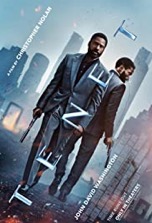
Starring: John David Washington
September 2020
Warning! This is NOT a movie review. This is a critique of the film. Intended to initiate a dialogue, the following analysis explores various aspects of the film and may contain spoilers. Views are my own and elaborate on comments that were originally tweeted in real time from the back row of a movie theater @BackRoweReviews. For concerns over objectionable content, please first refer to one of the many parental movie guide websites. Ratings are based on a four star system. Happy reading!
“To the degree that it’s not plot, any experimental structure will call attention to itself and often seem visibly artificial. So it has to be managed carefully or the story, the human content, will become secondary to the style. The story may even disappear altogether, lost in the clever externals of its presentation. One of the most damning things that can be said about a story is that it’s an amazing technical achievement.”
Those words come from Ansen Dibell’s Plot. Ironically, that writing resource was published in 1988, five years before CGI took a giant T-Rex leap forward in Jurassic Park (1993). How many CG era films does that “style over substance” indictment describe? A staggering number, I think (I’m looking at you Star Wars prequels).
The first thing that popped into my mind while reading Dibell’s quote was director Christopher Nolan’s Dunkirk (2017). Nolan’s depiction of the eponymous WWII debacle was a visual marvel, yet featured some of the scantiest character development in cinema history. You can read what an epic fail Dunkirk’s story was in my review.
So here we have Tenet, Nolan’s follow-up to Dunkirk. Nolan’s fascination with time (Memento and Interstellar) and the nature of reality (Inception) collide in Tenet. Sadly, Tenet resembles Dunkirk more than those earlier Nolan successes.
Tenet is a rare exception where the trailer is better than the movie. The preview establishes a time-bending reality where generically-named Protagonist (John David Washington) and Neil (Robert Pattinson) experience effect before cause. This causal reversal creates some startling visuals, particularly when we see a crashed car flip over and drive backward through freeway traffic.
However, for all its “amazing technical achievements,” Tenet is clearly missing what the Tin Man yearned for in The Wizard of Oz (1939)…a heart. Lack of heart also was the narrative Achilles’ heel of Dunkirk, which starred Kenneth Branagh (who plays villain Andrei Sator here).
Since Tenet’s sole writing credit belongs to Nolan, the movie’s dearth of genuine human moments has exposed his storytelling inadequacies; in the past, Nolan’s stories were buttressed by the superlative efforts of David S. Goyer and his brother, Jonathan. Nolan fails to reveal significant personal details about any of his characters. Without a connection to the characters, we aren’t really concerned for their safety—the same was true of the cardboard cutouts that populated Dunkirk.
Despite its intriguing premise, Tenet is a wholly uninvolving and unmoving tale due to its shallow characterizations and uninspired performances. Sad to say, but this decorated, scintillating cast is grossly underserved by Nolan’s script. Pattinson is flat, Branagh is unconvincing (especially his beard), Washington is unreasonably overconfident, and Michael Caine and Martin Donovan are mere blips on the radar (which, like tenet, is a palindrome).
Then there’s the question of where the movie’s MacGuffins come from—namely, objects that cause time to flow backwards. Are the artifacts alien in origin? The reference of “somewhere in the future” is egregiously vague (more lazy screenwriting). Also, Sator’s scheme to destroy the world is right out of a 70s James Bond movie. Nothing original here.
Though brilliantly realized, the action sequences actually undermine the film. For example, when we see a fight scene staged backwards earlier in the story, do we really need to see the same sequence played forwards later in the movie? We get the point already.
Worse still, two earlier sequences are revisited later in the movie—the freeway car chase and the melee at the airport. Returning to the same locations and sets feels like a retread and is an egregious waste of screen time, proof positive of the story’s tenuous construction. These hollow and anticlimactic action scenes may induce the sensation of déjà vu, restlessness from boredom, or both.
To the movie’s credit, it makes the audience work to figure out what’s going on—it’s the opposite of mindless entertainment. Also, the movie boasts a few exceptionally well-crafted action set pieces. These pulse-pounding sequences will leave many viewers completely satisfied, regardless of the flaccid story.
However, despite its ambitious high concept premise, Tenet is too long, too confusing and, surprisingly, too monotonous. In the end, the film is an interesting puzzle for the mind, but it isn’t an enjoyable entertainment.
The sequel, teneT, will be this movie played backwards.
Rating: 3 out of 4
Star Wars: Episode IX - The Rise of Skywalker (PG-13)
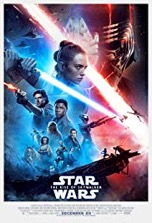
Starring: Carrie Fisher
December 2019
Warning! This is NOT a movie review. This is a critique of the film. Intended to initiate a dialogue, the following analysis explores various aspects of the film and may contain spoilers. Views are my own and elaborate on comments that were originally tweeted in real time from the back row of a movie theater @BackRoweReviews. For concerns over objectionable content, please first refer to one of the many parental movie guide websites. Ratings are based on a four star system. Happy reading!
End of an era.
Star Wars: Episode IX – The Rise of Skywalker is the ninth and final “Skywalker Saga” Star Wars movie. The series spans forty-two years. At age seven, I was squarely in creator George Lucas’ (stay on) target audience when the first movie (originally titled Star Wars, now referred to as Star Wars: Episode IV – A New Hope) was released in 1977.
These movies—and action figures, books, comic books, soundtracks, TV series, etc—have been a significant part of my life for over four decades now. I realize there are scores of fans who have been similarly impacted by Lucas’ lucrative and legendary brainchild…perhaps you, dear reader, are one of them.
Saying goodbye to such a cherished mythos, and its bevy of beloved characters, has left me in an ineffable state. Though not quite like experiencing a death in the family, reaching the end of the closing credits of the final Star Wars film feels like a loss just the same; despite the fact that the franchise will continue on both big and small screens far, far into the future. Though the quality of the movies has widely varied, I’m Luke-after-Ben’s-death despondent now that the series has finally come to an end.
As I think about Skywalker, many words and phrases come to mind…
Rally. Course correct. Back on track.
Yes, I’m one of the legions of Star Wars fans who considered the previous film, Star Wars: Episode VIII – The Last Jedi (2017), to be a Death Star sized pile of Bantha Poodoo. If you have a spare half hour, you can read my review, which contains a scalding diatribe against the film’s many failings. To bottom line it for you, if you feel the way I do about The Last Jedi, you’ll probably enjoy the series capper. If you’re in the other camp, you might struggle to enjoy Skywalker.
In all fairness, Skywalker is cameo-heavy, overly sentimental at times and rather predictable throughout. Some things don’t add up (why was the fleet of Final Order Star Destroyers concealed for so long, how can Sith loyalists operate the vessels as well as trained Imperial crews and why are the capital ships so easy to destroy once their superlasers have been blasted a few times by Resistance fighters?), other things could’ve been better (character threads, i.e. the relationships between Rey (Daisy Ridley)/Finn (John Boyega) and Finn/Rose (Kelly Marie Tran), needed to be tidied up) and still other things are utterly daft (like when the spy telegraphs his identity with “I’m the spy!”). But overall, this is a solid effort and a fitting conclusion to Lucas’ enduringly popular work of light and magic.
Spoiler Alerts (from here on in): At the heart of every Star Wars film is family, specifically the Skywalker family (family, of course, also lies at the heart of the Disney Empire). The latest trilogy has layered identity on top of family. Where does Rey come from? Can sinister Kylo Ren (Adam Driver) be redeemed and revert to his true self, Ben Solo?
As the embodiment of the yin-yang philosophy, Rey and Ren are light-dark side counterparts, respectively. It’s a fascinating role reversal that Rey descends from an evil family and becomes a Jedi, while Ren was raised by a good family and ends up a Sith. In this way, the protracted epic has modulated from being the chronicle of one family to the intersection of two Force-full families.
At several junctures in Skywalker, Rey is asked what her family name is and she awkwardly confesses that she doesn’t know (the impertinence of the little Aki-Aki girl is overdetermined since Rey’s first name should suffice for an informal introduction). At the end of the movie, Rey identifies herself as a member of the family that has loved and nurtured her all along. It’s a stirring scene that may have added spiritual significance for those who consider themselves grafted Gentiles (Romans 11:17-24).
The family theme extends beyond the movie’s characters to those in the audience. As a multigenerational family film, Skywalker will attract spectators of all ages. One way the movie has catered to its broad demographic is to give both young and adult audience members heroes to cheer for...clever.
Everyone who’s seen the trailer knows about the return of Lando Calrissian (Billy Dee Williams) and Emperor Palpatine (Ian McDiarmid). As the final film in the series, Skywalker has attracted a number of new actors (Richard E. Grant, Keri Russell and Dominic Monaghan), as well as many headliners and supporting players from the original trilogy. Be on the lookout for a well-known side character who serves as Lando’s gunner. Eagle-eyed fans may also recognize one of the franchise’s major magic-makers as the disapproving tavern owner on snowy Kijimi.
The film presents several new concepts regarding Jedi/Sith abilities. The first deals with a person’s life force. Though never featured in any prior Star Wars movie, apparently Jedis/Siths have the capacity to leach away life force from others or transfer a portion of their own life force to another being to bring about rapid healing (Wolverine style).
Though Force Healing is a clever concept, it smacks of the same kind of plot gimmick that had R2-D2 sprouting leg rockets and taking flight just when the story called for it in Star Wars: Episode II – Attack of the Clones (2002). Director J.J. Abrams and his team of writers have created a major discrepancy between their newly-minted Jedi skill and the well-established Star Wars canon. Case in point, if a Jedi has the means to heal someone else, even when that person has been run through with a lightsaber, Qui-Gon Jinn (Liam Neeson) need not have died in Star Wars: Episode I – The Phantom Menace (1999).
In a similar vein, it was revealed in earlier movies that a Jedi, with the proper training, can fade from our plane of existence, i.e. Obi-Wan Kenobi (Alec Guinness) and Yoda (voiced and performed by Frank Oz). How then, can Ren accomplish such a feat? As a recent convert to the light side of the Force, how would Ren/Ben know how to achieve a Force Fade? Even Jedi Master Jinn didn’t have that advanced knowledge…his corpse was roasted on a pyre at the end of The Phantom Menace. Someone needs to write a Jedi Handbook—comprehensively detailing every mystical or superhuman power such light side guardians possess—to prevent future writers from succumbing to this kind of willy-nilly storytelling.
The Force Dyad (Ren’s terminology) is an intriguing aspect of this latter trilogy, and is made even more compelling by the fact that Rey and the audience can see what’s going on behind Ren, but the masked villain can’t visualize Rey’s surroundings. Since Rey and Ren are connected through the Force, objects can be conveyed from one of their locations to the other. In this way, Rey handing off a lightsaber to Ren, who’s in a different part of the citadel on Exegol, is one of the highlights of the film.
However, the sequence could’ve been ten times more mind-blowing. What if Rey had temporarily lost one of her two lightsabers (or Palpatine had confiscated one of them)? The action scene plays out exactly the same, with Rey dispatching the Emperor’s guards and Ren shredding his Knights, with one major exception…
Using the Force, Rey and Ren take turns using the solitary lightsaber, passing it from one location to another while working in concert to coordinate their attacks. Go ahead; re-choreograph the entire sequence in your mind with this new limitation. Instead of another “Oh look, Rey/Ren is kicking butt and their opponents don’t stand a chance” melee, this climactic lightsaber battle could’ve been the greatest fight scene this side of The Matrix (1999).
In addition to its missed opportunities, the film contains many other oversights and nitpicks. Near the beginning of the movie, Poe Dameron (Oscar Isaac) engages in a dangerous (and dubious) piloting stunt known as “lightspeed skipping,” which involves a series of quick, successive jumps into and out of hyperspace. The maneuver, which places an inordinate amount of stress on a ship, is made even more dangerous by the fact that you can come out of hyperspace too close to an asteroid or other solid object (smuggler’s warning).
The TIE fighters pursuing the Millennium Falcon stay right on the freighter’s tail the entire sequence. How? Even though it was established in Star Wars: Episode VII – The Force Awakens (2015) that Special Forces TIE fighters have hyperdrives, how are the enemy ships able to precisely match ace pilot Poe’s every maneuver since they have no idea what he’ll do next? Either the TIE pilots are clairvoyant or they have Sith-like reflexes.
Abrams is notorious for featuring purely self-indulgent scenes (reference the two arctic creatures pursuing Kirk in 2009’s Star Trek) in his action movies. Here, Rey cuts a wing off Ren’s TIE fighter in a drawn-out spectacle. Though Rey’s Matrix-style slo-mo leap is dazzling, the rest of the scene is utterly gratuitous…and ultimately superfluous. We know Ren isn’t going to fire on Rey, so why does he attempt the low-altitude flyover? Especially since he risks losing his ship (and his life—surely he would’ve gotten a concussion from that crash) in the process.
Ren exits his mangled cockpit (without a scratch, mind you) and gets into a tug-of-war with Rey. Instead of rending a lightsaber, as they had done in The Last Jedi, Rey and Ren rip apart a troop transport. Rey escapes and Ren is left to hitch a ride (although, if Ren really wanted to apprehend Rey, he could’ve prevented her ship from taking off). Though the Force struggle is suspenseful, the entire sequence lacks motivation…and logic.
Even though spectral Luke Skywalker (Mark Hamill) lifting his X-wing fighter out of the water is a nice callback to his failure to accomplish a similar feat in Star Wars: Episode V – The Empire Strikes Back (1980), it creates a gap in logic, namely, how can a ship that’s been submerged for years still operate? A couple lines of dialog could’ve rectified this flaccid plot point:
REY
Terrific! Now how am I supposed to fly it?
LUKE
(with a twinkle in his eye)
Don’t worry. This isn’t the first time I’ve had to fix a waterlogged X-wing.
Another snafu deals with the Falcon’s rough landing on Kef Bir (the non-Ewok Endor moon). Though we’re told the ship’s landing gear is busted, shouldn’t Poe be able to gently land the ship in a field, even with only one good arm (the other is in a sling)? If the landing required two hands, why couldn’t Chewie (Joonas Suotamo) have parked the ship? Or, for that matter, why couldn’t Rey, using the Force, have given them a soft landing?
Aside from a really nice shot of the Falcon and the furrowed grass behind it (which visually recalls the skid mark in the sand made by R2-D2 and C-3PO’s (Anthony Daniels) deserted escape pod in A New Hope), the only reason the crash landing is in the story is to introduce us to Jannah (Naomi Ackie), who conveniently knows exactly where to find the specific parts needed to fix the Falcon. Contrived! Fetching the parts delays the departure of our heroes, which gives Rey, and then Finn and Jannah, time to have a sidebar adventure on the gigantic wreckage out in the ocean.
The scene where Finn and Jannah get picked up by the Falcon also contains a continuity problem. After jumping on top of the Falcon, Finn and Jannah look over at the exploding Star Destroyer. The next shot shows the Falcon executing a sharp turn and quickly ascending toward the camera. Poor Finn and Jannah, who wouldn’t have had enough time to enter the Falcon before the ship executed its vertical pivot, would’ve been thrown clear of the rapidly accelerating ship (remember, they’re still inside Exegol’s atmosphere, so unless they borrowed gravity boots from the Star Trek universe, Finn and Jannah would’ve dropped like rocks).
Bringing back Palpatine—the last time we saw the hooded heavy was in Star Wars: Episode VI – Return of the Jedi (1983) when he fell down the Death Star’s reactor—seems more like an expedient stopgap than a well considered plot decision. Since Supreme Leader Snoke (Andy Serkis) was such a joke, Abrams was forced to come up with a big league villain for the final film. I just wish he hadn’t rehashed so many characters and story elements (like the derelict Death Star, even though it makes for a looming, unsettling set piece) in his Star Wars films.
Though it would be easy to nitpick this film to death (more than I already have), out of reverence for what the series has meant to so many, myself included, I’ll abstain. Skywalker is a triumphant ending to one of the grandest sci-fi sagas of all time. And, as one of the movie’s many grace notes, Chewie finally gets his medal…the circle is now complete. Speaking of cyclical symbolism, this film ends at the Lars homestead on Tatooine, just as Star Wars: Episode III – Revenge of the Sith (2005) did to close out the prequel trilogy.
So, where does the franchise go from here? More TV series? More ancillary films? Another trilogy? With such an uncertain future, it’s a good thing we have the Force to guide us.
Rating: 3 out of 4
Spider-Man: Far From Home (PG-13)
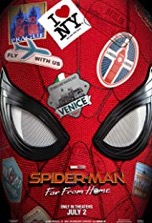
Starring: Tom Holland
July 2019
Warning! This is NOT a movie review. This is a critique of the film. Intended to initiate a dialogue, the following analysis explores various aspects of the film and may contain spoilers. Views are my own and elaborate on comments that were originally tweeted in real time from the back row of a movie theater @BackRoweReviews. For concerns over objectionable content, please first refer to one of the many parental movie guide websites. Ratings are based on a four star system. Happy reading!
If you’ll forgive the pun, there’s a stark tonal shift between Spider-Man: Far From Home and the previous Marvel film, Avengers: Endgame. Endgame was the conclusion of an epic storyline told on a grand scale where the stakes were literally earth-shatteringly high. Here, we have a leisurely-paced, pedestrian story that’s filled with lightweight action scenes—even when characters are placed in harm’s way, the peril just doesn’t seem real. Perhaps the fact that much of the film’s action is illusory adds to its narrative ennui.
The story’s underachievement may be due to the fact that it takes a long time to get going, and that it never goes anywhere when if finally does. Or maybe it’s because Spider-Man doesn’t do anything all that spectacular or amazing in the movie. Or maybe it’s because we really can’t take the film seriously because of its schmaltzy dialog and gooey teen angst. In fact, aside from its postcard-perfect European locations, there’s very little to recommend the film.
Tom Holland may be the best Peter Parker/Spider-Man yet, but his gee-whiz shtick is already getting old. And speaking of shtick, Samuel L. Jackson has played Nick Fury for so long now the character has become a caricature. This brand of cartoony acting afflicts the entire cast; including Marisa Tomei as Aunt May and Jon Favreau as Happy Hogan (the relationship between these characters is painfully awkward).
Perhaps the worst acting in the film is Jake Gyllenhaal’s histrionic portrayal of Quentin Beck/Mysterio. Gyllenhaal’s Mysterio has none of the gravitas or menace of Michael Keaton’s Vulture from Spider-Man: Homecoming. But to be fair, I don’t even think the inestimable Keaton could’ve pulled off such a two-dimensional heavy as globe-domed Mysterio.
One thing the movie gets right is how it shows what life is like after the “blip” that occurred in Endgame. Though characters seem sad over the loss of Tony Stark/Iron Man (Robert Downey Jr.), they’re never given enough time to adequately process that loss since the movie never slows down long enough to deal with any genuine emotions.
In the end, SM: FFH is a flaccid sequel that suffers from horrendous scripting and surprisingly substandard acting. It’s ironic that a movie so focused on the dangers of illusions should contain so many story elements that are shallow and implausible.
The end credits clips are the best part of the movie, so be sure to stick around to the very end.
Rating: 2 out of 4
Avengers: Endgame (PG-13)
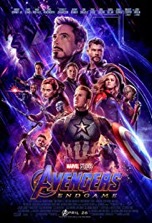
Starring: Robert Downey Jr.
April 2019
Warning! This is NOT a movie review. This is a critique of the film. Intended to initiate a dialogue, the following analysis explores various aspects of the film and may contain spoilers. Views are my own and elaborate on comments that were originally tweeted in real time from the back row of a movie theater @BackRoweReviews. For concerns over objectionable content, please first refer to one of the many parental movie guide websites. Ratings are based on a four star system. Happy reading!
Even though, in the strictest sense, Avengers: Endgame isn’t a family film, its central theme revolves around family. Like Shrek’s onion (or Donkey’s parfait), there are many layers of family in this film. In fact, from start to finish, Endgame is all about family.
The movie begins with Clint Barton/Hawkeye (Jeremy Renner) having a picnic with his family. The film ends with many families and friends attending a gathering. These individuals make up a large family of characters we’ve come to know and love over the course of the twenty-two Marvel (MCU) movies (which comprise an interconnected family of films).
We watched in utter shock as half of this expansive family of superheroes turned to ash in the previous film, Avengers: Infinity War (2018). In a very real sense, it feels like we’re losing more family members in Endgame, since this is the final Marvel movie for many of the main actors.
The script, by Christopher Markus and Stephen McFeely, places added emphasis on relationships by including a number of rich character moments between the superheroes and their families. In addition to Hawkeye’s family, we encounter several generations of Starks. Tony Stark/Iron Man (Robert Downey Jr.), becomes a type of surrogate father to Peter Parker/Spider-Man (Tom Holland). Thor (Chris Hemsworth) is reunited with some of his family and we witness the extreme sibling rivalry between Thanos’ (Josh Brolin) two daughters: Gamora (Zoe Saldana) and Nebula (Karen Gillan). These instances, and many others, confirm that the movie’s main priority is family.
In an unforgettable scene, Steve Rogers/Captain America (Chris Evans) chooses family over freedom fighting. It’s a poignant reminder of what matters most in life.
One last aspect of the family metaphor before I completely drive it into the ground; a whole generation of kids (and their families) have grown up watching the Marvel movies. How will these films be viewed by future generations? By focusing on family, the Marvel films, especially this one, will resonate far into the future.
Rating: 3 out of 4
Captain Marvel (PG-13)
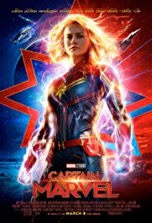
Starring: Brie Larson
March 2019
Warning! This is NOT a movie review. This is a critique of the film. Intended to initiate a dialogue, the following analysis explores various aspects of the film and may contain spoilers. Views are my own and elaborate on comments that were originally tweeted in real time from the back row of a movie theater @BackRoweReviews. For concerns over objectionable content, please first refer to one of the many parental movie guide websites. Ratings are based on a four star system. Happy reading!
It was inevitable that, in order to keep up with competitor DC’s femme freedom fighter Wonder Woman, Marvel would feature a female to headline one of their superhero films. That non-drug heroine is Carol Danvers (not to be confused with Kara Danvers of Supergirl fame), a.k.a. Captain Marvel (Brie Larson). A former Air Force pilot, Danvers is now an intergalactic fugitive who comes to Planet C-53 (some hellhole named Earth) to discover clues about her past. Danvers soon finds herself caught in the middle of a conflict between the Kree and the Skrulls, two warring alien races in search of a blue Rubik’s Cube called a Tesseract. To thwart this cosmic conspiracy, Danvers joins forces with S.H.I.E.L.D. agents Fury (Samuel L. Jackson) and Coulson (Clark Gregg).
Marvel isn’t an amazing Marvel movie, but it’s a really good one. The writers spend ample time on character development, which is refreshing for a superhero movie. The plot coheres despite its many time jumps and manages to have a few genuinely surprising twists along the way. Also, the film’s well paced action sequences aren’t overblown like those in many Marvel movies. The way the writers gradually reveal Danvers’ origin story is extremely clever; as the Skrulls (who are somewhat reminiscent of the Goblins from LOTR), scan Danvers’ memories, looking for any hint of the Tesseract, we learn valuable insights into her upbringing and background. We gain firsthand knowledge of the Kree culture from when Danvers lived on their Coruscant-like planet and learned combat skills from expert trainer Yon-Rogg (Jude Law).
Ben Mendelshon, who excels at playing heavies (Rogue One and Ready Player One) turns in a fairly nuanced performance as a Skrull infiltrator. Kree villain Ronan (Lee Pace), who met his timely demise in the first Guardians of the Galaxy (2014) film, only has a handful of scenes and, sadly, doesn’t significantly factor into the movie’s action.
The CGI on Jackson and Gregg’s regressed visages is quite impressive—it’s amazing how today’s digital artists can remove 20-30 years with the click of a button. Gregg makes the most of his scant scenes as newbie agent Coulson and Jackson effectively provides the bulk of the movie’s comic relief.
There’s also a nostalgia factor here. Typically, time travel movies go “back in time” to the 80s. Marvel takes us back in the 90s, which, with its boxy cars and Blockbuster Video stores, looks just as old as the 80s at this point…how time flies.
Suffice it to say, there’s a great deal of connective tissue between this film and the Marvel panoply, which is a formula the studio has refined to a science by now. So, will there be a Captain Marvel 2? If so, it will probably be set in the present (as was revealed during the first end credits clip).
What are the main takeaways of the film? His friends call him Fury. Be double, triple sure you know who your enemies are. And always keep an eye on that darn cat.
Rating: 3 out of 4
Glass (PG-13)
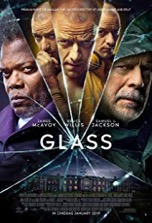
Starring: James McAvoy
January 2019
Warning! This is NOT a movie review. This is a critique of the film. Intended to initiate a dialogue, the following analysis explores various aspects of the film and may contain spoilers. Views are my own and elaborate on comments that were originally tweeted in real time from the back row of a movie theater @BackRoweReviews. For concerns over objectionable content, please first refer to one of the many parental movie guide websites. Ratings are based on a four star system. Happy reading!
Glass cleverly combines characters and events from Unbreakable (2000) and Split (2017) into a modern superhero yarn. M. Night Shyamalan (who writes, directs and makes a brief cameo here) has crafted a dual sequel that focuses on common people who possess superpowers, or at least those who believe they do. That psychosis angle is one of the movie’s more fascinating aspects. Do David Dunn (Bruce Willis), Elijah Price, a.k.a. Mr. Glass, (Samuel L. Jackson) and Kevin/Patricia/Hedwig/The Beast (James McAvoy) actually have superhuman abilities, or is it all in their heads?
Unfortunately, just like Dunn’s aversion to immersion and Mr. Glass’ vulnerability to gravity (and everything else), the film’s Achilles’ heel is sameness. One of the movie’s themes, “the strength in brokenness,” is borrowed wholesale from Split. That film had a great deal to say about the current state of mental health and its implications on the nature and future of humanity. This film eschews those weighty topics in favor of the passé notion that everyday heroes live among us (shades of The Incredibles, Heroes and every Marvel TV show ever produced).
Another measure of sameness is the acting. McAvoy is just as brilliant here as he was in Split, but that’s the problem; he’s just playing the same personalities in the same ways. We hang on his every word, anticipating some new quirk or deviation to occur, but there’s nothing different about Kevin’s personality pantheon in this movie. Shyamalan should’ve added a 25th personage to Kevin’s mental stew, someone who could provide a wild card element to the warring factions inside Kevin’s mind. Although it’s nice to see Willis and Jackson again, they’re monstrously underserved in the film.
Slow pacing is another drawback—Mr. Glass doesn’t have any significant scenes until halfway through the movie. Much of the film’s action takes place inside or on the grounds of an asylum, which makes it feel insular…and low budget. The promise of a protracted slugfest atop a newly erected skyscraper is downgraded to a parking lot brawl, which is profoundly disappointing.
Glass has a few minor twists, but doesn’t have that big A-ha! moment we’ve come to expect from a Shyamalan film. Though the movie makes us second guess ourselves for about three and a half seconds, it needed a more complex and convoluted (like Kevin’s mind) plot to set up a compelling and mind-bending climax.
Despite an intriguing concept, fine direction and tremendous performances, Glass still manages to underwhelm. Sorry to shatter your expectations, but Glass isn’t as sharp as Split.
Rating: 2 1/2 out of 4
Overlord (R)
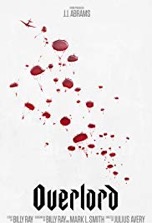
Starring: Jovan Adepo
November 2018
Warning! This is NOT a movie review. This is a critique of the film. Intended to initiate a dialogue, the following analysis explores various aspects of the film and may contain spoilers. Views are my own and elaborate on comments that were originally tweeted in real time from the back row of a movie theater @BackRoweReviews. For concerns over objectionable content, please first refer to one of the many parental movie guide websites. Ratings are based on a four star system. Happy reading!
They say honesty is the best policy. In that case, I need to be honest from the start…this isn’t my kind of movie. But if I’m being totally honest, I feel like I’ve been the victim of a bait and switch. When I signed up to review this movie, I thought Overlord, the J.J. Abrams produced WWII tale, was going to be a straightforward action movie. Then I saw the trailer and thought, “What in the world have I gotten myself into?” The movie’s premise is straightforward…a group of American soldiers parachute into France on the eve of D-Day. Their objective is simple; sneak into a French village under the cover of darkness and take out the radio tower that sits atop a church building. However, when the American soldiers infiltrate the church, they discover many living and dead people who’ve been mutated by evil alchemy in a makeshift dungeon. To accomplish their mission, the American troops must engage in a series of gun battles with Nazis while evading the fast-moving zombies that lurk in the claustrophobic corridors of the church. From that brief description of the story, you’ve guessed right that Overlord is a mash-up of Saving Private Ryan and I Am Legend. Although the story has some semblance of a plot, the novelty of its premise wears thin around the movie’s midpoint. Writers Billy Ray and Mark L. Smith weave their paltry plot among the tapestry of overblown action sequences and zombie brawls. Overlord is directed by Julius Avery, a virtual unknown who has directed only one other feature-length film. The cast is populated with newcomers, bit players, and journeyman character actors with nary a star among the bunch. Other than the intrigue of its story, Abrams’ name is the movie’s only real draw. The movie’s theme is as obvious as its premise: the dangers of playing God. Though taken to unrealistic extremes, you can totally see how Hitler would sanction such a diabolical plan to create super-soldiers. The “1,000 Years of the Reich” program is an interesting concept, but the zombie subplot is flagrant revisionist history and is only in the story to provide thrills and chills for the audience. Overlord has an excessive amount of violence, swearing and disturbing images. Aside from its myriad shoot-outs between Nazis and American forces, the movie also contains a graphic torture scene and two attempted rapes. We catch glimpses of disfigured and mutated humans inside the cells in the church’s basement. The surgery room contains mutilated cadavers and several experiments gone wrong, like a talking woman who has only a head and spinal column (which is much more macabre than the initial image of the bodiless Borg Queen in Star Trek: First Contact). The mutation process, when human subjects are turned into zombies, is quite hideous. Another horrific scene is when corpses (failed experiments) are carted out of the church, dumped into a ditch and incinerated with a flamethrower. Those with a weak stomach have been forewarned. One area of the movie that’s commendable is its production. From the opening CG shot of the Allied fleet to the pyrotechnics and FX, to the costumes and creature makeup, Overlord is a well-crafted movie. It’s to Avery’s credit that he only sparingly resorts to standard horror movie gimmicks, like characters suddenly appearing in front of the camera to startle the audience. In the final analysis, Overlord is a war/horror hybrid that’s unabashedly graphic. From start to finish, the movie is gratuitous for the sake of being gratuitous. Though Overlord is a unique film, it certainly isn’t a great one.
Rating: 2 1/2 out of 4
The Meg (PG-13)
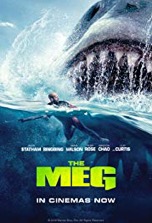
Starring: Jason Statham
August 2018
Warning! This is NOT a movie review. This is a critique of the film. Intended to initiate a dialogue, the following analysis explores various aspects of the film and may contain spoilers. Views are my own and elaborate on comments that were originally tweeted in real time from the back row of a movie theater @BackRoweReviews. For concerns over objectionable content, please first refer to one of the many parental movie guide websites. Ratings are based on a four star system. Happy reading!
“There’s always a bigger fish.” – Qui-Gon Jinn, Star Wars: Episode I – The Phantom Menace (1999)
Qui-Gon’s wry comment is perfectly illustrated by one of the movie posters for The Meg, the new deep sea thriller from director Jon Turteltaub (National Treasure), which depicts the terrifying tableau of a diver swimming toward the surface who is being pursued by a great white shark which is stalked by a massive megalodon (technically, carcharodon megalodon, a supposedly extinct mega-shark that serves as the movie’s ubiquitous threat). Simply put, it’s eat or be eaten out on the open water. Our “supersize” mentality has permeated every segment of society, ranging from value meals to movie monsters. This is particularly true of thriller franchises like Jurassic Park where the T-Rex was replaced by the Spinosaurus, which was supplanted by the Indominus Rex which was superseded by the latest bigger/faster hybrid introduced in the recent Jurassic World: Fallen Kingdom (which I won’t spoil in case you haven’t seen it yet). Instead of starting off with a great white shark and working up to a larger predator, the movie goes right to its supersized antagonist, the megalodon. The movie opens with an ill-fated rescue mission, where Jonas Taylor (Jason Statham) makes a difficult judgment call that condemns half his crew to a watery grave after the ship is attacked by what he later describes as a 70-foot creature. Five years later, after losing his career and marriage, Jonas is a guilt-stricken alcoholic who has sworn off diving for the rest of his life. Jonas’ pity party is interrupted when pal Mac (Cliff Curtis) and Mana One underwater station supervisor Dr. Zhang (Winston Chao) show up to enlist his help on another rescue mission. Jonas is adamant about not getting involved until Mac reveals the identity of the person trapped inside the disabled submersible, which is rapidly running out of air…Jonas’ ex-wife. And I’ll give you one guess as to what damaged the sub and lies in wait for Jonas at the bottom of the ocean. As would be expected for a summer creature feature, the movie is packed to the gunnels with stock characters. Statham is the reluctant hero. Bingbing Li is the love interest. Rainn Wilson is the unscrupulous business tycoon with no respect for people and no reverence for nature. Ruby Rose is the uber-smart techie. Page Kennedy is the comic relief. Robert Taylor (who is solid as usual, but seems miscast here) is the cool under fire doctor. Shuya Sophia Cai steals the show as precocious youngster, Meiying. The real star of the show, of course, is the giant shark. The sheer immensity of the creature is breathtaking. And yet, even though the leviathan is undeniably imposing, there’s something lacking in this terror from the deep…some aspect that prevents it from inducing the same level of bloodcurdling dread that the violently thrashing creatures showcased in earlier shark movies did to a superlative degree. Maybe it has something to do with the way Turteltaub frames the super-shark. Or maybe it’s the photo-realistic CGI that’s so finely rendered that it leaves nothing to the imagination. Say what you will about Steven Spielberg’s animatronic shark in Jaws (1975), it was downright terrifying. The less-than-impressive title creature leaves us with a lingering question: how is it possible that something so gigantic, so powerful, and so quick can be so unconvincing? One of the major reasons why the megalodon fails to frighten is that the story, written by Dean Georgaris, Jon Hoeber and Erich Hoeber (based on the novel MEG: A Novel of Deep Terror by Steve Alten), has no teeth. The story is highly imitative of the Jaws series and the many cheap knockoffs it inspired: Deep Blue Sea (1999), Megalodon (2002), Sharknado (2013) and The Shallows (2016), to name just a few. With the subgenre’s tropes so well-defined at this point, it’s almost impossible to make a shark attack film without being derivative, and The Meg is no exception. The scene where the giant fish approaches the teeming Chinese beach is reminiscent of the initial shark sighting at the beach on Amity Island in the first Jaws film. Someone needs to inform the writers that humans don’t taste good to sharks, and that all the people in the water would only serve as an appetizer to the colossal creature. Plus, as one scene slyly visualizes, clothing, snorkels, flippers, etc get lodged in between the megalodon’s massive teeth…and there’s no such thing as shark floss. Though the crew pursues the megalodon in a big boat, it turns out they need an even bigger one, which, of course, is a tip of the hat to the famous line in the first Jaws movie. Mana One station is a high-tech, less commercial version of SeaWorld Orlando’s underwater tunnels in Jaws 3-D (1983). Also, there’s more than a passing resemblance between Jonas firing a spear-like weapon with a tracker at the whale-sized shark and Captain Ahab hurling a harpoon at the white whale in Moby-Dick. Suffice it to say, the list of comparisons between The Meg and other shark films is expansive. The one thing the story does right is pacing. The ratio of character beats to action scenes is surprisingly well-balanced for a horror/thriller flick. In the end, The Meg is a disappointing effort that feels more like a big budget Syfy channel movie than a major studio tentpole. Even when characters are face-to-face with the megalodon, the movie has a strange lack of peril. Still, The Meg delivers exactly what it promises…a summer popcorn flick that boasts a generous number of adrenalin-pumping chases and close calls with rows and rows or razor-sharp teeth. So, will there be a Meg 2 and if so, how will they outdo the mega-shark in this film? Or, to put it a different way, how can you supersize a megalodon?
Rating: 2 out of 4 stars
Ant-Man and the Wasp (PG-13)
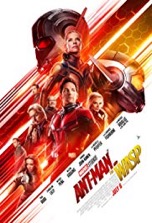
Starring: Paul Rudd
July 2018
Warning! This is NOT a movie review. This is a critique of the film. Intended to initiate a dialogue, the following analysis explores various aspects of the film and may contain spoilers. Views are my own and elaborate on comments that were originally tweeted in real time from the back row of a movie theater @BackRoweReviews. For concerns over objectionable content, please first refer to one of the many parental movie guide websites. Ratings are based on a four star system. Happy reading!
One of the subplots in the first Ant-Man (2015) revealed that scientist Hank Pym (Michael Douglas) lost his wife Janet (Michelle Pfeiffer) when she went subatomic to disable a Soviet nuclear missile, a heroic deed that relegated her to being tossed about inside the swirling maelstrom of the quantum realm for all eternity. The sequel, Ant-Man and the Wasp, opens with that fateful mission (these archival clips from the first film set the tone for the sequel’s rehashed sameness), which effectively kicks off the action and establishes the movie’s premise as a straightforward rescue tale. Since the last film, Hank has been busy building a quantum tunnel. Hank prevails upon Scott Lang/Ant-Man (Paul Rudd) to enter the subatomic dimension and rescue Janet. Other than a few character beats and a handful of action sequences, that’s pretty much the whole plot in a nutshell. The Ant-Man franchise is like the redheaded stepchild of the Marvel universe. Compared to the Avengers series, this film feels downright low budget. Like Scott, who is under house arrest (a story element that quickly tires), the movie is firmly moored to its San Francisco locations. Whether intentional or not, the film’s insular framework is symbolic of the confinement Scott and Janet have been forced to endure. The story by Rudd and four other writers is rote and seems more like an episode of Agents of S.H.I.E.L.D. than a big budget summer tentpole. With a dearth of character development and reheated dialog, the movie’s central figures are merely caricatures of themselves, especially Luis (Michael Pena), whose one-liners are as stale as last week’s pizza. The rest of the actors do what they can with mediocre material. This is a sad fact since the movie boasts some impressive actors, including: Walton Goggins, Bobby Cannavale, Judy Greer and Laurence Fishburne. For this outing, Scott is joined by Hope van Dyne (Evangeline Lilly), who takes her mother’s mantle as the Wasp. Other than watching the duo kick some major tuchus in a couple action scenes, the only aspect of the film that’s enjoyable is the loving relationship between Scott and his daughter Cassie (Abby Ryder Fortson). The homemade ant farm inside the house is a creative and thoroughly enjoyable scene. Another clever concept is how Hank’s lab can shrink down to the size of a milk crate so that it can be transported to another locale and enlarged back to its skyscraper proportions. The mobile tower concept was also used to great effect in the fantasy/sci-fi cult classic Krull (1983). The FX inside the quantum realm are a major disappointment…any decently produced TV show can achieve, and in many cases supersede, these multicolor miasma effects. The blurry ghost image employed whenever Ava/Ghost (Hannah John-Kamen) time shifts is a really well conceived and executed visual effect. In the end, Ant 2 is a safe and predictable follow-up to the first film, which was a surprise hit. The only surprise here is how uninspired the story is. For Ant-Man 3, Marvel had better step up its game. Otherwise, they might discover that, like their titular hero, the audience can shrink too.
Rating: 2 ½ out of 4 stars
Avengers: Infinity War (PG-13)
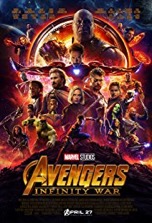
Starring: Robert Downey Jr.
April 2018
Warning! This is NOT a movie review. This is a critique of the film. Intended to initiate a dialogue, the following analysis explores various aspects of the film and may contain spoilers. Views are my own and elaborate on comments that were originally tweeted in real time from the back row of a movie theater @BackRoweReviews. For concerns over objectionable content, please first refer to one of the many parental movie guide websites. Ratings are based on a four star system. Happy reading!
The old adage about the third time being the charm certainly holds true for Avengers: Infinity War, the third film in the series and arguably the finest Marvel film to date. So what was the difference-maker here? Story. The screenplay by Christopher Markus and Stephen McFeely pulls together the threads of myriad storylines from the back catalog of Marvel films and manages to give each of the heroes a piece of the narrative pie amid a sprawling, planet-hopping adventure. Although character development (which was at least attempted in the individual spotlight films) is tenuous in most cases, the one individual who is fleshed out is villain Thanos (Josh Brolin). Due to his formidable physique, Thanos is an intimidating antagonist in the mold of Darth Vader. However, what makes Thanos a fully-realized villain is that he has genuine motivations stemming from a surprisingly sympathetic backstory. From the moment his home planet was ravaged, Thanos has been desperately searching for the six Infinity Stones, which will give him the ability to regenerate his world. The bad news is that Thanos’ plan will wipe out half the life-forms in the universe. This wide-scale culling has some shocking repercussions at the end of the film, which contains a heart-stopping The Empire Strikes Back (1980) style cliffhanger. Thanos’ galactic scavenger hunt provides an engaging story structure that makes the sundry action scenes and character moments cohere. Many of the film’s passages approach epic status; proof positive that Marvel has perfected the formula for its flagship property. However, for all its achievements, Infinity certainly has its fair share of flaws. For starters, Peter Quill/Star-Lord (Chris Pratt) is completely out of character in the movie (that ridiculous mustache means he’s from the Mirror Universe, right?) and squanders the team’s best chance at defeating Thanos with his thirst for revenge. Also, Vision (Paul Bettany) is a total wuss—isn’t he supposed to possess god-like powers? Scarlet Witch (Elizabeth Olsen) is far more powerful in the film and ends up saving Vision on countless occasions. And where’s Hawkeye (Jeremy Renner)? Or Everett Ross (Martin Freeman)? Granted, with the ever-expanding stable of Marvel heroes, it’s nearly impossible to service everyone. Although the story is a fairly strong chain, there are a few weak links. For instance, wizard Wong (Benedict Wong) magically transports a gigantic assailant to a glacial wasteland at the end of a massive melee. So why didn’t he just do that at the beginning of the battle to forestall the large-scale destruction and to prevent Doctor Strange (Benedict Cumberbatch) from being abducted? Contrived! Another bit of weak scripting involves the Wakanda storyline when Black Panther (Chadwick Boseman) orders the shield to be opened, which allows an army of creatures to flood inside the dome. Panther does this to prevent the creatures from overloading the wall near Vision’s position, which is flawed logic. Why not just redeploy troops to defend that part of the wall? Since a percentage of the creatures are being cut in half by the dome, it doesn’t make sense to open the door and let them all in. Fighting part of an army is better than fighting all of the army, right? Somehow this basic logic escaped the writers. The introduction scenes are a lot of fun, especially the meeting between Stark (Robert Downey Jr.) and Strange. It’s gratifying to see how their instant antipathy gradually morphs into “professional courtesy.” Bruce Banner/Hulk (Mark Ruffalo) is handled masterfully in the movie. Banner is constantly at odds with himself and his alter ego. The question of who’s controlling whom takes a fascinating twist here: up to this point, Banner has had a hard time turning Hulk off, now he struggles to turn him on. Infinity is one of the rare Marvel experiences where the story holds its own against the top-notch, mind-blowing FX. This has created a serious challenge for the sequel, which will have to find a way to live up to this film. If IW2 is anything like this movie, we’re in for a treat.
Rating: 3 ½ out of 4 stars
Jurassic World: Fallen Kingdom (PG-13)
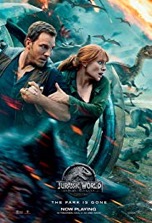
Starring: Chris Pratt
June 2018
Warning! This is NOT a movie review. This is a critique of the film. Intended to initiate a dialogue, the following analysis explores various aspects of the film and may contain spoilers. Views are my own and elaborate on comments that were originally tweeted in real time from the back row of a movie theater @BackRoweReviews. For concerns over objectionable content, please first refer to one of the many parental movie guide websites. Ratings are based on a four star system. Happy reading!
What we witnessed in Jurassic World (2015) was the fruition of John Hammond (Richard Attenborough) and Benjamin Lockwood’s (James Cromwell, who is egregiously underserved in this film) dream—a functioning dinosaur park filled with attractions, rides and, of course, gift shops. But midway through that movie, life found a way and the dinos started eating the tourists. At the beginning of the sequel, Jurassic World: Fallen Kingdom, the park lies in ruins and the remaining dinos are being threatened by a violent volcano that will soon incinerate the island. As experts on the dinos, Owen Grady (Chris Pratt) and Claire Dearing (Bryce Dallas Howard) are prevailed upon to help with the rescue effort. But the dino extraction goes south when a joint military (led by Ken Wheatley, Monk’s Ted Levine) and scientific (funded by greedy industrialist Eli Mills, played by Rafe Spall) operation brings the animals back to the mainland in a storyline that has far too many similarities to The Lost World: Jurassic Park (1997). The caged dinos are auctioned off (quite expertly by Toby Jones) to extremely rich and “discriminating” buyers. When a new hybrid species is introduced, the Indominus Rex crossed with Raptor “Indoraptor,” the bidders leverage their fortunes to own the priceless prototype dino. Dr. Henry Wu (BD Wong) protests, stating that the creature isn’t for sale, but Eli arrogantly quips, “Relax, we’ll make some more.” Of course, this “lack of humility before nature” is the cue for all hell to break loose…as it always does in the Jurassic films. JW2 retains many “popcorn” elements and actually has a plot…and message. Though the animal trafficking (and human/sex trafficking by extension) subplot is drilled home pretty hard, there’s also a subtle warning about how the dinos might be used for their biopharmaceutical properties. This opens up some fascinating and frightening possibilities. Could we discover new cures to diseases and make major advancements in medicine by studying the dinos? Could such knowledge also lead to the creation of virulent stains of chemical and bioweapons? As Ian Malcolm (Jeff Goldblum, who makes a brief cameo here) states in the film, “We’re causing our own extinction.” In an unexpected twist, Eli refers to Owen and Claire as the “parents of the future” since Claire authorized the creation of the Indominus Rex and Owen successfully trained raptors. This is a compelling outsider’s perspective on how their actions have unintentionally produced results antithetical to their beliefs. In essence, they’ve created their own monster. There are numerous allusions to the earlier films here, like the helicopter’s journey to the island, the side view mirror etched with “Objects in mirror are closer than they appear” (though, symbolically, the words are upside down this time) and the T-Rex’ triumphant bellow. There’s also a clever series of shots where the camera focuses on a character’s feet and then pans up. The first instance is when Claire is wearing high heels and the next is when she arrives on the island in boots. This corrects a major criticism of the previous film which had Claire running around the park in high heels. There are some fun scenes, like when the head-butting Stygimoloch sends party guests flying through the air as if they were gored by a bull, and some terrifying moments, like the Nosferatu (1922) style shot of the Indoraptor’s claw slowly reaching for the little girl hiding in her bed. In the end, JW2 is a surprisingly poignant chapter in the Jurassic saga that features far fewer gratuitous dino chases and more meaty and thought-provoking examinations of human greed and our irresistible need to play god. The way things end in JW2, JW3 may take place in your neighborhood.
Rating: 3 out of 4 stars
Deadpool 2 (R)
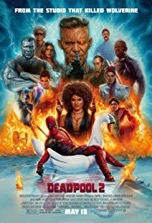
Starring: Ryan Reynolds
May 2018
Warning! This is NOT a movie review. This is a critique of the film. Intended to initiate a dialogue, the following analysis explores various aspects of the film and may contain spoilers. Views are my own and elaborate on comments that were originally tweeted in real time from the back row of a movie theater @BackRoweReviews. For concerns over objectionable content, please first refer to one of the many parental movie guide websites. Ratings are based on a four star system. Happy reading!
In Deadpool 2, the eponymous foul-mouthed superhero has returned to bring us a family film, or so he claims at the beginning of the movie. Don’t believe him. Even though writers Rhett Reese, Paul Wernick and some douche named Ryan Reynolds have toned down the violence and double entendres, the movie is still a bloody, crass, irreverent wad of inappropriateness. An early romance storyline quickly yields to a series of action sequences as the movie struggles to find its narrative footing. It isn’t until the Mystery Men (1999) style superhero tryout that the film begins to come into focus. The sequence is an absolute hoot, especially the heated exchange over whether or not luck should be considered a superpower. The debate is soon settled when Domino (Zazie Beetz) assists Deadpool in fending off some thugs…an amusing and unique action sequence which is basically Murphy’s Law in reverse. Josh Brolin, fresh off his stint as villain Thanos in Avengers: Infinity War, is the movie’s wild card and adds some much-needed heft and complexity to the film. Another pivotal character is Firefist (Julian Dennison), a young orphan who possesses powers he can’t control; which makes him equal parts innocent kid and unpredictable threat. In an obvious indictment against the Catholic Church, Firefist has been taken advantage of by the religious headmaster (Eddie Marsan) at a school for boys. Though you have to dig through the rubble to find it, this is the only real message in the film—i.e. the heinous sexual abuse of minors at many such institutions. Of course, there are plenty of humorous scenes in the film, like the fate of Wade’s new team on their first mission and when Wade grows back his legs after being ripped in half by Juggernaut. The action scenes, filmed with numerous Matrix-style slo-mo sequences, are well executed by director David Leitch. In particular, the sequence where Colossus (voiced by Stefan Kapicic) and Juggernaut slug it out reaches near epic proportions. The end credits scenes, where Wade uses a time machine to rectify the mistakes of the past (like when Reynolds first picked up the Green Lantern script) are the highlight of the film. Final analysis: D2 isn’t as crass or graphic as the first film, but isn’t as funny or clever either. Reynolds’ shtick is wearing pretty thin at this point (especially the VO narrations and frequent instances of breaking the fourth wall). The series needs to evolve; otherwise it might end up resembling its title. Not the pool part.
Rating: 2 ½ out of 4 stars
Incredibles 2 (PG)
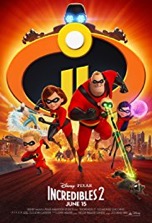
Starring: Craig T. Nelson
June 2018
Warning! This is NOT a movie review. This is a critique of the film. Intended to initiate a dialogue, the following analysis explores various aspects of the film and may contain spoilers. Views are my own and elaborate on comments that were originally tweeted in real time from the back row of a movie theater @BackRoweReviews. For concerns over objectionable content, please first refer to one of the many parental movie guide websites. Ratings are based on a four star system. Happy reading!
While waiting to watch Incredibles 2, I detected an insidious pattern in the previews. For The Lego Movie 2, Wyldstyle (Elizabeth Banks) admits that she almost singlehandedly saved the world in the first movie, but that Emmet (Chris Pratt) took all the credit. The next trailer was for Wreck-It Ralph 2. In a telling scene, Vanellope (Sarah Silverman) stumbles into a room full of Disney princesses who initially question her right to join them until they identify with her plight; people always assume that all of Vanellope’s problems will be solved as soon as a big, strong man shows up. When the feature presentation finally started, I thought for sure the anti-male bias was over—surely Pixar wouldn’t stoop to such shameless sexism, right? Wrong. It would appear that the sentiments behind the #MeToo and #TimesUp movements have now infiltrated kids’ movies…and that makes me mad. For a detailed diatribe of my stance against movies that seek to indoctrinate children with partisan political views, read my review of Happy Feet. Suffice it to say, unhealthy stereotypes of men are everywhere now, even in typically high-quality, high class Pixar pics. Case in point is Bob Parr/Mr. Incredible (Craig T. Nelson). If we thought Bob was emasculated at the beginning of first film as the deskbound, pencil pushing cube dweller, imagine how worthless he feels when his wife Helen Parr/Elastigirl (Holly Hunter) gets a crime fighting gig and he’s left at home to raise the kids Mr. Mom style. When Bob’s efforts to take care of his three kids go up in smoke (as a former accountant, he can’t even teach his son math because it’s “new math”), he reaches out to friend Frozone (Samuel L Jackson) for advice and prevails upon costume designer Edna (Brad Bird) to babysit Jack-Jack. Particularly disturbing is the cost analysis scene, which flags Mr. Incredible as an extreme insurance risk. The analytics reveal that Elastigirl (woman) completes her missions without bending a blade of grass, while Mr. Incredible (man) inflicts massive damage while attempting to defeat villains. Men are characterized as blundering buffoons who just can’t help but destroy everything in their path (much like Wreck-It Ralph or Hulk). So then, if Bob is a failure as a father and a superhero, what good is he? The last player in the NFL draft is referred to as Mr. Irrelevant. In I2, Bob Parr isn’t Mr. Incredible, he’s Mr. Irrelevant. Bob is the exemplar of the scores of men who’ve been sidelined and debased. Will it get to the point where men are nothing more than laborers and lovers in a matriarchal society, as was depicted in Gene Roddenberry’s Planet Earth (1974)? Time and societal evolution will tell, but as for now, we’re on the verge of the systematic censure, deconstruction and endangerment of the male of the species. Aside from gender roles, the movie also gets political when it deals with the integration of the Supers back into society; a topic that could relate to refugees from the Middle East, illegals pouring over the border from Mexico or even the way the LGBT community is being assimilated into the broader populace. The movie also makes thinly-veiled commentary about our growing screen obsession. Staring at one of villain Screenslaver’s hypnotic patterns can override a person’s will and make them highly susceptible to committing evil acts. Walk into any public place and you’ll see people with their faces buried in screens, in essence hypnotized by onscreen content and completely oblivious to what’s going on around them. The parallel is obvious; the solution isn’t. It’s ironic that this problem was in its initial stages when The Incredibles was released in 2004. Despite its broad spectrum of commentary, the film does have some fun, although not nearly as much as the original. Even though the scenes with Jack-Jack are the highlight of the film, the tyke is given far too many superpowers and the various applications of those powers are way overplayed, usually to generate laughs. Syndrome (Jason Lee) is a far superior antagonist to Screenslaver, whose identity is obvious from the start. There are several new characters here including: salesman Winston Deavor (Bob Odenkirk), inventor Evelyn Deavor (Catherine Keener), Voyd (Sophia Bush), Krushauer (Phil LaMarr), Reflux (Paul Eiding), Rick Dicker (Jonathan Banks) and Ambassador (Isabella Rosellini). As with the first movie, Brad Bird wrote and directed I2. So is I2 worth the wait (14 years)? It pains me to say that I2 fails to capture the first film’s unbridled creativity and off-the-wall exhilaration…and fun. Though I2 is entertaining, it certainly isn’t incredible.
Rating: 2 ½ out of 4 stars
Solo: A Star Wars Story (PG-13)
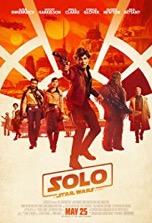
Starring: Alden Ehrenreich
May 2018
Warning! This is NOT a movie review. This is a critique of the film. Intended to initiate a dialogue, the following analysis explores various aspects of the film and may contain spoilers. Views are my own and elaborate on comments that were originally tweeted in real time from the back row of a movie theater @BackRoweReviews. For concerns over objectionable content, please first refer to one of the many parental movie guide websites. Ratings are based on a four star system. Happy reading!
The Premise:
While trying to find his long-lost girlfriend, a brash, young pilot falls in with a band of thieves, a self-styled gambler and a gigantic shaggy creature.
The Evaluation:
In the wake of the polarizing debacle known as The Last Jedi (2017), Star Wars fans from Coruscant to Tatooine were filled with trepidation over the new character spotlight film, Solo: A Star Wars Story. Those concerns were certainly justified in light of Solo’s turbulent genesis; directors Phil Lord and Chris Miller (The Lego Movie) were replaced by Ron Howard six months into the production. Also tempering fan expectations were pre-release rumors that Disney had already written the film off as a loss. Tremors in the Force notwithstanding, the resultant film is a well-acted, well-directed tale that somehow manages to underwhelm despite its lavish ($250 million dollar) production. Not only is Solo a return to the universe we know and love, it’s also a radical departure from the timbre, texture and tropes of every other cinematic SW adventure. First and foremost, Solo is an origin story for one of the most popular characters in the SW panoply, Han Solo (Alden Ehrenreich). We witness Han’s heartbreaking separation from the love of his life, Qi’ra (Emilia Clarke). We have a front row seat for the initial meetings between Han and Chewbacca (Joonas Suotamo), a scene that echoes their reunion in Return of the Jedi (but is far more violent), and Han and Lando Calrissian (Donald Glover). We get to see how Han makes the Kessel Run in less than twelve parsecs and it makes sense…sort of. We also see how Han wins the Millennium Falcon from Lando in a game of sabacc during the anticlimactic denouement. During this disingenuous scene, Han claims that his victory is “fair and square” despite the fact that he owes Lando a ship from when he lost a game earlier in the movie. But perhaps Han’s debt is cancelled after he repeatedly saves Lando’s life. At its core, Solo is a heist movie. Some of the action set pieces are spectacular, like the freight train caper on arctic planet Vandor 1, and the teeth-jarring journey through the Kessel maelstrom, which looks like it was borrowed from the “final frontier.” As a story centered on smugglers, pirates and sinister syndicate tycoons, the look of the film is appropriately grimy, gritty and seedy. Howard takes a bulldozer to Lucas’ “lived-in universe” and then covers it in mud, snow and sand. Though Howard’s monochromatic palette is a sly way of matching style with subject matter, the movie is drab for the sake for being drab. Character’s faces are flat and washed out (with low saturation and little if any contrast) throughout the entire movie and even outdoor scenes are shot during overcast conditions. This dim and dreary aesthetic, which will surely be lauded by critics as a triumph of formalism, actually detracts from the film’s enjoyment since it requires spectators to squint through long stretches of the movie just to make out what’s transpiring onscreen. Still, the directorial virtuosity on display here is astounding, and, in many respects, surpasses the finest efforts of the franchise’s stable of high-profile directors. Though it blazes a bold, new trail for the saga, Solo will go down as more of a miss than a hit. Ironically, as a movie riddled with obligatory allusions, Solo is a heist yarn where the story sabotages itself.
The Breakdown:
Directing- Howard’s insight serves him well in his first foray into the SW universe. His direction is sure-handed and reveals a sensitivity and reverence toward the existing canon that was largely missing from Last Jedi. As an Academy Award-winning director, Howard’s acumen, experience and vision are evident in every frame of the film. Other than the movie’s lighting (see: Cinematography), I have no qualms with Howard’s direction. You might say that the circle is now complete since Howard, who was but a learner in Lucas’ American Graffiti (1973), has taken his first step into Lucas’ much larger world as an undeniable master of his craft. One wonders if the director had a hand in casting Paul Bettany (who co-starred in Howard’s A Beautiful Mind) to play villain Dryden Vos. There can be little doubt that he was involved in casting his brother, Clint, to play Ralakili.
Acting- While on the subject of casting, each actor perfectly embodies the part they were selected to play. Ehrenreich has Han’s insouciant, devil-may-care attitude down pat. Glover, however, pushes his portrayal of Lando too far—Billy Dee Williams was charming and confidant while Glover has too much swagger and is frequently annoying. Woody Harrelson’s Tobias Beckett is one of the most complex and refreshingly realistic characters in any SW film. Clarke also delivers a well-measured performance as a misfortunate young woman forced into servitude by nefarious criminals. Sadly, Thandie Newton’s Val is a disposable side character who has little impact on the story. Another blink-and-you’ll-miss-it part is Lady Proxima (voiced by Linda Hunt), who looks like a supersized version of an Alien chestburster. Longtime SW performers, Warwick Davis and Anthony Daniels (trivia: this is the first SW film sans droids R2-D2 and C-3PO), have brief cameos here. The most interesting new face in the cast is Erin Kellyman, who plays the leader of the Cloud-Riders, Enfys Nest.
Story- Even though Jonathan and Lawrence Kasdan have delivered a unique vision of the SW universe, their script contains some significant problems. Solo is so preoccupied with cramming quotes and references from the earlier (later chronologically) movies into its narrative that the paint-by-numbers plot (i.e., “and here’s where Han meets Chewie,” etc.) consistently upstages the original story concepts. Some elements work well, like the significance of Han’s dice (which is a nice tie-in with Last Jedi), and others don’t, like how Han comes by his last name. It’s clear that the Kasdan’s have a firm handle on both SW lore and crime films. However, their twisty plot is as clear as Mimban mud and the ending is far too obtuse and protracted. And speaking of protracted, the film (which runs 2 hours and 15 minutes), is way too long. Cutting some of the chatting and gambling scenes would’ve shortened the film and made it tighter all at the same time. The gasp-inducing cameo after the final confrontation is the highlight of the movie—the only time we feel any genuine terror. But the thrill quickly abates and the potentially exhilarating storyline goes absolutely nowhere…a microcosmic description of the entire film. Still, Solo is an enjoyable respite from Jedis, lightsaber battles and the Force. There’s more to the SW universe than these elements, as Solo ably demonstrates.
Costumes/Make-up- The costumes are well-tailored, particularly those seen at Vos’ reception and inside the various gambling establishments.
Cinematography- Bradford Young does fine work for the action sequences and establishing shots on the various planets, especially the Falcon’s bumpy landing on Savareen. However, the overall look of the film is bland and lacks color and saturation (see: The Evaluation), a stylistic decision that also falls at the feet of Howard. None of the characters are lit by direct sunlight or any kind of fill light (reflectors) during the entire movie. This flat lighting scheme is unwittingly the perfect choice for a movie almost entirely populated with cardboard characters. And like the characters themselves, the film has no light or dark side…only shades of gray. The lighting design is tantamount to a dimly-lit smuggler’s den, which is fitting when considering the movie’s milieu.
Music- One of the highlights of the film is John Powell’s (Jason Bourne) soundtrack, which is filled with several beautiful, sweeping melodies and makes judicious use of the existing back catalog of SW themes.
Visual FX- Exceptional, as would be expected. The sequence where the squid-like creature is slowly sucked into the maelstrom’s maw is breathtaking. The train hijacking scenes are extremely well storyboarded and executed. In a franchise first, we’re treated to a really nice POV shot from the back seat of the Millennium Falcon as it enters hyperspace. The tableau of a star destroyer surrounded by the maelstrom’s swirling gases is another strong visual composition.
Production Values- Top-notch and top dollar, as would be expected for a Disney tent pole. No problems here.
Movie Magic- Though certain aspects of Han’s origin story and some of the action sequences are thrilling, much of the movie is plodding and dull. Solo’s serious tone makes it a respectable film, but certainly not a fun one. But that’s okay, because this is just A Star Wars Story, not a major trilogy film. As such, Solo has successfully expanded the saga while tiding us over until Episode IX.
Rating: 2 ½ out of 4 stars
Ready Player One (PG-13)
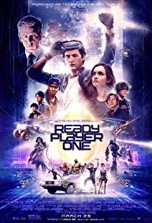
Starring: Tye Sheridan
March 2018
Warning! This is NOT a movie review. This is a critique of the film. Intended to initiate a dialogue, the following analysis explores various aspects of the film and may contain spoilers. Views are my own and elaborate on comments that were originally tweeted in real time from the back row of a movie theater @BackRoweReviews. For concerns over objectionable content, please first refer to one of the many parental movie guide websites. Ratings are based on a four star system. Happy reading!
The Premise:
A young man attempts to win fame, fortune and the affections of a young woman by solving the mysteries of a virtual reality game.
The Evaluation:
Seems like it’s been ages since Steven Spielberg directed a live-action action movie—since mo-cap The Adventures of Tintin (2011) doesn’t count, the last such film was Indy IV, which was released a decade ago. Based on the novel of the same name by Ernest Cline, Ready Player One taps into our society’s obsession with video games and genre entertainment. The plot revolves around a VR game called the OASIS, which was created by eccentric game designer James Halliday (Mark Rylance). As with computer games like Second Life or Turf Wars, real-world money can purchase loot (weapons and equipment) inside the OASIS. And just like in a video game, when you run out of lives the game is over. In the OASIS, however, you also lose all of your currency, which other players can scoop up. In a riff on Willy Wonka & the Chocolate Factory’s Golden Tickets, Halliday concealed three keys inside his VR world. Once discovered, these keys will help one player unlock the secrets of the OASIS, become the envy of millions, and, of course, earn a boatload of cash. Parzival/Wade (Tye Sheridan), the common denizen of a Columbus, OH “stacks” (mobile home towers), has aspirations of being the winner. But in order to achieve that goal, he’ll have to enlist the support of other skilled players, like Art3mis/Samantha (Olivia Cooke) and Aech/Helen (Lena Waithe). More importantly, he’ll need to look at things in radically different ways than any other player who’s ever played the game. Despite its promising premise and cornucopia of creativity, RPO never exceeds its YA trappings or overdetermined themes: rags-to-riches idealism and little guy vs. corporate overlord populism. There are plenty of nitpicks here too…since the OASIS is populated with millions of players from all around the world, how is it possible that Wade’s team of five players all live in the same neighborhood in Columbus? Character complexity, even for adults like Wade’s deadbeat guardians and lispy villain Sorrento (Ben Mendelsohn), is egregiously pedestrian in the movie and the jeopardy never reaches a level of intensity above standard teen peril. The action sequences are overblown and appear as if they were designed solely for the purpose of conveying the adrenalin-pumping exhilaration of a video game to the big screen, which they’re only marginally successful at doing. RPO is afflicted by a debilitating dichotomy—the teen characters and pulse-pounding action sequences are intended to attract a younger crowd, while the ubiquitous allusions to 80s pop culture are meant to reach an audience 40 and above (their parents). Since the film fails to fully connect with either generation, it might be disregarded on that basis, even by those who would normally enjoy this type of film. As a mash-up of the sci-fi, fantasy and gaming genres, you’d expect far more imagination than what’s on display here. The Doom environment, where two sprawling armies (comprised of every type of avatar, creature or character imaginable—including the Iron Giant) charge each other on a verdant plain, is like a massive Hobbit-style melee. However, the battle sequence is all eye candy and fails to build any genuine suspense since we know none of the main characters will die (not in real-life anyway). The movie isn’t completely devoid of innovation, though. One clever creation is the Zemeckis Cube, which looks just like a Rubik’s Cube and is named after the director of the Back to the Future movies, Robert Zemeckis. When solved, the eponymous cube resets the clock 25 seconds so that you can go back in time and undo a catastrophic event (of course, this creates a snafu since how many people can solve a Rubik’s cube that quickly, especially when caught in the middle of a firefight?). Even though it’s a frequently employed in sci-fi stories—ranging from Galaxy Quest (1999) to a recent episode of Star Trek Discovery where Mudd keeps looping time—the time rewind gag still provides a fun moment here. It’s ironic that a movie focused on an Easter egg is filled with them. From the Buckaroo Banzai costume to a toy model of the original Battlestar Galactica, and the ST:TMP poster in a window to the life-sized model of Robby the Robot from Lost in Space in the corner of a room, the movie is packed with enough pop culture references to overload your flux capacitor. The movie’s resolution contains another quotation of Wonka (inheriting the company), but the denouement is overlong and overplayed. Though this is a return to form for Spielberg, the movie is a shallow, and occasionally self-referential, pastiche. RPO is full of empty mind calories and is, sadly, devoid of heart. In the end, the only relevance the movie has is that it’s a cautionary tale regarding the frightening implications of our impending VR existence. So, will there be a Ready Player Two? As a hero of mine (James T. Kirk) once said, “I certainly hope not. I found one quite sufficient.”
The Breakdown:
Directing- After a string of historical dramas—War Horse (2011), Lincoln (2012), Bridge of Spies (2015) and The Post (2017) (with 2016’s kiddie pic The BFG thrown into the mix)—Spielberg has returned to his action/adventure roots. But has he matured beyond this type of film? No one can fault his craftsmanship here, but the movie just seems incongruous with his recent works and is completely beneath him. Still, RPO must’ve been a nostalgic trip for the director since it contains many references to his early life and career.
Acting- Sheridan is decent as the hero, but it’s Cooke who shines as the worldly-wise, no-nonsense sidekick. Mendelsohn, who was serviceable as the villain (Krennic) in Rogue One, is utterly laughable here as a greedy, selfish tycoon who pays his employees to find the three keys just like Mr. Salt (Roy Kinnear) pays his factory workers to unwrap chocolate bars to obtain a Golden Ticket for his daughter in Wonka. Rylance, Spielberg’s touchstone of late, is the backbone of the story and conveys the only genuine emotions in the film as the lovelorn programmer who just wants to go back to when games were fun…before designers ruined them by making the graphics so realistic that nothing was left to the imagination. Simon Pegg underwhelms in a role that neither suits his energetic personality nor his comedic sensibilities. Maybe he accepted the part just to work with Spielberg.
Story- The story by Zak Penn and Cline is a mixed bag. The way they introduce the OASIS is extremely odd—it’s like a documentary/infomercial about the history and conventions of the VR world. The intro contains way too much preamble…we just want to watch the movie/play the game. Plus, the writers need to show us, not tell us what’s going on in these scenes. Case in point, instead of mentioning the option to climb Mt. Everest with Batman, the writers’ should’ve incorporated that plot possibility into the story (and if licensing was an issue, they should’ve selected a different hero). These amazing concepts feel like secondhand descriptions rather than firsthand experiences. RPO’s expositional opening is like playing the demo of a video game and getting enough of a feel for it that you get bored at the thought of playing the actual game. Some of the challenges are far too easy for the characters to solve and many of the clues are telegraphed (like the ones obtained while watching just the right moment of Halliday’s expansive video library). In short, the writers try to cram too many characters and too many action sequences into a story that’s overstuffed with iconography, styles and themes from the pop culture grist of a bygone era.
Costumes/Make-up- Though diverse and colorful, many of the stylish outfits seen inside the OASIS are rendered on a computer, which means they qualify more as FX than physical costumes. The VR bodysuit is an impressive creation and is destined to be a household item in the future.
Cinematography- Janusz Kaminski (Saving Private Ryan) is as masterful as ever. However, since the majority of the film is composed of CGI characters and environments, the visuals grow tiresome after a while (like watching a feature-length podrace). The epic battles are well staged and filmed, but come off looking like a LOTR-style fracas with cosplayers subbed in for orcs and trolls.
Music- Alan Silvestri’s score is full of energy and whimsy and hearkens back to his work on the Back to the Future movies.
Visual FX- Mind-blowing CGI that, unfortunately, equates to empty calories for the brain…like many video games. The OASIS is pure artifice. The CG never slows down long enough for your eyes to assimilate the many details inside the VR world. Is that because the CG artists cut corners? Though they serve as the actual star of the movie, the FX aren’t nearly as impressive as those seen in last year’s Valerian—another action-packed, teeny sci-fi adventure.
Production Values- Unquestionably a top-dollar production. The film attempts to create a cinematic video game experience. It achieves just that…for better or worse.
Movie Magic- Totally subjective. Teens may like the action and video game aspects and adults may like all the references to 80s pop culture. Many people will dislike the movie for either or both of those reasons.
Rating: 2 ½ out of 4 stars
A Quiet Place (PG-13)
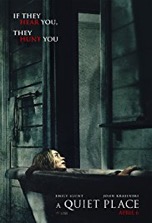
Starring: Emily Blunt
April 2018
Warning! This is NOT a movie review. This is a critique of the film. Intended to initiate a dialogue, the following analysis explores various aspects of the film and may contain spoilers. Views are my own and elaborate on comments that were originally tweeted in real time from the back row of a movie theater @BackRoweReviews. For concerns over objectionable content, please first refer to one of the many parental movie guide websites. Ratings are based on a four star system. Happy reading!
The Premise:
A family struggles to survive in a post-apocalyptic world where making the slightest noise can attract the attention of carnivorous creatures.
The Evaluation:
Normally a movie inundated with this much hype would collapse under the weight of the insurmountable expectations placed upon it. Since the trailer looked so intriguing, it comes as a great relief that A Quiet Place delivers on its promise—it’s a thought-provoking, spine-tingling good time. John Krasinski does triple duty (actor, writer and director) on this horror/thriller/sci-fi hybrid. The linchpin to the film’s success is its premise. In a dystopian world, aliens have invaded Earth and wiped out a large percentage of the human population. The good news is that the creatures are blind. The bad news is that they have super-sensitive hearing. To safeguard against being attacked, the Abbott family learns to communicate by speaking in hushed tones or using sign language. Though the movie is disciplined at following the strictures of its self-imposed rules, the concept certainly has its fair share of nitpicks. First, how is it possible to run a farm without making any noise? Also, when approaching humans, wouldn’t the creatures hear breathing, however controlled, or a rapidly beating heart (yes, what we learn during the waterfall scene significantly weakens this argument, but the criticism holds up when the creatures are at close range)? Raising kids under such strict conditions would be a monumental task—no frolicking in the front yard or roughhousing in the living room. And, as if that wasn’t hard enough, how in the world would you bring up a baby in such an environment (a similar grievance was raised by fans of The Walking Dead over Rick’s baby, Judith, being raised during the zombie apocalypse)? As the creature closes in on Blunt and her baby, and later, Blunt and her daughter, it can’t quite locate the humans in either instance. So then, are we to believe that these blind creatures also have no sense of smell? These minor gripes are forgivable. What mars the movie most is the climactic sacrifice, which could’ve been prevented if one of the characters had been as quick on the uptake as the audience. Fortunately, this is the movie’s only instance of flaccid plotting. There are many parallels between this film and Signs (2002). Aside from both movies featuring an alien invasion storyline, cornfield encounter and farmhouse showdown, the aliens in both movies have one fatal weakness—a plot device borrowed from the original The War of the Worlds (1953). Also pilfered from Worlds is the “aliens travel in trios” concept, which is particularly relevant here since the minimum number of points required to triangulate the location of a sound is three. Though the movie’s creatures are reminiscent of the ones in Alien (1979), they do have a unique design (See: Visual FX). Despite its many similarities to other horror films, Quiet features one of the most clever and original concepts in the history of the genre. So, will this Signs meets Aliens post-apocalyptic chiller stand the test of time? Time will tell. One thing’s for certain, in Krasinski’s world, everyone can hear you scream.
The Breakdown:
Directing- Krasinski’s craft is impeccable—he channels Hitchcock and Shyamalan to great effect. Some of the moments Krasinski creates are utterly terrifying, like the baby in the basement sequence.
Acting- Emily Blunt mesmerizes in a physically demanding role—she had to stand in water for a good portion of the movie. Blunt effectively conveys a range of emotions without speaking for most of the movie. Likewise, Krasinski delivers a marvelously measured performance—the scene where he slowly raises his finger to his lips, signaling others to remain silent, will go down as an iconic image in cinema history. He’s come a long way from his days as Jim Halpert on The Office. The child actors (Millicent Simmonds and Noah Jupe) also do excellent work in challenging, largely non-speaking roles.
Story- A difficult screenplay to write and execute, but handled with expert skill by Bryan Woods, Scott Beck and Krasinski. With a dearth of dialog, most of the action had to be described in detail in the script or storyboarded.
Costumes/Make-up- Functional and appropriate for the world the characters live in.
Cinematography- Charlotte Bruus Christensen does a superb job of capturing the pastoral landscape and the action sequences inside and outside the farmhouse. There are many memorable scenes in the movie, particularly those involving the bridge, silos, fields and basement. The sweeping shots atop the silos help to establish the terrain and atmosphere of the agrarian world the characters have been relegated to. The rows of white or red lights also make a striking visual.
Music- The film’s eerie mood is further enhanced by Marco Beltrami’s ethereal score which, like the characters for most of the movie, goes largely unnoticed.
Visual FX- Truly astounding creature FX—the next iteration of the Alien creature is jaw-dropping, literally. The design of the creature’s malleable head is ingenious and sets up the movie’s most memorable visual during the climactic confrontation. These FX should be a shoo-in for an Oscar nod.
Production Values- Certainly not a lavish production, since most of the movie takes place in or around the farmhouse. However, the set design for the plundered general store, work station inside the basement and silos is truly exceptional.
Movie Magic- Off the charts. This is a wholly immersive experience that draws you into the movie’s terrifying reality and thoroughly enthralls you with one thrilling sequence after the next. Quiet is a high art horror flick that will be certified as an instant classic.
Rating: 3 1/2 out of 4 stars
A Wrinkle in Time (PG)
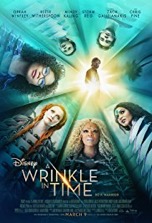
Starring: Storm Reid
March 2018
Warning! This is NOT a movie review. This is a critique of the film. Intended to initiate a dialogue, the following analysis explores various aspects of the film and may contain spoilers. Views are my own and elaborate on comments that were originally tweeted in real time from the back row of a movie theater @BackRoweReviews. For concerns over objectionable content, please first refer to one of the many parental movie guide websites. Ratings are based on a four star system. Happy reading!
The Premise:
With the assistance of three mystical women, a teenage girl embarks on a dangerous journey through time and space to rescue her father from an evil entity.
The Evaluation:
Having recently read Madeleine L’Engle’s Newbery Medal winning book, A Wrinkle in Time, I watched the film with a wary eye toward any divergences from page to screen. Though remaining faithful to the source material in most respects, the movie has made some modifications, and in each instance those changes were poorly considered and executed. From a diversity standpoint, the film is an unqualified success. Director Ava DuVernay is an African American woman—double diversity points. The cast of characters from the book has undergone a significant shakeup in the movie, which was to be expected since the world today is much different than it was when Mrs. L’Engle wrote the book in 1962. Half of the characters have switched races and one (Zach Galifianakis’ Happy Medium) has changed genders. Though it’s clear that Disney was out to make a statement with this affirmative action character mash-up, the diversity here seems like a political and media stunt. After all, it’s one thing to create diversity naturally and quite another to go about things in such an obvious and overdetermined manner that your political bias bleeds though the onscreen action like a copyright watermark. Though the casting was excellent for all of the young actors, Charles Wallace (Deric McCabe) and Calvin (Levi Miller) come off far better than Meg (Storm Reid). Overall, Meg is much more brooding and contrary here than in the book, which is a tremendous letdown since she’s the main character. Even though all of the magical “Mrs.” are well cast, Mrs. Whatsit (Reese Witherspoon) is too annoying, Mrs. Who (Mindy Kaling) is too esoteric and Mrs. Which (Oprah Winfrey) is too…big. The image of the colossal Mrs. Which is preposterous, but her immense size can be taken as a clever metaphor for the status of the actor portraying her—Oprah is, unquestionably, a media giant. The screenplay by Jennifer Lee and Jeff Stockwell starts out well by hewing closely to the book’s plot and dialog, while updating it to reflect the sensibilities of kids in a modern school. Everything is smooth sailing until the kids Tesser (beaming through space/time at warp speed, to employ Star Trek parlance). The planet concept for Uriel is far too grandiose; it takes the book’s description of a verdant paradise and turns it into a CG video game landscape. The scene where Mrs. Whatsit (Reese Witherspoon) transforms herself into a giant flying leaf is unexpected, yet utterly ridiculous. Though exhilarating, the ensuing magic carpet ride sequence is gimmicky and seems like it was included just to give the leisurely story a much needed adrenalin boost. The whole sequence is oversaturated and overblown and looks like the trailer for Avatar 2. The kids’ arrival on dark world Camazotz (dumb name that’s hard to pronounce), cues another action sequence that wasn’t in the book—the cracking landscape and violent windstorm sequence is just another whiz-bang action scene that adds absolutely nothing to the movie. The suburban cul-de-sac scene, where kids bounce red balls in perfect unison, is one of the creepier visuals in the movie and is well executed. The rest of the movie is pretty much a disaster. We never get to see the business district on Camazotz, nor the CENTRAL Central Intelligence Building. Disney should’ve spent less of its budget on meaningless action scenes and more on decent sets for the back half of the movie. Although the invisible architecture superimposed over the bright, sleek antechamber walls (which requires Mrs. Who’s glasses to see) is cleverly realized, the interior of Mr. Murry’s (Chris Pine) prison chamber is something out of a 60s drug trip and isn’t utilitarian in the least (it has no bed, sink, etc). The entire section of the book where Meg convalesces under the magical ministrations of aliens with tentacles doesn’t appear in the film—a significant loss. The final confrontation with IT has overwrought FX and is storyboarded like one of the protracted battles in the LOTR films. And speaking of protracted, the movie’s denouement is painfully long. The book ends before the characters return home, which was a wise choice. In the movie, Mr. Murry apologizes to Meg for putting his career before her; it’s a sequence that feels forced and unfounded and is made worse by Pine’s awkward acting. The many reunions and embraces at the end of the movie are overboard and uber-schmaltzy. The movie wraps up just as a Hallmark movie would—happy ending writ large. Bottom line: Disney’s Wrinkle freelances when it shouldn’t and skips some key material from the book. This big screen treatment of L’Engle’s book goes too big in many places and fails to capture the tangible magic and unbridled creativity that permeates every page of the book. L’Engle’s masterwork deserved a far better fate than this uninspired effort. Though it pains me to say, Disney’s Wrinkle is a miss…so miss it.
The Breakdown:
Directing- It’s bitterly ironic that DuVernay, a female director, consistently eschewed character development in favor of big budget action sequences that amount to little more than visual fluff. The emotions at the end of the movie are downright mawkish. A disappointing effort.
Acting- Due to the writing, most of the characters are cardboard cutouts of living, breathing characters. This is particularly true of Witherspoon’s portrayal of Whatsit, which blends her characters from Legally Blonde and Big Little Lies into an overly perky, yet ultra-critical, caricature. I would’ve expected Pine to bring more to his role; his performance is off-kilter and cursory. Surprisingly, the kid actors deliver better performances than the film’s many seasoned stars.
Story- The story has too many action scenes, too few character scenes and the ending is a maudlin mess. The film’s lack of magic starts with the script. It baffles the mind, and breaks the heart, to consider how Disney has perverted L’Engle’s timeless fantasy tale into pedestrian drivel with scant imagination and magic.
Costumes/Make-up- The outfits for the three “Mrs.” are well done, especially Whatsit’s flowing gowns.
Cinematography- The gorgeous framing on Uriel is the movie’s high point visually; everything else is fairly standard.
Music- One of the highlights of the movie is Ramin Djawadi’s fanciful and cheery score. The gorgeous orchestrations with accompanying choir during the Uriel scenes add immeasurably to the magic of this section of the film.
Visual FX- Top dollar, but overdone. See review.
Production Values- A lavish Disney production, but too much of its budget was spent on eye-candy visuals rather than on convincing sets. See review.
Movie Magic- Depends. Young kids, 10 and under, may enjoy the movie. However, judging from the reaction of the teens in the theater I attended, they thought it was pretty lame. With tenuous characterizations and oversimplified situations rife with teen peril, adults will probably find the film insufferable—even those who grew up reading the book, which is a real shame. An even bigger shame is that the movie focuses too much of its attention on jaw-dropping visuals rather than on human qualities like courage, faith and love. As such, the film will have no relevance or staying power.
Rating: 2 ½ out of 4 stars
Star Wars: The Last Jedi (PG-13)
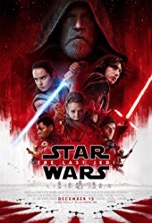
Starring: Daisy Ridley
December 2017
What follows is the full-length review based on comments that were originally tweeted in Real-time from the back row of a movie theater @BackRoweReviews. Though efforts were made to tease rather than ruin this movie’s memorable lines and moments, some spoilers may exist in the following evaluation. For concerns over objectionable content, please first refer to one of the many parental movie guide websites. Ratings are based on a four star system. Happy reading!
The first post-Lucas, Disney owned Star Wars movie, The Force Awakens (2015), was a smashing success. J.J. Abrams, a self-proclaimed diehard SW fan from his youth, did more than just direct the film; he established the look, feel, tone and style for the new trilogy. Awakens was reverent to the original trilogy (although it tapped the tropes, themes and events of A New Hope with abandon), and carved out its own unique corner of the SW universe. With such solid footing and a literal handoff of the baton (lightsaber) from Abrams to the new director (the barely-established, virtually unknown Rian Johnson), Star Wars: The Last Jedi was destined to be a surefire hit. However, even though the movie will make bank at the box office (as all SW movies do), Last Jedi is a galactic disappointment. To temper that caustic contention, let me first say that the film’s production elements are stellar across the board. Sets, costumes, FX, makeup, sound, etc. are all top-notch and should be serious contenders come awards season. Although we get some occasional stiffness (acting arthritis) from Mark Hamill and the sadly departed Carrie Fisher, the performances are solid enough, especially from the younger actors, to service this action/adventure space opera. So where did the movie go wrong? There’s only one area of the movie, indeed only one person, that made this movie fail…Rian Johnson. Whereas Johnson’s directing choices are satisfactory (save for the scene where a frosted over General Leia (Fisher) floats through space like Mary Poppins without an umbrella), his writing reveals a significant lack of understanding regarding pacing, structure, tone and especially dialog. Last Jedi features an extremely simplistic and straightforward storyline. For nearly half the movie, the rebel fleet crawls along at sublight speed (a term borrowed from Star Trek), and the plodding plot perfectly matches its pace. Much of the story goes absolutely nowhere. Even worse, it goes in circles without achieving anything at all. Case in point, when the story becomes mired in a series of scenes involving Star Destroyers taking potshots at the rebel flotilla, Johnson has Finn (John Boyega) and Rose (Kelly Marie Tran) take us on a side trip to a resort planet (Canto Bight). This boomerang subplot, which includes a couple of action sequences, a herd of animals, a handful of kids and a new side character, achieves absolutely nothing since the two rebels end up in the clutches of the enemy. It’s utterly laughable that Finn and Rose are actually surprised when their new friend, DJ (Benicio Del Toro), turns out to be a scoundrel (shades of Lando’s betrayal in The Empire Strikes Back), even though they never make contact with the rebel spy they were sent to meet—the code breaker with the red flower brooch (Justin Theroux). At the heart of the movie’s narrative ailment is a profound and pervasive identity crisis. What’s its theme? What’s its message? What’s its objective? One of the major problems with the story is that it has no MacGuffin, save for survival. With no overarching goal or purpose, the plot casts about in search of some kind of meaning, but since it never finds any, the movie settles for a string of action sequences just to keep the story moving forward. Ironically, the film is a reflection of its own weaknesses: conflicted characters mirror a conflicted story. Johnson clearly intends to keep the audience guessing as to the loyalties of the main characters, but while attempting to psych us out, he muddles character motivations and muddies the narrative waters. Ultimately, the joke is on Johnson since we’re way ahead of him (I mean, Rey actually being tempted to join the Dark Side? C’mon!). The story works overtime to depict the inner conflict of several characters. Is Luke (Hamill) good or bad? Is Kylo Ren (Adam Driver) good or bad? Is Vice Admiral Holdo (Laura Dern) good or bad? Johnson exerts so much effort on these questions that it becomes exhausting, doubly so since the answers are so painfully obvious. The mutiny subplot, where Poe Dameron (Oscar Isaac) defies Holdo and does what he thinks is best for the survival of the rebel remnant, is utterly distasteful and only provides momentary tension in the plot. Dissension in the ranks doesn’t really suit SW …it’s more of something you’d see on Battlestar Galactica (2003). Holdo’s character arc is particularly vexing due to her vacillating likeability and consistently illogical command decisions. Though she makes the right choice in the end, Holdo should’ve taken action much sooner, before so many of her people were killed (plus, a quicker reaction would’ve moved the story along faster and shaved off a few minutes of the film’s too long 2 ½ hour screen time). At least something good comes from Holdo’s desperate act; besides providing a momentary escape for the rebels, we’re treated to the film’s finest visual effect—a weaponized hyperspace jump. Speaking of FX, two of the mo-cap characters from Awakens have returned here, with less than impressive results. Again, we can’t fault the performers or the visual effects artisans for their efforts; the blame lands squarely on Johnson’s shoulders. The story beat where we get glimpses of Maz Kanata (Lupita Nyong’o) fighting some far-off war via a choppy video transmission is a total throwaway scene which is shamelessly shoehorned into the story just to remind kids to buy action figures with her likeness. The bigger disappointment is Supreme Leader Snoke (Andy Serkis), who was portrayed as a towering, malevolent shadow lord in Awakens, but actually turns out to be far less physically intimidating and even less sinister than we were originally led to believe (and what’s with that bland, red background in his throne room?). Johnson wrote stilted, simpleton and self-aggrandizing dialog for Snoke, and one wonders if Snoke’s characterization here is a thinly-veiled dig at President Trump. Snoke is far too overconfident in his abilities in the Force (and who trained him?) and loves “dialoging” (The Incredibles). Besides plagiarizing the Emperor’s (Ian McDiarmid) talk track wholesale, Snoke also enjoys playing with his captive (like a cat toying with a mouse) a little too much. Plus, even though he claims to see everything, he can’t even sense a threat sitting right next to him? Weak! Like Boba Fett and Count Dooku before him, Snoke is dispatched far too easily. Snoke is a poor man’s Emperor. He’s all bluster with none of the menace. In short, Snoke is a joke. Snoke’s Ninja guards are like highly trained Imperial Guards from Return of the Jedi (1983). This is just one of many callbacks to the original trilogy. Judging from Johnson’s rigid insistence on rehashing themes, settings and dialog from the earlier SW films, it could be argued that the entire narrative of Last Jedi is one giant pastiche. Here are just a few examples… The rebels have to evacuate their base and get past an Imperial blockade (Empire). Ships that engage in evasive maneuvers to avoid capital ships because they can’t enter hyperspace (Empire). Luke trains Rey, just like Yoda trained Luke in Empire—and it’s amazing how well Rey fights after just a few lessons. Near the middle of the movie, Rey enters an obsidian land anus to learn the identity of her parents. Disappointingly, Rey steps into a celestial fun house where she sees countless copies of herself in mirrors that taper to the vanishing point—an utterly superfluous sidebar, and more wasted screen time. This sequence is similar to when Luke sees his face in Vader’s shattered helmet inside the Dark Side cave in Empire. Gigantic walkers on a white plain (this time it’s salt, not snow) and rebel troops in trenches defending a base (Empire). The image of a kid holding a broom like a lightsaber closes out the movie, and he stands in an archway that’s shaped just like the one inside the rebel medical frigate at the end of Empire. These instances are just a few of the many allusions found in the story. This doesn’t even include the many shots and lines of dialog that were lifted right out of the seminal trilogy. Strangely, the ubiquitous gag line in every SW film: “I have a bad feeling about this,” isn’t uttered here. The oft-repeated opening crawl phrase “spark of hope” is an insipid bromide that’s too reminiscent of A New Hope. Another area of the film that’s derivative is John Williams’ score, which is a Greatest Hits compilation of his music for the original trilogy. The quality of the music is predictably excellent, but it’s unacceptable that only about half of the score contains original music. The post-crawl piccolo solo is identical to the opening of New Hope and signals the banal plot to come. Though the movie’s shortcomings are many, perhaps the greatest is the horrendous depiction of Luke (I can’t fault Hamill’s acting—he does the most he can with a poorly conceived and written part). For his ham-handed handling of Luke, Johnson should be taken out and tarred and feathered. Actually, Disney should be baptized in Bantha poodoo for green-lighting this hack script in the first place. Johnson’s characterization of Luke is an abomination. Luke is a jaded bully in most of his scenes. He isn’t likable in the least and is a far cry from the hero we once knew. Look no further than the Jedi Academy flashback sequences for evidence of this. First we see the events of that fateful night through Luke’s memory and then through Kylo Ren’s (back to when he was still Ben Solo). Aside from wasting precious screen time on Rashomon (1950) style he-said-she-said sequences that contain only minor variations, these scenes feature a flawed aspect of Luke’s character. Let’s apply some logic to these fallacious back stories. Anakin Skywalker/Darth Vader committed countless murders (including the slaying of an entire school of kids, as seen in 2005’s Revenge of the Sith) and yet his son, Luke, can still sense good in him in Jedi. An older Luke senses evil in Ben Solo, who, at that point hasn’t killed anyone (that we know of). As such, how can we reconcile the fact that young Luke’s steadfast objective is to redeem his genocidal maniac father, while old Luke’s first instinct is to kill his innocent nephew? This is an emotional knee-jerk of epic proportions. How could a Jedi Master act in such an irrational manner? Since he was able to restore his father (Vader), shouldn’t Luke be able to prevent Ben Solo from going down the dark path and becoming Kylo Ren? Have his powers become that weak? Or his mind that feeble? Although Luke finds redemption in the end, the fact that he doesn’t “physically” come to the aid of the rebels cheapens the multigenerational dual and is a significant cheat on the part of Johnson (despite the dramatic mileage and plot twist he gets out of the climactic battle). The much anticipated showdown between Luke and Kylo Ren features gaps in logic large enough to march a fleet of walkers through. As someone adept at using the Force, shouldn’t Kylo be able to sense that Luke isn’t quite what he seems when peering down at him from the bridge of his ship (or to put it a different way, shouldn’t Kylo be able to detect Luke’s life force/energy, or the absence of it)? Further, when face to face with Luke on the battlefield, shouldn’t Kylo question why his old mentor looks exactly as he did while teaching at the Jedi Academy (an estimated 10-15 years earlier)? Luke’s black beard should be a dead giveaway, to Kylo and the audience, that Luke looks younger than he really is at present. Also, Kylo knows Luke’s lightsaber is green. And yet, during the confrontation, Luke is wielding a blue lightsaber, which also has a hilt that looks just like the one Kylo and Rey recently ripped in half during their Force tug-of-war. With all of these visual clues, it’s inexplicable that Kylo could’ve fallen for Luke’s chicanery. Again, Johnson’s inexperience shows through during this sequence because his attempt at misdirecting the audience backfired with the creation of these major nitpicks. Another of Johnson’s mishandled moments is the brief cameo by Yoda (voiced by Frank Oz). At first we’re elated to see the diminutive Jedi master and then we’re puzzled when he displays an antagonistic attitude toward Luke. Then we’re befuddled when he calls the sacred Jedi texts a dull read and condones Luke’s desire to burn them. Yoda is completely out of character in this sequence (as is Luke). Not only does this sadly superfluous scene fail to significantly advance the plot, it squanders the appearance of one of the most beloved characters in the SW mythos. Plus, it wastes even more screen time and seems positioned just to sell another toy version of Yoda. Another character that was planted in the movie just to sell toys is new droid BB-9E. The black robot has less than two minutes of total screen time and only has one pivotal scene. Though not nearly as annoying as the Ewoks (Jedi), the puffin-like porgs are shown squawking far too often in the film and are included here only to generate laughs from the kiddies so that they’ll run out and buy the toy version of the birds. The porgs, which hail from planet Ahch-To (gesundheit), are certainly cute, but they’re overused in the movie. In fact, the film is overloaded with creatures, including the large horse type creatures (fathiers) from Canto Bight and the crystal foxes (vulptex) on Crait (again, you can bet that each of these animals will be included in their own toy play set). You would think that a movie so geared toward kids would be non-stop fun, but such is not the case. In actuality, the movie has very little humor. Most of the jokes, like Luke tossing a weapon over his shoulder in a screwball comedy flourish, are forced and fail to strike anywhere near the funny bone. Worse still, the movie has no heart. There are very few genuine emotions in Last Jedi. Also, as absurd as it sounds, the only natural acting in the entire film is when the rebel officer touches the white surface and dabs the substance on the tip of his tongue and says, “Salt.” Everything else is hyperreal and put on for effect. To be fair, the film succeeds in a few key areas. Mentioned earlier, the cataclysmic hyperspace jump represents the film’s creative zenith. The hyperspace tracker, though pilfered from New Hope, is a clever piece of technology that adds some much needed dramatic tension to the film. On Crait, the red dirt under the surface of salt sets up some brilliant visuals when the rebel ships and walkers engage in combat—the vehicle movement patterns are like an elaborate Etch A Sketch drawing. One clever character device is the Jedi Link (my appellation), which allows those with Force abilities to establish mental communication over vast distances of space. The concept does have precedent in New Hope, when old Obi-Wan senses the deaths of scores of people on Alderaan, and at the end of Empire when Luke responds to Vader’s mental projections. Though unsettling at first, the way one character can engage in a casual conversation with another person who’s standing in front of a contrasting background, is extremely effective visually. These sequences are well executed and add a psychological dimension to the scenes between Rey and Kylo Ren (and are they related, since their connection is so strong?). From the outset, it seems as if Johnson’s main objective was to confound the audience at every turn. However, the employment of a constant string of plot twists for the sole purpose of catching the audience off guard can make a story not only tangential, but ultimately, inconsequential. As the movie’s sole scribe (and why no assist from a veteran, proven screenwriter, like Lawrence Kasdan?), Johnson proves to be too slick for his own good by focusing on surprise over substance. Unfortunately, the biggest surprise in the movie is how spectacularly Johnson failed. In the final analysis, Last Jedi is a parade of disfigured character portraits, haphazard and hackneyed writing and plot holes big enough to fly a dreadnought through. If Last Jedi was converted into a mathematical proof it would be: flawed characterizations plus a flawed narrative equals a flawed film. After this middling effort, there can be no doubt that the Force is in flux. Will the series pull out of its tailspin for the trilogy capper or will it continue its precipitous descent into the Sarlacc Pit of movie mediocrity (like the prequels, which Last Jedi resembles in many respects)? That brings up another burning question…is this the worst SW movie ever made? Actually, does Last Jedi even qualify as a SW film since it feels more like a high budget fanboy film than an authentic entry into the mythos? Perhaps, due to some cosmic mix-up in The Twilight Zone, we ended up with an alternate Earth’s Last Jedi and they got ours. Whatever the explanation is for Last Jedi’s myriad missteps, one thing is abundantly clear…the Force is not strong with this one.
Rating: 2 ½ out of 4 stars
Blade Runner 2049 (R)
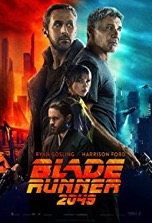
Starring: Ryan Gosling
October 2017
What follows is the full-length review based on comments that were originally tweeted in Real-time from the back row of a movie theater @BackRoweReviews. Though efforts were made to tease rather than ruin this movie’s memorable lines and moments, some spoilers may exist in the following evaluation. For concerns over objectionable content, please first refer to one of the many parental movie guide websites. Ratings are based on a four star system. Happy reading!
A sequel 35 years in the making, Blade Runner 2049 is a respectable, if not orbit-altering, follow-up to Ridley Scott’s 1982 cult classic, Blade Runner. There are several key production aspects to discuss right up front: First, even though Scott is a producer on the film, he didn’t direct it. That honor fell to Denis Villeneuve, who helmed the visually stunning, style-over-substance Arrival last year (more on the movie later). So why didn’t Scott direct the sequel himself? Unknown. What is known is that Villeneuve does a remarkable job of marrying his visual style to the aesthetic Scott established in the first film. The latest iteration of Runner’s future shock society is both a logical extension of the original’s style and a tribute to the cosmopolitan, seedy, neon world brought to life by Scott and cinematographer Jordan Cronenweth. Another keen production decision was to show a progression of design elements to reflect the sensibilities of the era—the first film was set in 2019, thirty years earlier than the sequel. If possible, things are even more dingy and rundown in the new film. Also, the showgirl sexploitation in the original has been digitized and supersized—a ten story tall nude woman interacts with oglers on the street. Just as our society has made a giant out of the porn industry since 1982 (due in large part to the internet), so too have the inhabitants of Runner’s neo-noir dystopia. Another scene depicts huge hovering trash trucks dumping garbage onto a vast plain, filled with segregated piles of trash a la the opening of WALL-E (2008). The environmental message here is clear. This setting becomes the locus of a brief, yet intense, action scene involving Ryan Gosling’s Officer K (not to be confused with Agents J and K from the Men in Black movies). Ironically, Gosling’s co-star had a memorable trash sequence of his own forty years earlier in Star Wars (1977). That co-star, of course, is Harrison Ford, who reprises his role as Rick Deckard, the central character from the first film. There’s good and bad news here. The good news is that Ford is extremely effective in his scenes, especially during the denouement (see below). The bad news is that Ford doesn’t show up until the movie’s halfway mark. Gosling and Ford appear to have good screen chemistry, but the sample size of their shared scenes is so small, it’s difficult to positively affirm that observation. Another original cast member, Edward James Olmos, appears here too. Sadly, Olmos is only in one scene and looks like Colonel Sanders with his gray mustache and pointed goatee. Other cast members shine in limited roles, such as: Dave Bautista, Jared Leto, Robin Wright and Mackenzie Davis. The production elements are finely crafted and are wholly immersive. Particularly eye-catching are the interior sets, which are lit with otherworldly hues or mesmerizing water ripple effects. If there’s one area of the movie that doesn’t succeed it’s the overlong, onerous, obtuse screenplay by Hampton Fancher and Michael Green (based on the story by Philip K. Dick). In general, the “show-don’t-tell” cardinal rule of writing should be followed to the letter. Here, that maxim is taken to the extreme as characters are often shown in contemplative poses or gazes for so long, you can get your popcorn refilled and still not miss anything. True, a plot should never be spelled out, but the audience needs something to go on. A string of scenes that “show-show-show” with no dialog, exposition or contextualization, can become tedious, as exemplified by this film. Granted, the pressure to follow up the original film with another instant classic must’ve been oppressive for the writers, but the insistence on skewing so far to the art side of the spectrum, while forgetting that a broad swath of the audience was drawn to the film for its commercial elements, was a serious miscalculation. Much like Villeneuve’s Arrival, Runner 2 has sacrificed meaning and accessibility for style points. Was the tradeoff worth it? Time, and ticket stubs, will tell. The seaside struggle is an intense sequence, but certainly isn’t the nail-biting climax the film needed to drive the story home. However, the final series of scenes are the finest in the film and help to boost its rating far above that of the refuse heaps of standard movies. Villeneuve stages some symbolic and synergistic parallel action sequences between Officer K and Deckard at movie’s end. K lies back on concrete steps as snow (in L.A.) sprinkles down around him. It’s a gorgeous shot, but I half expected Gosling to make a snow angel—perhaps he did in an outtake. The scene inside the building, where Deckard meets his daughter, Ana Stelline (Carla Juri), for the first time, is much more meaningful. Deckard places his hand on the glass wall that separates him from his daughter. It’s a moving scene of connection despite the division of walls and years. Ironically, we saw this same pose in another 1982 sci-fi release, Star Trek II: The Wrath of Khan, when Kirk holds his hand against the Plexiglas wall that isolates him from a dying Spock. Now would be an appropriate time to mention that Ford is a tremendous “hand” actor. He channels enormous energy into scenes where he points an accusatory finger at someone (The Fugitive and Clear and Present Danger) and is also marvelous at grabbing and using objects around him (numerous instances in the Indiana Jones films, especially the idol scene in Raiders of the Lost Ark). Here, the simple action of placing his hand on a translucent wall carries with it tremendous power—the scene literally sent chills up my spine. It was the first time in the film I felt any kind of emotion. Sadly, it was the final shot of the movie. In the end, there can be no doubt that Runner 2 is a worthy film in its own right and that it has moved the series forward without being an embarrassment to the original. However, Runner 2, like its robotic replicants, has little emotion and heart. Still, Runner 2 is a beautiful film that bears repeat viewings to uncover all of its hidden meanings and Easter eggs. Speaking of which, Ana is creating snow with her hands when Deckard walks in to meet her. Is this the same snow that’s drifting down onto Officer K? And if so, is his character real? Or just dreaming? Of electric sheep?
The Dark Tower (PG-13)
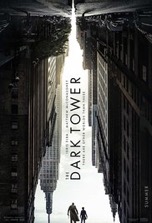
Starring: Idris Elba
August 2017
What follows is the full-length review based on comments that were originally tweeted in Real-time from the back row of a movie theater @BackRoweReviews. Though efforts were made to tease rather than ruin this movie’s memorable lines and moments, some spoilers may exist in the following evaluation. For concerns over objectionable content, please first refer to one of the many parental movie guide websites. Ratings are based on a four star system. Happy reading!
Having read the first book of Stephen King’s The Dark Tower novel series in advance of viewing the film of the same name, I’m disappointed in director Nikolaj Arcel’s efforts on several levels. First, only about ten minutes of the movie comes from the first book (primarily the Western scenes). Second, none of the atmosphere (“They could see the smooth, stepped rise of the desert into foothills, the first naked slopes, the bedrock bursting through the skin of the earth in sullen, eroded triumph”), poetry (“Time’s the thief of memory”) or visual vitality (“The guns did their work, stitching the darkness with red-white lances of light that pushed needles of pain into the gunslinger’s eyes”) of King’s book has been translated onto the big screen. Third, in the mold of Percy Jackson & The Olympians (2010) and The 5thWave (2016), The Dark Tower is told through the eyes of a young teenager and has that family-friendly, teen peril vibe to it that belies the book’s somber, sullied soul. Indeed, the book is much more adult (bars, brothels and bullet storms) than the movie and focuses on the exploits of the adults: Roland/the Gunslinger (Idris Elba) and Walter/the Man in Black (Matthew McConaughey). Although the stars are well suited (and enjoyably cast against type) to their roles, they both seem bored with the material. Much like his stiff portrait in Pacific Rim (2013), Elba turns in a one-note performance here. McConaughey, who is supposed to be playing a latter-day grim reaper, is not nearly as menacing as he should be in the role. Case in point: Walter verbally abuses one of his minions for having a rat face. By contrast, Darth Vader would’ve just Force choked the offensive underling and signaled for the body to be dragged off. The best part of the film is Tom Taylor as Jake. Jake, who has visions and powers (chief among them is his skill with a pencil and art pad), is an interesting character that, due to the uninspired writing by Akiva Goldsman, et al., never develops into anything more than Roland’s 2D sidekick. In the end, the film’s commercialized story is its Achilles’ heel, since adherence to the source material would’ve made for a subtly nuanced, psychologically complex pursuit film. The end result here is a glorified teen film that attempts to emulate the visual ingenuity of The Matrix (1999) and Doctor Strange (2016), but ends up resembling (in quality if not movie magic) Tomorrowland (2015). King’s early masterwork deserved a much better cinematic fate.
Spider-Man: Homecoming (PG-13)
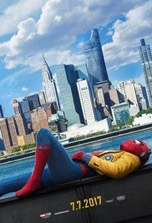
Starring: Tom Holland
July 2017
What follows is the full-length review based on comments that were originally tweeted in Real-time from the back row of a movie theater @BackRoweReviews. Though efforts were made to tease rather than ruin this movie’s memorable lines and moments, some spoilers may exist in the following evaluation. For concerns over objectionable content, please first refer to one of the many parental movie guide websites. Ratings are based on a four star system. Happy reading!
Sam Raimi helmed the three numbered Spider-Man films spotlighting Tobey Maguire, Marc Webb directed the two Amazing Spider-Man flicks featuring Andrew Garfield and Jon Watts is the shot caller behind the new subtitled wall-crawler series starring Tom Holland. Despite the changing faces on both sides of the camera, Spider-Man has remained a juggernaut at the box office over the past fifteen years. This sixth Spider-Man film makes a wise decision right out of the gate—it skips the spider bite origin story, which we’ve seen ad nauseam by now, and instead gives the movie context by cleverly showing a POV camcorder recording of Spider-Man’s derring-do during the climactic battle in Captain America: Civil War (2016). Kudos to Watts and his team of five writers for electing not to waste an hour of screen time on Spidey’s back story before initiating the actual story. The film opens eight years in the past and shows foreman Adrian Toomes (Michael Keaton) losing a contract to the government while cleaning up the debris after the NYC alien invasion as depicted in The Avengers (2012). Toomes discovers some alien technology in the rubble, fashions it into a bird suit and becomes villain Vulture (to remain consistent with Keaton’s other avian themed characters in Batman and Birdman). Meantime, Peter Parker (Holland) is desperately trying to impress a girl he’s crushing on at school while keeping up his grades and maintaining an internship (wink, wink) with Tony Stark (Robert Downey Jr.). Aunt May (Marisa Tomei) can tell Peter is going through some difficulties, but chalks it up to normal teenage changes. Peter’s friend, Ned (Jacob Batalon), provides some comic relief, and becomes trusted assistant (like Stark’s Happy Hogan) when he accidentally stumbles onto the secret of Peter’s alter ego. The story heats up about halfway into the film when Spidey spies on an illegal weapon’s exchange one night. After clumsily blowing his own cover (the fiery red suit certainly doesn’t help on recon missions), Spidey unwittingly interrupts the shady dealings of Vulture’s men, which sets off a chain reaction that eventually pits Spidey and Vulture in mortal combat. The film’s resolution pretty much dictates itself from there. There’s a good deal of high school angst in the movie, especially in the early goings, which hearkens back to the very first film. These scenes establish the setting and characters, provide background for Peter and are effective in showing the exigencies of his daily life, which, of course, is a stark contrast to his life at night. Although necessary for grounding the film and giving us a glimpse into the struggles of the real person behind the mask, these school scenes, particularly the prom proceedings, feel like they were lifted right out of an ABC Family or CW drama. However, more so than McGuire and Garfield, Holland nails Peter’s wide-eyed, overly idealistic and adorably naïve characteristics. Peter’s two caring, if absentee, guardians—May and Stark—offer him drive-by advice, but never when he needs it most…like when he discovers the identity of his archnemesis. As for Vulture, Keaton delivers an exceedingly restrained performance, especially when compared to the prototypical Marvel antagonist. We can identify with Toomes because he’s just an ordinary guy who makes a bad decision for the right reason…to provide for his family (and stick it to the government). Refreshingly, Keaton’s voice doesn’t change for effect, nor does he become more bombastic in speech and manner while inhabiting Vulture’s wing suit. As such, Vulture is one of the most realistic comic book movie villains ever (ironically, the runner-up is Spider-Man 2’s Alfred Molina as Doc Ock). Sadly, Vulture never strikes fear into the viewer and doesn’t really test Spidey’s mettle, which is a significant narrative misfire. This Spidey outing avoids many of the gimmicks employed in the earlier movies, i.e. rescuing cats in trees, etc, and offers some humorous asides, like when Spidey runs out of buildings to sling webs from and must jog a mile across a golf course in order to respond to an emergency. Though slow in developing, Homecoming is an exciting superhero action film once the plot kicks into high gear. If the movie has any weak spots, it’s that the story is surprisingly light-weight and that Spidey can never truly spread his wings and fly due to the intermittent avuncular advice and canned wisdom from Iron Man and Captain America (Chris Evans), respectively. Expanding on that analogy, it’s time for Spidey to fly solo in the next film. Like its young star, this third attempt at launching a Spider-Man franchise has loads of potential. Now it’s time to see if the series can live up to that potential or collapse under the weight of it.
Wonder Woman (PG-13)
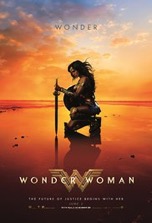
Starring: Gal Gadot
June 2017
What follows is the full-length review based on comments that were originally tweeted in Real-time from the back row of a movie theater @BackRoweReviews. Though efforts were made to tease rather than ruin this movie’s memorable lines and moments, some spoilers may exist in the following evaluation. For concerns over objectionable content, please first refer to one of the many parental movie guide websites. Ratings are based on a four star system. Happy reading!
Let’s face it, the best part of last year’s Batman v Superman: Dawn of Justice was the arrival of Wonder Woman (Gal Gadot) during the epic confrontation. Providing some much needed vitality and panache to a mostly ponderous and lackluster film, Wonder Woman’s presence served the dual function of saving one film and instilling confidence in her ability to carry another. As it turns out, that confidence was well-placed since Wonder Woman is a far better film than that other one where the two squabbling male heroes needed the feminine touch to avert Doomsday. The first film to feature a female superhero opens with an elegant back story that gives us a glimpse into the early years of clay-made Diana (Lilly Aspell), who is raised on a paradise island among Amazon women—governed by Connie Nielsen and Robin Wright. We’re treated to a montage of well-choreographed training scenes, and then, quicker than you can yell “Princess of Themyscira,” Diana (Gadot) has transformed into an adult. Diana’s tranquil, idyllic life is suddenly disrupted by the arrival of a German plane that crashes into the ocean inside the protective dome created by Zeus (isn’t it supposed to be impenetrable?). Diana rescues the pilot, Captain Steve Trevor (not James Kirk), who is played by Chris Pine. Steve, a British spy who speaks with an American accent, is in possession of information that could prove instrumental in ending the war. Diana is also invested in the cessation of hostilities and assigns herself the task of destroying Ares, the god of war. But will their opposing views on how to stop the bloodshed create its own conflict between Diana and Steve? Set during WWI, WW is a curious cross-universe twin of Marvel’s Captain America: The First Avenger (2011), which took place during World War II and also featured a super-strong hero armed with an impervious, circular shield and an unerring moral compass. Was setting WW in 1918 instead of the post-Doomsday present a misstep? Hard to say, but the film’s quality certainly doesn’t suffer from the decision over its milieu. Gadot and Pine have excellent chemistry together and the other performers offer stellar support, especially Danny Huston and David Thewlis. WW contains the optimal balance of story to action…let’s hope the upcoming Justice League follows that same formula. And why no Superman in JL? Wasn’t DC’s long game with Man of Steel (2013) and BVS to have Henry Cavill, along with Ben Affleck and Gadot, headline JL—a strategy filched wholesale from rival Marvel, which set up The Avengers franchise with its raft of stand-alone superhero showcases? Superman’s conspicuous absence from JL not only squanders Cavill’s talents, but also sidelines one of the most recognizable superheroes in the world from anchoring a film that’s been in the planning stages for years. Well, at least Wonder Woman will appear in JL. She’s proven herself to be a solid reliever as well as a dependable starter. WW is the best DC movie since Christopher Nolan’s Batman films. Will wonders never cease?
Guardians of the Galaxy Vol. 2 (PG-13)
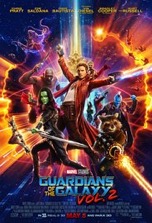
Starring: Chris Pratt
May 2017
What follows is the full-length review based on comments that were originally tweeted in Real-time from the back row of a movie theater @BackRoweReviews. Though efforts were made to tease rather than ruin this movie’s memorable lines and moments, some spoilers may exist in the following evaluation. For concerns over objectionable content, please first refer to one of the many parental movie guide websites. Ratings are based on a four star system. Happy reading!
The first Guardians of the Galaxy (2014) seemed to come out of left field—some obscure corner of the Marvel universe where the studio’s typical mock earnestness and platitudinous dialog was hastily jettisoned out the nearest airlock in favor of irreverent jibes and free-flowing wisecracks—and was wildly successful due to its star power and effective mixture of laugh-a-minute antics and mind-blowing action sequences. Sadly, that approach hasn’t been altered even one iota in the sequel, Guardians of the Galaxy Vol. 2. It’s hard to believe that such a successful formula could become outdated so quickly, but this follow-up film suffers from a severe case of sequelitis. Though GOTG2 isn’t quite perfunctory, the story feels rushed along…it’s as if director/writer James Gunn, in his haste to return to this hugely popular and financially lucrative franchise, forgot to develop a plot and simply reheated the leftovers from the first film. Rocket (Bradley Cooper) generates a few laughs, but his shtick is predictable and almost annoying this time around. Although sapling Groot (voiced by Vin Diesel) is absolutely adorable, the bits where he fails to deliver what Rocket wants are also worn from repetition by now. Drax’ (David Bautista) ego is as enormous as his pecs and his superpower is his ability to simultaneously annoy Gamora (Zoe Saldana) and the audience. The movie’s saving grace (aside from the brief cameo by Sylvester Stallone), is its writ large theme of reconciliation. The temporary truce between warring sisters, Gamora and Nebula (Karen Gillan), makes for a mildly diverting subplot. Yondu (Michael Rooker), minor antagonist in the first film, finds redemption (albeit on a false note) here as Peter Quill’s (Chris Pratt) surrogate father. Peter’s real father arrives on a ship that looks like a gigantic egg, introduces himself as Ego, claims to own a planet and is played by none other than Kurt Russell…how ironic that Russell’s career started with goofy Disney movies and that he’s returned to the fold now that the Mouse House owns Marvel. The circle is now complete. And speaking of Star Wars, there’s a palpable Vader/Luke vibe going on when Ego tries tempting Peter into turning his back on his friends and accompanying him on a quest to rule the universe (Russell and Pratt have excellent chemistry in these scenes). It would’ve been a clever twist to show Peter testing out his newfound abilities—reveling in the unlimited power at his disposal to create whatever his heart desired—just to make us think that he might follow his dad to the Dark Side. But this film wouldn’t know what to do with that kind of subtlety, intrigue or complexity. For better or worse, GOTG2 is a straightforward action piece. Though this sequel will be a disappointment to many, there’s enough overblown action and overstated jokes to appeal to the popcorn set. Here’s hoping the eventual sequel will bring back the thrill ride exhilaration of the first film and replace these cardboard characters with the genuine articles from the original. And where is John C. Reilly?
Life (R)
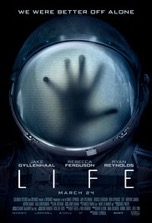
Starring: Jake Gyllenhaal
March 2017
What follows is the full-length review based on comments that were originally tweeted in Real-time from the back row of a movie theater @BackRoweReviews. Though efforts were made to tease rather than ruin this movie’s memorable lines and moments, some spoilers may exist in the following evaluation. For concerns over objectionable content, please first refer to one of the many parental movie guide websites. Ratings are based on a four star system. Happy reading!
It’s very tempting to call Life a cheap knockoff of Alien and just leave it at that. Actually, Life pilfers from other sci-fi movies too, like the recent Passengers. Both films open with a meteor shower wreaking havoc on a spaceship and end with one male and one female survivor who must save that ship and humanity as we know it. Granted, what lies between those narrative bookends is divergent to the extreme. The Alien comparison is more apropos since the bulk of Life’s story deals with a too strong, too fast and too smart creature that slinks about the ship picking off one cardboard character at a time. Like so many sci-fi and horror creature features these days, there’s no emotional impact when characters die because we have no personal connection to them—a failure on the part of the writers to customize personality traits and construct compelling back stories. But character development isn’t the only area of the movie where screenwriters Rhett Reese and Paul Wernick were derelict. Plot holes large enough to fly a Soyuz spacecraft through bedevil a story that already has problems with pitch and yaw thanks to its derivative storyline and plot contrivances. These contrivances, designed to keep the thrills coming at a rapid pace, are so daft they make you want to throw your bucket of popcorn at the movie screen. Chief among these inanities is the poorly designed exhaust manifolds (or some other such technobabble) on the ship’s thrusters. The creature will enter the ship unless the crew engages the thrusters to flush it out of the engines, but commencing a burn will put the ship on a collision course with Earth’s atmosphere. So the lesser of two evils is to let the creature back into the ship where they hope to kill it, despite the fact that they didn’t even come close to doing so earlier. Utter tripe! The creature design and FX that brought it to life are absolutely spectacular. As such, the creature’s greatest flaw doesn’t come from the drawing board but from the script. Rhett and Wernick, along with director Daniel Espinosa, made the creature too indestructible. The fact that a Martian creature can thrive in an oxygen environment is dubious from the start, but when that squid-like blob can outsmart humans at every turn…on their own turf? C’mon! At the very least, you’d expect the stellar cast to be able to pull the story out of its tailspin, but due to the poorly drawn characterizations, such is not the case. The fact that Ryan Reynolds’ wise-cracking character (a slightly toned down version of the titular antihero in Deadpool) can never keep his mouth shut is ultimately his undoing. Jake Gyllenhaal and Rebecca Ferguson make the most of what they’re given, which isn’t much aside from running and shouting. One of the only things the film gets right is that the black guy (Ariyon Bakare) isn’t the first character to die. However, this one eschewed stereotype doesn’t make up for the virtual procession of tired thriller tropes employed by the movie. Well, there you have it—this is Life or something like it. Actually, due to its hunter/hunted plot, this movie should’ve been called Death. Unless you’re pulling for the Martian creature, in which case the current title works just fine.
Logan (R)
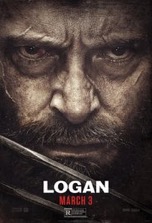
Starring: Hugh Jackman
March 2017
What follows is the full-length review based on comments that were originally tweeted in Real-time from the back row of a movie theater @BackRoweReviews. Though efforts were made to tease rather than ruin this movie’s memorable lines and moments, some spoilers may exist in the following evaluation. For concerns over objectionable content, please first refer to one of the many parental movie guide websites. Ratings are based on a four star system. Happy reading!
Logan is Hugh Jackman’s ninth X-Men film and his third solo outing as Wolverine. Sadly, after seventeen years of portraying feral mutant, Logan marks Jackman’s final appearance in the franchise. Just as attrition has finally set in for the 48-year-old actor, Logan can no longer heal as quickly as when he was younger and feels the sting of every bullet that impacts on his adamantium exoskeleton more acutely than in his prime. Whereas Logan’s pain is physical, Charles Xavier’s (Patrick Stewart) is mental. In fact, the usually well composed Professor X, Logan’s longtime mentor, is losing his mind to the ravages of dementia. If you’ve ever wondered what would happen if Professor X got really mad and unleashed all of his mental powers into one furious barrage (like Cyclops without his shades), you’ll definitely want to keep an eye out for the movie’s psionic blast sequences…amazing FX. For two characters who started off on rough footing, Charles and Logan have become good friends; you might say they’re almost like a non-related father and son. The scenes where Logan, dutiful son, takes care of Charles, aging parent, are genuinely moving. It’s profoundly sad to see such a brilliant a mind wasting away, but Father Time eventually catches up to everyone, even mutants it would seem. The film’s family connection extends to Laura (Dafne Keen), a young girl who exhibits Logan’s ferocity while fighting and possesses his ability to rapid heal. Logan, directed by James Mangold (Walk the Line), is essentially a pursuit film with Logan attempting to outrun his past so that he can simply fade into obscurity. Although there are plenty of elaborately choreographed action sequences, the story occasionally stops to corral stray horses, which detours the through-line and delays the film’s mission. These scenes are a double-edged sword since they slow down the action in order to provide meaningful character moments, which effectively ground the story and prevent its more spectacular elements from running away with the show. Still, without episodes like the dinner at the farmer’s house, the film would have far less heart. Once the “special” bullet (similar in concept to a silver bullet for a werewolf) is introduced we have a pretty good idea of how it will be used—and, indeed, the ending is painfully obvious. Even though Wolverine’s demise is precipitated by a pulse-pounding fight sequence, he still deserved a more spectacular, more heroic sendoff. However, the scene where Logan passes the torch to the next generation of mutant heroes is heartwarming. So where does the franchise go from here? Will Marvel bestow Wolvie’s claws, laconic speech and rugged mien on a younger actor? Will Laura lead a whole new team of mutants? One thing’s for sure, the X-Men franchise will never be the same. But we can take solace in knowing that Logan/Jackman went out on top in, arguably, the first mature superhero movie ever made.
Passengers (PG-13)
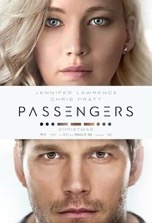
Starring: Jennifer Lawrence
December 2016
The below comments (in Black) were originally tweeted in Real-time from the back row of a movie theater and appear @BackRoweReviews. Though efforts were made to tease rather than ruin this movie’s memorable lines and moments, some spoilers may exist in the following evaluation (in Red). For concerns over objectionable content, please first refer to one of the many parental movie guide websites. All ratings are based on a four star system. Happy reading!

Pod 1498 contains some guy named #Starlord. #Avalon #HomesteadII
“Just own it, Jim.” #OwnIt
A lot of similarities to #WALLE, especially the score by #ThomasNewman. #Autopilot #Axiom #Avalon
“I woke up too soon.” Jim is a bit of an #EarlyBird. #Avalon
“It’s not possible for you to be here.” That’s the point, #RoboTender. #Glitch
No #PumpkinSpice on the #Avalon? There goes the future.
The #SpaceLeap scene is absolutely breathtaking.
Jim trips on a bottle...it’s been the downfall of many men.
“It sure has a nasty sense of humor.” #Universe
#Aurora Overdetermined sci-fi name?
“The ultimate geographical suicide.” #SpaceHibernation #Avalon
Most amazing swimming pool in the universe.
Holding hands among the stars...best first date ever.
“You’re the most beautiful woman I’ve ever seen.” Every man left on Earth agrees with you, Jim.
Loose-tongued bartender ruins Jim’s proposal. #PlotTwist
Public Service Announcement: Never go swimming in #ZeroGravity. #Avalon
612 physical disorders. Oh Frack!
The #Avalon is supposed to be #Meteor proof. Yeah, and the #Titanic was supposed to be iceberg proof.
Those last ten minutes were heart-stopping.
Final analysis: a #Titanic meets #WALLE lost in space yarn with scintillating central performances.
The only drawback here is its derivative plot.
Rating: 3 1/2 out of 4. #JenniferLawrence and #ChrisPratt have tremendous chemistry in this space survival story.
Freebie: the 3 dits, 3 dahs and 3 dits on the poster is #MorseCode for #SOS.
What if a man was accidentally awakened from a suspended animation nap ninety years earlier than planned? What if that man, the only conscious person aboard a gigantic spaceship headed for a distant planet, went bat guano crazy from being alone all the time? What if the man watched the video profiles of the 5,000 passengers on the ship and fell in love with one of the women? And what if that man, in the throes of loneliness and boredom, decided to rouse that sleeping beauty from her pre-programmed slumber? Such is the set up for the new sci-fi/romance movie, Passengers. Starring Jennifer Lawrence and Chris Pratt as star-crossed lovers who must negotiate the bitter realities of premature reanimation, the film is a master course in male/female relational dynamics in survival situations. The two stars have tremendous screen chemistry and nearly carry the entire movie by themselves—nearly. Michael Sheen and Laurence Fishburne play side characters who offer stellar support to the central couple, providing them with much needed advice and experience…and bridge access. There really aren’t enough superlatives to describe Lawrence and Pratt’s performances, so I’ll move on to an area of the movie I can critique. As is the case with many movies these days, the writing here is a mixed bag. Screenwriter Jon Spaihts is exceedingly adroit at evincing character motivations and habits and has skillfully infused the film with a tremendous amount of humanity despite its sterile, mechanical trappings. There’s a firm grasp of human relationships in the movie and the characterizations are flawless down to the most infinitesimal nuance. The romance subplot is sweet without being saccharine—the scenes where Aurora (Lawrence) and Jim (Pratt) have their first breakfast and first date are real gems. Commentary on class structure is cleverly woven into the narrative, like when we see Jim’s standard breakfast placed alongside Aurora’s Gold Star breakfast. The fact that Jim is an engineer and Aurora is a writer who comes from a family with means and status also addresses the inequities of humanity’s current caste system. Arthur (Sheen), the robot bartender, dispenses many keen observations on the human condition along with clever quips which add the appropriate amount of humor to this mostly serious film. Whereas Arthur brings the comic relief, Gus Mancuso’s (Fishburne) tragic sidebar furnishes the film with poignant pathos. The scenes where Aurora gives Jim the silent treatment are deftly crafted by Spaihts and expertly acted by Lawrence, who brings these scenes to life with startling realism (as any man who’s ever been spurned by a woman can attest). The prospect of dying alone in space versus the ethical dilemma over reviving a potential companion (which will consign her to a life of isolation) is the crux of the film and the implications of Jim’s fateful choice have profound ramifications on the entire story. One of the movie’s subtly stated motifs suggests that when our life’s aspirations go unrealized it’s how we choose to cope with our Plan B existence that defines us as individuals. Ultimately, Aurora (an overdetermined sci-fi name?) gets to write an exclusive, historic story, but it isn’t the one she had originally envisioned. Sadly, powerful takeaways like this one are overshadowed by contrived crises (like the escalating calamities that comprise the film’s conclusion), plot inconsistencies (Jim can browse personal personnel files and borrow a space suit, but is denied access to the bridge and can’t order a decent breakfast) and the movie’s Achilles’ heel…derivative storytelling. Aside from its “Adam and Eve in Space” premise, Passengers weaves elements from many other movies into its narrative tapestry. The most obvious thematic antecedent to this film is Titanic (1997). Both stories feature an upper class woman and a lower class man who fall in love on their way to a new world, but their ship encounters a dangerous obstacle along the way which threatens their survival. The obstruction in Titanic is an iceberg; here it’s an asteroid field. Perhaps the biggest source of inspiration for this film is WALL-E (2008). Both films feature long-range, resort style space vessels (with similar names—Axiom in WALL-E and Avalon here) which are conveying humans to a new planet since Earth is in a state of decay. These movies also employ an antagonistic autopilot which serves as a hindrance to our heroes. Additionally, Jim’s thrilling leap into space is reminiscent of WALL-E’s frolic among the stars. The final point of comparison between these films is that their scores have a similar style, which is fitting since the composer for both films is Thomas Newman. In addition to its pastiche plot, Passengers has an overwrought resolution, which is merely a series of near-death scrapes designed to produce a heart-pounding climax. This gimmicky ending is unnecessarily commercial and is incongruous with the rest of the film, which is essentially a big budget art film. A more contemplative denouement was in order here—one where we meet Jim and Aurora’s progeny and where we hear Aurora reading an excerpt from her book in a V.O. narration as the Avalon arrives at Homestead II. This emotionally complex and thought-provoking yarn deserved that kind of powerhouse finale—the extant epilogue is pat and merely satisfactory. Final thought: have you ever seen a more breathtaking pool? Or swimmer?
Rogue One: A Star Wars Story (PG-13)
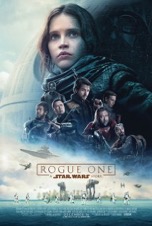
Starring: Felicity Jones
December 2016
The below comments (in Black) were originally tweeted in Real-time from the back row of a movie theater and appear @BackRoweReviews. Though efforts were made to tease rather than ruin this movie’s memorable lines and moments, some spoilers may exist in the following evaluation (in Red). For concerns over objectionable content, please first refer to one of the many parental movie guide websites. All ratings are based on a four star system. Happy reading!
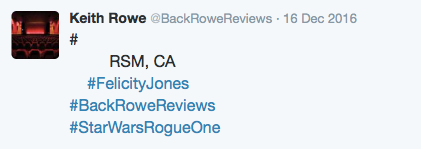
The only #OpeningCrawl you’re gonna see is in my last tweet. #Spoiler
“Trust the Force.” Yes! #TheForce
“You’re confusing peace with terror.” #GalenErso #GreatLine
“We have a long ride ahead of us.” Don’t you mean flight? #SawGerrera
#PlanetKiller aka #DeathStar
“Congratulations, you are being rescued.” LOL #K2SO
#BailOrgana sighting.
“I find that answer vague and unconvincing.” Hilarious! #K2SO
#SawGerrera needs to breathe oxygen...he’s a #LightSide version of #DarthVader.
How the #Frack did they make that guy look just like #Tarkin?
“Hey, you just watch yourself.” Ha! #InsideGag
“Rebellions are built on hope.” #RebelAlliance
#Wampa sighting. They’re pretty good in a fight.
Why don’t they let the pilot steer the ship instead of K2SO?
“You’re a rebel now.” #K2SO #RebelAlliance
“You might as well be a stormtrooper.” Ouch! #Stormtrooper
“Be careful not to choke on your aspirations.” #DarthVader #KillerLine #ForceChoke
“The time to fight is now.” #JynErso Yes!
“There is no Rogue One.” There is now.
“We’ll find a way to find them.” #JynErso #DeathStar #DeathStarPlans #StarWars
#Stormtroopers are so dull...they’re still talking about the T-15. #T15
The #DeathStar can jump to #Hyperspace? That’s new.
#R2D2 and #C3PO sighting.
The #ShieldCrash scene is spectacular.
This mustached #XWing pilot is boss.
These #TIEFighters are as thick as mosquitoes in #Alaska during summer.
The #StarDestroyer collision is magnificent. #Hammerhead
I see a pale #DeathStar rising.
“Hope!” A new hope. #PrincessLeia
#StarWarsRogueOne or #TheOneWhereTheyAllDie
Final analysis: an effective “bridge” adventure leading up to #ANewHope that succeeds by taking risks.
Though weak on character development, the #Dune style planet-hopping & intense action scenes compensate.
2 1/2 out of 4. A unique, stand-alone chapter in the #StarWars saga that is choked by its action scenes.
In a galaxy far, far away… There was Rogue One: A Star Wars Story. Taking place between Star Wars Episodes III and IV, Rogue is a unique entry into the Star Wars canon. That last word was specifically selected since the film’s subtitle suggests an ancillary or non-canonical Star Wars adventure. Even though Rogue One is an official chapter in the saga, many of its components have conspired to make it seem otherwise. This notion is bolstered by the fact that most of the characters in the film are new to the Star Wars universe and that, for the first time in franchise history, the spotlight has largely shifted away from the Skywalker family. Also, the absence of the Fox Fanfare, the introductory phrase (see my first sentence), the opening crawl and the inclusion of a new title screen (which looks like a cheap knockoff of the iconic golden graphic), all earmark Rogue as an off-format, stand-alone Star Wars film. Additionally, the man calling the shots, Gareth Edwards, is also a newcomer to the series—as well as to directing in general since the only notable film he’s helmed is the God-awful Godzilla (2014). Oh, and lest we forget, an indelible part of what makes Star Wars so magical is the majestic, transcendent music of John Williams. Rogue is the very first Star Wars film to feature a score by someone other than Williams: fresh off of a stint for the other major sci-fi universe (Star Trek Beyond), Michael Giacchino has taken the baton from the maestro. I’ve been critical of Giacchino’s previous efforts, particularly his work for the new Star Trek movie series, so I listened to this score with an extremely critical ear. In my estimation, Giacchino has crushed it like a trash compactor. Giacchino’s orchestrations have captured the essence of Williams’ signature sound (on some cues you’d swear Williams had written the chart) without outright mimicking it, which is to his credit. All of the abovementioned elements have established Rogue’s distinctiveness from the trilogy films which brings us back to that thorny issue of canonicity. Aside from raising concerns over Rogue’s status as a legitimate Star Wars film, the word canon also has a religious application here. In theological terms, Rogue is an intertestamental (between the Old and New Testaments in the Bible) or apocryphal (meaning non-inspired or spurious in nature and not to be included in the canon of scripture) tale. Biblical allusions also extend to the main team of rebels in the movie (which some could argue comes too soon on the heels of that other film about a team of misfits who defended a dusty village from evildoers on a different frontier in the recent remake of The Magnificent Seven). Saw Gerrera (Forest Whitaker) both in function (preparing the way for the rebellion) and appearance, is a type of John the Baptist, while Jyn Erso (Felicity Jones), in the way she gathers disciples for a mission of mercy to save the universe from the tyranny of the Evil Galactic Empire (Spoiler: to say nothing of her ultimate sacrifice), is a type of Christ. The mesa-top community on desert planet Jedha (too similar to Jedi?) also has a religious connection since it resembles the ancient city Masada, a Jewish fortress that was recaptured by the Roman Empire in the first century. Here, Jedha, the site for an early battle in the film, is occupied by a different kind of Empire…one that dispatches its stormtroopers to patrol the streets of the city and maintain order with blasters and tanks. The image of a Star Destroyer hovering over the besieged city is a striking visual that instills a feeling of dread as the citizens below are made to live under the ever-watchful eye of their merciless overlords. The fact that Jedha was filmed in Jordan, part of the Holy Land, further adds to its spiritual mystique. Religious readings aside, the story contains many other aspects that are ripe for analysis. I’ve distilled all of my various opinions and criticisms into three categories: the good, the bad and the ugly. Just for fun, let’s work backwards. The Ugly award definitely goes to the movie’s computer animated visages of two vintage Star Wars characters—one from each side of the Force. Though shot in appropriately dim interiors (which actually helps to veil the artifice), the Dark Side character came out fairly well, despite being a shock to the system at first glance. By contrast, the Light Side character is shot in a bright room and simply looks awful—the effect is similar to dropping CG Tintin (from 2011’s The Adventures of Tintin) into a room full of live action actors. It’s so painfully obvious the character isn’t organic that it sends the audience’s suspended disbelief crashing to the ground and completely ruins the moment, which, incidentally, is the final scene in the film. CG aliens seem to hold up fairly well over time (Jar Jar Binks is annoying as poodoo, but he’s brilliantly realized), but will these CG humans look tackier than they already do as time and technological advances render them more and more obsolete, like the CG characters from the 80s? Leading off the Bad category is our old nemesis…anachronistic technology. Why is it that the creative forces (directors George Lucas, J.J. Abrams and now Edwards) behind each new Star Wars film can’t resist the urge to create new ships and technology, heedless of how that technology may cause aggravating anachronisms, like when R2-D2 suddenly sprouts leg rockets and takes flight in Episode II when no such ability exists in the later films? Here we have obsidian Death Troopers as well as a host of new ship designs, including: U-wing fighters, Hammerhead corvettes and TIE Strikers. Since the events of Episode IV occur directly after this film, where are all of these vessels in the original trilogy? Are we to believe that all of the new ships, on both sides of the conflict, are mothballed the moment the final battle ends? This conspicuous incongruity underscores the same highly criticized issue that plagued the prequels since many of the ships here look newer than the ones in the later films (Episodes IV-VII). Another anachronism involves one of the new droids, K-2SO (voiced by Alan Tudyk), which is essentially C-3PO (Anthony Daniels) on steroids. Whereas Threepio is fussy and loquacious by bent and programming, K2 is a sarcastic sidekick with a malfunctioning tact subroutine. So why is K2 in the Bad category? For starters, K2 is far more advanced than any other droid ever created for the series, including those manufactured decades into the future (like BB-8). Additionally, wisecracking computers (albeit shipboard ones) have been done ad nauseam in sci-fi TV (Red Dwarf and Tripping the Rift) and books (the Star of the Guardians series by Margaret Weis), to name just a few. Shifting back to living beings, the only disappointment in the cast is Whitaker’s Gerrera (a younger version of the character first appeared in The Clone Wars animated series). Not only is Gerrera’s raspy, high-pitched voice annoying and wildly inconsistent from scene to scene, but it makes him sound like he has a thermal detonator shoved up where the sun doesn’t shine (even on Tatooine). Though clearly intended to be a colorful character, Gerrera is a campy caricature, made utterly laughable by a goofy Jamaican accent, finger-in-a-toaster coif and mock earnest dialogue (his line “What will you do when they catch you?” sounds like an alternate lyric for the main theme of the Cops TV show). Gerrera’s cartoony characterization is an egregious waste of Whitaker’s time and talents—after all, he is an Academy Award-winning actor (The Last King of Scotland). Now seems like an appropriate time to ask why so many characters in the Star Wars universe have asthma? Vader, Grievous and now Gerrera, all have respiratory issues. And while waxing nitpicky, why did Galen Erso (Mads Mikkelsen) make his design flaw inside the Death Star so difficult to exploit (only someone strong with the Force can accomplish the task)? Instead of putting pilots through the trouble of maneuvering down a narrow trench, avoiding turret fire, evading speedy TIE fighters and launching a proton torpedo into a two meter wide exhaust vent, why didn’t Galen just program a virus that could cause a cascade failure inside the Death Star? Thanks for nothing, Galen. Rogue is replete with such plot contrivances, all of which are designed to shoehorn this film into the extant film series. In fact, the entire narrative is a Dune style planet-hopping scavenger hunt where (hypothetically speaking) the team has to pick up an item at Planet A and plug it into a device found on Planet B in order to receive a transmission from Planet C, etc. Though this intergalactic pinball game plot is tedious, it does bring back the excitement of having a good old-fashioned adventure in a wide-open universe, plus it’s a real thrill to see the origins of the MacGuffin that was so vital to the storytelling success of Episode IV. And finally, the Good (or merely acceptable). Aside from the inane portrayal of Gerrera, the movie’s performances are solid down the line. Mikkelsen is a tremendous actor known for playing heinous villains (Casino Royale, Doctor Strange and the titular cannibal in TVs Hannibal) who is cast against type here as a conflicted scientist. Much like his role in Strange, Mikkelsen delivers a memorable performance despite limited screen time. Chirrut Imwe (Donnie Yen) and his loyal sidekick Baze Malbus (Wen Jiang) provide plenty of comic relief in the film and are essentially flesh-and-blood versions of droids R2-D2 and C-3PO (who make a brief appearance here), which are based on the main characters in Akira Kurosawa’s The Hidden Fortress (1958), a film that greatly influenced George Lucas’ screenplay for the original Star Wars (1977). Jones (The Theory of Everything) brings the optimal mixture of vulnerability and pluck to the lead role of rebel upstart Jyn, Galen’s daughter. However, due to her cursory back story, Jyn (the second female lead in a row for the franchise, which was surely mandated by diversity-embracing Disney), is a far less effective leading lady than Rey (Daisy Ridley) from Star Wars: The Force Awakens (2015). For proof of this, look no further than Jyn’s Aragorn style, pre-combat speech, which fails to inspire because we barely know her and she barely knows her team. Since the plot is merely a chain of episodes where characters run around shooting things in meaningless action scenes, there’s little emotional investment on the part of the audience (indeed, the story left me largely unmoved). The movie’s dearth of significant background details on the motley team of rebels has forged an ensemble of disposable characters—they serve their function in the story and then are thrown aside in the most expeditious and contrived manner conceivable. Spoiler: Even though none of these characters show up in the original trilogy, why was it necessary for all of them to die? Couldn’t some of them have survived and continued to serve the Alliance in supporting roles during the Battle of Yavin and beyond? And speaking of the first Death Star assault, clips of some of the pilots from Episode IV are woven into this movie’s climactic space battle. Though these excerpts are clever Easter eggs for diehard fans, they do become gimmicky from overuse. One of the new faces seen during the cosmic conflict is that of General Merrick (Ben Daniels), an ace pilot who adds some panache and humor to what could’ve been just another “Stay on target” dogfight. Other familiar faces from the Episode films appear here, including: the appropriately aged Bail Organa (Jimmy Smits), the slightly younger Mon Mothma (Genevieve O’Reilly) and the different face, same beard General Dodonna (Ian McElhinney). Intertextual nods to the other Star Wars films abound here, like Galen’s “Help me Obi-Wan” style holographic message and the recurring gag line, “I’ve got a bad feeling about this.” The planet concepts in the film, especially Nordic Grange and tropical Scarif, are among the finest ever conceived for the series. After considering all of Rogue’s pros and cons, the movie’s success as an entertainment comes down to its thrill ride finale. The typical movie ending features a wrap-up after its climactic events. As an exception to practically every movie ever made, Rogue sustains its pulse-pounding action right up to the last scene since everyone who’s seen Episode IV knows exactly how this movie will end. As such, the last five minutes of this film are guaranteed to leave you gasping for air, which is ironic since one of the ongoing themes in the film is labored breathing; be it Gerrera’s reliance on a respirator or ambitious Krennic (Ben Mendelsohn) finding himself on the wrong end of a Force choke. It’s fitting, then, that for all its flaws and inconsistencies, Rogue is a breathtaking film. So now it’s time to head back to the future for next year’s Episode VIII. See you in line.
Arrival (PG-13)
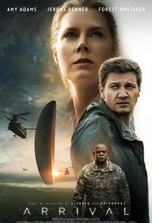
Starring: Amy Adams
November 2016
The below comments (in Black) were originally tweeted in Real-time from the back row of a movie theater and appear @BackRoweReviews. Though efforts were made to tease rather than ruin this movie’s memorable lines and moments, some spoilers may exist in the following evaluation (in Red). For concerns over objectionable content, please first refer to one of the many parental movie guide websites. All ratings are based on a four star system. Happy reading!

“We are so bound by time...by its order.” Like it or not. #Time
A sad departure at the film’s outset.
“I would need to be there.” Congratulations, you just volunteered.
The #Sanskrit word for war? It’s all #Greek to me.
“Dazzle them with the basics.” Standard methodology.
“Maybe we should try talking to them before throwing a math problem at them.” Ha!
This gigantic obsidian spheroid puts #2001’s #Monolith to shame. #2001ASpaceOdyssey
This gravity switch is a #MindTrip.
The #Kangaroo story is amusing.
“What is your purpose on Earth?” Love the way she teases out this sentence. Good #Logic.
“Now that’s a proper introduction.” I’ll say. #TentacleTouch #GreatLine
This smoke ring language is fascinating. #SmokeRing
“A logogram is free of time.” #Heptopod language.
“Are you dreaming in their language?” Conversation starter. #Logogram
“Use weapon.” Uh-oh! #Logogram #Heptopod
“Many become one.” The nations must unite.
“Louise sees future.” #PlotTwist
Hannah is a #Palindrome. So is radar. #Linguistics
“It was meeting you.” Ian scored major points with that line.
Final analysis: a thought-provoking “first contact with aliens” yarn that reveals the best and worst in humanity.
Rating: 3 out of 4. A visual marvel with solid acting. The atmospherics trump character development. Trite ending.
If a movie is only satisfactory for three-fourths of its running time, is it still a quality entertainment? Sure, but it’s also an egregious waste of potential. That last phrase perfectly describes Arrival since the first three-fourths of the film are taut, thrilling and saturated in mood and mystery, while the last quarter is an unwieldy, uninspired mess. To its credit, the movie doesn’t waste its time on drawn-out alien vessel appearances or FX fanfare sequences, like many alien assault flicks in the mold of Independence Day (1996). It’s clear from the outset that Arrival is a different kind of space invader film since it eschews the traditional action-packed opener in favor of a more moody and intimate prelude, introducing the first glimpses of the alien ship not in big budget special effects shots, but in streaky news footage airing on a living room TV. The story is infused with palpable tension as the military and scientists (never a good combination) scramble to determine if the recently arrived mother ships, which are presently stationed above a dozen random positions around our planet, are friendly or malevolent. Vital to the Save the Earth campaign is the inclusion of a communications cognoscente, but the world’s foremost authority on the subject has unceremoniously quit the project, presumably because his insurance doesn’t cover “Accidental Death by Space Aliens.” Rather than call or Skype the next qualified person on the list, Colonel GT Weber (Forest Whitaker, who is little more than set dressing in the movie) flies out for a face to face with the possible replacement and requests, rather than demands, that individual’s participation—apparently the fact that our planet can be blown to bits at any moment has no effect on the nerves-of-steel war dog. Fortunately for us, Dr. Louise Banks (Amy Adams) is available to join the global coalition of experts as her students haven’t attended her Linguistics class at the university ever since the aliens arrived (no dedication to higher education these days). Louise meets theoretical physicist Ian Donnelly (Jeremy Renner) and the sparks immediately start flying, triggered in part by their English versus Math verbal sparring match and in part by their obvious attraction to each other. Louise and Ian are tasked with establishing communications with the aliens, a tall order since neither of them remembered to pack a universal translator. The team’s initial visit to the alien ship (a colossal, obsidian spheroid hovering vertically in midair like a supersized version of 2001’s monolith) is a mind-bending, nape-prickling affair that effectively captures what it must feel like to make first contact with a bizarre alien species—this movie features gigantic heptapods with petal-like proboscises that emit puffs of black soot which congeal into circles a la Gandalf blowing smoke rings in The Lord of the Rings: The Fellowship of the Ring (2001). The novelty of these alien encounters wears off with successive visits (why so many?), but the intrigue heightens when our heroes learn the nature of the alien circles. So far, so good. Arrival, especially in the early goings, is reminiscent of The Day the Earth Stood Still (the original from 1951, not the schlocky remake with Keanu Reeves in 2008), which is widely regarded as one of the finest—and highly evolved—sci-fi pictures ever made. Though certainly in good company there, Arrival squanders its sure-footed setup with a standard, schmaltzy ending, particularly in how the earlier sparks between Louise and Ian are kindled into a full-fledged romance. This storyline feels rushed since the characters graduate from arguing co-workers to loving, dedicated parents in one convenient leap into the future. The jump in time is jarring and is further exacerbated by the fact that we learn very little about the star-crossed couple since the film’s otherworldly cinematography and alien atmospherics constantly overshadow what little character development can be found here (after all, the alien vessel is the star of the show). The flash-forward flubs also extend to the movie’s gimmicky resolution: side character General Shang (Tzi Ma) provides Louise with the solution to the alien riddle in a sequence so ridiculous it recalls the antics in Bill & Ted’s Bogus Journey (1991) where the titular twosome merely think of an action in the past that will thwart their adversary in the present. However, as awful as that story device is, the mishandled ending isn’t the only problem with the film. For instance, the aliens seem to comprehend concepts far more complex than “weapon,” so their nearly disastrous misunderstanding of the word seems more than a little contrived. Another narrative misstep is Ian’s out-of-the-blue voiceover narration midway through the film. Besides being overly expository, this narrated section is incongruous with the rest of the film and just feels odd since it shifts the POV away from the main character (Louise) and toward the secondary character (Ian). And then, to get really nitpicky, there are several story snafus, such as: how can a non-linear alien species know that humans will assist them 3,000 years into the future? Are they sure it isn’t 2,999 years from now? Or 3001? Further, why would these aliens even need our help since they’re so technologically advanced from us? Also, why do the creatures communicate with circles…seems a tad trite since we already associate (crop) circles with aliens, right? And how can Louise’s vision at the beginning of the film even occur since she doesn’t possess the capacity to look into the future at that point? Louise’s ability to gain knowledge from the future that will help us in the present which will preserve our future is a time paradox so convoluted it would give John Connor a migraine. These are niggling details, to be sure, but the sheer number of them reveals just how porous the plot is and prevents the movie from achieving maximum liftoff. Like a skilled magician, director Denis Villeneuve (Prisoners, 2013) has cleverly disguised his tenuous story with a style over substance sleight of hand along with an obfuscating display of temporal razzle-dazzle (in the Chicago sense of the word). In the end, Arrival’s arrival is well executed, but its departure needs some work. Good thing we have the next 3,000 years to get the sequel right.
Doctor Strange (PG-13)
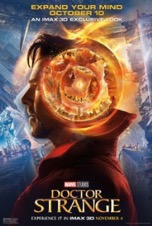
Starring: Benedict Cumberbatch
November 2016
The below comments (in Black) were originally tweeted in Real-time from the back row of a movie theater and appear @BackRoweReviews. Though efforts were made to tease rather than ruin this movie’s memorable lines and moments, some spoilers may exist in the following evaluation (in Red). For concerns over objectionable content, please first refer to one of the many parental movie guide websites. All ratings are based on a four star system. Happy reading!

The opening fight scene is like #Inception on speed.
“The man charted a top ten hit with a flugelhorn.” Good point. #ChuckMangione #FeelsSoGood
The #StrangeTechnique. Is that in #KamaSutra?
There goes his surgeon’s hands. Time for a #CareerChange.
“This isn’t medicine anymore, it’s mania.” Listen to her, #Strange.
#Strange’s scribbled signature is still more legible than most doctor’s.
Good news: #Strange got his watch back. Bad news: it’s broken.
“Just how experimental is your treatment?” Don’t ask.
“Have you seen that before in a gift shop?” Ha! #Multiverse
“Study and practice.” Something #Strange is all too familiar with.
#SlingRing #Strange can’t even muster a sparkler.
“How’s our new recruit?” Cold. #Everest
“They really should put a warning before the spell.” Hilarious! #WarningLabel
“Mr. Doctor.” Ha! #MrDoctor #MrDr
“Time is the true enemy of us all.” True that. #Kaecilius
The #Astral fight in the hospital is mind-blowing. A true original.
The mop falling is hilarious. #MopFall
#MasterStrange Has a nice ring to it.
“That is hilarious!” #StanLee sighting.
“It’s not about you.” #TheAncientOne says. Also the opening line of #ThePurposeDrivenLife by @RickWarren.
“I’ve come to bargain.” Ad nauseam.
Final analysis: a mind-bending adventure with just as much philosophy and metaphysics as action.
#Marvel should stop making movies, because they’ll never top this.
Rating: 3 1/2 out of 4. #Cumberbatch shines in an #Inception meets #HarryPotter tale of healing and heroism.
As one of the lesser known characters in the Marvel panoply, Doctor Strange is an altogether different kind of hero since his body is broken and he possesses no superhuman abilities. In lieu of innate powers (or acquired ones like from the bite of a radioactive spider), Strange must rely on his mind, specialized physical training and amassed knowledge of the mystical world that surrounds us and penetrates us (oops, wrong movie). Strange, the forty-third (some lists say fifty-sixth, but who’s counting) Marvel movie, isn’t directly connected to the Avengers—despite the surprise cameo during one of the two ending credits bonus scenes—or any other team or stand-alone hero in the Marvel pantheon. At first glance, the movie appears to be a mélange of narrative devices and stylized shots from the extant body of sci-fi and superhero films, especially the works of Christopher Nolan. The most obvious antecedent to this film, particularly in how its characters can bend cityscapes into Escher-esque labyrinths, is Inception (2010). However, instead of merely manipulating urban architecture, Dr. Stephen Strange (Benedict Cumberbatch) and his fellow spell-casters can terraform structures at will, making floors drop downward into a pit or heave upward into a giant mound while also causing rooftop tiles to undulate like the scales of a slithering serpent. The movie appropriates Nolan’s malleable metropolis concept and kicks it up several billion notches by staging protracted, pulse-pounding action sequences in, on or atop morphing, collapsing buildings. The results are, in a word, mind-blowing. These action set pieces seem readymade for a video game, which you can bet is already in development and will arrive in stores just in time for Christmas. Another tip of the hat (or cowl) to Nolan’s films is Strange’s martial arts instruction, which mirrors Bruce Wayne’s (Christian Bale) training in the first act of Batman Begins (2005): Liam Neeson’s immortal necromancer Ra’s al Ghul is replaced in this film by Tilda Swinton’s Ancient One. The Ancient One and her team of sorcerers control three Sanctums (New York, London and Hong Kong) which are linked by portals that open like the shimmering threshold (sans circular frame) of the titular device from the Stargate TV series and original 1994 movie. There’s also a heavy quotation of the Harry Potter films here in the way Strange learns how to conjure weapons and shields with the incantation of ancient spells. The list of comparisons between Strange and other blockbuster franchises is extensive, but suffice it to say, this film owes a tremendous debt of gratitude to its creative progenitors. That doesn’t mean that Strange is derivative though. Much more than a standard sci-fi/fantasy pastiche, Strange is an amalgamation, indeed a culmination, of the finest story and visual elements the genre has to offer, mounted with lavish detail and delivered as a bold, new vision of what a superhero film can achieve artistically. And while handing out plaudits, let’s not forget the movie’s sterling acting. Cumberbatch is unequivocally masterful at bringing Strange to life. Few actors could modulate from pompous surgeon to physically and mentally broken seeker to whole and fully-actualized hero with such deftness (the only person that even comes close is Harrison Ford, who negotiates a similar character trajectory in the 1991 drama Regarding Henry). Cumberbatch is one of the finest actors of our generation and was the optimal choice to play Strange…the fact that he looks the part only serves to enhance the role. The rest of the cast is equally effective, especially: Rachel McAdams as Strange’s long-suffering girlfriend, Swinton as his mysterious mentor, Chiwetel Ejiofor as his upperclassman trainer and Mads Mikkelsen as former Ancient One initiate turned evil (a la Anakin Skywalker from Star Wars and Lucifer from the Bible). Mikkelsen, who played the villain in Casino Royale (2006) and the eponymous cannibal in TVs Hannibal (2013-2015), is sufficiently menacing here as Kaecilius, a Sith-like henchman whose skin-crawling mystique comes complete with a thick European accent and ashen rings around his eyes. Aside from the movie’s visual splendor and fine performances, the element that elevates Strange far, far above the finest films Marvel has produced to date is its finely-crafted story. Strange is perfectly paced and contains an almost alchemic balance between character beats and action sequences. After a condensed origin story and training section, Strange encounters Kaecilius for the first time about halfway through the film. This first-rate action sequence is an edge-of-your-seat nail-biter since everyone in the audience knows full well that Strange is nowhere near ready to take on the wicked wizard all by himself. This lopsided sorcerer’s duel is basically like an alternate version of Star Wars: Episode IV - A New Hope, where Luke, not Obi-Wan, confronts Darth Vader on the Death Star. However, with his minimal training in the Force at that point, I doubt the farm boy would’ve fared as well versus the Dark Lord as Strange does here against Kaecilius. To counterbalance its many glum and globe-shattering passages, the film offers several humorous asides, like when Strange borrows books from the closely-guarded library. But these sporadic moments of levity are quickly relinquished for more pressing plot points or metaphysical musings. One such subplot foregrounds a variation of Taoism where an otherwise virtuous person requires a little dark energy in order to live long and prosper. This, and many other thought-provoking scenes, affirm Strange’s status as a master course in philosophy (as well as religion and ethics) since it makes us question everything about the world around us and, indeed, the very nature of our own existence and purpose. This is decidedly heady material for a superhero adventure, and I for one am completely sated from the four course meal (story) plus dessert (action sequences) I got for the price of admission. Strange is Marvel’s missing link: whereas all of the studio’s films boast immaculately choreographed, eye-popping action scenes (which serve as the majority of the plot in many cases) this movie actually features a story with some salience and heft. Strange tells its tale on a grand stage and envisages an even grander view of the universe and our place in it. One of the most dubious comic-to-movie adaptations ever produced is, ironically, the film that has set the bar so high that the studio may never be able to match or supersede it. So now the burning question is: will Strange ever be eclipsed by a future Marvel film? Although it seems highly unlikely at this point, stranger things have happened.
Star Trek Beyond (PG-13)
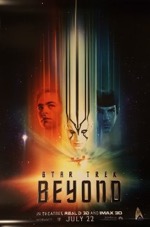
Starring: Chris Pine
July 2016
The below comments (in Black) were originally tweeted in Real-time from the back row of a movie theater and appear @BackRoweReviews. Though efforts were made to tease rather than ruin this movie’s memorable lines and moments, some spoilers may exist in the following evaluation (in Red). For concerns over objectionable content, please first refer to one of the many parental movie guide websites. All ratings are based on a four star system. Happy reading!

Kirk needs to leave the negotiating to Picard. He kinda’ sucks at it.
Nice twist with the perspective of the aliens.
Meaningful captain’s log. Great writing.
Chekov has the good stuff.
“Snow globe in space.” Ha! #YorktownStation
#YorktownStation looks like a mixture of #Elysium and #Tomorrowland.
“It’s easier than you think to get lost.” #LostInSpace
Thank God for impulse engines.
The Enterprise falls to the planet like a #FlyingSaucer a la #StarTrekGenerations.
“What’s your favorite color?” Hilarious!
U.S.S. Franklin. Plot twist.
Acidic boogers. Handy but nasty.
#VulcanTears There’s something you don’t see any day.
“He likes that seat.” LOL
“Find hope in the impossible.”
Radioactive jewelry. Top seller in the 23rd century.
“This is where the frontier pushes back.” #GoodLine
“Let’s hope this doesn’t get messy.” Ha!
“They’re called starships for a reason.” True enough.
Finally, seat belts on a starship.
Nice #StarTrekV crew shot.
“To absent friends.” Poignant line with Chekov in the shot. #RIPAnton
Final analysis: a bold adventure that’s addled by a slow start and a slack script.
Rating: 2 1/2 out of 4. The first deep space venture in the series has tons of action but not much meaning.
Aliso Viejo, CA. Star Trek Beyond starring #ChrisPine. Directed by #JustinLin. The Fast & Furious Frontier.
“I ripped my shirt again.” Happens all time.
“It’s hard to feel grounded when you’re in artificial gravity.” #GoodLine
“Perfect eyesight and a full head of hair.” Here, here.
Now that’s how the #UniversalTranslator should work.
“We are not equipped for this manner of engagement.” Oh frack!
Hang on, Scotty.
Kirk shatters the main viewer with a few phaser blasts. Is it really that easy to break?
“Fear of death is what keeps us alive.”
Giant green space hand. Reference #WhoMournsForAdonais? #StarTrek #TOS
“Take my house and make it fly.” #USSFranklin
“Beat and shouting.” The universe is saved by #HardRock.
The time lapse construction of the #Enterprise is brilliant.
Liked it a lot more the second time. Beyond beyond.
Lingering question: How did #MontgomeryScotty climb up the cliff? I guess engineers do have strong fingers.
Aside from rubber-suited aliens, space babes in tinfoil bikinis, psychedelic planet concepts and future-cool sets, props and costumes—all presented “in living color”—what established Star Trek as a pop culture phenomenon that’s endured for 50 years is the way creator Gene Roddenberry cleverly crafted his sci-fi adventure stories as morality plays; a strategy that not only covertly conveyed serious and controversial subject matter right past censors and studio execs to its intellectually curious audience, but also enabled the show to have a message during the mid to late 60s when lowbrow fare like Gomer Pyle, U.S.M.C. was ruling the airwaves. Whether in superlative episodes like “The Ultimate Computer” (the rise of the machine threatening our identity and humanity), mediocre fare like “Let That Be Your Last Battlefield” (a goofy, yet poignant, anti-racism cautionary tale) and even abysmal efforts like “The Mark of Gideon” (an absurdist homily on the dangers of overpopulation), the original Star Trek was legendary at weaving messages into its storylines. That tradition, to a greater or lesser extent, has been maintained by the many movies and TV spinoffs, all of which have deftly reflected the zeitgeist of their respective decade while consistently challenging the notion and status of the human condition. So what does all of that have to do with the new film, Star Trek Beyond? Plenty, as you’ll see. The current Trek movie series, set in the Abrams-verse (officially known as the Kelvin Timeline), has catered to contemporary audiences by presenting largely action-driven plots with some humorous moments and a handful of meaningful character scenes thrown in for good measure. It’s a recipe that’s been successful up until now, but the dish has become more and more unsavory with each successive sequel. That assertion will only embolden Trek purists, who have looked down their noses at the new films for eschewing the series’ cerebral tradition in favor of cheap thrills and eye candy (both with respect to its attractive cast and cutting-edge FX). Beyond may be the closest of the new films to meeting the lofty requirements of those purists and will hopefully retain a large swath of the audience that came to the series for the first time due to the involvement of director J.J. Abrams and/or the fine cast of up-and-coming actors. Beyond is the first of the new films to venture into deep space, which makes it feel more like a traditional Trek movie than its predecessors. This is also the first original adventure in the series, since Star Trek (2009) was an origin story and Star Trek Into Darkness (2013) was based on a “let’s bring back Khan” premise. There are many new characters (including: Idris Elba as foe Krall and Sofia Boutella as friend Jaylah) ships (USS Franklin, Krall’s ships and Yorktown space station) and filming techniques (the Enterprise cruising through warped space and the launch sequence at Yorktown where a camera is positioned in front of the ship’s neck as we see the station streaming past the accelerating ship) in the movie. Other welcome additions are seatbelts on bridge chairs and the most intelligent application of the Universal Translator (we hear the English translation over the alien’s native speech) in any Trek TV show or film. Though I haven’t been a fan of Michael Giacchino’s prior efforts for the series, his score here is very good—the cue when the Enterprise arrives at Yorktown (“Night on the Yorktown”) is equal parts majestic and euphoric. Yorktown’s sprawling landscape of sleek skyscrapers, transportation tubes, man-made lakes, grassy knolls, etc (all created with an effective blend of location filming in Dubai and CGI) is simply jaw-dropping. Indeed, its environs are an Escher-esque labyrinth of leaning buildings which tower over a well plotted and manicured surface of functional and recreational spaces; in essence, Yorktown is the architectural love child of the eponymous cities in Elysium (2013) and Tomorrowland (2015). Whereas the CG exteriors are gloriously gentrified, the interiors (both in Yorktown and on the Enterprise) are spare and dimly lit, especially in the early stages of the film. Yorktown is a true melting pot among the stars and is a grander scale version of what was attempted on Nimbus III, the so-called Planet of Galactic Peace in Star Trek V: The Final Frontier (1989), the very film that Ambassador Spock’s (Leonard Nimoy) crew photo is from (seen during the movie’s denouement). This cosmic UN is the locus for a good portion of the proceedings, including the climactic action scene. Despite a slow start, riddled by the amusing but mostly superfluous teaser (think diplomatic mission to the Gremlin home world) and the silly impetus surrounding the distressed ship (which is an obvious trap to everyone but gung-ho Kirk), the plot settles in when the Enterprise departs Yorktown. As the Enterprise approaches the mystery planet, we’re treated to the movie’s first action scene…a frenetic, bone-jarring spectacle which combines the pacing and pyrotechnics of a Star Wars movie with the kind of protracted battle on an epic scale you’d see in The Lord of the Rings. Krall’s throng of ships represents the franchise’s most lethal threat since the dreaded Borg. Enemy vessels are typically larger, faster or more powerful than the Enterprise. Beyond presents a radical paradigm shift with respect to its alien adversaries…the swarm of thousands of two-man crafts, when executing coordinated attacks, can rapidly inflict massive damage to a starship. Even more frightening is the way the tiny pods can burrow into a ship’s hull and deposit its crew, generating an instant invasion force. Insidious. This “death by a thousand cuts” attack strategy presents a challenge unlike anything the Enterprise has ever faced. The realization that the Enterprise can’t defend itself against such an onslaught makes for a nail-biting, nerve-shredding confrontation; the first of many incredible action sequences in the film. But are there too many and are they too frenzied for a Trek film? Many Trek diehards would answer yes; that the Kelvin films have embraced the same kind of raucous, razzle-dazzle that’s become synonymous with the Star Wars movies. The real issue with the surfeit of action scenes in the new Trek movies may have less to do with personal taste or even in whether or not they dishonor Roddenberry’s original vision of a peaceful future than with the financial burden associated with bringing such sequences to life. Scott Mendelson shares some informed insights on the subject in his article for Forbes entitled, “A Cheaper ‘Star Trek’ Franchise Can Live Longer And Be More Prosperous.” Although I take issue with his argument that action scenes are everyone’s (blanket statement) least favorite aspect of a Trek movie, he’s spot-on when highlighting where the franchise’s priorities should be placed. “When people rave about a Star Trek movie, they are usually talking about the winning cast, the emotional payoffs, and/or the would-be social topicality. In short, nobody ever went to a Star Trek movie primarily for the action scenes.” Be that as it may, the Swarm Attack is a heart-stopping, jaw-dropping thrill ride. The battle finally concludes with the crew being deposited on an alien planet. The painstaking world-building on Altamid (word play on ultimate?) is truly exceptional—finally a strange new world (the red forest at the beginning of Into Darkness doesn’t qualify since it was only briefly shown in the teaser and had little bearing on the rest of the film). The location work, shot in the British Columbia, Canada, adds greatly to the immersive experience of being on some far-flung alien world filled with potential dangers lurking around every jagged boulder. Jaylah’s replicating device is a brilliant invention, as are her various security measures—one of which is a type of gas that can rapidly turn into a solid. Another clever visual is when Krall’s ships dock in staggered positions on tall poles, which makes them appear as branches on bizarre mechanical trees. As Krall’s legions deploy on their attack mission, they pass through a nebula that’s the perfect amalgamation of the Mutara Nebula from Star Trek II: The Wrath of Khan (1982) and the Briar Patch in Star Trek: Insurrection (1998). The invasion plot itself harkens back to the Borg’s assault on Earth in Star Trek: First Contact (1996) and Shinzon’s plan to attack the same target in Star Trek: Nemesis (2002). Nothing new here. The climactic showdown between Kirk (Chris Pine) and Krall is visually exciting but, sadly, is a standard issue resolution for an action picture. The revelation of Krall’s true identity is one of the movie’s nicer twists (although the lack of an explanation for his initial mutation and subsequent reversion is beyond contrived) and has the added advantage of foregrounding the only real message in the movie. It’s unclear if writers Pegg and Doug Jung, along with director Justin Lin, even planned for the movie to have such real-world relevance, but Krall’s backstory has a symbolic link to the war on terror. The potential of one of our own becoming radicalized and turning against us is a clear and present danger. With ISIS operatives entering (Trojan Horse style) the refugee populations flooding into Europe and America, this plot point has a direct bearing on current events in our terror-ravaged world. It’s unfair to say that the rest of the movie is devoid of meaning, because that simply isn’t the case. Indeed, there are many great character moments, like the spirited interchanges between Scotty (Pegg) and Jaylah and the always enjoyable good-natured ribbing between Spock (Zachary Quinto) and McCoy (Karl Urban)—this movie features the best banter between the pair since Star Trek IV: The Voyage Home (1986). The opening captain’s log is rife with keen observations on the rhythms of life in space and accurately depicts the ennui that sets in during a long voyage (and also contains some of the finest dialog in the film). Kirk’s confession to McCoy that he joined Starfleet on a dare is heartfelt as is the conversation between Kirk and Commodore Paris (Shohreh Aghdashloo): Paris asserts that in deep space all a captain has is his ship and his crew. Since he loses both early in the film, Kirk must rely on his ingenuity, a new friend and an old ship in order to save the universe for another day. The private meeting between Spock and two of his kinsmen is also an emotional high point in the film and satisfactorily buttons up the Ambassador Spock storyline. However, aside from these finely written and well acted character scenes, where’s the overarching theme, the salient social commentary or the pulse on our progress as a species? The film does have some substance, but it’s tenuous—existing between, and in service to, the many action sequences. So here we have a head-scratching conundrum: Beyond thoroughly entertains and yet says nothing, means nothing and, in the end, amounts to nothing. Ultimately, the most meaningful moments in the movie are the two dedications during the end credits…to Nimoy and Anton Yelchin, two Trek heroes who passed away before this movie was released. Yelchin’s death has cast a pall over the possibility of a fourth film in the franchise, but should another movie receive a green light from Paramount, here’s hoping it will focus on story first and action second, since, as Mendelson rightly avers, “no one will complain if an otherwise good movie doesn’t have an extra phaser shoot-out or vehicle chase amid the drama.” Whereas Mendelson believes that “going cheaper and smaller” is the answer to ensuring series longevity, I maintain that such constancy will only be achieved by tapping into topics that resonate with the audience; narratives that challenge, inspire and instill hope for a better future. In other words, the kind of story that made Star Trek great from its inception.
Independence Day: Resurgence (PG-13)
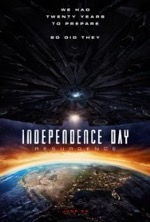
Starring: Liam Hemsworth
June 2016
The below comments (in Black) were originally tweeted in Real-time from the back row of a movie theater and appear @BackRoweReviews. Though efforts were made to tease rather than ruin this movie’s memorable lines and moments, some spoilers may exist in the following evaluation (in Red). For concerns over objectionable content, please first refer to one of the many parental movie guide websites. All ratings are based on a four star system. Happy reading!

The War of 1996. Won by a #Mac.
“You don’t get credit for cleaning up your own mess.” Touchy, isn’t he?
#JeffGoldblum uses the word “tenacious.” Reference #JurassicPark.
“Welcome to the moon.” The scenery is kinda, eh.
The slippery floor line is amusing.
“Did we win?” #Data wakes up from a coma.
“Did the giant flag give it away?” Ha! #China
“We need to know who we just shot down.” Might’ve learned that first. #ShootFirst
“That is definitely bigger than the last one.” #ThatsWhatSheSaid
A controlled dive is still a fall.
#NewYorkCity is raptured.
“We have alien guns?” LOL
Alien within an alien. Gross.
“Why didn’t you tell me my butt was hanging out?” Hilarious!
#MakeThemPay
Amazing FX on the air strike.
“Their enemy is our ally.” Duh! And you blasted them to smithereens.
How fortunate that the environment inside the mother ship has oxygen for our heroes to breathe.
The alien queen in the bus’ side view mirror is reminiscent of the T-Rex in #JurassicPark.
That’s it, fire your lasers up the alien queen’s bunghole. #VulnerableSpot
Final analysis: a predictable sequel with some amusing one-liners and superb visual FX.
Rating: 2 out of 4. Nice to see the original cast, especially @BrentSpiner who steals the show.
The first Independence Day (1996) was a frenetic and fun-filled alien invasion romp that won over audiences with its effective blend of action and humor along with a story that didn’t take itself too seriously (remember the scene where Julius Levinson (Judd Hirsch) tells President Whitmore (Bill Pullman) where all the extra money goes for each $30,000 toilet seat purchased by the government?). In the new ID, subtitled Resurgence, the charm has worn off and we’re left with a story so predictable and derivative it gives sequels everywhere in the universe a bad name. The story begins with a “shoot first, ask questions later” sequence where reactionary earthbound commander-in-chief (Sela Ward) orders twitchy fingered moon base commander (Chin Han) to destroy an imposing ball-shaped alien craft. David Levinson (Jeff Goldblum) and the audience are the only ones smart enough to notice the radical variation in design between the space ball and the original alien mother ship; this discrepancy sets up a “surprise” twist later in the story. Soon after the mini Death Star is destroyed, a continent sized alien ship arrives and crash lands on Earth (which would create an extinction level event, but no matter). Taking a cue from Aliens (1986), this sequel also features an alien queen. The queen proves to be far craftier than her single-minded predecessors: she plans to drill into Earth’s outer core and extract the fluid there since her planet has already depleted its store of precious core matter (raiding Earth for its resources is just one of many alien invasion movie tropes). Since the aliens in the first film were simply out to conquer our world, this shift in strategy is more than a little curious (lest we forget, that movie’s tagline was: “They only want one thing…DESTRUCTION!). The whole notion that killing the queen will send the rest of her minions scattering like mice on the lower decks of the Titanic is also a new wrinkle that, though logical when applying hive dynamics, sets up a built-in resolution that’s obvious, anti-climactic and a colossal cop out by the writers. And speaking of narrative shortcuts, what about the oxygen atmosphere inside the mother ship...why can we breathe their air and the aliens can breathe ours? Oh, and follow this logic: we can’t destroy the mother ship, but we can destroy the ball-like vessel which is the greatest threat to the mother ship. Huh? Other than its plot oddities, this movie’s greatest drawback is its similarities to the original film. The aerial attack on the mother ship, the alien assault on Area 51, a solo pilot engaging in a suicide mission and refugees befriending each other out in the middle of a desert are all conventions established in the first film. The only new element here that has any real-world relevance is how humans use alien technology against the aliens in a twist on the events of 9-11. Besides the handful of returning characters, some new faces grace the sequel, including: pilot Jake Morrison (Liam Hemsworth), General Adams (William Fichtner) and too-young-to-drive Sam (Joey King). None of the movie’s characters are three-dimensional and most barely qualify as one-dimensional. Director Roland Emmerich’s patented “action over plot” methodology is in full force here as rapid succession conflicts curtail any meaningful moments or genuine character interactions. In fact, there isn’t a living, breathing character anywhere in the movie…the closest is Brent Spiner’s Dr. Brakish Okun who at least provides some color and humor to the proceedings. The one name conspicuously absent from the cast this time around is Will Smith (who wisely passed on this film in favor of the upcoming Suicide Squad). The indomitable swagger Smith exhibited in the first film is sorely missing in the sequel, which is replete with tepid performances. Likewise, for an end-of-the-world film, Resurgence is strangely dispassionate. Perhaps the fact that our heroes defeated the aliens once before has given them a quiet confidence that they can do it again. Be that as it may, the faced-with-extinction urgency that permeated the first film is nowhere to be found in this perfunctory plot which simply assumes that our heroes will kick the alien’s posterior regions by the two hour mark and that we’ll all live happily ever after…except for those inhabiting regions that were flattened by the mother ship, of course. This highlights another fallacy of disaster movies: who cleans up the mess, rebuilds civilization and recovers lost monuments once the dust has settled from an alien incursion? Maybe when the writers sift through the ruins of this movie they’ll find just enough original material to turn the franchise into a trilogy. If not, they should just leave the series to wallow in the heap of ashes that is this movie’s plot.
X-Men: Apocalypse (PG-13)
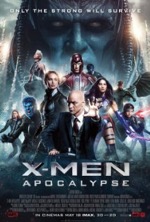
Starring: James McAvoy
May 2016
The below comments (in Black) were originally tweeted in Real-time from the back row of a movie theater and appear @BackRoweReviews. Though efforts were made to tease rather than ruin this movie’s memorable lines and moments, some spoilers may exist in the following evaluation (in Red). For concerns over objectionable content, please first refer to one of the many parental movie guide websites. All ratings are based on a four star system. Happy reading!

“A gift is often a curse.” Like #Hulk’s superpower.
Is this #XMen or #Stargate? #AncientEgypt
Scott’s got problems with his eyes. Yeah, remember that comment about a gift being a curse? #Cyclops
Does #Magneto’s daughter have any of his powers?
#Cyclops splits #ProfessorX’s favorite tree in half. Instant enrollment.
#Magneto’s daughter recreates Hitchcock’s #TheBirds.
Thug becomes one with the wall. Amazing FX. #Apocalypse
World’s first mutant. #Apocalypse
Love the #TOS #StarTrek scene on TV. #WhoMournsForAdonais?
Mystique the Mercenary. #Mystique
Scott gets some special glasses. #RayBan
“I’m blue.” Ha! #Nightcrawler
“My name is Magneto.” Yeah! #Magneto
“The third one’s always the worst.” Very true. #Ewoks
A rare non-comedic #StanLee cameo.
Why doesn’t Scott just fry the chopper and bad guys with his laser vision? #Cyclops
“I know what everybody feels.” What a burden. #JeanGrey
After losing his family, #Magneto breaks bad.
“Weapon X is loose.” #Wolverine
#JeanGrey #MindMelds with #Wolverine. She soothes the savage beast.
Embrace your powers.
“You’re in my house now.” Amazing mental duel. #Apocalypse #ProfessorX
“Unleash your power!” #JeanGrey
#DangerRoom Yay!
Final analysis: an entertaining yarn despite its slow pacing. Some memorable moments and cameos.
Rating: 3 out of 4. The best of the new cast #XMen movies. A more cerebral superhero film. Thank the Maker!
In case anyone hasn’t noticed, we’ve had three superhero showdowns within the last three months. First was the titular title fight in Batman v Superman: Dawn of Justice (in late March) followed by Captain America and allies vs. Iron Man and his cohorts in Captain America: Civil War (in early May) and now we have the epic confrontation between Professor X (James McAvoy) and his mutant students vs. Apocalypse (Oscar Isaac) and his cadre of brainwashed fiends in X-Men: Apocalypse (in late May). The fact that all three of these heroes-fighting-heroes movies were released during an election year is telling of a country divided along ideological lines and facing its most critical challenges in its 200+ year history. This movie is a sequel to 2014’s X-Men: Days of Future Past and is the third featuring the young cast (McAvoy’s team rather than Patrick Stewart’s). The film is directed by Bryan Singer; this is his fourth time at the helm of an X-Men picture. The script by Simon Kinberg clearly caters to fans over non-initiates as the narrative is laden with references to the comic books. The story itself is quite dense, juggling multiple characters and storylines for nearly two and a half hours—twenty minutes too long for my taste. Despite being a cerebral film with much to say about the current state of humanity, the story is riddled with problems. First of all, the film is embarrassingly derivative. Besides evoking both Stargate (1994) and The Fifth Element (1997) in its “Aliens Visit Ancient Egypt” opener, it also pilfers story elements from earlier X-Men films, a la the climactic confrontation between Professor X’s initiates and Apocalypse’s minions, which is similar to the clash of mutants at the end of X-Men: The Last Stand (2006). Also, villains using Cerebro for their own nefarious purposes is nothing new either: reference X2 (2003). Magneto disrupting Earth’s magnetic poles to create mass destruction is just a larger scale cataclysm of the stadium drop in the previous film. Indeed, Apocalypse’s plan to remake the world to his design is similar to Lex Luthor’s (Kevin Spacey) dastardly plot to wipe out the Eastern seaboard by dropping a kryptonite-infused island into the Atlantic Ocean in Superman Returns (2006), an earlier Singer effort. Not all is lost here, as several topical storylines make this a worthwhile entertainment—apart from its mind-blowing action sequences. Since his design is to destroy the planet as we know it, Apocalypse is a type of terrorist leader. The scene where he rounds up the world’s nuclear arsenal and tosses it into space generates ambivalent feelings since we’d be safer without them so long as someone like Apocalypse doesn’t show up on our world. The destruction caused by the Apocalypse influenced Magneto also taps into 9-11 anxieties and the prevalent feeling (reflected in the rise of dystopian literature and media in our society) that an earth-shattering event is in our not too distant future. Ultimately, the two highest yield plot elements are Jean Grey (Sophie Turner) overcoming her fears and unleashing her mental fury—a girl power sequence that rivals Rey (Daisy Ridley) arming herself with the lightsaber and confronting Kylo Ren (Adam Driver) in Star Wars: The Force Awakens (2015)—and Magneto (Michael Fassbender) breaking bad after his family is accidentally killed. The scene where Apocalypse takes Magneto to confront his past at Auschwitz is another deeply affecting scene with some tremendous acting by Fassbender, who delivers the movie’s standout performance. This brings up an interesting question about the franchise’s decorated ensemble…how long will McAvoy, Fassbender and Jennifer Lawrence stick around since their superstar status has afforded them more attractive and challenging roles than anything Marvel could hope to offer? And for that matter, how many more X-Men films will the forty-seven year old Hugh Jackman (who briefly appears here as Weapon X) make? Even though this is the finest of the new X-Men films, it still doesn’t approach the quality of the first two films in the series. Still, compared to the typical comic book film, the X-Men films are like Shakespeare by comparison. Oh, and on a side note, the next film will be the tenth in the franchise. And you know what the Roman numeral for ten is.
Captain America: Civil War (PG-13)
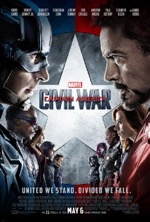
Starring: Chris Evans
May 2016
The below comments (in Black) were originally tweeted in Real-time from the back row of a movie theater and appear @BackRoweReviews. Though efforts were made to tease rather than ruin this movie’s memorable lines and moments, some spoilers may exist in the following evaluation (in Red). For concerns over objectionable content, please first refer to one of the many parental movie guide websites. All ratings are based on a four star system. Happy reading!

What’s in the blue packets?
Nice shield ricochet #CaptainAmerica.
Thank you, #RedWing.
#ScarletWitch needs to work on her aim.
“There’s a correlation between generosity and guilt.”
“Victory at the expense of the innocent is no victory at all.” So true.
“I’ll use the door.” Ha! #Vision
The #SokoviaAccords. Ah...now I know what they were talking about on #AgentsofSHIELD.
“Conflict breeds catastrophe.”
“The safest hands are still our own.” You’re in good hands with Avengers. #Avengers
Awesome midair motorcycle swap.
“Warmer than jail.” LOL
“Sometimes I want to punch you in your perfect teeth.” The seeds of civil war.
“I’m not the only Winter Soldier,” says Bucky. The others are Lucky, Ducky, Plucky and Klucky.
#Spiderling Ha! #SpiderMan
Let’s see, homework or a trip to #Germany? #SpiderMan
#CaptainAmerica kisses #AgentCarter’s niece. He’s a multigenerational lover.
“It’s your conscience. We don’t talk a lot these days.” Hilarious!
Nice #TheEmpireStrikesBack reference #Spidey.
I’m missing #Hulk in this movie. It needed some #GreenRage.
“I’ll put you on hold...I like to watch the line blink.” Good one, #Stark.
#IronMan takes a shield to the heart. That round goes to #CaptainAmerica.
#TonyStank Ha! #StanLee sighting. #IronMan
Final analysis: an overlong and overstuffed actioner that actually has a lot of social relevance.
Rating: 3 out of 4. #CaptainAmerica gets upstaged in his own movie, which is really #Avengers3.
Captain America (Chris Evans) and his team of superheroes face off against Iron Man (Robert Downey Jr.) and his super friends on an airport tarmac and maximum destruction ensues. The end. Well, there’s a little bit more to it than that, but you get the main gist of the story from that nutshell synopsis of Captain America: Civil War, the newest chapter in the Marvel movie panoply. Aside from the jaw-dropping action sequences, the movie has value in some of its character interactions, particularly Vision (Paul Bettany) and Scarlet Witch’s (Elizabeth Olsen) domestic scenes, and its topical subplot involving superheroes signing an agreement to refrain from using their powers a la The Incredibles (2004). Also lending the film some emotional heft is its too-real-for-comfort terror attack in Lagos, which is an echo of the Sokovia and New York City debacles in the Avengers films (and, of course, 9-11 in real life). An earlier assignment conducted by the Winter Soldier (Sebastian Stan), which is told in a series of flashbacks, also provides some decent, intermittent intrigue and factors into the climax in a major way. The list of returning heroes is extensive (consult IMDB) but it’s really the new faces that add the most to the film, namely: William Hurt as Secretary of State Thaddeus Ross, Chadwick Boseman as T’Challa/Black Panther, Emily VanCamp as Sharon Carter (Peggy Carter’s niece), Tom Holland as Peter Parker/Spider-Man and Marisa Tomei as Aunt May Parker. The Spider-Man subplot works extremely well and provides hope that the impending re-reboot of the franchise will be successful (and how shrewd of Marvel to give us a preview of that movie here…they’re the undisputed masters of cross-pollinating properties). With the exception of a few amusing one-liners and the eye-popping FX, there really isn’t anything else to evaluate here…other than the fact that the movie needed Hulk and Thor, both of whom are conspicuously absent from the proceedings. If you’re a fan of these films you’ll probably enjoy this one too. Even though Captain America gets overshadowed in his own movie, Civil War has successfully moved the Marvel franchise forward to Avengers 3 and beyond. There are two bonus clips during the closing credits, so don’t leave early.
Star Wars: The Force Awakens (PG-13)
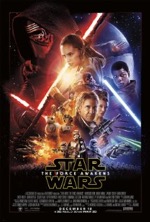
Starring: Daisy Ridley
December 2015
This review was originally tweeted in Real-time from the back row of a movie theater and appears @BackRoweReviews. Though efforts were made to tease rather than ruin this movie’s memorable lines and moments, some spoilers may exist in the following evaluation. The original tweets appear in black, while follow-up comments appear in red. For concerns over objectionable content, please first refer to one of the many parental movie guide websites. All ratings are based on a four star system. Happy reading!

Fortunately it’s the former.
There is no “balance in the Force” without the #Jedi. Great to see #MaxVonSydow.
Without the Jedi, the scales have tipped to the Dark Side. Looks like the galaxy needs a new hope. Von Sydow’s inclusion in the cast continues Star Wars’ long tradition of tapping classic Hollywood actors to play key parts: Sir Alec Guinness and Peter Cushing in the original trilogy, Christopher Lee in the prequels.
The trooper with three blood marks has trouble following orders. I can feel the conflict in him.
These markings remind me of the various symbols and designs on clone trooper helmets in The Clone Wars TV series and the muddy handprint on the faces of Saruman’s orcs in Peter Jackson’s The Lord of the Rings trilogy.
Bread in seconds. #Rey can really hydrate a loaf.
Reference the instant pizzas in Back to the Future Part II (1989).
“The droid’s not for sale.” I’ve heard that before somewhere.
A reverse of Obi Wan’s statement in A New Hope (1977).
The #TIE crash lands on #Jakku. Don’t worry, the scrap will be used to help feed someone.
There’s a later scene where scavengers run straight toward a TIE fighter right before it crashes into the sand. When your livelihood is based on bartering machine parts, you get it while it’s hot, I suppose.
“I am with the Resistance.” Ha!
A funny scene that reveals Finn’s ability to improvise in order to survive.
“The garbage will do.” Hey, she’s still a fast hunk of junk.
Another knowing nod to Hope and Luke’s line, “What a piece of junk!”
“Anything else?” #KyloRen needs some anger management.
At least he doesn’t kill his officers like Vader.
#BB8’s thumbs up is uproariously funny.
The droid reveals its true purpose as a mobile cigarette lighter.
“Yes I do. Every time.” Han has always been a #SmoothTalker.
Han might make a mess in a cantina or step on a gangster’s tail, but he can always talk himself out of trouble.
“Move ball.” #HanSolo has never been a fan of droids. #BB8
Remember “Shut him up or shut him down” from The Empire Strikes Back (1980)?
“It’s all true.” #HanSolo is now a believer in the #Force.
He’s come a long way from his “simple tricks and nonsense” days.
“Women always find out the truth.” The wisest thing #HanSolo ever said.
And judging by his frosty relationship with Leah, it looks like he learned this truism the hard way.
#Rey heeds the #SabersCall.
This is her “cave” scene (a la Luke in Empire).
It’s hard to conceive of a weapon on a more epic scale than the #PlanetKiller. Jaw dropping.
#HanSolo using #Chewbacca’s crossbow is a hoot.
Nitpick alert: You mean to tell me that in all of their adventures together, Han never tried out Chewie’s crossbow?
“Princesses.” Ha!
When a prissy droid thinks you’re high maintenance, you’ve got some issues.
#KyloRen initiates a #MindMeld on #Rey. #SciFiMashUp
Clearly Ren needs some tips from Spock on how to extract information from someone’s brain.
“And I’ll drop my weapon.” #JediMindTrick
A funny scene and a trivia question all wrapped into one…the actor inside the trooper suit is none other than James Bond himself, Daniel Craig.
“Sanitation?” LOL!
The string of one-liners in this movie is also reminiscent of the humor in Hope.
“Escape now, hug later.” Always good advice.
Consider this: if Rey and Finn hadn’t hugged, Han might’ve had a few more seconds to take the lightsaber out of Ren’s hand. That hug killed Han!
A passing of the baton, er, lightsaber between initiate and master.
Although if I were Luke I’d tell Rey to “point that thing someplace else.”

The opening shot of the dark side of a #StarDestroyer is brilliantly visualized.
This shot sets the tone for the entire movie…it’s compositionally similar to many of the opening scenes in the earlier films, but is shot in a unique style with a completely different mood. It’s a symbolic change that’s emblematic of the movie’s many variations on the theme.
The frozen blaster beam is tight.
A really striking visual that also illustrates Ren’s formidable powers.
The “lived in” universe, i.e. crashed #StarDestroyers, #ATATs, etc, is startlingly realized.
These scenes have a strong sense of place and really capture the look and feel of Hope. There’s a lot of atmosphere and magic here.
“No droid could be that important.” Actually, this one is. #BB8
R2 was pretty important in his day too.
“The droid stole a freighter?” That’s one talented droid. #BB8
Well, I guess if an Ewok can ride a speeder bike…
“They’ll be pieces of us in three different systems.” Ha!
A classic Han line.
“Whatever you do, don’t stare.” Hard not to in that eclectic gin joint.
Isn’t that like trying to ignore the elephant in the room?
“I’m a Stormtrooper.” Where’s your armor? #MajorReveal
Finn takes Han’s advice and fesses up to Rey.
“I like this thing.” Who wouldn’t? #ChewiesCrossbow
It’s got quite a kick.
“That’s one animal pilot!” #PoeDameron
This line is precipitated by an incredible, writhing long take that showcases Dameron’s fancy flying.
New jacket. Same old Han. #HanSolo
It’s nice to know that some things never change.
#Rey escapes #Stormtroopers scurry.
In the Roman Empire, if a prisoner escaped under your watch your life would be forfeit.
“Is there a garbage chute? Trash compactor?” Han would know.
“What a wonderful smell you’ve discovered.”
“Come get it.” Yeah!
Although I wouldn’t be so cavalier in Finn’s place. Riling Ren isn’t a good idea…unless you’re a Jedi.
#R2D2 meet #BB8.
A mechanical meet cute where old meets new. A nice moment.
#Rey finds #LukeSkywalker. #MagicalMoment. #ChillBumps.
The scene reminds me of old martial arts movie where an initiate would have to scale a tall mountain in order to begin the training process with a Kung Fu master. A similar scene in Krull (1983) comes to mind. Also, Luke’s destiny seems to be the last hope for the Jedi order…he’s had that distinction twice now.
Final analysis: a bold new look for the franchise with a plot that mirrors #ANewHope.
And a large helping of Empire too.
Rating: 3 out of 4. Better than the prequels but still lacks the magic of the original trilogy.
A long time ago in a galaxy far, far away…there were three good to amazing movies (Episodes 4-6) and three fair to awful films (Episodes 1-3) from creator, director, writer George Lucas. Now, after a fallow decade for the franchise, after Lucas passed the baton to Star Trek director J.J. Abrams and after Lucasfilm was sold to Disney, Episode VII, known as Star Wars: The Force Awakens, has finally been released amid much anticipation and under a cloud of secrecy that could shroud Bespin. To bottom line it for you, Awakens is worthy of all the hype. While Abrams’ riff on Lucas’ space epic lacks the wide-eyed wonder and sheer exhilaration of the original trilogy, it’s a Kessel Run ahead of the prequel trilogy. In addition to moving the series forward chronologically (thirty-two years to be precise), Abrams has also made the series more palatable for contemporary audiences, just like he did for the most recent Star Trek movies. Updating the technology, like various space ships and droids (i.e., the sleek ball-like robot BB-8), was a no-brainer. However, an even more important step in modernizing the franchise was Abrams’ sage decision to showcase more diversity in the cast, something that was largely missing from the earlier six Star Wars films (and that Lucas was widely criticized for). The two new heroes are a woman (Rey) and a black man (Finn). (Side comment: I’m really surprised there hasn’t been a racial uproar over the obvious similarity between the latter’s race and name to Huckleberry Finn). London actress Daisy Ridley, in her big screen debut, plays salvage scavenger Rey. Rey is a distant of echo of Luke Skywalker (Mark Hamill) since her desert home world, Jakku, is a dead ringer for Luke’s Tatooine…with the notable exception being that her planet is littered with derelict Star Destroyers and AT-AT walkers, not Krayt dragon skeletons. Lucas’ conception of a “lived in” universe is vividly realized in Abrams’ first foray into the Star Wars saga. The scenes involving Rey inside and outside the junked Star Destroyer are truly jaw-dropping (especially in 3D). All of the desert scenes (shot in Abu Dhabi), particularly the scene where Rey slides down the sandy slope, are rich in atmosphere and tap into the gritty, organic feel that made A New Hope (1977) so otherworldly and magical. One of the desert scenes depicts the crash landing of a TIE fighter with two of our heroes aboard: Finn (John Boyega), former stormtrooper turned Resistance fighter, and Poe Dameron (Oscar Isaac), ace pilot for the Resistance. Isaac (Ex Machina) has a scene with big screen legend Max Von Sydow, who makes a short, yet powerful, cameo at the beginning of the film. Just as in Hope, the villain is introduced within the first five minutes of the film. Even though Darth Vader has been replaced by Kylo Ren (Adam Driver) in this film, there is a rather important connection between the two antagonists which is the basis for one of the movie’s many mysteries. Of course, the two biggest enigmas in the movie are Luke’s location and Ren’s true identity—both characters are on opposite ends of the Force spectrum and, as destiny and Hollywood writing would demand, have had dealings with each other in the past. Despite various side stories and numerous action sequences, the whereabouts of the former Jedi master is the movie’s central through line. Normally a movie’s MacGuffin is an object or thing, but in this case it’s a person…Luke. And just as Luke is scarce in the movie, he’s nowhere to be seen on the movie poster, which has generated a great deal of controversy and speculation. Wild theories abound including one that has Luke inhabiting the dark outfit of the movie’s main villain, Ren. As for Ren, Abrams made the wise choice to not make him too much like Vader. Admittedly, the black outfit and wheezy mask are similar, but the comparisons between the two villains diverge from there. Vader takes out his aggressions on his subordinates while Ren manages his anger by shredding computer terminals with his three bladed lightsaber. Vader’s voice is deep and heavy on the reverb, while Ren’s vocalizations are thin and tinny, like a poor radio transmission. The most significant difference is that Vader is a Sith and Ren isn’t—so avers Abrams. As such, I don’t think there’s any doubt that Vader, the Master, could kick Ren’s Learner heinie. One of Ren’s character snafus is that, barring severe allergies, he doesn’t really need a mask. Sure, it gives his character added mystique and explains some of his back story, but it’s an utterly superfluous plot element. The scene where Ren removes his mask isn’t even half as momentous as when Vader does the same in the original trilogy. Three mo-cap characters that are worthy of mention are: Maz Kanata (Lupita Nyong’o), Unkar Plutt (Simon Pegg) and Supreme Leader Snoke (Andy Serkis). Abrams has created photo-real CG creatures without making them too cutesy like Lucas’ alien creations in the prequels…thank the Maker. Of course, I’d be remiss if I didn’t mention the most important characters in the film—the entire cast of the first trilogy: Han Solo (Harrison Ford), Skywalker (Hamill), General Leia Organa (Carrie Fisher), Chewbacca (Peter Mayhew), C-3PO (Anthony Daniels) and R2-D2 (Kenny Baker). It was uber-clever of Abrams to bridge the generations by integrating the original cast into this film. Ford, in particular, seemed to be having a ball this time around and turns in some of his finest acting in years. Han’s opening line, “Chewie, we’re home” is cheer-worthy and makes for a memorable appearance for the smuggler and his rangy sidekick. In fact, each of the characters, including the droids, is given a dramatic entrance in the film (however, the reason why C-3PO has a red left arm is never explained). It would’ve been standard, lazy Hollywood storytelling to just have the original characters show up, deliver a few lines and serve as nostalgia fodder for adult audience members. Fortunately, Abrams, along with fellow scriptwriters Lawrence Kasdan and Michael Arndt, wove these classic characters into the tapestry of the film in intelligent and delightful ways and gave each of them a significant role to play in the story. Despite their heavy action and occasional frightening images, the Star Wars films have always been family friendly (and, fittingly, have focused on a family of characters), and Awakens certainly continues that tradition, as would be expected with Disney serving as owner and distributor of the film. However, that doesn’t mean this movie is tame…nothing could be further from the truth as the film has plenty of pulse-pounding action. The film also boasts a degree of creative vision that’s nearly unparalleled in cinema history. Even story elements that are completely unfounded scientifically, like the splintering death ray emanating from the Planet Killer, are mind-blowing in their scope, power and execution. Abrams’ greatest contribution to the film was his Force-like ability to locate and populate the unexplored spaces within the extant Star Wars panoply. It’s almost as if Abrams and his writers listed dozens of things never attempted in the franchise and then selected a handful of them to build a plot around. The opening minutes are proof positive of this supposition since we’ve never seen the dark side (symbolic, right?) of a Star Destroyer before, nor a major ground assault at night. Most significantly, there isn’t a single space battle in the entire movie…all of the ship confrontations are staged as aerial assaults on a planet’s surface. The movie also marks the first time that enemy forces have conducted a tactical retreat…something that never would’ve happened on Vader’s watch. It’s possible to analyze this movie until the Banthas come home, but suffice it to say, this film has remained faithful to Lucas’ vision while venturing out into some bold new territory with some incredible new characters. Sure there are plot holes, inconsistencies and nitpicks here, as there are in any movie, but Awakens is a very serious attempt at doing justice to Lucas’ brainchild. Most of the early criticism of the film has centered on the story, which is ostensibly a patchwork reworking of the themes, scenes and lines from the original trilogy, particularly Hope and Empire. But the way I see it, if you’re going to borrow, why not borrow from the best? Whether you appreciate this kind of rehashed, retro-cool plot or not, I’m sure you’ll agree that this film has far, far surpassed the mediocre efforts of Episodes I-III—and how ironic that the characters in the movie are coming out of a Dark Ages (with no Jedi to ward off scum and villainy) just as we in the audience are coming out of one of our own (the prequels). Abrams’ film has resurrected the long dormant, long lackluster franchise with visual panache, an engaging story and some truly unforgettable moments. It has also effectively introduced the series to a whole new generation of fans. Once again, the Force is strong in the Star Wars universe.
The Hunger Games: Mockingjay - Part 2 (PG-13)
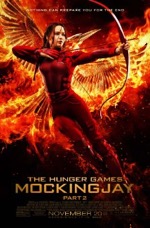
Starring: Jennifer Lawrence
November 2015
This review was originally tweeted in Real-time from the back row of a movie theater and appears @BackRoweReviews. Though efforts were made to tease rather than ruin this movie’s memorable lines and moments, some spoilers may exist in the following evaluation. The original tweets appear in black, while follow-up comments appear in red. For concerns over objectionable content, please first refer to one of the many parental movie guide websites. All ratings are based on a four star system. Happy reading!

“The bakery didn’t survive.” It was alive once? #LivingBakery
Sorry, couldn’t resist. Precision of language, folks.
Gale complains about #Katniss’ distracted kiss. I personally wouldn’t mind what she was thinking about.
The rebels crack the #Nut, much to #Katniss’ disapproval.
The beginning of the schism between Katniss and Gale.
“Turn your weapons to Snow.” #MeltingGun
A little play on words there. Reminds me of Duck Dodgers’ Disintegration Pistol which would…disintegrate. #LooneyTunes.
#PeetasPearl The ember remains.
Is this, in a symbolic sense, Peeta’s pearl of great price? #Bible
“She’s mythic.” #Katniss
Shouldn’t that be mythical?
“History doesn’t stop to celebrate.” Does it stop to mourn?
We do every year on September 11th and December 7th.
#StarSquad Say cheese!
There’s a whole section of the book where Katniss has to do extensive training in order to join the team. Sadly, none of those scenes appear in the movie.
Beware of #Pods. #InvasionOfTheBodySnatchers
In that 50s sci-fi movie they were called pod plants, but close enough.
#Peeta the #CapitolMutt.
Snow does have him trained pretty well.
Peeta is a baker. So was the #ApostlePaul. #PeetaAndPaul
Before you brand me as a heretic, know that this is a witticism, courtesy of Bob Phillips. Paul was actually a tentmaker, but the joke maintains that he was a baker because he went to Philippi (Fill A Pie). #PewHumor.
#InkFlood Yick!
It’s later established that this is oil, which leads to the next tweet. I’m sure the oil was all CGI, but in the olden days the oil would be composed of printer’s ink and Metamucil or some other thickener. Reference Star Trek: The Next Generations’ “Skin of Evil.”
Apparently the Capitol has plenty of oil to waste.
I guess it’s Holo-Oil, created by the Gamemakers, but still.
“A face plucked from the masses.” #Katniss
Interesting word choice since Snow frequently plucks roses from his garden.
Coin cuts in on Snow. How wud!
No, they don’t dance together in the movie. That would be creepy.
Rest in a sewer? Don’t know that I could.
Unless I had nose plugs.
There’s a sound in the sewer tunnel. Must be #Gollum creeping about.
More appropriately, “sneaking.”
These #SewerZombies are fast.
Kind of like the speedy zombies in I Am Legend (2007) or World War Z (2013).
#Tigress is on loan to #Panem from the #ThunderCats.
Correction: Tigress is from Kung Fu Panda, Tygra is from the Thundercats.
“They chose you.” Then they chose death.
The price of freedom.
Snow’s “our way of life” speech is frighteningly relevant to current events.
But in reverse with ISIS being cast in the role of the rebels. Although with all of the corruption in the U.S. government…
#ParachuteBombs Once a symbol of hope, now an instrument of death.
Color me cynical, but I wouldn’t be anywhere near one of those parachutes when it landed.
How many times does #Katniss end up in a hospital in this movie? #CharredMockingjay
I think I counted three visits to the hospital. This story device, which is presumably designed to produce pathos in the viewer, gets worn out from overuse.
“These things happen in war.” Especially when Snow’s finger is on the button.
A symbolic Hunger Games? Have we learned nothing?
Coin signs her own death warrant at this point.
Snow’s execution...you can hear a Coin drop.
“GET OUT!!!” Poor cat’s gonna have #PTSD.
Although, I’ve never seen a cat just sit there when objects are hurled at it.
“No one ever wins the games.” Not even the #Victors.
Especially not the winners, because they have to live with the guilt from all the people they’ve had to kill in order to survive.
“Much worse games to play.” #Katniss has different arrows in her quiver now.
This world stands in stark contrast to the bombed out dystopia featured throughout the series. These scenes seem to suggest that there’s hope for humanity. #HappyEnding.
Final analysis: an adequate, if not spectacular, series capper.
The first two were really good, the last two were mediocre. Should’ve been a trilogy.
It’s a shame that The Hunger Games ended up as an average movie series since it had such potential to be great.
Rating: 2 1/2 out of 4. The perfunctory plot and lack of action make this an unsatisfactory conclusion.
The trend where the final book of a series is turned into two movies needs to take one of Katniss’ arrows straight through the heart. Instigated by the Twilight and Harry Potter (and later by The Hobbit, which is three movies for one book) franchises, the end result in each case has been a weak and watered down conclusion. Obviously the rationale for milking more movies out of a book series is financially motivated, but any art extracted from the source material is suffering at the hand of avarice in these four movie trilogies. Mockingjay 1 was a middling effort that merely set the table for this series finale. Maybe it’s due to that weak lead-in, but this final Hunger Games film is a drab, lackluster affair, with a dearth of action sequences, insipid character scenes and a ho-hum resolution. It’s a shame that Jennifer Lawrence’s considerable talents were wasted on this uninspired rendering of Suzanne Collins’ novel. Other A-listers were also underserved here: Woody Harrelson, Elizabeth Banks and Stanley Tucci have maybe a half dozen scenes between them. Also, Donald Sutherland (President Snow) and Julianne Moore (President Coin), as post-apocalyptic power brokers on opposing sides of a coup, do their utmost to animate their cardboard characters, but unfortunately even fine acting can’t elevate the movie’s mediocre writing. It’s truly sad that this underachieving effort will go down as Philip Seymour Hoffman’s final film credit. With all the quality work he did before his untimely passing in early 2014, it’s a shame that this film will be his last impression on future audiences. Additionally, how ironic is it that Hoffman’s acting career, which was largely devoted to independent and arthouse pictures, should culminate with a commercial blockbuster and that today’s youth will probably only remember him as Plutarch Heavensbee in The Hunger Games films? As for the story, everything feels rushed, expedient and contrived in Peter Craig and Danny Strong’s screenplay. When the Nut is blasted by the rebels, we see the explosions over Katniss’ shoulder off in the distance while she’s in the middle of an important conversation. Here was an opportunity to create a really amazing action scene but it’s thrown away as a non-event, and worse still, upstaged by chatting characters. It’s bitterly ironic that even though there are plenty of character moments in the film, there’s very little characterization…an important distinction. We lost some good character interactions during the training sequences, which failed to appear in the movie, presumably because they would’ve taken up too much screen time. The simmering love triangle between Katniss, Peeta and Gale (which is an obvious echo of the Bella, Edward and Jacob triad from the Twilight series) comes to a full boil in this movie, but oddly, Katniss’ conflicted choice is made academic by the poor decision of one of her suitors. Her selection is made in an instant, which cheapens the moment and is a severe letdown after the buildup over the last three movies. Like the previous films, the final chapter of The Hunger Games flirts with a message, but doesn’t really deliver on the promise of a well considered, dystopian cautionary tale. The perfunctory plot (which hews too closely to Collins’ novel) takes us on an expected journey to a predictable final confrontation and a standard, even passé, resolution. The movie’s Jane Austen style ending will likely leave some spectators bewildered and others angered. This bucolic dénouement was a gutsy choice and even though I’m not averse to it personally, I can see where others might take issue with it or outright mock it. So, is this film worthwhile? Depends on how you like your entertainment. For me, the movie left me hungry for a more substantial and meaningful final act to an otherwise entertaining series.
The Martian (PG-13)
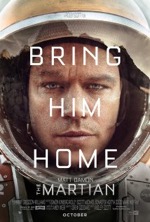
Starring: Matt Damon
October 2015
This review was originally tweeted in Real-time from the back row of a movie theater and appears @BackRoweReviews. Though efforts were made to tease rather than ruin this movie’s memorable lines and moments, some spoilers may exist in the following evaluation. The original tweets appear in black, while follow-up comments appear in red. For concerns over objectionable content, please first refer to one of the many parental movie guide websites. All ratings are based on a four star system. Happy reading!

Not quite. Though not nearly as epic in scale or scope as Interstellar, The Martian is an enjoyable sci-fi yarn in its own right.
Communication is the hallmark of teamwork. Until you close the comm channel.
Can you imagine how much people on a long range space expedition would get on each others’ nerves?
Wicked windstorm. Beware of loose satellite dishes.
And crews that leave their own behind.
“Mark Watney is dead.” The end.
Good thing he isn’t dead or this would be a really short movie.
The press conference puts #JeffDaniels’ news anchor skills from #HBO’s #TheNewsroom to good use.
If you close your eyes, you can almost picture him at a news anchor’s desk. Daniels excels in this kind of role.
Warning: the #SelfSurgery scene is rough to watch.
Scott featured a self-abortion procedure in his Alien prequel Prometheus. Seems to be a pattern with the director.
“I’m not going to die here.” That’s the spirit.
Watney’s positivity, along with his ingenuity, is really what saves his life.
“Luckily...I’m a botanist.” Ha!
A very funny scene since we really don’t know what Watney’s position in the crew is up to this point.
Nice #Noseplugs, Watney.
The first sign of green on #Mars.
This scene reminds me of the beginning of WALL-E when the robot gives the green sprig to EVE as a present.
50 million miles from Earth. #MajorHomesickness
I couldn’t imagine the suffocating isolation of being on an interstellar voyage like this.
Organic, homegrown potatoes on #Mars. They make far tastier #FrenchFries than #MacDonalds.
At least you’d know they were real potatoes, not frozen slices of processed starch like at Mickey Ds.
“The whole world is rooting for you.” What a singular honor.
Better not accidentally kill yourself. No pressure or anything.
“I colonized Mars.” Hilarious.
Watney’s cogitations are always so well formulated. The mark of a great scientist.
Mark’s life is saved by the “handyman’s secret weapon.” #DuctTape #TheRedGreenShow
This Canadian comedy show will leave you in stitches. Back to Mars: it’s amazing how duct tape can seal a breach in a cracked helmet, effectively shutting out the Martian atmosphere. And great preparedness on Watney’s part to have tape on his person at all times. He must’ve been a Boy Scout.
#ProjectElrond. Clever inside reference with #SeanBean in the room. #Boromir #LOTR
Bean played Boromir, who was at the Council of Elrond in The Lord of the Rings: The Fellowship of the Ring (2001).
“Mark Watney, Space Pirate.” Love his line of reasoning. #SpacePirate
Though done tongue-in-cheek, the logical assemblage of facts with humorous applications makes this a delightful scene. It’s a nice character moment that further cements our affinity for the character.
“Everywhere I go I’m first.” What a euphoric feeling that would be.
It’s a sensation familiar only to true pioneers.
That tarp over the nose of the rocket is giving me major anxiety.
I’d want a lot more than a sheet of plastic between me and space.
“You have terrible taste in music.” Much needed #ComicRelief.
Disco is to music what film noir is to movies. Both had a clearly defined beginning and end. As such, they are styles or movements, not genres.
Final analysis: an inspiring story of ingenuity and tenacity that’s at least as heart stopping as #Apollo13.
And is arguably more intense (as a whole) than last year’s Interstellar.
Rating: 3 1/2 out of 4. Damon turns in a stellar performance and Scott’s direction is truly out of this world.
Based on the novel of the same name by Andy Weir, The Martian is the latest foray into deep space by director Ridley Scott (Alien, 1979 and Prometheus, 2012). Although the star of the show is Matt Damon, he’s supported by a dazzling array of fine actors, including: Jessica Chastain, Kristen Wiig, Jeff Daniels, Michael Pena, Sean Bean, Kate Mara, Chiwetel Ejiofor and Mackenzie Davis. Damon plays Mark Watney, member of a manned mission to Mars. During a violent sand storm, gale force winds tear loose a satellite dish that slams into Watney and sends him spiraling away into the blustery Martian night. The team leader (Chastain) makes the difficult decision to leave Watney and the sand blasted surface of Mars behind for the regulated environs of the orbiting space vessel. Once the team is safely aboard, the ship begins its long journey back to Earth. At a press conference, Watney is pronounced dead by a NASA executive (Daniels). The end. Not quite. As you’ve guessed, Watney is still alive. Thus begins the rest of the movie, which centers on Watney’s arduous struggle to stay alive on the Red Planet and the problematic rescue mission mounted by NASA. The story element that makes this movie so incredibly enjoyable is its educational component: watching Watney use real science (most of which went right over my head) to sustain his life, especially during the sequence where he creates a makeshift greenhouse inside the landing pod, is engrossing and exhilarating. If these scenes have a downside, however, it’s that I suffered an anxiety attack when I mentally put myself in Watney’s place and realized I wouldn’t last one day on Mars with my limited knowledge of science. Granted, Watney is a trained astronaut, but there’s no way I would know how to make all of the gizmos he improvises with duct tape and feces (not together fortunately, ew). This master course in science is definitely one of the more engaging aspects of the film, but there’s plenty more to recommend it. Like in 2010 (1984) and Space Cowboys (2000), an international effort is required in order to accomplish the mission, a plot point that should appeal to foreign audiences as well as promote global goodwill…which our world can certainly use right now. There can be no doubt that Damon’s Watney is the hero of the hour: he’s resourceful, humble and witty. While Watney is a far cry from Damon’s devious Dr. Mann in Interstellar (2014), he’s a distant echo of Damon’s titular character in Saving Private Ryan (1998): rescue teams are sent to retrieve his characters in both of those films as well as this one. Playing a lost sheep is becoming a career MO for Damon. As a bona fide sci-fi epic, Martian puts other Mars-themed movies (Mission to Mars and Red Planet, both released in 2000) to shame. Ridley Scott’s well honed craft is evident both in the film’s outer space and planetary scenes. His framing of the visually striking desert vistas on the surface of Mars (filmed on Earth, of course) are effectively counterpointed by the moody and claustrophobic environments inside the various vessels—mother ship, module and rover. Scott mastered this juxtapositional contrast between the expansiveness of space and the constricting confines of space vessels in his Alien movies. The mounting crises in this film brings to mind the similar mechanical failures and scientific quandaries that made Apollo 13 (1995) such a pulse-pounding, nail-biting masterpiece. This film matches that level of intensity but also offers a good amount of comic relief, especially during Watney’s mission logs. Whereas Prometheus and Interstellar offer a harder brand of sci-fi, Martian is more scientifically accurate and has more commercial appeal. In the end, this survival film is thrilling, inspiring and crowd-pleasing and has carved out its own little corner of the sci-fi universe.
Fantastic Four (PG-13)
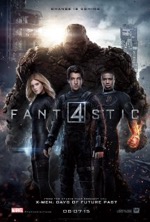
Starring: Miles Teller
August 2015
This review was originally tweeted in Real-time from the back row of a movie theater and appears @BackRoweReviews. Though efforts were made to tease rather than ruin this movie’s memorable lines and moments, some spoilers may exist in the following evaluation. The original tweets appear in black, while follow-up comments appear in red. For concerns over objectionable content, please first refer to one of the many parental movie guide websites. All ratings are based on a four star system. Happy reading!

Flame out. Perhaps forever.
“I’ve already built it.” Sure kid.
We saw this exact same scenario—kid with an invention that actually works rejected by a narrow-minded adult—earlier this summer in Tomorrowland (and also in last year’s Big Hero 6 and 2006’s Meet the Robinsons). Hackneyed movie opener.
Reed needs a power converter. I think Luke picked up a spare at #ToscheStation.
You might have to put up with his whiney voice, but he’s a fair trader.
“You’re paying for the backboard.” No appreciation for science.
Is this Hoosiers (1986) or a superhero movie?
“There’s patterns in everything.” Like #KateMara’s shirt, for instance.
Why can’t Sue see the pattern of destruction that’s in the offing?
“Fix what my generation broke.” Tall order.
And extremely unfair. It’s like saying, “We blew it and now it’s up to you to save the world. No pressure.”
“Us us?” Great dialog.
“Yes, yes.” Because a team of scientists would make prime candidates for exploring a new world, right?
Cool #Lego mug.
Does it come apart? Might create a minor inconvenience if it contained hot coffee.
Where are the space suits for the chimps? #AnimalCruelty
I guess because the chimps didn’t actually step out onto the alien planet they didn’t necessarily need space suits. However, as a precaution against any kind of hull breach that would allow a foreign, virulent agent into the capsule, the simians technically should’ve been inside some sort of environment suit…with a sippy straw leading to a bladder full of puréed bananas. Also, if the chimps had gotten out they might have established a true Planet of the Apes.
Reed Richards can create a teleportation device, but doesn’t know how to do a #FistBump? #Lame
Just proof positive of how little thought was put into this script by writers Jeremy Slater, Simon Kinberg and Josh Trank.
“I don’t think we went anywhere.” Kinda like the plot.
Indeed, the entire movie is like a roller coaster that never leaves the platform…all hype and no thrills.
Victor falls into the green lava pit. He’s doomed.
Will we ever get away from these tacky villain names taken directly from the comic books? Today’s audience is savvy enough to know who the antagonist is without naming him Von Doom.
#PlanetZero Where all plots go to die.
Planet Zero…where zeros are turned into heroes. Planet Zero…where you get zero entertainment value for your two hour and twelve buck investment. This is too easy.
Sue’s adoptive dad calls her Susan, which she dislikes. #Nitpick
Earlier, we learn that Sue dislikes being called “Susan” by Victor. So why would her adoptive father call her a name she doesn’t want to be called?
Johnny accidentally throws a fireball at Sue. #FriendlyFire
And the military is thinking about using him as an asset?
The naming of the group scene is utterly insane.
Correction: Although the scene is quite insane, I meant to type “inane.”
Final analysis: a poorly produced and paced reboot that squanders its talent on mediocre fare.
By talent, of course, I mean the central four cast members, each of whom is primed to become a major Hollywood star.
Rating: 1 1/2 out of 4. The only thing fantastic about this film is the wealth of commentary it’s generated.
I see no reason to waste my time (or yours) on a full review for this film. Actually the word “film” is too fine an appellation for this superfluous series of bland, expositional scenes which are performed on drab sets and locations and adorned with substandard production elements. It’s no overstatement that a sixth grader could’ve written a better story than what we find in this pedestrian plot, which lays out something like this: they went, they came back, they went again to fix everything they messed up the first time and then they came back home. See Dick run. The first half of the picture focuses on the “they went” part, which drags on and on with uninteresting character beats and infuriatingly prosaic dialog. The four heroes finally get their superpowers about midway through the movie, at which point we’ve become so terminally bored that we really could care less what happens to them. The action sequences are poorly conceived and executed and are accompanied by lackluster visual effects, save for the impressive scene where the trees and cars are sucked up into the singularity a la Mega Maid’s cosmic vacuum in Spaceballs (1987). As for the “major” fight scene at the end of the flick…kids staging an imaginary battle in their backyard could’ve choreographed a more creative and energetic melee than the one featured here. This is especially true of the scene where Dr. Doom quickly and easily neutralizes the powers of each member of the Fantastic Four. They aren’t so fantastic after all it would seem…much like the movie itself. Bottom line: This ill-advised release makes the original, mediocre Fantastic Four movies look like The Avengers films by comparison. This un-Fantastic flick may have singlehandedly killed the series despite the presence of some truly talented young performers in the title roles. Unless some future reboot miraculously reanimates the comatose series, this franchise is doomed.
Terminator Genisys (PG-13)
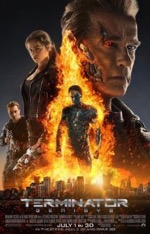
Starring: Arnold Schwarzenegger
July 2015
This review was originally tweeted in Real-time from the back row of a movie theater and appears @BackRoweReviews. Though efforts were made to tease rather than ruin this movie’s memorable lines and moments, some spoilers may exist in the following evaluation. The original tweets appear in black, while follow-up comments appear in red. For concerns over objectionable content, please first refer to one of the many parental movie guide websites. All ratings are based on a four star system. Happy reading!

His first time back to the franchise since his stint as the Governator.
“It used our own bombs against us.” Shades of 9-11.
A thinly veiled reference to that fateful day in 2001. It’s a plot device that’s grown tired from overuse, especially since it seems to be an easy way to illicit an emotional response from the audience. A highly exploitative plot contrivance.
“Use my hands for something other than killing.” #TMI
It’s hard to see Arnold whittling animal figures out of wood as a pastime.
“We take back our world.” Yeah!
And simultaneously avoid Judgment Day, which will pretty much wipe out the events from the earlier films.
The first tactical time weapon. Fascinating.
“The futuristic not set.” A central axiom of these movies.
Correction: Should read “The future is not set.” Curse you Twitter! It thinks it’s being helpful by suggesting similar words, but it just messes me up. In a darkened room with a darkened phone screen and tiny buttons, it’s easy to select the wrong word.
Genisys is Skynet. Thanks for spelling it out for us.
I really wish the writers would’ve let us figure this out on our own instead of outright announcing it several times during the movie.
“Come with me if you want to live.” Don’t have to ask me twice.
This is one of the better lines in the movie, but it seems like I’ve heard it before somewhere.
“So you’re the one I’ve been waiting for all my life.” Nice double entendre.
A funny line that reveals the movie’s underpinning predestination plot.
“I’m old, not obsolete,” says Pops. Actually, Pops was pretty obsolete when fighting his younger self.
Good thing he brought backup. Wise old android.
The doppelgänger scene with two Kyle Reese’s is daft. Reference #StarTrek for many examples of this.
What if Sarah had guessed wrong? Kyle would have to hobble around for the rest of the movie…which is actually a pretty cool character limitation.
“Why hold onto someone when you know you’ll have to let them go?” #MeaninglessGesture
Absolutely true…from an automaton’s perspective. A prime example of how human emotions can transcend the cold, hard logic of a machine.
A #TotallyConnected life. Frightening!
This type of technological convergence is on the horizon. Its implications are exciting and frightening all at the same time.
Scarface meets his much younger mother. #Paradox
How can a school bus be armed and extremely dangerous?
Poor dialog alert.
Why do maximum destruction action sequences always seem to take place on the #GoldenGateBridge?
Reference: Fantastic Four (2005), X-Men: The Last Stand (2006), Rise of the Planet of the Apes (2011), etc.
Pops gets an upgrade. He’s not so obsolete after all.
Kyle Reese meets a boy version of himself. Shouldn’t the universe implode? #BackToTheFuture
Dr. Brown would have a few choice things to say on the subject.
Final analysis: a patchwork plot from the earlier films that suffers from a lack of originality.
Rating: 2 1/2 out of 4. Some clever ideas prevent this from being a dog. Arnold’s presence is a plus.
During my formative years, my mom periodically had a Musgo night; that is, a dinner where everything in the refrigerator “Must Go” before it goes bad. Like most kids, I hated leftovers, especially when ingredients that had no business being thrown together ended up in the same dish. What does all of that have to do with the new Terminator movie? Genisys, the fifth film in the franchise, takes a Musgo approach to its story line by including characters, concepts, plot threads and action segments from each of the previous four films. The resultant thematic mélange, though clever at times, is often formulaic, oblique or flat-out uninspired. If it feels like you’ve seen this movie before, you have…several times over. In fact, amplifying the movie’s pervasive sensation of déjà vu are excised clips from The Terminator (1984) and the inclusion of the liquid metal adversary from Terminator 2: Judgment Day (1991). Since the liquid metal man does very little to advance the plot and has an early exit from the story, one wonders why it was necessary to bring him back in the first place? Perhaps director Alan Taylor just wanted to see how modern CGI could bring the morphing machine to life, but the harsh reality here is that the new FX aren’t that much better than the ones in T2, which have held up remarkably well over the decades. As such, the liquid metal villain’s presence in the film is superfluous, gratuitous and ridiculously shoehorned. Still, you have to tip your hat to the writers, who’ve served up a reheated version of the earlier movies and passed it off as a new film. It’s a writing ploy that’s just as insidious as Skynet’s systematic strategy for taking over the world. As long as people keep filling theater seats, the franchise can endure indefinitely since there are infinite insertion points available to time traveling characters. This film operates on two levels: diehard fans will appreciate the pastiche plot, which features many elements from the earlier films in unique combinations, while newcomers will just enjoy the film as the popcorn entertainment it is without getting too overwhelmed by the improbable genealogies, mind-bending paradoxes and convoluted timelines that have become staples in the Terminator series. As such, Genisys is a unique sequel that can be experienced either as an introduction to the series or as a standalone chapter in the ongoing Terminator saga. This new trend, where Hollywood studios are producing sequels with origin story elements, is an extremely clever way of introducing a whole new generation of potential fans to a franchise. Insidious indeed. Another area of the movie that bears scrutiny is the acting, which is fairly lackluster across the board. Other than Ah-nold and the barely-there support from veterans like J.K. Simmons and Courtney B. Vance, the cast is filled with fresh faces (Emilia Clarke and Jason Clarke) with insufficient star power, with the exception of Jai Courtney (Divergent). The dearth of big name actors, along with the reheated plot and average visual effects, signifies a halfhearted commitment to the project by Paramount Pictures. Sure, Genisys is a big budget summer tentpole, but nothing about its production screams “prestige.” The whole proceedings has a “let’s just throw another sequel out there and hope it makes a profit” feeling to it. Hopefully the next, inevitable, sequel will eschew this film’s Greatest Hits narrative style and actually craft an original screenplay. The fate of humanity just might depend on it.
Jurassic World (PG-13)
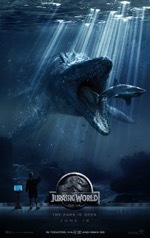
Starring: Chris Pratt
June 2015
This review was originally tweeted in Real-time from the back row of a movie theater and appears @BackRoweReviews. Though efforts were made to tease rather than ruin this movie’s memorable lines and moments, some spoilers may exist in the following evaluation. The original tweets appear in black, while follow-up comments appear in red. For concerns over objectionable content, please first refer to one of the many parental movie guide websites. All ratings are based on a four star system. Happy reading!

That’s really why we watch these movies, right?
Nice #Psyche moment with the bird foot.
Nice setup for the attack of the birds later in the movie.
“If something chases you...run.” That goes without saying in these #JurassicPark films.
Although, if it’s T-Rex, your best bet is to stand still since its visual acuity is based on movement.
“More teeth.” #IndominusRex #PlayingGod
So here we have the beginnings of the ethical debate over scientific responsibility vs. consumer demands for newer, better attractions at the park. The argument is broached ad nauseam throughout the movie. You might say that such fixation on the topic is like beating a dead stegosaurs.
#Mr.DNA sighting.
Remember him from the first film? A nice inside gag.
The restricted area is like half the island. #BadOmen
“What have they got in there, King Kong?”
“Accept that you are not in control.” The essence of #Chaos.
It’s also one of the steps in A.A.
“Bigger than expected.” #KingKong size? #IndominusRex
#RaptorTraining #Frightening
The very idea that raptors can be trained is hokey as heck, but it makes for an interesting section of the film…especially when the gatekeeper falls in.
“War’s part of nature.” But is it ethical to bring nature to a war?
This whole subplot with Vincent D’Onofrio is utterly inane. Using raptors as foot soldiers? What could possibly go wrong with that plan? If the raptors are hungry for human flesh, I doubt they’ll discriminate between different sides of a conflict.
The Raptor #FieldTest comes sooner than expected.
This is one of the better action sequences in the movie. Unlike the campy Godzilla vs. Rodan style final conflict, this scene actually made me slide forward in my seat a couple inches.
“Were those claw marks always there?” #DinoRuse
Guess dinosaurs enjoy a good pedicure too.
Don’t move #DonutMan.
Oops, guess the hybrid part of Indominus is a better hunter than a plain old T-Rex. My bad.
Pet a #Raptor at your own risk.
A raptor petting zoo? That’ll be the day.
#Code19. Means #RunAndScream.
If you reverse the 19 and add another 1 at the end you’ll have a number that pretty much sums up their situation.
“Evacuate the island.” Please don’t. I wanna see what happens.
Besides, the movie would be pretty short otherwise.
Bigger. Scarier. Cooler. #SuperSizedDinos
Maybe it’s just me, but weren’t those diminutive Compys from The Lost World (1997) pretty scary when they worked in concert? “Size matters not.”
#OffRoad “The full Jurassic World experience.”
Of course, the kids don’t stop to consider the size of the dinosaur required to tear a hole that large in the fence. Impetuous youth.
#DinoKickball
Bet the kids wish they’d have stayed “on road.”
To be on the safe side, jump on two.
Kicking myself for not using the hashtag #JumpOnTwo. A narrow escape and one designed with 3D in mind.
“It’s killing for sport.” And so far the #IndominusRex is pitching a shutout.
#TheBirds, Jurassic style.
The hashtag is, of course, a reference to the terrifying Hitchcock film. This sequence is like a turkey shoot but in reverse. How convenient that all of the humans are corralled into one area so that the strafing Pterodactyls can pick them off one by one.
Nice shot, #BeardDude.
“Do not shoot my Raptors!” That’s a first.
My, how far we’ve come from “Shoot her!’
“That thing’s part Raptor.” Gee, I couldn’t have guessed that.
This is an utterly ridiculous reveal since we all knew what dinosaurs were commingled inside Indominus’ DNA back when the fierce behemoth scratched up the wall…and hid in the security blind spot.
How to tase a Raptor.
Very carefully. Avoid its teeth and claws at all costs. Oh, and watch out for the tail too.
2 Raptors and 1 Rex. Where have I seen this scenario before?
This is Exhibit A for how contrived the movie is. The storyboarding here is eerily similar to the climactic T-Rex gang up in the first Jurassic Park movie.
Guess what #IndominusRex. There’s always a bigger fish.
Thank you, Gui-Gon Jinn.
“Stick together for survival.” Memorable #SecondDate.
A decent pickup line only to be used in survival situations.
Final analysis: echoes many scenes/concepts from the earlier films, but super sizes everything.
In many respects, this film is a regurgitation of various elements from the earlier trilogy—there’s very little new thought here.
The film’s moral of humans always needing a bigger, better thrill is as subtle as a jackhammer in a library.
And the fact that the point was driven home repeatedly in the movie reveals just how stilted this topic is—prehistoric preachiness.
Rating: 2 1/2 out of 4 stars. If a maximum destruction #CreatureFeature is on the menu, this one’s for you.
Ever wonder what Jurassic Park (1993) would’ve been like if Nedry’s (Wayne Knight) debacle hadn’t happened and the dinosaur park had actually passed the inspection? This fourth JP installment answers that hypothetical question by picking up the action several years after the park’s opening. Miraculously, the calamitous effects of “chaos” have been averted up to this point, but that’s about to change—those disreputable InGen geneticists have concocted a brand new “hybrid” dinosaur, which was designed less out of scientific curiosity than the need to boost flagging attendance at the park. Besides subplots involving raptor training (and the daffy plan to use them as infantry in a war), the unethical choices made by scientists and shareholders who place a premium on profits over people, an insipid romance between Pratt and Howard, the latter’s inadequacy at connecting with/taking care of her teenage nephews and those same teens being imperiled at every turn, the story is dominated by its new dino on the block…the Indominus Rex. As the central crux of the movie, Indominus serves as antagonist, new park attraction, catalyst for catastrophe, emblem of its creators’ avarice and hubris, McGuffin and embodiment of everything that’s wrong with the film. The name pretty much says it all—Indominus is the incarnation of a bigger, better breed of dinosaur (the first genetically engineered dino in history), created for the sole purpose of entertaining onscreen and in theater spectators. This bifurcated function is both fascinating and bitterly ironic. In the same way that Jurassic World patrons have become bored with the same old dinosaur exhibits, so too have theater attendees grown weary of the by-now standard monster melees involving T-Rex’ and raptors. The Spinosaurus was the answer to this “supersize syndrome” in JP III (2001). Here it’s Indominus: an unnatural amalgamation of a T-Rex and some other unspecified dino, whose true identity is preserved as a “surprise” for the end of the movie. That supposed big reveal exposes a major fallacy on the part of the writers, who’ve grossly underestimated the intelligence of the audience; most people will have solved the tenuous mystery about the same time that Indominus goes all Wolverine on the habitat wall. As one of the story’s prominent through lines, the flaccid subplot involving Indominus’ shrouded origins is egregiously anemic. Equally contrived—and telegraphed from earlier events in the movie—is Indominus’ demise. It’s clear that director Colin Trevorrow intended for Indominus’ comeuppance to be an unexpected twist, but, just as with the disclosure of the creature’s actual genetic makeup, the audience is way ahead of the writers. World’s attempt at providing even more extreme dino attacks than those featured in the earlier films is undermined by action sequences that were lifted right out of the first JP, especially when the two raptors pounce on Indominus (T-Rex in the original film). Also, Howard coaxing the T-Rex with a flare, just like Jeff Goldblum did in JP, is a ridiculous retread. The Pterodactyl attack is visualized in a manner so similar to Hitchcock’s The Birds that the scene plays out like a parody of the classic thriller, only on a grander scale and with modern FX. Has the ingenuity that once flourished in this groundbreaking franchise gone extinct? Another drawback to this film is that none of the major characters from the original trilogy appear here. Since we aren’t invested in the lives of the characters, we really don’t care if they end up as dino snacks or not. Pratt cuts a heroic figure as the raptor whisperer, but we learn next to nothing about his back story. Howard is one step short of annoying as the self-important park executive who exhibits poor parenting skills and, inconceivably, even worse management skills. Ultimately, the missing ingredients here are fun, excitement and genuine suspense. The first JP possessed all of those elements in spades by building a world of wonder and terror that resulted in a one-of-a-kind cinematic thrill ride. World feels unnecessarily rushed, as if it were constructed merely to whisk us along from one dino dustup to the next. The bare bones plot is expeditious, perfunctory and agonizingly formulaic. What little story exists here (the heavy-handed sermon on the fickle fads of humans, the dangers of playing God, the reminder to never leave kids alone in a dino park, etc.) serves as filler between the links of an unending helix of action sequences. My sincerest hope is that the makers of the next JP film will invest more time and energy into character development and a compelling story. Additional suggestions: bring back the joy and awe from first film and throw a spotlight on some of the ancillary dinosaurs—the sick triceratops scene in the first JP was exhilarating and touching and added a good deal to the story without defaulting to yet another meaningless action sequence. If the sequel fails to demonstrate a higher degree of creativity than this dismal entry into the series, we’ll have to christen the next test-tube dino Ignominious Rex.
Tomorrowland (PG)
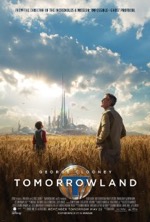
Starring: George Clooney
May 2015
This review was originally tweeted in Real-time from the back row of a movie theater and appears @BackRoweReviews. Though efforts were made to tease rather than ruin this movie’s memorable lines and moments, some spoilers may exist in the following evaluation. The original tweets appear in black, while follow-up comments appear in red. For concerns over objectionable content, please first refer to one of the many parental movie guide websites. All ratings are based on a four star system. Happy reading!

Whereas Country Bears (2002), The Pirates of the Caribbean (2003) and The Haunted Mansion (2003) were all based on Disney attractions, this film is named after an entire section of the park.
Nice Tomorrowland alterations to the standard Cinderella’s castle Disney opener.
The fanfare sequence gets a futuristic upgrade. A creative flourish that recalls the Paramount peak morphing in the Indiana Jones films.
“The future is scary.”
Actually, the future is the future; it’s our perception of it that colors our emotions, one way or the other. On the opposite end of the spectrum from Clooney’s foreboding statement is Dr. Brown’s encouraging affirmation in Back to the Future III (1990), “Your future is whatever you make it. So make it a great one.”
The scene where the kid tests his jet pack is reminiscent of #TheRocketeer.
Skidding to a halt in the middle of a fallow field is a common denominator between both movies, but this film’s sequence is set during the day while The Rocketeer’s (1991) was filmed at night…and involved a statue rather than a real person.
It’s a Small World After All. The ride within a ride. Very cool.
This sequence is a lot of fun. It really taps into the excitement and mystique associated with the secret passageway fantasy trope, a la the magical coat closet in The Chronicles of Narnia: The Lion, the Witch and the Wardrobe (2005).
A thumbs up from the fixit robot.
“It’s hard to have ideas.” #HumanLimitation
Especially in postmodern times, when there seems to be a paucity of new thought.
The Tale of Two Wolves. Which one will you feed?
This motivational anecdote has been done to death in recent films. Since the moral of the story actually factors into this film’s climax, we’ll let it slide this once.
The Tomorrowland pin is like the #OneRing.
Bilbo and Frodo could see a metaphysical dimension atop the physical one by using the One Ring in The Hobbit and LOTR. The Tomorrowland pin functions in a similar manner, with the notable exception being that its user can’t see both dimensions simultaneously—only the futuristic environs. This causes obvious problems since the traveler is completely blind to objects and boundaries in the physical world as they move through the future city, which leads us to…
Trip down the stairs. A creative way to layer the Tomorrowland world over ours. #FindAField #HolodeckTech
I’m glad Casey took my advice and found a wide open space with which to explore Tomorrowland. Less contusions and concussions that way.
#BlackHole comic book. #BlastToThePast
Of course, The Black Hole (1979) was produced by Disney. Trivia: TBH was the studio’s first PG rated film.
Time Bomb. Cool concept/visual.
Although it does have a Clockstoppers (2002) freeze-frame vibe to it.
Last pin. New wrinkle.
“We are the future.”
“We are the world, we are the children.”
Holo-dog. Clever idea.
Don’t worry; his bark is way worse than his bite.
Wonder if Disneyland will make a Bathtub Ride based on this movie.
They have a teacup ride, right? Why not a Bathtub Ride? They’d have to design it as a water ride, though. Towel not provided. You can purchase one at the line entrance for $20.
“It’s not personal, it’s programing.”
Whenever someone says it’s not personal it always is. Correction: programming. Darn Twitter didn’t underline it as being misspelled.
“Well zippity doo for you.” Ha!
Another Disney inside gag.
The Eiffel Tower splits in half to become a rocket platform. Getting a bit #FarFetched.
My suspension of disbelief was completely obliterated by this scene. Some might find this launch sequence to be a unique way of utilizing the famous Parisian building, but I thought it was exceedingly daft and contrived beyond belief. There are a million other places on the planet to hide a space rocket, and the majority of them would’ve made more sense.
Flashes of the future. Hold on to your hat.
You’d think that if she saw it coming she would put her hand on the cap to keep it firmly in place. Casey either has poor judgment or slow reaction time.
“You want to sink.” Though overly doom and gloom, this is one of the better villain monologues ever.
Remember when Syndrome catches himself monologuing during a climactic scene in The Incredibles (2004), an animated smash hit helmed by this movie’s director, Brad Bird? Since Bird was so openly critical of villain monologues in that earlier film, you just knew he’d take painstaking efforts to insure that Nix’ sermonizing speech was incredible…and it is.
Kids walk through a stargate to recruit the citizenry of the new Tomorrowland. I want one.
A pin, that is. The teens hand them out at random like Golden Tickets in Willy Wonka & the Chocolate Factory (1971).
Final analysis: contains imagination and creativity but never quite achieves the state of awe it strives for.
Rating: 2 1/2 out of 4. There’s plenty of movie magic here, but the pedestrian plot is a major drawback.
Despite its apparent surfeit of creativity, Disney’s Tomorrowland is simply a smoke-and-mirrors production that’s every bit as sleek, superficial and soulless as its titular city. Though saturated with technological wonders and mind-blowing visuals that pop out at us from every square inch of the screen, the futuristic metropolis is little more than empty artifice. It’s a cold, mechanical world where a bright future is subverted by a sinister all-seeing orb…this movie’s answer to Sauron’s baleful eye in LOTR. The trouble here is that instead of taking the time to craft a world that’s genuinely groundbreaking in conception and application, the “creative” minds at Disney Studios have merely settled for a pastiche approach, and the resultant movie suffers dearly for that decision. The first story derivation involves a flashback to George Clooney’s character as a boy. Young Frank Walker excitedly demonstrates the capabilities of his homemade jet pack at a science fair and is rejected out of hand by the movie’s antagonist, Nix (Hugh Laurie). By now, this science fair opener has been done to death in Disney films (reference Meet the Robinsons (2007) and last year’s Big Hero 6). Additionally, the jet pack was used extensively in The Rocketeer (1991). The Tomorrowland pin allows a person to walk around the futuristic city, but real world boundaries still exist, which limit the extent of a person’s movements in the alternate realm. This is an extremely clever concept (and it’s executed very adeptly in the movie), but it also hearkens back to Star Trek: The Next Generation’s holodeck. During the movie’s climactic events, characters use an energy portal to travel back and forth between present reality and the future dystopia, and it functions in a similar manner to ST:TOS’ Guardian of Forever (“The City on the Edge of Forever”) and the eponymous apparatus in the three Stargate TV series’. These are just a few examples of how the movie’s writers have borrowed liberally from other sci-fi/fantasy films. And then there’s the shameful product placement in the comic book shop, which features merchandise from Disney, Marvel and Lucasfilm (all owned by Disney), to the exclusion of the many other brands and products you’d find in a real comic shop. And then there’s the Eiffel Tower as rocket launch pad sequence which, despite earning points for its ingenuity and attempt at providing a history lesson, is utterly ridiculous…one of the dopiest plot devices/set pieces I’ve witnessed on the big screen in a great while. And then there’s the dubious decision to feature George Clooney as an action hero (his Batman days are long gone). Laurie is serviceable as the movie’s brooding antagonist, but his participation would’ve been more effective had he been cast against type—his part is painfully predictable. Casey’s (Britt Robertson from TV’s Under the Dome) enthusiasm and optimism is really what saves the day, both for the characters onscreen and the movie as a whole. Unfortunately, the bulk of her dialog and the simplistic, straightforward story (free from any emotional complexity or genuine jeopardy) render the whole proceedings as a kind of lavishly produced Disney Channel movie of the week. As such, the preteen set will probably embrace the film, while the rest of the audience will more than likely feel tepid toward the final product. So, will this film inspire a sequel? Tomorrow will tell.
Avengers: Age of Ultron (PG-13)
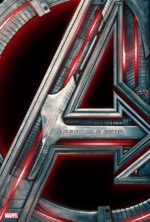
Starring: Robert Downey Jr.
May 2015
This review was originally tweeted in Real-time from the back row of a movie theater and appears @BackRoweReviews. Though efforts were made to tease rather than ruin this movie’s memorable lines and moments, some spoilers may exist in the following evaluation. The original tweets appear in black, while follow-up comments appear in red. For concerns over objectionable content, please first refer to one of the many parental movie guide websites. All ratings are based on a four star system. Happy reading!

Iron Man needs to watch his language.
According to Captain America—the Avengers’ Arbiter of Appropriateness.
“Send out the twins.” Olsen or Wonder?
An inside joke since the Olsen’s sister, Elizabeth, plays the Scarlet Witch in this film.
Hulk deals with the bunker. Perfect man for the job.
The not-so-Jolly-Green-Giant runs right through it as if it was made of balsa wood, never breaking his stride. An impressive visual.
#SentryMode. Cool concept.
“You could’ve saved us.” #Nosebleed
#JarvisIsMyCoPilot
Nice inside gag.
“He’s fast and she’s weird.” Ha!
Quite a pair these wonder twins. But where’s the monkey? Oh wait, that’s from the other comic book universe.
“Will Thor be there?” Women everywhere are thinking the same thing.
A suit of armor around the world. Interesting concept...and wholly improbable.
An extremely daft idea by Stark. His motivation here strains credulity, much like the plot itself.
#StanLee sighting in a bar. #Excelsior!
That’s the name of a starship in Star Trek III: The Search for Spock (1984). It also happens to be an exclamation frequently used by Lee which, in Latin, roughly translates as “ever upward.”
Trying to lift Thor’s Hammer scene is hilarious. Echoes of #TheSwordInTheStone.
“Peace in our time.” Peace through superior firepower. #UltronIsBorn
The latter is a quote from Star Trek: TNG’s “The Arsenal of Freedom.” The former is reminiscent of General Chang’s (Christopher Plummer) line “No peace in our time” in Star Trek VI: The Undiscovered Country (1991). A Trek double dip. No extra charge.
“The geometry of belief.” Ultron sets himself up on a throne. Recruits two disciples.
Shades of the antichrist sitting on a throne in the rebuilt temple in the Bible’s book of Revelation.
#AndySerkis is nearly unrecognizable here. Strange to see him out of a CG guise.
A nice bit of surprise casting.
The “mind games” visions contain some fascinating character moments.
These vignettes serve as the only significant source of character development for many of the characters in the film.
Code Green turns into a Code Red.
They should’ve left someone behind to keep an eye on “angry” Banner.
“Go to sleep. Go to sleep.”
“Go to sleep little Hulkie…”
Safe house. Something tells me it won’t be for long.
In action movies, the characters can’t sit around the campfire singing “Kum Ba Yah” for too long.
Graduation then sterilization. Sad story.
This scene contains some good character background for Black Widow. It’s the first time in two movies that I actually felt like I learned something about her character and felt sympathetic toward her.
“Multiplying faster than a Catholic rabbit.” Hilarious!
Or tribbles in a grain bin.
“It’s not a loop. It’s the end of the line.”
Kinda’ like this movie’s runaway elevated train sequence, which is conceptually similar to the one in Spider-Man 2 (2004).
“How about nonce?” Ha!
Downey Jr.’s comedic timing is impeccable.
“I can choke the life out of you without changing a shade.” Great line!
My favorite line in the movie, zucchinis not withstanding. Amazing how eloquent Banner can be compared to his alter ego.
The new guy hands Thor his hammer. Woah!
Does that mean this guy (my comics buddy tells me his name is Vision) is worthy of ruling Asgard?
“It’s about whether he’s right.” Interesting point.
The story flirts with relevance here.
Ultron’s been juicing. #VibraniumSmoothie
I hear mangos are best for sweetening up vibranium’s bitter aftertaste.
“The earth will crack under the weight of your failure.” #Ultron’sMonologuing
A poetic line brilliantly delivered by Spader, who was the perfect choice to voice the titular villain.
“If you step out that door, you’re an Avenger.” Nice moment.
This scene stands out as the only instance where my emotions were engaged during the entire film.
“Ooo, do you kiss your mother with that mouth?” Way to turn the tables, Fury.
#HideTheZucchini. Hilarious line.
Again, the incisive dialog written for Downey Jr. is perfectly suited to his talents.
“There is grace in their failings.” #RedeemingQuality
An interesting story twist since one AI wants to wipe out the human race because of its flaws and another AI wants to preserve humans because of their flaws.
Banner might swim to Fiji. Just as long as it isn’t Tahiti.
Reference: Marvel’s Agents of S.H.I.E.L.D.
Final analysis: a decent follow up to the first film with new heroes and villain and action aplenty.
Rating: 2 1/2 out of 4. Overstuffed with action to the point that I need to see it again. Darn it.
Overstuffed is the operative word when describing these Avengers films. They’re chock-full of colorful characters (in colorful costumes) and mind-blowing action sequences. The one thing these movies aren’t overstuffed with, however, is plot. Of course, the Avengers films are exemplars of the summer blockbuster, designed to entertain a mass audience and extract a price from them so as to ensure the release of the next big blockbuster. Filling the role of cinematic roller coaster, these films are breezy, twisty thrill rides that typically place an emphasis on action before story (and just like with a coaster’s ups and downs, the only function of the brief character moments is to bring us to the top of the next peak so that we can take a plunge into yet another exhilarating, gravity defying action progression). In an effort to be fair to the film’s creative elements, I’m not even going to address the top-notch directing, acting, VFX, etc, in my assessment of the film. What ails this sequel is its “everything including the kitchen sink” story. Like its predecessor, there’s enough story in Ultron to fill two to three movies. Likewise, there are enough plot holes and leaps of logic here to fill two to three movies as well. First of all, Ultron’s transformation to the dark side is so quick it gave me a whiplash. Also, Stark’s decision to create Ultron in the first place seems rushed and foolhardy…and extremely contrived since the story sits in idle until the villain is introduced. No one can say that Stark’s heart isn’t in the right place (well, actually…) in attempting to defend the Earth from intergalactic invaders, but has he so quickly forgotten the Iron Monger tragedy in Iron Man (2008)? Obadiah Stane (Jeff Bridges) used Stark’s technology against him in a clear evocation of the 9-11 tragedy. Here, Ultron uses our own planet against us in a unique twist on the WTC and Pentagon terror strikes. 9-11 symbolism is also evinced in the scene where Iron Man shoves Hulk downward through a building, forming a cloud of smoke and debris on the city streets below that’s eerily reminiscent to what we witnessed on that fateful day back in 2001. Whedon certainly isn’t the first superhero film director to create such visual echoes in his films: Christopher Nolan employed 9-11 imagery in each of his Batman films. Another visual motif, which has been repeated ad nauseam in recent superhero movies, is the giant landmass used as WMD set piece. In Superman Returns (2006), Lex Luthor’s (Kevin Spacey) grand scheme was to drop a gigantic, crystalline mass into the Atlantic Ocean, which would wipe out a large portion of the Eastern seaboard with the resultant tsunami. More recently, in X-Men: Days of Future Past (2014), villainous Magneto airlifts an entire stadium, which creates maximum destruction and mass casualties (and speaking of DOFP, that film featured Evan Peters as Quicksilver, but Aaron Taylor-Johnson plays him here, which is more than a little confusing at first). In this film, Ultron elevates a large section of an Eastern European village with the intention of dropping it like a meteor from the sky, causing an extinction level event on our planet. For the next film, let’s hope Whedon can come up with a more original threat than this tedious and tired story device. As for everyone’s favorite green giant, Hulk is completely underserved in this film. Not only is Hulk sidelined for much of the action, but he’s purposely constrained from doing what he does best—smash things. The only time Hulk really lets loose in this movie is when he goes on a rampage in a city filled with innocent bystanders. This attempt at generating character complexity falls flat and actually diverts us from the main story. Hulk’s contribution to the team during its many melees is negligible at best, which is a massive disappointment. Note to Whedon: in the next film, release the shackles and set Hulk free to fulfill his function on the team (and some character development wouldn’t hurt either). Another disappointment here is the absence of Clark Gregg as Agent Coulson (star of the hit TV show Marvel’s Agents of S.H.I.E.L.D and prominent side character in the Marvel stable of films) and Gwyneth Paltrow as Pepper Potts (who is mentioned several times, but never materializes onscreen). Of the ancillary characters actually featured in this film, Stellan Skarsgard’s Erik Selvig appears in only one scene…what a waste of an incredible talent. All is not lost, however, as there are a few good character moments in the movie, like when Black Widow opens up about her tragic past and when the team seeks refuge at Hawkeye’s house. But these heartfelt, human segues are few and far between amid the onslaught of confrontations. In the end, if you liked the first film, you’ll probably like this one too. The corollary holds true for those less impressed by the franchise. As overstuffed as the plot is, it all somehow manages to cohere. When all is said and done, kudos goes to Whedon, not for his creative genius in realizing the movie’s many action scenes, but for fitting them all into a canny, wieldy tapestry. He’s a master at keeping all the plates spinning at the same time. Let’s hope they don’t all come crashing down like chunks of a European village in the next film.
Ex Machina (R)
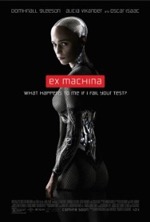
Starring: Alicia Vikander
April 2015
This review was originally tweeted in Real-time from the back row of a movie theater and appears @BackRoweReviews. Though efforts were made to tease rather than ruin this movie’s memorable lines and moments, some spoilers may exist in the following evaluation. The original tweets appear in black, while follow-up comments appear in red. For concerns over objectionable content, please first refer to one of the many parental movie guide websites. All ratings are based on a four star system. Happy reading!

Not quite. But certainly a unique entry into the genre.
First prize. #InstantCelebrity
Nothing new here…everyone wants a piece of success.
“Follow the river.” In which direction?
Pretty vague directions when dropping someone off in the middle of the wilderness.
Key card photo. Can I get a retake?
Remember that frightened look. You’ll see it again at the end of the film.
Gorgeous view from the patio. I can almost smell the pine trees.
The lab is situated in a remote region of a forest. Not only is the compound isolated, its tight, spare and windowless interiors lend it an institutional feel. Good thing Caleb doesn’t have claustrophobia.
Nathan wants Caleb to get past the “freaked out” stage.
Caleb should listen to his anxiety.
Data audit? Don’t sign the contract Caleb.
Of course, if he withholds his signature we don’t have a movie.
The Turing Test. Baptism of fire.
“Who’s Turing?” you ask. Reference The Imitation Game (2014).
Hello Ava!
Say it like “Hello Nurse!”
How many computer nerds wouldn’t get a #Ghostbusters reference?
Especially since Caleb holds his own during the Trek talk later in the movie. I chalk this up as a nitpick.
Ava turns the tables on Caleb, grills him with questions. Be careful, Caleb. Nathan is listening.
Also, learn from this incident. If she can turn the tables on you once…
“You shouldn’t trust anything he says.” Now we have a story.
Of course, everyone in the audience knows Nathan is full of it even before Caleb conducts his first session with Ava, so not much of a surprise.
Hacking the world’s cell phones. A map of how people think. Fascinating!
And frightening!
If you could go anywhere in the world, where would it be? Ava chooses a traffic intersection. #PeopleWatching
You’d find Data hanging out on the other side of the intersection, except he’d be engaged in small talk with passersby (TNG’s “Starship Mine”).
Ava plays dress up for Caleb. She looks kinda #PlainJane now.
Darn it! No more “curve” appeal.
“Engage intellect.” The discussion on #JacksonPollock and #StarTrek is intriguing.
Nathan’s Pollock painting does look like something Data would hang in his quarters.
Ava asks some tough questions for an AI.
Be very wary, young Caleb.
“Ava’s body’s a good one.” Uh, yeah!
The understatement of the year.
Caleb finds the skeletons in Nathan’s closet. #Sexbots
Hopefully there aren’t any minors in the audience since this is a Rated R movie (the fact that I’m bring this up reveals my distrust of parental “wisdom” in bringing younger kids to see such films), but just as a precaution: #FullFrontal.
Ava gives herself a physical upgrade. Thank God she put all the right parts in the right places.
Final analysis: an intriguing premise that asks some important questions about the essence of existence.
Rating: 3 out of 4. The Shakespearean ending is a miss, but the rest is a salient examination of sentience.
Deus ex machina is a Latin term that means “god from the machine.” The technique, which introduces a new character at the end of a story that swoops in and miraculously solves all of the problems, was employed by playwrights during Greek theater’s nascent period. Over time, the writing device fell out of favor and is now considered a universal no-no. In the new movie, which tellingly leaves out the deus (god) part of the title, we find a twist on the much impugned story device—we know who the agent of change is early on in the story, but how that character plays into the film’s climactic events is very much in question until the very end. The story here isn’t earth-shattering: A wealthy tech mogul lures a bright young computer nerd (under false pretenses) into conducting a Turing test on his latest android, who just happens to look like a supermodel. What works here is the examination—through the eyes of a machine—of what it means to be human. The mental chess match between Ava (Alicia Vikander) and Caleb (Domhnall Gleeson) is intriguing, and some complex emotional and psychological subjects are broached, such as: friendship, trust, sexuality and, of course, the essence of sentience. Another successful aspect of the film is its skillful thematic layering: the juxtapositions between the open spaces of the surrounding forest and the cloistered confines of the sterile lab, biological and mechanical beings and even good and bad people are all expertly woven into the movie’s narrative tapestry. The isolation from civilization and claustrophobia inside the compound both serve to enhance the film’s melancholic mood and are symbolic of how each of the characters is, in his/its own way, physically or mentally trapped. Lots of food for thought here, which makes the movie a joy watch. The small cast also suits the static, minimalist story. Each of the performers does fine work, but the lack of star power here (Oscar Isaac isn’t quite a household name yet, but will be come December) is one of the movie’s only drawbacks. The main problem with the film is its ending, which squanders a promising premise and solid setup with a predictable, even telegraphed, resolution that’s right out of Macbeth. In the end, Ex Machina is a stylish, thought provoking sci-fi yarn that should stand the test of time—well, at least until the androids take over and eradicate any trace of human existence.
Home (PG)
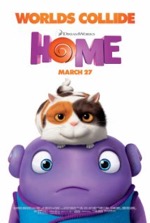
Starring: Jim Parsons
March 2015
This review was originally tweeted in Real-time from the back row of a movie theater and appears @BackRoweReviews. Though efforts were made to tease rather than ruin this movie’s memorable lines and moments, some spoilers may exist in the following evaluation. The original tweets appear in black, while follow-up comments appear in red. For concerns over objectionable content, please first refer to one of the many parental movie guide websites. All ratings are based on a four star system. Happy reading!

The best species at running away. The Boov will move.
And their new home world looks a lot like Earth.
Welcome to Happy Humantown. A nice place if you’re into relocation.
For some reason the word “forced” was erased before I hit the Tweet button. I meant to say “forced relocation,” i.e., a human reservation.
Send vs Send All button. #BadDesign
Isn’t it nice to know that it’s not just us humans who hate this potentially catastrophic email option?
Antarctica...the only place on Earth with no Boovs.
Probably has something to do with their skimpy outfits.
Love the Slushious machine.
Nice mash-up of the words slushy and luscious.
“We are definitely not doomed.” Uh, yeah you are.
Politicians, who put on a brave face so as to not create a panic among the populace, often say the exact opposite of the truth. I guess exposing kids to this reality right off the bat is a wise move.
The party evite is humorous. #ThirdRockFromTheSun
The line in the movie is “third planet from the sun,” but it seemed appropriate to throw out a hashtag for John Lithgow’s TV comedy of an alien family conducting cultural observation on our planet. #SimilarTheme
Boov turns car into a slush-mobile. A thousand bubbles per pint.
For some reason this modified vehicle, though radically different in body style and technological capabilities, reminds me of the flying car concept in The Absent Minded Professor (1961).
“Every time you lie you turn green.” That’s what happens when you drink too much #BustaLime.
A Boov tell. Maybe we can win the planet back with a well played hand of poker.
Boov rhymes with groove.
And with all of those appendages, Oh proves to be a natural at cutting a rug.
Sad-mad. “Humans are more complicated than it said in the pamphlet.”
Don’t worry, Oh, we human males can’t figure out the females of our species either.
Nine mistakes and you’re out. Oh has made 62 mistakes. He’s the #JarJar of the Boov.
This character trait—error-prone—is a bit too telegraphed in the story and is a clear rip off of Star Wars’ JarJar Binks.
Oh cancels his evite just in the nick of time.
And with the crisis averted, the movie ends right here. Not quite.
“Curse you and your tippy toe tallness.”
Though not quite Yoda-esque, the Boov’s assimilation of English has some curious, linguistic aberrations.
Bubble car chase is a lot of fun.
This sequence is the visual zenith of the movie. It’s a frenetic, fun-filled chase scene that’s right up there with the best efforts of Lucas and Spielberg.
The only thing that can halt the Gorg advance is a #BurritoTorpedo.
I think I ordered that at Taco Bell once. Didn’t agree with me.
“He runs toward the danger?” Oh learned that from a humans person.
Must’ve been a soldier or fire fighter.
Captain Oh is given the Shusher. The Boov celebrate their new leader.
Now shush so I can think!
The mother/daughter reunion scene is special. Anyone have a tissue?
“You were scared? I almost made a Number Three!” Hilarious!
The funniest line in the movie, tentacles down.
The real identity of the Gorg is a nice twist. A riff on #StarTrek’s #Balok.
From the original Star Trek series’ episode “The Corbomite Maneuver,” for all you diehard Trekkers out there. Yes, I am part of the body. Additionally, the subplot involving the Gorg (similar in sound to Gorn, right?) being the last of its kind is similar to the creatures in “The Man Trap” and “The Devil in the Dark.” Also, the repository of Gorg offspring inside the rock is similar to the chamber of silicon nodules in “The Devil in the Dark.” Queen to queen’s level three?
“Every day is best day ever!”
Unless you’re having a bad day.
Final analysis: an alien invasion story with some good laughs and a heartwarming finale.
Rating: 2 1/2 out of 4 stars. Fairly pedestrian at times but rallies for a resolution that’s straight from the heart.
The alien invasion premise has been done ad nauseam in films (Invasion of the Body Snatchers, Alien Nation) and TV (V, Earth: Final Conflict) over the years and has become an unofficial sci-fi sub-genre. Unfortunately, the variation on the theme featured in Home isn’t groundbreaking in either its conception or execution. On the run from the dreaded Gorg, the Boov invade Earth and relocate the entire human population to a carnival style reservation area, and no one protests their captivity since they now have an amusement park existence—go with it, it’s a kid’s movie. A young girl, Gratuity “Tip” Tucci (Rihanna), hiding out inside Boov inhabited territory encounters Oh (Jim Parsons), a mistake prone purple skinned alien whose bad decisions and clumsy pratfalls drives the plot. Whereas the standard issue story is the film’s greatest detriment, the unlikely friendship that blooms between Oh and Tip is what makes the film fly. Also, the finale, though certainly not original, is a genuine tear-jerker that should leave most adults in the audience feeling satisfied with the end result; kids will probably love this movie no matter what, thanks to its explosion of colors, sleek technology and fast paced plot. That model—entertaining the kids while servicing the adults with meaningful storylines—was pioneered by Disney and perfected by Pixar. Indeed, for the better part of two decades now, Pixar has been the undisputed leader in producing animated films that succeed at captivating the young minds in the audience while simultaneously engaging adult viewers on a deep emotional level (reference WALL-E and Up). Up until the last few years, most animated films were only able to achieve the former, but now the other major animation houses have begun to adopt Pixar’s adult-centric formula…with great success. Home is certainly an exemplar of that strategy, especially during its surprisingly powerful resolution. In some key ways the ending here reminds me of the one in Disney’s Mars Needs Moms (2011), another animated film that stages a tearful reunion between mother and child during the movie’s climactic passage. In the end, Home isn’t Earth-shattering, but it is a heartwarming tale of courage, compassion and companionship. Above all, the film shows us, in stark contrast to Boov mores and mannerisms, what it really means to be human. They say that home is where the heart is. If true, it shouldn’t be too hard to find room in your heart for Home.
Insurgent (PG-13)
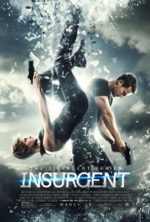
Starring: Shailene Woodley
March 2015
This review was originally tweeted in Real-time from the back row of a movie theater and appears @BackRoweReviews. Though efforts were made to tease rather than ruin this movie’s memorable lines and moments, some spoilers may exist in the following evaluation. The original tweets appear in black, while follow-up comments appear in red. For concerns over objectionable content, please first refer to one of the many parental movie guide websites. All ratings are based on a four star system. Happy reading!

I got it from the movie poster. A nice turn of the phrase “defy gravity.”
Peace is an obligation.
Marital Law is immediate. War is imminent.
“You killed us all.” Bleak nightmare.
Tris self-sheers. She wanted to do something different.
Her new coif makes her look like the girl in The Fault in Our Stars. Correction: self-shears. Also, Twitter doesn’t have an italics feature, otherwise I would’ve italicized the word “do” to create a pun with the shortened version of hairdo. And now I’ve ruined my magic trick by explaining it.
Jeanine inspects the founder’s version of the AllSpark.
This rectangular, rune-scrawled object also reminds me of the artifact in The Fifth Element (1997).
Peter shouldn’t have insulted Tris’ parents.
The easy way...but under protest.
It’s not the same as the “easy way” in Back to the Future II (1989), though.
Why doesn’t Caleb help out Tris when she’s attached?
I only ask this because he just made his first kill. Yes, he’s probably in shock over such an action, but his sister’s life is literally hanging in the balance. Correction: attacked. The new predictive function on iPhones thinks it’s being helpful when presenting words that look similar to one another. In a darkened theater, with a darkened phone screen, it’s easy to select the wrong word. The defense rests.
Welcome to Fort Factionless.
Don’t call Four Tobias. He won’t even let his mother call him that.
It’s not wise to call Indiana Jones “Junior” either.
“I always loved watching him sleep.” #Creepy
Unless you’re a betrothed Minbari.
The dystopian landscape is really well done in this film.
Fittingly, all Candor clothing is black and white.
‘Cause that’s the way they see the world. Get it?
“May the truth set you free.” And destroy your reputation and alienate your friends.
I meant to say, “alienate you from your friends.” But I trust the point was made.
“I killed Will.” Chills!
A very well-acted scene as Tris resists the truth serum with every ounce of her strength so as to not reveal her deep, dark secret.
“Thank you for your candor.” Up yours!
Or as Scotty would say, “Up your shaft!” (ST:III)
Jeanine is searching for a “special” Divergent. Gee, I wonder who that could be.
10% Divergent equals a bullet to the head.
This story element, which doesn’t appear in the book, is very effective in ratcheting up the tension.
Four shooting Eric cheapens his death. I much prefer Tris stabbing Eric in the book.
It was too soon to knock off the arrogant henchman. The audience needed to derive a greater feeling of vindication and satisfaction from Eric’s death. As filmed, it’s just a shallow slaying.
I could’ve skipped seeing Four’s tattoos again.
I know this gratuitous scene was placed here just for the teenybopper fan girls in the audience, but seeing Four’s tattoos once was quite sufficient. Actually, I could’ve skipped such a visual altogether, but that’s just me.
“We have plenty of guards.” Now that’s cold.
Jeanine shows Peter no respect, just like Peter shows Tris no respect. Bitterly ironic.
First sim: Tris must rescue her mother from a burning, flying house.
This is a superbly crafted sequence, but it’s overlong and overblown.
“Scary boyfriend skills.” Gotcha.
This is a pretty weak “Ah-ha!” moment. In the book, Tris knows she’s in a sim because Four grabs her on the shoulder where her bullet wound is, something her caring boyfriend would never do.
Amazing FX on the building demolitions.
If you’re into large-scale destruction.
“Are you real?” Better check his tats to make sure it’s really Four.
On second thought, let’s not.
Tris confronts her dark side.
This good half/bad half conflict has been done ad nauseam throughout TV/film history. The earliest example I can recall is when the transporter splits Capt. Kirk into good/evil halves in TOS’s “The Enemy Within.”
Divergents...the true purpose of the experiment.
As the culmination of the five factions, this revelation isn’t that much of a surprise; nor is the fact that they should be looked upon differently since they’re…different.
There’s hope beyond the wall.
But is there any hope for those inside the wall? Stay tuned.
A mass exodus of Divergents.
See you later Factionistas!
Final analysis: a solid follow-up to the first film, with some significant twists from the book.
Actually, the divergences from the book are extensive. Here are just a few: Marcus has a more prominent role in the action, there’s no AllSpark artifact and the loyal Dauntless join with the factionless to march on Erudite as a retaliatory response to the wrong’s committed by Jeanine and her lot in the first film.
Rating: 3 out of 4 stars. Some good action scenes and some superb FX. A solid set-up for the finale.
As sequels go, Insurgent, based on the teen book series by Veronica Roth and the follow-up to last year’s Divergent, is a solid effort. The middle chapter of any trilogy typically has an identity crisis—it’s either too similar to the initial movie or it strays too far in the wrong direction so as to be virtually unrecognizable when measured against the original concept. Whereas you’ll probably be lost if you haven’t seen Divergent, Insurgent stands on its own and is a logical extension of the first film rather than a radical departure from it. The vast majority of middle films will either end with a cliffhanger (i.e., Vader’s mind-blowing revelation that he’s Luke’s father in Star Wars: Episode V - The Empire Strikes Back) or the continuation of a journey (i.e., The Lord of the Rings: The Two Towers). With Insurgent, something strange happens for a middle chapter film…it resolves. In fact, it resolves to the degree that the saga can end right here with the characters living reasonably happily ever after. Of course, there are enough plot threads still dangling out there to justify extending the story, but the fact that it could’ve ended right here is a truly bizarre anomaly for a mid-trilogy film. Shifting gears to production, the bombed out environs are exceptionally well staged here; the rough, rubble riddled landscapes perfectly mirror the arduous psychological and spiritual journey the characters embark upon in the film. Indeed, the physical structures are soon transformed into mental ones as we get a glimpse into the architecture of the mind: Tris is subjected to a new battery of sims, just in case we didn’t get our fill of them in the last movie. Aside from the city exteriors, the only other environment worth mentioning is the Amity faction, which perfectly reflects the natural, serene vibe of its inhabitants. Since there are only a few substantive character moments in the movie, the acting won’t stand out as stellar…more like serviceable. The action sequences are mildly entertaining, but are somewhat standard issue for what we’ve come to anticipate from non-bloody, teen-centric confrontations. So, what can we expect from Allegiant, the final film in the series? Those who’ve read the books might feel like they have an inside track to what will happen, but if this movie’s deviations from book to script are any indication, we could be looking at a significantly different cinematic conclusion to what appears in Roth’s novel. To their credit, these adapted screenplays haven’t been slavish in their adherence to the source material, and the alterations have provided some interesting surprises along the way. And really, not knowing everything that will happen in a movie is part of its allure, right? Purists will probably disagree, but these Divergent screenplays have been faithful in the areas that count, but have deviated only where needed in order to make a good movie…which, at the end of the day, is what matters most. If the concluding chapter is as good as the first two, this will go down as one of the better trilogies in recent years, and second only to The Hunger Games in the YA dystopian market. Let’s hope the studio bean counters resist the urge to split the last book into two movies as was done with the Harry Potter, Twilight and The Hunger Games series. The penultimate movie in each of those franchises was disappointing and egregiously added filler just to stretch out the story in order to make more money. This brand of cinematic hucksterism, which compromises artistic integrity, subverts authorial intent and fleeces its audience, is downright despicable. The studio executives who conceived and engage in such practices should be tarred and feathered. I say that with as much candor as I can conjure.
Chappie (R)
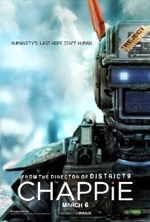
Starring: Sharlto Copley
March 2015
This review was originally tweeted in Real-time from the back row of a movie theater and appears @BackRoweReviews. Though efforts were made to tease rather than ruin this movie’s memorable lines and moments, some spoilers may exist in the following evaluation. The original tweets appear in black, while follow-up comments appear in red. For concerns over objectionable content, please first refer to one of the many parental movie guide websites. All ratings are based on a four star system. Happy reading!

A documentary style opening that details the plight of robo-cops in Jburg.
This mockumentary style opening has become a signature of Blomkamp’s films.
Criminals seek a robot remote. Well, even Data had an off switch.
The first in a long string of silly story devices in the movie.
Robot Gangster #1. A hair braided scheme.
A robot police force that can be shut off with the click of a button? What is this, I Robot (2004)?
A retarded robot. Ha!
One of the only funny lines in the film.
A rubber chicken...Chappie’s first toy.
All of the rubber duckies were sold out at the novelty store.
Chappie learns how to shoot a gun...sort of.
Too bad some of Chappie’s previous police programming couldn’t kick in here. No latent memories or abilities when your memory is wiped, I guess. Bummer!
Nurture your creativity. Inspirational thought of the day.
Check your desk calendar and I bet you’ll find something similar in it.
Chappie is pimped out. Gangsta Bot.
This transformation into a hood is good for a few laughs but the whole concept gets dafter as the story goes along.
Which dog do you want to be?
Is this like that motivational anecdote that asks: Which wolf will you feed today?
The new firmware functions like malware.
Surprised myself on this one.
Chappie meets his big brother, Moose.
A mechanical version of Rocky and Bullwinkle?
Gearing up for the heist. Slow motion team shot is similar to the one in #GuardiansOfTheGalaxy.
Various permutations of this scene can also be seen in Mystery Men (1999), The Right Stuff (1983) and even The Magnificent Seven (1960).
The Moose is similar to AT-STs in #StarWars and the big bots in #RoboCop. A decades-old design.
This is such a rip-off it’s not even funny. The only thing that’s new here is the Moose’s ability to fly. Wait a minute; I thought only pigs could do that.
Jackman’s having far too much fun with his new toy.
Like a kid in an arcade with unlimited tokens.
Live rounds in the office.
The fact that Jackman is allowed to carry a gun inside the office to begin with is ridiculous. He’s an engineer not a bounty hunter, darn it.
Transferring consciousness. Yeah right.
Last year we saw two films where a person’s essence was downloaded into a computer: Transcendence and Lucy. Both movies were mediocre at best, although Lucy was far more entertaining, thanks to its butt kicking heroine.
I didn’t realize a person’s entire consciousness could fit on a flash drive.
The same daffy resolution appeared in Lucy where her consciousness was transferred into a flash drive. Here, Patel’s soul is downloaded into the CPU of a robot in a matter of minutes. It takes me longer to download a movie on iTunes!
Final analysis: an intriguing premise that didn’t even come close to living up to it’s potential.
The titular robot is completely unsympathetic and the characters are as 2D as the ones in that He-Man cartoon.
Rating: 2 out of 4. Flirts with a message about AIs, but is banal beyond belief. Blomkamp’s first disappointment.
Neill Blomkamp’s films have seen a steady decline in quality and approval over the years. His first film, District 9 (2009), was a critical and financial success and was nominated for Best Picture—quite an honor for a sci-fi film. Blomkamp’s next project, Elysium (2013), while visually engaging and thought provoking, received a tepid response from critics and audiences alike. Now we have Chappie, the story of a repurposed police robot that achieves something akin to sentience thanks to a program created by his “maker,” Deon Wilson (Dev Patel). However, Chappie unwittingly falls in with the wrong crowd and is soon transformed into a gangsta’ bot, much to his creator’s chagrin. The story is contrived (robot police force plus a giant Mech equals RoboCop) and formulaic (the transference of a person’s consciousness into a machine is similar to Transcendence and Lucy) and has none of the ripped-from-the-headlines relevance of Blomkamp’s earlier films. Besides a paper thin subplot involving Deon’s rival engineer Vincent (Hugh Jackman), the daffy transformation during the movie’s climax is ludicrous to the extent that it completely obliterates any chance the movie had of being a success. If there’s a plus side here, it’s that this film, like the director’s earlier efforts, features extensive on location shooting in Johannesburg, South Africa, which is a huge boon to the film’s gritty visual style. Indeed, the ramshackle, seedy environs of Joburg are the perfect compliment and backdrop to the criminal activities that transpire throughout the film. Where the acting is concerned, only Patel (along with Sharlto Copley as the voice of Chappie), shines here: everyone else, including Jackman and Sigourney Weaver, is extremely wooden in their respective portrayals. Of course, the main problem with the performances is that the actors didn’t have much to work with, thanks, in large part, to Blomkamp and Terri Tatchell’s anemic script, which is riddled with pedestrian dialog, shallow characterizations and standard situations with fairly obvious solutions. All of these negative aspects could’ve been overlooked if Chappie had been rendered more like E.T. and less like Alf in the movie. Even something closer to Short Circuit’s (1986) Number 5 would’ve stood a better chance of winning over the audience. Chappie’s aping of the hoodlums is funny for about five minutes, after which the ghetto speech and swagger becomes exceedingly offensive and tiresome. It’s natural that we should want to pull for the impressionable automaton (who is the lead character, after all), but due to the Chappie’s annoying and irredeemable qualities, we simply cannot bring ourselves to cheer for the rabbit-eared robot. The fact that we’re prevented from fully identifying with the eponymous android is this film’s Achilles ’ heel. A movie featuring an unsympathetic robot is about as useful as a heap of spare parts. Though it pains me to say this, Chappie is crappy.
Jupiter Ascending (PG-13)
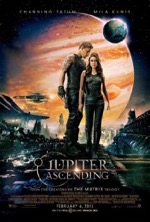
Starring: Channing Tatum
February 2015
This review was originally tweeted in Real-time from the back row of a movie theater and appears @BackRoweReviews. Though efforts were made to tease rather than ruin this movie’s memorable lines and moments, some spoilers may exist in the following evaluation. The original tweets appear in black, while follow-up comments appear in red. For concerns over objectionable content, please first refer to one of the many parental movie guide websites. All ratings are based on a four star system. Happy reading!

Hardly.
Failure agrees with you. Ah, brotherly love.
Ok, I’m just gonna’ come right out and say it…Eddie Redmayne is creepy weird in this movie. His Botox lip job speech was probably intended to give him a tough guy, Marlon Brando in The Godfather vibe, but this character quirk just looks awkward and bizarre. In The Theory of Everything, Redmayne played a character that was in pain but doesn’t show it…here he looks like he’s in pain but isn’t.
“Urges and obligations.” The death of romance.
Yeah, talk about a gigantic buzz kill.
Tatum takes out some grays. Exciting action scene.
The first time around, anyway. Redmayne’s instant replay is redundant and anticlimactic.
Tatum and Kunis encounter trouble on the beam up.
“Sharing has never been a strong suit of your species.” Sad, but true.
No, you can’t have any of my popcorn.
Jupiter is kidnapped in a cornfield by bounty hunter scum.
This scene reminded me a lot of Signs (2002). A far superior film to this one.
Now we know where crop circles come from.
As if there was any doubt…after seeing Signs.
“Where do you get those lightbulbs?” Was that a pickup line?
Are light bulbs the new code word for melons?
“I will never complain about the DMV ever again.” No kidding. These people are as anal as the Vogons.
By comparison, this movie makes The Hitchhiker’s Guide to the Galaxy (2005) look like the finest sci-fi story ever written.
Jupiter drops a vial. Way to go, you just killed 100 people.
Their essence is spilled all over the deck floor. Talk about wasting already ignominious deaths.
Dino warriors drop in for dinner.
Funny, they didn’t even touch the salad.
The elephant guy at the helm made me chuckle.
I wonder why we’ve never seen an elephant-like alien before in any other sci-fi movie. Maybe because it’s utterly ridiculous looking.
Jupiter is buried in a complex inside Jupiter’s eye. A little too on the nose?
Or tongue in cheek? Or self-indulgent, cutesy writing?
Tatum takes his jacket off. Wait a minute, I didn’t know he was Birdman.
As bizarre as Birdman is at times, at least it has a chance of winning an Oscar.
Final analysis: an ambitious project that ends up being an uninspired knockoff of Dune.
The story galaxy trots and introduces us to many people on different planets who have little to say and even less impact on the story…a cheap imitation of Frank Herbert’s masterwork of sci-fi literature. This star tour does little to advance the plot and actually makes it bog down with predictable reactions to common situations, all held together by a string of sensory overloading action sequences.
Rating: 2 out of 4. Weak dialog and an insipid plot make this film fall flatter than a crop circle.
When I first saw the trailer for this film I was immediately impressed by the visual effects and the basic premise—a young woman discovering that she’s actually a star princess (hey, it appeals to the fanboy in me that revels in the populist fantasy of The Last Starfighter…or that other little movie about some kid named Luke joining a rebellion in a far, far off place). It did look a tad “teeny” (i.e., The Hunger Games or Divergent) to me and the inclusion of teen heartthrobs Mila Kunis and Channing Tatum did little to dissuade that notion. Normally, in order to give each movie a fair shake, I start out with a rating of 2 out of 4 stars and adjust up or down accordingly depending on the quality of the film as it progresses. In this case, the needle never budged during the entire movie. Clearly, Warner Bros. thought enough of this project to attach some top talent (and some notable supporting players like Sean Bean and Eddie Redmayne) along with topnotch FX to it, but they clearly should’ve spent some more time and money on this confusing, uninspiring story. I believe it was somewhere around the half hour mark when I asked myself, “Where is this movie going?” There’s no McGuffin to drive the plot. There’s no clear-cut goal. Kunis seems completely unaffected by the fact that she’s actually an intergalactic princess and that little gray guys with fangs are chasing her around the city. Tatum’s acting is patently flat and judging from his character’s appearance, his mother was an elf and his father was a werewolf. Eddie Redmayne clearly hasn’t worked out all of the physical kinks from his turn as Stephen Hawking in The Theory of Everything; his stiff gait looks like he’s had a ramrod shoved up you-know-where and his tightlipped speech hints at a Botox session gone horribly wrong. Kunis’ Jupiter is an indecisive, dimwitted ingénue who consistently makes poor decisions, requiring white knight Tatum to swoop in and rescue her. This pattern occurs ad nauseam in the film—i.e., Kunis marrying Redmayne, who she just met, and then nearly signing ownership of the Earth over to him—and is utterly ludicrous. Like the narrative equivalent of a pinball game, the story bounces from one planet to the next and the plot gets murkier with each new locale the characters visit. The bounty hunter subplot goes nowhere, the action scenes are overblown and the story doesn’t take us anywhere emotionally despite taking us on a whirlwind tour of the cosmos. The only thing I found remotely compelling in the film is the notion that the Earth is just a small cog in an expansive industrialized universe. However, this concept is briefly introduced and then quickly abandoned for one of the film’s myriad action sequences. To call this movie a disappointment is a galactic understatement, especially since it was written and directed by Andy and Lana Wachowski, masterminds behind the Matrix trilogy. If, by some fluke of fate, this movie should perform well enough to inspire a sequel, it should be called Jupiter Descending.
The Hunger Games: Mockingjay, Part 1 (PG-13)
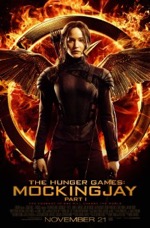
Starring: Jennifer Lawrence
November 2014
This review was originally tweeted in Real-time from the back row of a movie theater and appears @BackRoweReviews. Though efforts were made to tease rather than ruin this movie’s memorable lines and moments, some spoilers may exist in the following evaluation. The original tweets appear in black, while follow-up comments appear in red. For concerns over objectionable content, please first refer to one of the many parental movie guide websites. All ratings are based on a four star system. Happy reading!

And Josh Hutcherson. And Liam Hemsworth. And Woody Harrelson. And, posthumously, Philip Seymour Hoffman…the two Mockingjay films will be the last entries in his filmography.
The face of the revolution is an angry one.
And with all that’s happened to her in the first two films, why wouldn’t she be mad?
Katniss visits 12. The ashes of her action.
Yeah, stepping on skulls…not so pleasant. Unless you’re a Terminator.
“Never let them see you bleed.” Snow’s video address promises death for the disorderly.
A spin on the phrase, “Never let them see you sweat.” Snow’s homespun phrase better suits his martial worldview. Blood, after all, is something he’s reminded of every time he swallows.
“What costs more than your life?”
A good question…any answer seems somewhat philosophical, though.
Peeta calls for a cease fire. 13 erupts.
The somber mess hall quickly transforms into something akin to Hogwarts at meal time.
Coin capitulates to Katniss’ conditions.
Coin is played by Julianne Moore, who brings a great deal of nuance to the role. She’s definitely not a villain, but she’s isn’t altogether good either. Her ending speech is so convincing that we can’t help but cheer on a worldview not all that dissimilar from Snow’s. If the story has any meat, this is it.
“The best dressed rebel in history.” Not even close. Leah in Jabba’s Palace.
“Let’s not fire the red ones in here.” Ha!
C’mon, Beetee! You’re no fun.
Katniss visits the wounded in 8. They salute her.
This is a moving scene and is the heart of the film, literally and figuratively.
Snow proves himself a terrorist by bombing a hospital.
Joker did the same thing in The Dark Knight (2008). Also, this is a war crime tactic frequently committed by Hamas…in the real world.
“If we burn, you burn with us!” A great scene that makes an effective propaganda video.
However, by engaging in a political media blitz of their own, aren’t the rebels just as bad as the Capitol? And, by threatening to fight fire with fire, aren’t their tactics similar to Snow’s? It might not be much more than what you’d get on a hot wing, but like I said before, there is some meat on the bone here.
Gale regales the story of 12s demise. Sobering.
However, the account looses a little punch since we’ve already seen the devastation that’s been done to the decimated district.
“Dead by morning.” Code red time.
A threat and a warning all wrapped up into one startling statement.
Prim goes back for the cat. So did Ripley in Alien and that almost got her killed.
This scene in Alien (1979) always rankled me since it’s just a contrivance for extending the movie an extra fifteen minutes. In this movie it’s just a young girl rescuing her cat, so her actions are more understandable and forgivable…especially since there isn’t a pernicious alien on the loose.
Snow leaves his calling card after the bombing. The message is loud and clear.
Final analysis: a somber opening to the final chapter of this dystopian saga.
A mild disappointment, although the source material itself was weaker than its predecessors.
Without a Games, the structure is looser and the objectives aren’t nearly as well defined as in the first two books/movies.
Rating: 2 1/2 out of 4. A dark, bleak chapter. Will it be redeemed by a satisfying ending?
I suppose we have the Harry Potter film series to blame for this mediocre movie. In a shamelessly lucrative move, Warner Bros. decided to make two movies out of J.K. Rowling’s final Potter novel, Harry Potter and the Deathly Hallows. The Twilight movies soon followed suit by bifurcating Breaking Dawn, the last book of Stephenie Meyer’s blockbuster fantasy trilogy. Now, The Hunger Games series has officially established this pattern as a trend by bisecting Suzanne Collins’ final novel, Mockingjay, into two films. The end result for each franchise has been an unsatisfactory setup film followed by a triumphant end to the saga. Mockingjay - Part 1 is a dark, drab affair with too many talking scenes and not nearly enough action. That’s my nutshell evaluation of the film. I temper that rather harsh assessment with the admission that the film does get a few things right. Kudos must be given to director Francis Lawrence for embellishing on the source material and actually detailing the rescue sequence, which the book merely mentions and then forces the characters back in 13 to sit on their hands until the team returns. However, even though the extraction sequence adds some much needed action to the back quarter of the film, the methodical manner in which the scenes are shot isn’t any more cinematic than what you’d find on a well produced spy/political thriller on TV. Though the performances are strong across the board, the characters, save for Katniss, really aren’t given much to do, except for stand around and talk…or posture…or fret…or tell Katniss to say her lines once more with feeling. Case in point: Jeffrey Wright is a fine actor, but he’s relegated to spitting out an incessant string of technobabble in the movie. Beetee is very similar to the eccentric, tech savvy character Wright played in Source Code (2011) with a dash of Q from the Bond films. If there’s one saving grace here it’s the movie’s unflinching insistence on making subtle political commentary, particularly regarding the nature of terrorism, which seems to be prescient since the books were written between 2008 and 2010—several years before the recent escalation of violence in the Middle East perpetrated by Hamas and the Islamic State. Besides incidental topicality and typical teen angst, there really isn’t much more to comment on here. Even though the purpose of this film was simply to set the table for the grand finale, it would’ve been nice if the movie had employed a more engaging script; this uninspired and perfunctory effort is like excess filler used to stretch out a story until the really important events transpire. The movie contains none of the pulse-pounding excitement of its predecessors, which is a profound disappointment. I wish I could say that this sequel left me—as the earlier movies did—hungry for more, but I just can’t. In the final analysis, The Hunger Games without the actual Games is like a hamburger without the meat. Sure, you can eat the bun all by itself, but it won’t be all that appetizing and won’t sustain you for very long. Where’s the beef?
Big Hero 6 (PG)
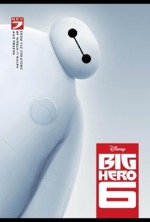
Starring: Ryan Potter
November 2014
This review was originally tweeted in Real-time from the back row of a movie theater and appears @BackRoweReviews. Though efforts were made to tease rather than ruin this movie’s memorable lines and moments, some spoilers may exist in the following evaluation. The original tweets appear in black, while follow-up comments appear in red. For concerns over objectionable content, please first refer to one of the many parental movie guide websites. All ratings are based on a four star system. Happy reading!

#Feast is a truly moving animated short.
Just the latest evidence that Disney is rapidly approaching Pixar’s level of quality. Of course, executive producer John Lasseter, who oversees projects for both animation houses, has much to do with this parity.
David vs. Goliath style RC bot battle. Don’t judge a bot by its appearance, though.
Yeah, I wouldn’t dare pick a fight with R2.
“Welcome to the Nerd Lab.”
One suspects that this vibe is similar to the one you’d get in an animation studio, so these scenes are a bit self-reflexive.
Micro-bot exhibition is quite impressive. So long Lego bricks.
It’s amazing how innocent a new technology starts out…and just how quickly its altruistic vision can be perverted.
“Diagnosis: puberty.” Someone should pitch that to #abcfamily.
Fist bump scene is humorous.
This gag pays off dividends throughout the movie.
“There are no red lights in a car chase.” Ha!
This is a thinly veiled reference to Tom Hanks’ oft-quoted remark (“There’s no crying in baseball!”) in A League of Their Own (1992).
The inclusion of #StanLee in the family portrait is clever.
The first successful Marvel integration into a Disney movie. This Easter egg isn’t here by accident…but you’ll have to stick around through the end credits to learn its significance.
The flight scene is exhilarating but recalls similar ones in the #HowToTrainYourDragon movies.
Project Silent Sparrow looks an awful lot like #StargateSG1.
Besides the extra gate, the master shot looks like it was lifted right out of an episode of this long running sci-fi series.
Cool watercolor universe.
Or is it tie-dye? Or is it lava lamp? No I’m not tripping, but the animators sure were.
Nice title reveal in the last scene of the movie.
Final analysis: a high spirited, heartwarming tale of a cuddly robot, a young inventor and a group of nerds.
These nerds fulfill a vital role in the film as comic relief, especially Fred (T.J. Miller), and solid support for the hero.
Rating: 3 out of 4 stars. A sequel seems all but assured. Be sure to stay through the end credits.
Based on the comic book series (from Marvel, of course) of the same name created by Steven T. Seagle and Duncan Rouleau, BH6 tells a very human tale in the midst of a protracted struggle to control a powerful new technology. The movie sets up in a similar manner to Meet the Robinsons (2007), also a Disney animated effort, in the way a science fair/expo experiment is stolen and used to devastating effect by a misguided villain. The exploited technology in this case is millions of tiny microbots, which, when controlled by a person’s thoughts via a headband (similar to the Bowler Hat Guy’s high-tech headgear in Robinsons), can construct a myriad objects, shapes, weapons, etc. Though quite a bit larger, these microbots remind me of the insidiously relentless nanites in Star Trek: The Next Generation. The way the villain uses the microbots as a mobile dais is the kind of spine-tingling image you’d expect to see in a live action superhero film intended for a much older audience. Even though the movie’s main character is young tech geek Hiro (Ryan Potter), the focal point of the film is undeniably the rotund robot, Baymax (voiced with absolutely perfect inflections by 30 Rock’s Scott Adsit). The love child of the Michelin Man and EVE from WALL-E (2008), Baymax (this is one silly name…it sounds like Betamax, a technology that didn’t fare too well) is a lovable sidekick with a central processor of gold and a unique skill set…he provides portable medical services. Upon hearing that universal sound of distress, “Ouch!,” Baymax inflates, initiates its programming and launches into triage mode (this brand of activation reminds me of the way the holographic doctor appeared when summoned in Star Trek: Voyager, “Please state the nature of the medical emergency.”). Though Baymax’ skills and enhancements are impressive, as well as a whole lot of fun to watch in action, it’s his compassion and empathy that make his character so appealing. Hiro’s journey is an emotional one and Baymax’ ministrations (mostly psychological) are a salve for the young boy’s tragic loss early in the film. The loss of loved ones lies at the heart of the film and, ironically, provides motivation for the protagonist and antagonist. Even though the film deals with some fairly heavy issues, it is, after all, a Disney movie, and that means the story must have a happy ending. To whit, the hero comes to terms with his loss and the villain is redeemed, to an extent, and they all live... In the end, the story is moving and exhilarating, and you can bet that a sequel will soon be in the works. This is definitely a movie where you feel better walking out than when you walked into the theater. So now the only question that remains is, “Are you satisfied with your care?”
Interstellar (PG-13)
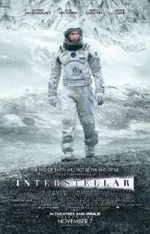
Starring: Matthew McConaughey
November 2014
This review was originally tweeted in Real-time from the back row of a movie theater and appears @BackRoweReviews. Though efforts were made to tease rather than ruin this movie’s memorable lines and moments, some spoilers may exist in the following evaluation. The original tweets appear in black, while follow-up comments appear in red. For concerns over objectionable content, please first refer to one of the many parental movie guide websites. All ratings are based on a four star system. Happy reading!

Interesting documentary style opening.
The series of retrospective interviews in these opening scenes play out like the real ones frequently seen on the History Channel.
Last okra crop...ever. No big loss for me.
I know I’m probably causing a Southern uprising (doesn’t take much) by making such a statement, but I never developed a taste for this slimy veggie…pod…thing.
Chasing a drone through a cornfield.
More precise verbiage is needed here. The drone is in the air. McConaughey takes his truck trough a cornfield, Twister-style, on a reckless pursuit of the drone.
Updated textbooks...a frightening possibility and one that could be right around the corner.
Book burning was so last century. Now it’s all about revisionist history; the political party that’s in charge gets to determine the proper recitation and redaction of history. Remember, history is written by the winners…and the egomaniacal socialists who ascend to power by deceiving the masses. A tad too on the nose?
The bookcase is trying to communicate with them.
Co-writer, Jonathan Nolan, also uses the Dewey Decimal System on book spines as a means of dispensing the “number” to Jim Caviezel and Michael Emerson on Person of Interest, a TV series he created. Clearly he has a yen for dispatching clues to his characters through books…a decidedly low-tech method of conveyance.
Ballgame is postponed by a doozy of a dust storm.
The crew prepares for their “long nap.”
I can use one of those every so often. Like right nowwwwww…….
I learned that paper trick in science class in high school. Also a useful way of explaining warp speed.
Seven years per hour. Not my kind of planet. Although, it does have the best surfing in the universe.
However, if you don’t make it through the barrel, you’re dead.
Letters from home are tearjerkers.
Make sure you have a tissue handy. On second thought, make it a whole box.
Frozen cloud...trippy.
This is the kind of scientifically plausible, world-building detail that really fires my imagination. Even though I wish there would’ve been more of them in the movie, I thoroughly enjoyed the unique and unusual planet concepts featured here.
A race to the ship. I stopped breathing about ten minutes ago.
This entire sequence is one of the finest ever filmed. That’s quite a boast, but this taut series of events is as genuinely nail-biting as they come.
Newton’s third law. Hilarious!
So much for “No one left behind.”
A 3D construct within a 5D reality. My mind has been sufficiently blown.
Leave it to the Nolan brothers to come up with something this mind-bending. The interspatial architecture takes its cues from Inception (2010) and is somewhat Escher-esque in the way it depicts multiple impossible angles/vantages.
Final analysis: a deeply moving story centered on the survival of the human race.
Which just happens to be a sci-fi film.
Rating: 4 out of 4 stars. A modern 2001 that just might be the first legitimate sci-fi Best Picture hopeful.
Okay, so before anyone points out the fact that space-tacular Gravity was up for Best Picture last year, two things: 1. Was it a “legitimate” contender for Oscar’s top prize (I argue no)?, and 2. Can the film even be classified as science fiction since its technology is comparable to contemporary standards and because the story never leaves the solar system, much less the space surrounding the Earth? That said, Christopher Nolan’s sci-fi opus, Interstellar, takes us far afield to worlds of wonder; one of which, hopefully, will harbor the holdouts of humanity since we’ve pretty much destroyed our home world by the time the movie takes place (which doesn’t appear to be all that far into the future…frightening!). There are plenty of things to nitpick here—like the fact that Michael Caine’s character ages little over a twenty-three year time span (guess that proves just how timeless he is), that people don’t seem all that distraught over the prospect of eating nothing but corn for the rest of their lives, that a dying planet’s economy could even fund deep space exploration on this scale and that Hathaway, a scientist, is tasked with landing the ship that houses the future of our race—a repository of embryos. Granted, the plot isn’t as airtight as any of the spaceships seen in the film, but it coheres to the extent that it needs to in order to convey its artfully told cautionary tale: consider the movie the unlikely marriage of 2001: A Space Odyssey (1968) and An Inconvenient Truth (2006). The filmic mash-up doesn’t end there: There’s a heavy quotation of Apollo 13 (1995) during the suspenseful scenes in space, especially when the ship is violently jostled about and when presumably unnecessary parts are seen falling away from the ship. Nolan also upholds one of Star Trek’s finest traditions in the way his characters systematically explore “strange new worlds.” Although the action frequently crosscuts between characters in different places/times, the film can be subdivided (roughly) into thirds. The first third focuses on the plight of the characters on a desiccated Earth, the second section deals with space travel and planetary surveys and the third segment features the story’s ethereal, unconventional climax. While on the tack of appraising the film, we can cut it right down the middle and call one half character/story driven and the other half action/adventure driven…in short; this is a very well-balanced film and a rarity for the sci-fi genre, which typically places emphasis on the latter over the former. The movie’s themes are legion and invite various readings, which should keep both water cooler enthusiasts and film school students chewing on this cosmic cud for years to come. There are plenty of story elements to evaluate here, such as: science vs. faith, ecosystem entropy, rogue drones, book censorship, time-challenged family dynamics, the finest/worst aspects of humanity in survival situations and the idealistic notion that love conquers all. An analysis of the “they” can also make for a bracing discussion, especially when time is thrown into the equation. For instance, do the Plan B colonists become the 5th dimensional saviors of Earth’s Plan A remnant? Be sure to pace yourself, though; if you’re not careful, such cogitations can cook your noodle. Another plus here is that the movie is fairly feasible and factual where its science is concerned, which should delight lovers of hard science sci-fi (as opposed to soft science sci-fi, a la Guardians of the Galaxy) to no end. And let’s not forget the stellar FX and cinematography that creates the film’s unique look and feel. To whit, Nolan uses absolute silence during the exterior space shots to great effect: remember, in space no one can hear you scream. Hans Zimmer’s atmospheric, organ saturated score produces a distinctly unsettling accompaniment that recalls the otherworldly “classical” soundtrack for 2001. I’ve yammered on for so long now that the blight just spread to the planet’s last ear of corn. Sorry about that. Ironically, I’ve only scratched the surface of the myriad meanings contained within this multivalent yarn. Those who are successful at suspending their disbelief—by buying into the notion that humans have the wherewithal to actually venture out into the distant reaches of space—will affirm the movie as a journey well worth taking. Bottom line: Interstellar is a visual marvel and a masterwork of science fiction that will, if you’ll forgive the temporal pun, stand the test of time. Getting lost in space has never been more thrilling or terrifying.
The Maze Runner (PG-13)
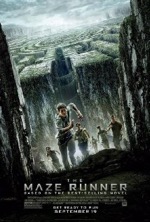
Starring: Dylan O’Brien
September 2014
This review was originally tweeted in Real-time from the back row of a movie theater and appears @BackRoweReviews. Though efforts were made to tease rather than ruin this movie’s memorable lines and moments, some spoilers may exist in the following evaluation. The original tweets appear in black, while follow-up comments appear in red. For concerns over objectionable content, please first refer to one of the many parental movie guide websites. All ratings are based on a four star system. Happy reading!

Not sure I’d want to be part of a world where amnesia is normal.
Although, selective amnesia would be useful for forgetting the less desirable parts of the past.
The box, the tour and three rules.
And a creeper that lurks in the forest.
Ben is banished for breaking the second rule.
Beware the Second Rule! And shouldn’t Thomas start to turn once he’s been bitten by Ben? Oh wait, this isn’t The Walking Dead.
Thomas remembers his name and carves it into the wall.
Seeing all of the scratched out names is a bit unsettling.
Griever descends on Thomas like Shelob.
However, the scene where the giant spider hovers above Frodo in The Lord of the Rings: The Return of the King is far superior to this perspective shot.
A new Greenie arrives with an ominous note.
Markings on supplies: W.C.K.D. Wicked?
Can they make it any more obvious? And what a dumb acronym.
Monolithic walls are quite imposing.
One of the lines from the book perfectly captures the ominous dimensionality of the walls: “Twilight had fallen, and the mammoth walls looked like enormous tombstones in a weed-infested cemetery for giants.” (Chapter 17, third sentence).
Sprinting through the blades...a pulse-pounding sequence.
This is the latest in a long line of genre films where an action sequence was storyboarded as if it were a video game (perhaps with an eye toward being released as a video game). Additionally, the various sections of the maze are like the different levels of a video game.
This just became a horror movie: Night of the Grievers.
And why leave the doors open since the Grievers can climb over the walls and sneak in surreptitiously? I suppose things have to be spelled out for the audience, but wouldn’t it have been even more terrifying if the Grievers had attacked with the doors closed? Oh my God…Grievers! How did they get in?
Griever heads look like cave trolls.
Another LOTR rip-off.
Exit sign. If it looks too good to be true...
Final analysis: a suspenseful mystery that’s fairly faithful to the book with some effective alterations.
Rating: 2 1/2 out 4 stars. Let’s see what this Phase 2 is all about in the sequel.
It’s been brewing for some time now, what with the myriad similarly themed stories that have over-saturated the market in recent years, but it looks as if this movie has finally ushered in a period of dystopian teen novel fatigue...one can only hope. Coming hot on the heels of The Hunger Games and Divergent, this movie is yet another near-future survival tale that focuses on teenagers in perpetual peril. Unfortunately, the source material here doesn’t have anywhere near the socio-political relevance boasted by those other two, far superior book-to-movie franchises. The story begins with a young man named Thomas arriving at a walled in glade via a metal cargo box. Thomas is immediately greeted by a group of boys his own age and soon enough we’re launched into a Lord of the Flies meets Lost meets Labyrinth adventure yarn with heavy quotations of The Lord of the Rings and Jurassic Park. What works here is the initial mystery which places Thomas in this strange environment with no memory of what his life was like before his arrival. The strange speech, customs and rules of the realm also intrigue in the early stages of the story, but made-up words like shank and klunk soon grow tired. Likewise, constantly being reminded of the rules becomes tedious and annoying. The middle of the movie maintains interest with several frenetic chase scenes and major plot revelations. If there’s one area of the movie that grossly underperforms, it’s the standard, unimaginative, and highly improbable ending. SPOILER ALERT: So the whole plot boils down to the fact that the earth has been ravaged by solar flares and the remnant of humanity lives in a gigantic circular city with the maze inhabiting its center. So then, with limited resources, man power, etc, the maze was erected for the sole purpose of providing a training ground for these kids to run around in? This stretch of credulity reminds me of the original Star Trek episode “The Mark of Gideon,” where the Enterprise visits a planet with overpopulation problems. The inhabitants of the world build an exact duplicate of the Enterprise to lure Capt. Kirk down to the surface. Since the populace is shown living in shoulder to shoulder confinement, isn’t the presence of a 289 meter long starship an illogical misappropriation of space on their overcrowded planet? Though not quite as ridiculous, isn’t building massive, movable walls for an extensive series of mazes an egregious waste of time and money for a species on the brink of extinction (and does humanity really have three years to waste on this pubescent experiment)? And why don’t the Gladers know where the edge of the maze is if they’ve constructed a completed, circular mini-maze in the map room (and how can the model be accurate if the walls change every night)? And why is it that on his first foray into the maze, Thomas discovers a section of the maze that the lead runner has never seen on his daily ventures into the labyrinth? When you actually stop to think about it, the movie’s overarching premise is absolutely ludicrous and many of the crucial plot points are utterly laughable…just like the ones in that bottom barrel Trek episode. The intriguing setup desiccates to dust once the teens reach the control center and the less-than-original, far-from-inspired explanation for the whole mystery is revealed. Also, the project leader’s (Patricia Clarkson) staged death is unnecessary and contrived beyond belief. The teenage boys have a graduation of sorts when they find their way out of the maze, which they quickly leave behind when journeying toward their next challenge—an abandoned city where they’ll doubtlessly run into a division of Dauntless operatives itching for a fight in the sequel. So what’s the movie’s takeaway? Some mysteries are better left unsolved. Or, everything was going just fine before that shuck-face Thomas showed up.
The Giver (PG-13)
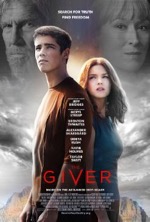
Starring: Brenton Thwaites
August 2014
This review was originally tweeted in Real-time from the back row of a movie theater and appears @BackRoweReviews. Though efforts were made to tease rather than ruin this movie’s memorable lines and moments, some spoilers may exist in the following evaluation. The original tweets appear in black, while follow-up comments appear in red. For concerns over objectionable content, please first refer to one of the many parental movie guide websites. All ratings are based on a four star system. Happy reading!

The Newbery, along with the Caldecott, are the two highest honors in children’s literature.
Don’t be thrown by the B&W, folks. You’ll soon learn why.
The B&W cinematography works on two levels: 1. It effectively depicts the “Sameness” of this ultra-compliant society, and 2. It lends the film a Classical Hollywood look and feel that further reinforces the community’s idealistic, “Leave it to Beaver” veneer.
Streep tells a knee-slapper...literally.
Asher’s assignment in the movie is quite different than in the novel.
It was obvious that effecting such a change would have implications for the movie’s climax…and it does.
Jonas experiences his first blast to the past. Chilling and warm all at the same time.
The visual motif of Jonas looking up into the sky while in motion, employed several times in the film, is indicative of his adventurous and inquisitive nature…something that comes in handy for his job assignment.
Sailing into a sunset. The vibrant colors are a stark contrast to the B&W filming.
Boundary of Memory map.
This is an interesting alteration from the book. Having an actual, physical edge overrides the book’s rather ethereal non-explanation for how the memories would depart the Giver and invade the community’s collective consciousness, but is it scientifically feasible for memories to be constrained to a radius of a few miles? It definitely strains credulity, although, one person serving as the repository for an entire culture’s memories is outlandish from the start.
The Giver gives Jonas a lesson on music and emotion.
Jonas uses an antiquated word.
I have some “precise language” for Jonas’ mom (Katie Holmes), but this is a family friendly blog, so I’ll refrain.
The Release scene is even rougher in the movie than in the book.
It’s one thing to read about an infant being euthanized, it’s quite another to actually see it on the big screen. You can just feel the controversy brewing over this scene.
The Giver gives Jonas strength.
Jonas is lost to the edge.
Bridges and Streep argue over the freedom to choose. Great dialog and acting.
This exchange doesn’t appear in the book; however, it’s a brilliant addition that really secured the rating in my mind. Here are two great actors just going at it, and the collision of communist/socialist vs. capitalist ideologies is the movie’s most salient and pivotal scene.
Jonas crosses the boundary...everything goes technicolor.
A logical visual device to aid the story, but also a knowing nod to Pleasantville (1998)?
Final analysis: a deceptively straightforward story that has much to say about our modern society.
For a teen movie, The Giver has far more biting political subtext than most adult movies…including ones centered on politics.
Rating: 3 out of 4. A cautionary tale that makes commentary on the human condition and the importance of apples.
Now before you go off on a tirade about how the community in this movie is just like the Abnegation faction in Veronica Roth’s Divergent, there’s one thing you need to know…The Giver was written in 1994, seventeen years before Divergent was published. So, if anything, Roth borrowed from Lowry, not the other way around. Even though there are many similarities between both fictional worlds (a focus on teens, a rule dominated society, rite of passage ceremonies, etc), one major difference is that while Divergent is dystopian, The Giver is utopian. Also, Divergent’s Brave New World style segregated society is intended as a cautionary tale (much like the disparate districts in The Hunger Games), whereas The Giver is a political barometer—ranging from communal regulation to individual determination—that reveals the tensions created when the ends tug against the middle. Although both books/movies broach important social messages, it could be argued that The Giver’s metaphysical mystery makes it more compelling than Divergent’s clear-cut clash of castes. Comparisons aside, The Giver stands on its own thanks to director Phillip Noyce’s (Patriot Games) brilliant use of color, or the lack thereof, cinematography in the film and the superb performances turned in by Jeff Bridges, Meryl Streep, Alexander Skarsgard, Katie Holmes and, I kid you not, Taylor Swift. The audience, much like the book’s readership, will be composed mostly of teens and pre-teens, but I sincerely hope that adults show up to see it as well since there’s plenty of meat on the bone for spectators of any age. There are four books in the series, so it’s conceivable that, as with Divergent and The Hunger Games, Lowry’s books will spawn a franchise of its own. If so, her books will prove to be a gift that keeps on giving.
Guardians of the Galaxy (PG-13)
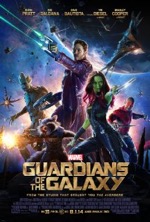
Starring: Chris Pratt
August 2014
This review was originally tweeted in Real-time from the back row of a movie theater and appears @BackRoweReviews. Though efforts were made to tease rather than ruin this movie’s memorable lines and moments, some spoilers may exist in the following evaluation. The original tweets appear in black, while follow-up comments appear in red. For concerns over objectionable content, please first refer to one of the many parental movie guide websites. All ratings are based on a four star system. Happy reading!

It’s called sarcasm, people.
Star Lord uses a rat microphone while jamming to his “Awesome Mix” on muddy Morag.
Maybe it’s just me, but even if I were a Star Lord, I still wouldn’t be handling a rat.
The group hug weapon is highly effective.
A different kind of group hug was used with great success by another band of misfit heroes in Mystery Men (1999).
Groot drinks his fill of fountain water.
Probably a lot cleaner than what he absorbs through his roots.
“Exclusively in that order.” Ha!
Boy, Groot really knows how to pick a nose.
“Asleep for the danger, awake for the money as usual.” Hilarious!
This statement is akin to Han’s deadpan criticism in Return of the Jedi, “Great, Chewie! Great! Always thinking with your stomach.” Correction: “Asleep for the action and awake for the money, as usual.”
Rocket was kidding about the mechanical leg. I haven’t laughed this hard in a movie in a long time.
This gag is the equivalent to the long con in a heist movie. The joke is set up well in advance of the punch line, which lands when least expected. What a payoff!
From warrior to imbecile in less than fifteen seconds.
The Ranger Rick reference is priceless.
I wonder what percentage of the audience even got this gag? Google it!
“Pelvic sorcery.” The jokes just keep coming.
Quill’s “losers” speech is moving if not necessarily motivational.
A nice spin on the word in question that trades on commonality to build solidarity among the group.
The ship net is a cool concept.
Until one part of the net is breached. That’s why Rom’s idea for self-replicating mines in DS9 was so ingenious.
Groot takes out an entire platoon of enemy soldiers with one branch and then grins. Classic!
This scene is similar to Kit Fisto’s smile directly at the camera in Star Wars: Episode II.
Quill gets a second chance to take his mom’s hand.
A touching scene that resolves the nagging guilt Quill’s experienced ever since he was a boy.
Final analysis: unquestionably the funniest superhero movie ever, and also one of the most original.
After watching the trailer, I knew this was going to be a humorous movie, but it’s far, far funnier than I originally anticipated. There were moments when I was literally bellowing and paid no mind to how such loud laughter would affect those around me. Of course, they were laughing just as loud, so no harm no foul.
A little overstuffed, but an effective blend of humor and action.
By overstuffed I mean the Dune-esque epic nature of the story that sees the characters hopping from one planet to the next and encountering myriad alien species along the way, all of them bent on obtaining the movie’s mysterious artifact. As someone who’s never read the comic book, it was a bit of a challenge keeping up with the who’s who element of the story.
Rating: 2 1/2 out of 4 stars. Let’s see what becomes of Groot’s root in the sequel.
While many sci-fi movies contain comedic elements, the genre label “sci-fi/comedy” can be attributed to very few films. Woody Allen’s Sleeper (1973) certainly qualifies, as does Mel Brooks’ Spaceballs (1987) along with the book-to-big screen The Hitchhiker’s Guide to the Galaxy (2005). Often, movies that try too hard to meld comedy into a sci-fi universe end up resulting in a goof-fest like The Ice Pirates (1984). So then, Guardians negotiates some difficult terrain as a sci-fi, superhero, action/adventure and comedy hybrid. Somehow, like a skilled juggler, the film manages to keep all of these balls in the air at the same time, which is fitting since the movie’s MacGuffin, a high-tech orb, is also up in the air (and up for grabs) for much of the movie. Whereas humor and action effectively hold the audience’s attention throughout, the relationships between the motley characters is the glue that holds the whole proceedings together. Chris Pratt imbues Peter Quill/Star Lord with irresistible charm and Zoe Saldana brings a disarming vulnerability to the chip-on-the-shoulder assassin Gamora. Dave Bautista is Drax, the laconic beefcake, Groot (voiced by Vin Diesel) is the good-natured tree creature and Rocket (voiced by Bradley Cooper) is the wisecracking raccoon. Each member of the team receives ample onscreen time, but character development is pretty thin except for Star Lord’s opening back story. The sacrifices made by Star Lord and Groot are genuinely touching—these character moments help to ground the more farcical and whimsical elements of the story. The formula here (distilled from many genre sources ranging from Star Wars to X-Men) seems to be a winning one, so a sequel seems all but assured at this point. Let’s just hope that future films in the franchise retain this movie’s lighter tone. So, until the sequel arrives, grab your walkman and jam out to your own awesome mix (punting rats is optional).
Lucy (R)
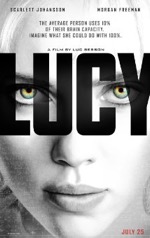
Starring: Scarlett Johansson
July 2014
This review was originally tweeted in Real-time from the back row of a movie theater and appears @BackRoweReviews. Though efforts were made to tease rather than ruin this movie’s memorable lines and moments, some spoilers may exist in the following evaluation. The original tweets appear in black, while follow-up comments appear in red. For concerns over objectionable content, please first refer to one of the many parental movie guide websites. All ratings are based on a four star system. Happy reading!

“Open your mind…open your mind!”
Wait, I thought this was Lucy, not Planet of the Apes.
Or 2001: A Space Odyssey (1968).
The crosscutting between humans and the animal kingdom is a clever conceit.
The National Geographic style nature scenes are a bit jarring at first, but they’re a unique way of depicting the primal side of humanity.
Immortality or reproduction. Why is it too much to ask for both?
Lucy dances on the ceiling.
Oh what a feeling.
Lucy mind-melds with her captor.
Why doesn’t she dispatch with him here and now? Ah, yes, because the villain needs to factor into the climactic showdown. Contrived!
The FX in the airplane bathroom are mind-blowing.
60%. The goons don’t stand a chance.
Maybe at 30% they’d stand a chance, but not at 60%.
A new generation of computer.
This one comes standard with tentacles.
Awesome retro time lapse effects...like watching “The Time Machine” in reverse.
The whole T-Rex thing was a bit staged, yes? I felt like I was in the 3D King Kong attraction at Universal Studios Hollywood.
Lucy meets Lucy.
Shouldn’t the universe implode at this point? Let’s ask Dr. Brown. He’ll know.
Final analysis: an intriguing premise that fails to live up to its groundbreaking promise.
Rating: 2 1/2 out of 4 stars. A thought-provoking sci-fi yarn with some amazing visual effects.
If the average human only uses roughly 10% of her brain, what capabilities would she possess if she could access 100% of her brain? An intriguing question…and a promising premise for this near future sci-fi actioner, which comes complete with all of the highly styled action sequences and pulse pounding chases we’ve come to expect from a movie directed by Luc Besson (The Fifth Element). Unfortunately, this high-concept story takes a radical left turn during the second half of the movie when a Limitless (2011) style cautionary tale morphs into a Transcendence-esque emergence event (the movie also has a heavy quotation of the 1960 version of The Time Machine). Using the above films as the ends of a spectrum, Lucy falls somewhere between Limitless, which is considerably better, and Transcendence, which is an awful mess that makes this film look like Inception (2010) by comparison (coincidentally, Lucy is the second so-so sci-fi yarn Freeman’s done this year…he also appeared in Transcendence). Ironically, just about the time Lucy starts to evolve the story begins to devolve…by the end, we’re left with a plot that’s been reduced to the consistency of a primordial soup, an image not lost on the movie. Aside from a head-scratching denouement (is that a 1 trillion GB flash drive?), the story line involving the Asian drug lord and his minions is extremely banal. Despite the enjoyment derived from watching Lucy surgically annihilating hoards of thugs, none of the fight scenes have any dramatic tension since the end result is a foregone conclusion—the multiple melees are tantamount to a group of Secret Service agents taking on a Jedi. However, if frenetic action scenes are the main motivation behind attending this movie, Lucy will serve its purpose…I suppose. In the end, the movie is a missed opportunity since its central conceit is so easily apprehended and universally applicable and a profound disappointment since its story is so formulaic and predictable. It really chafes that this could’ve been a great movie. Instead, Lucy is just a mildly intriguing action picture with A-list actors and a B grade story that required far less brain power to watch than it did to read this pedantic review.
Godzilla (PG-13)
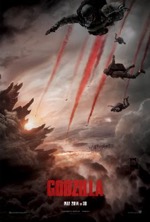
Starring: Aaron Taylor-Johnson
May 2014
This review was originally tweeted in Real-time from the back row of a movie theater and appears @BackRoweReviews. Though efforts were made to tease rather than ruin this movie’s memorable lines and moments, some spoilers may exist in the following evaluation. The original tweets appear in black, while follow-up comments appear in red. For concerns over objectionable content, please first refer to one of the many parental movie guide websites. All ratings are based on a four star system. Happy reading!

The redacted opening credits is a nice touch.
Should be “are” instead of “is.” Eh.
Not an earthquake...a pattern.
That last part is right up John Nash’s alley (reference A Beautiful Mind).
One last longing look through the circular window.
“My wife died here!” Superb acting from the man who brought Walter White to memorable life.
Unfortunately, and uncannily, the very instant Cranston exits stage right the film gets flushed down the crapper.
The old Godzilla mutated from radiation. This creature eats radiation. Consumes nuclear bombs whole.
Wouldn’t chewing on a bomb cause it to explode in the creature’s face though? Destroying it and everything else around it in an expansive circumference?
Terror in Vegas. The city will never be the same...the wages of sin.
Boy, I hope Wayne Newton got out okay.
Shine your flashlight right at the creature. Great idea.
These trained soldiers are no smarter than the kids in Jurassic Park when they shine their flashlight right into the T-Rex’ eyeball. Actually, the kids are smarter…at least Tim tries getting panicked Lex to turn off the flashlight. Trained soldiers should know better. Nitpick #1034 for this movie.
Why do action movies always pick on the Golden Gate Bridge?
X-Men: The Last Stand (2006) and Rise of the Planet of the Apes (2011) to name just two examples.
It’s raining fighter jets.
Multimillion dollar raindrops.
“If you don’t walk out, you don’t come back at all.” Sounds like dialog I would write...in the eighth grade.
The battle of the leviathans. Why do they always have to fight in a city?
This is an elemental contrivance in this brand of disaster picture. These gargantuan beasts would probably, instinctively, battle out in some vast open space rather than mix it up in close quarters with buildings constantly toppling down on them. Of course, such a battle wouldn’t contain any visceral thrills since no humans would be imperiled by such a colossal confrontation.
Why did Godzilla wait until after it got beaten into submission to use its laser breath?
The easy answer is that the writers needed to build some tension into the scene, and the only way to do that is to make it appear as if Godzilla might be defeated. Either that, or Godzilla is just toying around with his assailants.
Final analysis: maximum destruction with minimum plot. Serves its purpose if a disaster film is on the menu.
Although, there are far, far better films in this Thriller subgenre (disaster movie) to watch than this.
Rating: 2 out of 4 stars. Edges out Pacific Rim by that much. Needed some humor. Broderick could’ve helped.
It’s been sixteen years since the last American Godzilla (1998) premiered; the Japanese produced Godzilla 2000 was released, ironically, in 1999…and was awful. Many people, myself included, felt that the Matthew Broderick version, which featured baby Godzillas thrashing about like raptors from Jurassic Park (1993), had efficiently and effectively killed off the franchise…at least in the West. Although this film is a gigantic lizard leap ahead of the last Godzilla, it’s still riddled with outlandish monsters, dunderheaded strategies for stopping the creatures and a plot that’s consistently servile to the unrelenting barrage of action sequences. There are tons of things to find fault with and poke fun at in the movie, but ultimately, this movie is a squandered opportunity to tell a topical, salient story of how climate change can bring about our doom. The movie also had the chance to deal with the loss of a loved one and the restoration of a strained relationship between a father and son. All of these attempts at foregrounding genuine human emotion are abandoned after the first twenty minutes and then it’s back to business as usual with lumbering behemoths rampaging through our major cities just for the fun of it (and because it’ll serve as fodder for a top selling video game). In place of anything substantive, the movie resorts to the silly brand of monster melee that’s become the hallmark of every Godzilla movie to date. In truth, the only thing I like about this movie, other than Cranston’s presence…however brief, was the “against type” role the titular creature serves in the movie. I only spent $2 on the movie and still feel shortchanged. Watch at your own peril.
Snowpiercer (R)
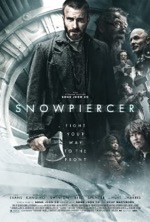
Starring: Chris Evans
June 2014
This review was originally tweeted in Real-time from the back row of a movie theater and appears @BackRoweReviews. Though efforts were made to tease rather than ruin this movie’s memorable lines and moments, some spoilers may exist in the following evaluation. The original tweets appear in black, while follow-up comments appear in red. For concerns over objectionable content, please first refer to one of the many parental movie guide websites. All ratings are based on a four star system. Happy reading!

Those protein blocks don’t look very appetizing...or edible.
Imagine having nothing but Jell-O to eat for the rest of your life.
Take the engine, take the world.
The precise quote is: “We control the engine, we control the world.” The first thing that popped into my mind when I heard this trite line was the slogan in TVs Heroes, “Save the cheerleader, save the world.”
Beware the woman with the yellow jacket and tape measure.
Now that’s one brutal form of torture.
And the most unique one I’ve seen in quite some time. A poet might term the sequence alarming and disarming. I’ll stick with brutal.
“Bullets are extinct.” A risky theory.
Evans puts his theory to the test in a startling display of machismo/foolhardiness. The film’s ultimate inciting incident.
The protein in the protein bars is disgusting.
Revolting, in fact. Just a heads-up in case you have a weak stomach.
Night vision melee is nail-bitingly intense.
The protracted battle brilliantly morphs in response to changing circumstances.
The club car gives a whole new meaning to soul train.
A startling confession while smoking the world’s last cigarette.
I pray that things never get so bad in our country that such an option becomes a viable one.
Wow, that was the mother of all derailments.
Final analysis: a bleak, claustrophobic dystopian yarn with much to say about the human condition.
On both ends of the spectrum: the honorable and the despicable.
Chris Evans has never been better and the supporting cast is stellar.
Evans’ physicality was a natural fit for the part, but he developed some dramatic chops here, far beyond what we saw in the Captain America movies.
The world inside the train is staggeringly immersive and the production design is nothing short of brilliant.
For your consideration: Art direction, cinematography, editing, sound editing/mixing, visual effects, etc.
Rating: 3 1/2 out of 4. Amid the myriad remakes & sequels, it’s refreshing to see an original work of sci-fi.
This film is based on the French graphic novel series Le Transperceneige and is directed by South Korean filmmaker Joon-ho Bong (Mother) in his English-language film debut. Bong also directed The Host (2006), which was a Godzilla-style action movie starring Song Kang-ho. With that antecedent in mind, it should come as no surprise that this film boasts highly stylized camera work along with intricately choreographed, furiously filmed and splatter-tastic action sequences. What really sets this film apart, however, is the story’s keen, yet understated, observations on the human condition…especially amid extreme or desperate circumstances. So what we have here is a movie that possesses what every blockbuster/sequel/remake aspires to have but can never obtain…poignant political/social commentary, moral ambiguity, character complexity and, above all, paradigm-shattering originality. The way the characters behave in relation to their status, station or surroundings, the narrative strictures imposed by the habitat’s physical, structural confinement and the furious pacing and trajectory of the story (both train and characters are always recklessly pushing forward) all commingle to forge an unforgettable cinematic experience. We can forgive the numerous gaps in logic (where does the inexhaustible supply of “protein” come from, why do the security guards operate with obstructed vision, why hasn’t the train ever crashed before and how will the human race continue with such a tiny remnant?) for the sake of the highly evocative, innovative and controversial (don’t recall seeing any cows on the train) story. Beyond the thought-provoking story and gratuitous yet gratifying action sequences, what makes this film so mesmerizing is its mélange of visual and narrative elements. This is the epitome of a transnational film: the story originated in France, the director is from South Korea and the movie was shot in the Czech Republic. Add to that diverse foundation actors from South Korea (Kang-ho), Britain (Jamie Bell, Tilda Swinton and John Hurt) and America (Chris Evans, Octavia Spencer and Ed Harris), and you truly have a melting pot of cultures, languages, styles and creative energies. You can call the film’s mood dark, dire and despondent; you can call its world bleak, bizarre and brutal; you can call the story a disturbing, cautionary, post-apocalyptic dystopia on wheels; you can even call it unsettling or confusing, but one thing you can’t call it is boring. How fitting that one of the most original movie titles that’s rolled along in quite some time is also one of the rarest cinematic visual feasts in recent memory.
Edge of Tomorrow (PG-13)
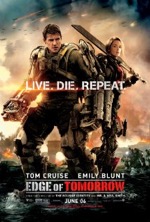
Starring: Tom Cruise
June 2014
This review was originally tweeted in Real-time from the back row of a movie theater and appears @BackRoweReviews. Though efforts were made to tease rather than ruin this movie’s memorable lines and moments, some spoilers may exist in the following evaluation. The original tweets appear in black, while follow-up comments appear in red. For concerns over objectionable content, please first refer to one of the many parental movie guide websites. All ratings are based on a four star system. Happy reading!

Sorry, couldn’t help myself.
A broad scale alien invasion. Didn’t we already see this in War of the Worlds...also starring Cruise?
Gleason orders Cruise to the beach...a second D-Day in France.
The motivation here seems a bit fuzzy. There must’ve been a more inventive way of forcing Cruise into the battle than this.
Paxton is from the foreign country Kentucky. Never heard of it.
Bill Paxton turns in a swaggering, southern fried role that’s truly unforgettable. His character has some of the best lines in the movie, although they do get tired after the second or third repetition.
Bowlegged troops invade the beach. You’d think they would’ve designed the suit with better ease of use.
Especially when considering how agile their enemy is.
Several Groundhog Day time loops and then Cruise is shown a “terrific presentation.”
Cruise wants to know if Blunt has “tried all options.” Humorous.
Actually, that would be the first option explored by any red-blooded male. Hey, the fate of the world is at stake, right?
Cruise on a motorcycle...the movie wouldn’t be complete without it.
Save for touching on the well-established Cruise trope, this scene was wholly unnecessary…and contrived.
The safety net is gone...now things are getting interesting.
In order for the story to kick into high gear this absolutely had to happen…and not a moment too soon since I was getting whiplash from repeatedly being yanked back to the beginning.
Must...swim...faster.
Final analysis: an original actioner that’s engaging despite its repetitious plot.
But hats off to the editing team. Piecing this film together must’ve required an entire pallet of Excedrin.
Not as entertaining as Oblivion, but still a decent yarn with some jaw-dropping action scenes.
Rating: 3 out of 4. If you disagree with my rating, don’t shoot me. Unlike Cruise, I can’t come back.
On the surface, the new Tom Cruise vehicle, Edge of Tomorrow, is a sci-fi/action riff on Groundhog Day (1993), the movie where Bill Murray wakes up every morning to the same song and the same day. This film is also reminiscent of ST:TNGs “Cause and Effect” which ended each act, save for the final one…of course, with the Enterprise exploding into scientifically impossible fiery bits in space. The crew discovers that they’re trapped inside a causality loop and that they’re doomed to keep repeating the same mistakes, which they do until the albino android figures out how to spring the ship from the temporal trap. In Edge, Cruise lives the same day over and over again and, like Murray’s character in Groundhog, finds that he can adapt, learn new skills and eventually figure a way out of the redundant riddle. It’s a deceptively simple premise, but beyond the trippy plot and mind-blowing FX, there’s a narrative depth here that one can sense more than readily identify. Clearly the film is engaging in a discourse on the nature of war, and the film’s release on the 70th anniversary of D-Day is far from coincidental. However, other social commentary is subtly broached here in a manner that’s nearly undetectable until it surfaces in the most startling fashion imaginable, much like the emergence of the movie’s maniacal Mimics. The obvious interpretation of the movie is that, like Inception (2010), the film is an attempt at creating a video game experience on the big screen (with gratitude to Henry Jenkins’ brilliant article on the subject entitled “No, You Do Not Have to Be a Gamer to Like Inception!”). Inception had multiple characters and levels, but Edge has one level with multiple lives that act as a reset button each time Cruise meets with an untimely demise. Although this is certainly a valid view of the movie, and don’t be surprised if you see blogs and articles written on the topic ad nauseam, I’d like to delve deeper into the movie’s multilayered mantle of meaning. Could it be that the movie holds up a mirror to our postmodern, post-911, post-economic meltdown society and projects back the anxieties and desperate exigencies of our lives? Cruise is a major in the army, but one day he wakes up to find that he’s a lowly private. In a similar reversal of fortunes, many in our country who once had white-collar jobs now have blue-collar jobs and have had to learn an entire new skill set in order to survive. We can sympathize with Cruise’s plight because we’ve all been affected, in one way or another, by the global economic recession. Many, like Cruise’s character, have fallen pretty far down the ladder from the once-powerful positions they enjoyed during the pre-recession period. In the same way that Cruise is trapped inside his repetitious nightmare, many people today are shackled by circumstances beyond their control and are prisoners inside their own lives. The drudgery of going to work, buying groceries and gas, paying bills and taxes, etc can feel like an unending cycle of sameness; a rote reality that’s really just an undiagnosed form of insanity. The movie’s poster is emblazoned with the slogan, “Live. Die. Repeat.” For many of our nation’s citizens, their life can be summed up as, “Wake up, go to work, come home, make supper, clean up, go to sleep, repeat.” So then, Cruise’s dogged insistence on reclaiming his autonomy and identity by breaking free from the seemingly preordained pattern of our existence should serve as a cathartic release for us…a powerful reminder that it’s possible to learn from our mistakes in the attempt at forging a better future. Director Doug Liman and his writers seem to be telling us that it’s tenable, with a good deal of ingenuity, dedication and sacrifice, to navigate through the treacherous terrain of our times and that the American Dream is still out there for those willing to fight like mad to attain it. In order to succeed, however, the assistance of others is required; even Cruise’s lone wolf character enlists the help of Rita (Emily Blunt) and Bill Paxton’s squad of elite soldiers during the movie’s climactic events. Cruise’s self-determination in spite of the impossibly rigid strictures of temporal mechanics also has much to say regarding rugged individualism versus the totalitarian state. This point could open up a whole discourse on the film’s politics, which I have neither the space nor inclination to address. Suffice it to say, the film invites multiple readings of its narrative, which makes it more complex and, therefore, more mentally stimulating than the standard action picture. In fact, the story is so involved that successive screenings are advised in order to fully appreciate the multifaceted plot and furiously filmed action sequences. How ironic, or insidious, that a film about a man stuck inside a time loop should invite repeat viewings. It’s almost as if Warner Bros. planned it that way.
Transcendence (PG-13)
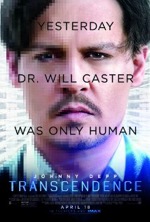
Starring: Johnny Depp
April 2014
This review was originally tweeted in Real-time from the back row of a movie theater and appears @BackRoweReviews. Though efforts were made to tease rather than ruin this movie’s memorable lines and moments, some spoilers may exist in the following evaluation. The original tweets appear in black, while follow-up comments appear in red. For concerns over objectionable content, please first refer to one of the many parental movie guide websites. All ratings are based on a four star system. Happy reading!

It sounded good at the time.
Bettany in a bleak Berkley. Narration decries the downside of technology.
Meaning its ability to take control of our society. Have we learned nothing from Skynet?
Castor wants to create his own god. Hmm... Something tells me that won’t end well.
His comment that all of science is the attempt at becoming God is revealing and somewhat ironic when considering what’s to come for his character in the movie. With statements like that is there any wonder why there’s such a huge rift between religion and science? Correction: Caster.
PINN is the new KIT, but with a lot more computational power.
And not housed inside a car. Minor detail. Correction: KITT.
Now those closest of Castor play God by trying to save his life.
And nobody, not even his wife, thinks this is a bad idea? This is what happens when people stop reading science fiction. Or reading period.
Depp looks creepy in electrode curlers.
But still not as creepy as his chalk complexioned character in Charlie and the Chocolate Factory (2005).
Why does Kate Mara always play a nut job?
Remember her turn as a psycho B on 24?
Castor tells his wife they need to get off the grid. Uh...he is the grid.
Ominous note: Run from this place.
Evelyn still doesn’t take Tagger’s hint. Maybe if he’d written, “Run for you life,” his message would’ve gotten across more clearly.
These guys heal quicker than Wolverine.
Nano rain. Now we’re drifting too close to #Revolution.
This sequence boasts some of the best FX in the movie.
Creepy townsfolk reminds me of Invasion of the Body Snatchers.
They’re really just zombies that look like normal people, which is exactly how zombies looked in 50s movies like the one listed above.
Final analysis: a standard cautionary tale of technology running amok.
Offers some food for thought, but it’s more like a light snack.
Rating: 2 out of 4 stars. Squanders its fine cast with farcical fare. Can you prove you’re self aware?
This movie is a profound disappointment. Longtime cinematographer for Christopher Nolan and first time director, Wally Pfister, drew the short straw on this project. Pfister frames a few nice shots in the movie (especially the rows of solar panels), but the movie’s ordinary, rundown and non-cinematic locales lend the whole proceedings a low budget look. The leaden script from Jack Paglen had no chance of becoming the edgy, poignant, mind trip the movie aspires to be…Inception it’s not. Besides being derivative of many other sci-fi works, The Terminator and ST:TNG’s “The Schizoid Man” among many possible choices, the story is so outlandish that suspending one’s disbelief still doesn’t help relegate it to the realm of reason…or reality. Depp’s performance is muted and uninspired: his slump continues and this just might prove to be his least successful movie ever. Morgan Freeman does the most he can with a cardboard character and Paul Bettany plays a scientist whose shifting motivations are contrived and disingenuous. Rebecca Hall, who turns in the movie’s most sincere and convincing performance, can’t quite sell us on her motivation behind preserving the essence of her husband. This story embodies the age-old axiom of absolute power corrupting absolutely but adds nothing new to the hackneyed formula. The movie flirts with having a message, but the execution of the anemic story line prevents any such notions from gaining traction. What’s unfortunate is that the story actually had the kernel of a compelling idea. Unfortunately, that kernel never turned into something white, fluffy and delicious. Instead, it resides at the bottom of your popcorn bucket with all the other old maids.
X-Men: Days of Future Past (PG-13)
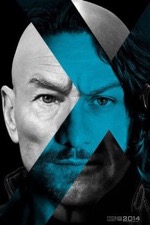
Starring: Patrick Stewart
May 2014
This review was originally tweeted in Real-time from the back row of a movie theater and appears @BackRoweReviews. Though efforts were made to tease rather than ruin this movie’s memorable lines and moments, some spoilers may exist in the following evaluation. The original tweets appear in black, while follow-up comments appear in red. For concerns over objectionable content, please first refer to one of the many parental movie guide websites. All ratings are based on a four star system. Happy reading!

Bleak dystopian intro presents a desolate landscape akin to the one in the #Terminator films.
The only thing missing is the metallic men with laser weapons.
Intense opening battle. Wouldn’t want to run into one of the Sentinels in a dark alley.
Speaking of metallic assailants, the Sentinels are truly fear-inspiring, not only in how they appear and move, but in their ability to assimilate mutant abilities. Are we witnessing the birth of the Borg?
Wolvie is transported back to 1973. Is transported through a lava lamp and wakes up on a waterbed.
Groovy!
School’s out, the professor’s sauced and a big, bad, blue wolf is on the loose.
That’s the mother of all JFK conspiracy theories.
“It’s cool, but it’s disgusting.” True, bone claws aren’t nearly as sleek as metal ones.
Whip...lash! Cool visual.
Quicksilver’s run around the room is reminiscent of the Hammy’s sprint in #OverTheHedge.
Although this sort of thing has been done before, especially with the alacritous red clad lad from the DC stable of heroes, this is the most creative and exciting sequence in the entire movie. However, I can see why director Bryan Singer chose to sit this mutant on a couch during the final climactic sequence: Quicksilver’s special ability would’ve swiftly undone every villainous act committed by Magneto and would’ve robbed Mystique’s fateful decision of any urgency and dramatic value.
“Looks can be deceiving.” Truer words have never been spoken...by Mystique.
Beast Hulks out and Logan is stricken by amnesia.
Trask wants Mystique for “research purposes.” Sure!
Charles mindmelds with Logan. The finger placement is a little off.
Correction: mind-meld. I should know better. Speaking of…
Nice ST:TOS episode clip from “Tomorrow is Yesterday.” Another time travel story.
It always pains me to admit when I’m incorrect on this particular subject, but the episode in question is “The Naked Time,” which I originally surmised and then second-guessed myself on. Both episodes use the shipboard chronometer located to the right of Sulu’s station, and I selected “Yesterday” because the Enterprise returns to Earth circa 1969, in a similar manner to Wolverine returning to 1973 in this movie. Based on that plot similarity, “Yesterday” actually would’ve made a stronger allusion since the ship merely skips back in time three days (seventy-one hours to be precise) in “Naked.” In my defense, there’s very little to go off of in these clips (a planet would’ve given it away in two seconds flat) and some segments seem to have been repeated. Apology and apologetics aside, it’s quite ingenious how Singer wove this ancillary, yet pertinent, tidbit into the tapestry of the film. Mise-en-scene at its finest.
Charles uses a Jedi mind trick to get through security.
Just figured I’d provide equal opportunity to the other major sci-fi universe.
Magneto turns a stadium into a mother ship.
This is the only story element in the movie that seems contrived to me. Since Magneto can pull metal from anywhere to create a barricade, absconding with an entire stadium seems a bit excessive. It’s a giant set piece that seems more appropriate for an old style Batman movie, and just seems unnecessary for the story at hand.
Wolvie attacked by rebar snakes.
A very visceral visual.
Logan wakes up to the Golden Oldies. There and back again.
Even Cyclops wears #Oakley shades.
Other than the gray in Halle Berry’s hair, it’s remarkable how little this cast has aged since their first film together back in 2000.
Final analysis: a decent time travel yarn without too many cheesy comic book clichés.
Rating: 3 out of 4 stars. Next up in the Marvel-verse: #GuardiansOfTheGalaxy.
Mixing older and younger versions of the same characters in one movie is an exciting premise, but also a risky one. Part of the movie’s appeal is seeing older and younger selves interact with each other, as in the case of Charles Xavier (Patrick Stewart and James McAvoy). The constant threat of the Sentinels, the bracing time travel story line and the novelty of the 70s trappings all make for a unique comic-to-cinema tale. Featuring fan favorite Wolverine (Hugh Jackman) as the focal point and linchpin of the plot was a wise choice—this is Jackman’s seventh appearance as Wolvie. Perhaps it has something to do with her Oscar, but Jennifer Lawrence, aka Raven/Mystique, has been given more to do in this movie than in the previous one…I don’t know many teenage boys who are disappointed by that fact. Peter Dinklage is terrific as Trask, an opportunist who misguidedly thinks he’s furnishing the world with the security it desperately needs. If the movie has a weak link, it’s a story that’s so preoccupied with the impending extinction of mutantkind that it’s really a rather joyless affair. Quicksilver (Evan Peters) adds some levity during his five minutes of screen time, but the balance of the movie is an earnest, glum exercise in entropy. The movie is thought provoking at times, pulse pounding at others, but is it truly enjoyable? In the end, it’s just nice seeing all of our old and new friends together in one film, although some are little more than set dressing. So how does this latest film measure up to earlier efforts? It’s the best X-Men film since X2 (2003). However, for the next sequel I recommend lightening it up a bit. Since Jackman and Marsden can sing, how about a few musical numbers? X-Men: The Musical. Stick a pin in it.
Captain America: The Winter Soldier (PG-13)
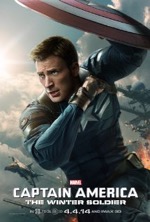
Starring: Chris Evans
April 2014
This review was originally tweeted in Real-time from the back row of a movie theater and appears @BackRoweReviews. Though efforts were made to tease rather than ruin this movie’s memorable lines and moments, some spoilers may exist in the following evaluation. The original tweets appear in black, while follow-up comments appear in red. For concerns over objectionable content, please first refer to one of the many parental movie guide websites. All ratings are based on a four star system. Happy reading!

“On your left.” Ha!
That kind of speed, and endurance, would definitely come in handy at times.
Triskelion equals S.H.I.E.L.D. headquarters. Also a planet in the original Star Trek.
“The Gamesters of Triskelion” is the title. A largely forgettable second season show save for Angelique Pettyjohn’s tinfoil bikini.
Capt. America argues with Fury over freedom vs. fear.
This is a very incisive, and topical, discussion…a rarity among superhero movies.
The Sundance Kid moderates the Jedi council.
I kept looking for Yoda among the holograms.
Fury’s SUV gets a police sandwich.
I want to know the make and model of Fury’s vehicle, because it sure takes a pounding…yet keeps tearing down the street.
The elevator’s getting a little full.
A honeymoon in...New Jersey?
Hopefully not Bayonne.
First kiss since 1945?
The Winter Soldier’s rifle really packs a punch.
One of the coolest visuals in the movie.
“I am so fired!” Stan Lee sighting.
His brief cameos just keep getting better with each successive Marvel movie. Eat your heart out, Hitchcock.
“Captain’s orders.” Let the civil war begin.
Final analysis: a surprisingly airtight plot...
...that doesn’t allow the action scenes to run away with the movie.
Rating: 3 out of 4 stars. Next up: “Bucky’s Revenge.”
A marked improvement over the first film, The Winter Soldier features a taut plot, a rather ingenious conspiracy and a terribly mysterious antagonist, who, much more than a mere caricature of a villain, actually strikes fear into the heart…there are several moments when it looks like our hero might be defeated by the shrouded assailant. However, when the villain’s secret identity is finally revealed, it’s a bit of a letdown...comic junkies (who know far more about the character’s back story than I do) will have a different opinion, I’m sure. The movie is salient in the way it wrestles with the realities of the postmodern world, such as: corporate corruption, terrorism and rampant surveillance. This film is more down-to-earth than most of the other superhero movies released over the past decade, but it looses its artistic edge by trying to be too realistic. A main contributor to this is the utter lack of anything “super” in the movie. Most of the technology on display in the film isn’t that much more advanced than what governmental agencies use today. Also, and more significantly, the entire film takes place in D.C.—no globetrotting, no exotic locales and no extraterrestrial environments in this movie. Some would argue that the everyday nature of the story is what makes it compelling, and I can’t argue with that. However, the look and feel of the movie is essentially an episode of Heroes with a blockbuster budget. Despite the solid story and serviceable performances, there isn’t much to marvel at here.
Divergent (PG-13)
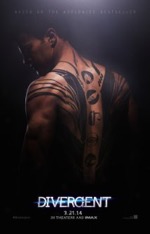
Starring: Shailene Woodley
March 2014
This review was originally tweeted in Real-time from the back row of a movie theater and appears @BackRoweReviews. Though efforts were made to tease rather than ruin this movie’s memorable lines and moments, some spoilers may exist in the following evaluation. The original tweets appear in black, while follow-up comments appear in red. For concerns over objectionable content, please first refer to one of the many parental movie guide websites. All ratings are based on a four star system. Happy reading!

Opening narration effectively sets up the particulars of this dystopian world.
It’s a CliffsNotes version in case you haven’t read the book.
Clever use of mirrors in the choosing ceremony. A nice embellishment to the book.
Director Neil Burger maximizes the mirror motif, which is a very keen choice since such reflective surfaces are considered the height of vanity by those belonging to the Abnegation nation.
Guess I’d be factionless in this world...I could never cut my hand with a knife.
Just watching others slice into their own flesh makes me faint. Can you tell I’d never hack it in Dauntless?
Who will be the first to jump into the black hole?
“What makes you think you can talk to me?” Snap!
Tris gets off a nice retort, though.
Mosh pit initiation is fitting for Dauntless.
Crowd surfing in a cafeteria seems wholly appropriate for this faction. Can’t see it happening at Hogwarts though.
First jumper versus last jumper to fight in the ring. Short bought.
Training tips from Four followed by a brutal cliffhanger.
Jai Courtney (A Good Day to Die Hard) was the perfect casting decision for Eric, the movie’s loathsome antagonist.
Neuro stim darts. Very cool. Let the games begin.
“Pull the break!” What a rush that would be.
Attack of the crows...didn’t we already see this in a Hitchcock movie?
Entering someone else’s fear landscape...double the terror.
Four shows off his tats during his tryst with Tris.
Does a scene get any more gratuitous than this? Still, we’ve gotta’ give all the teenage girls what they paid for, right?
Let the drone war begin.
Not clone war, because we’ve already had one of those in a galaxy far, far away.
“A beauty we can’t afford.” Socialism at its finest, folks.
Nice twist with Winslet. Different than the book. Clever resolution.
Final analysis: faithful to the book with minor additions/deletions.
A twist on Brave New World and The Hunger Games, Divergent is a cautionary tale about a society gone wrong.
However well-intentioned the formation of the factions was, none of them (except for Amity because, by golly, they just don’t know any better) are currently operating within the parameters of their proposed purpose. Dauntless have become too brutal, Erudite too manipulative, Candor too honest and Abnegation too powerful. The original intention for the expressed function of each faction has been taken to an unhealthy extreme. Just goes to prove that no matter how altruistic a societal structure or governing system is when it’s established, people will always find a way to frack it up. Pardon my Galactican.
Rating: 3 out of 4 stars. A decent dystopian yarn with adequate action and suspense. Next up: Insurgent.
The similarly themed The Hunger Games series was the exception to the rule that says you can’t do a point by point narrative reconstruction when adapting a book to the big screen. Adhering to the written page served those movies extremely well, with kudos going to Suzanne Collins for the strength of her source material. Divergent, to its own detriment, is the rule rather than the exception. Though there are minor alterations between book and movie, and despite the fact that the book series was written readymade for a big screen trilogy, the book didn’t translate as well to the film in this instance. Perhaps it’s that too much screen time is spent on Dauntless training and testing (and that too much time is spent in Dauntless territory). Perhaps the military overthrow and subsequent containment of the coup seems far too sudden and too cause and effect in its treatment. Perhaps the deaths of Will, mom and dad all come too quickly in succession for believability and for maximum impact. I mean, at least Luke had appropriate breathers in between the deaths of his aunt and uncle, Ben and Biggs in Star Wars. Perhaps it all boils down to the tried and true adage that the book is always better than the movie. Whatever the reason, here’s hoping the sequel will do a better job of visualizing Roth’s words onscreen. As is, the movie is a diverting tween-centric, near future thrill ride. However, it could’ve been, like its hero, a unique force of nature.
RoboCop (PG-13)
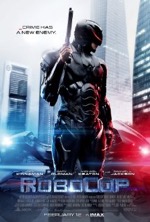
Starring: Joel Kinnaman
February 2014
This review was originally tweeted in Real-time from the back row of a movie theater and appears @BackRoweReviews. Though efforts were made to tease rather than ruin this movie’s memorable lines and moments, some spoilers may exist in the following evaluation. The original tweets appear in black, while follow-up comments appear in red. For concerns over objectionable content, please first refer to one of the many parental movie guide websites. All ratings are based on a four star system. Happy reading!

Cylons patrolling the streets in Tehran. Peace through superior firepower.
An ironic, and in this instance fitting, quote from ST:TNG’s “The Arsenal of Freedom.”
Do the robots factor in collateral damage?
Robophobia. Ha!
“What do these machines feel?”
Robo’s first step...gotta’ love those mechanical servo sounds.
There’s a metal man in my rice paddy.
The pumping lungs are pretty well unsettling.
For some reason this scene is far more disturbing than the myriad people blown to bits in the movie.
Old Batman and new Commissioner Gordon argue over Robo’s effectiveness.
Cylons vs. Tin Man...who will win?
“The illusion of free will.” Hmm...
If there’s any complexity to the story, this is it. An interesting argument when applied to media’s power over the consumer.
Maybe they should’ve uploaded the criminal database after the media circus.
Reconstruction of the accident sequence is awesome.
Warehouse shooting is like a video game.
Which is already on its way to your local game store, I’m sure.
“Bad cop, RoboCop.”
Getting a bit cutesy now.
Robo vs. the AT-STs. A flurry of bullets.
You just knew this scene was coming. It’s a smoother sequence with CGI, but there’s something charming about the old, clunky stop motion FX in the original.
Final analysis: far better than I expected for a remake. Appropriately updates the story.
Oldman holds the whole thing together and Jackson’s opinion TV show is entertaining and topical.
If not heavy-handed in the way it lampoons a particular political slant.
Rating: 2 1/2 out of 4 stars. Has some heart and a decent plot, but something’s missing here.
This is a valiant attempt at updating the 80s classic with modern technology and trappings, but it’s ultimately an effort that falls flat. Hollywood has always been sequel happy, but was remaking Robocop (1987), which hasn’t aged very well, a solid choice for a sequel? Aside from the nostalgia factor, is this story even that compelling? The movie reveals acts of terror abroad and at home and I suppose it’s cathartic to see a good guy with the power to defeat evildoers, but a superhero movie could’ve just as easily fulfilled such a need. Is this premise too silly for the more sophisticated modern viewer? Everything in its time I suppose, but hasn’t Robocop’s time already passed? Box office returns will reveal all.
Her (R)
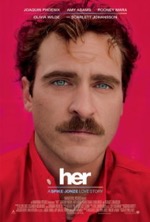
Starring: Joaquin Phoenix
January 2014
This review was originally tweeted in Real-time from the back row of a movie theater and appears @BackRoweReviews. Though efforts were made to tease rather than ruin this movie’s memorable lines and moments, some spoilers may exist in the following evaluation. The original tweets appear in black, while follow-up comments appear in red. For concerns over objectionable content, please first refer to one of the many parental movie guide websites. All ratings are based on a four star system. Happy reading!

“Choke me with the dead cat.” Okay we just took a wide left turn.
OS1. We’re not that far away from this technology folks. Frightening possibilities.
Even the name sounds probable for this hypothetical technology.
Mini Stay Puft man in the video game has a potty mouth.
“I’d like a slice of cheese please.” A computer that knows what you want to eat.
But can it always account for mood or a finicky palate?
Samantha hints that she might be exceeding her programming. Fascinating!
Maybe she’ll magically appear as Seven of Nine.
Ingenious use of fade to black. The morning after...awkward.
“The past is just a story we tell ourselves.”
Beta test for a computer game...Phoenix looses many “mommy points.”
He still does far better than I would.
Phoenix is afflicted by a “socially acceptable form of insanity.”
Signing the papers...one of the most heart-rending experiences imaginable.
Been there, done that…have the emotional scars to prove it.
A surrogate. This is so strange. It’s true what they say...three’s a crowd.
Samantha is experiencing growing pains. Disturbing implications.
“Are you in love with anyone else?” Always a dangerous question to ask.
Final analysis: one of the most astounding examinations of the human condition ever to grace the big screen.
Jonze’s prescient, near-future tale juxtaposes our need for love with our growing sense of isolation.
Prescient is the perfect word to describe this film. Jonze has captured the zeitgeist of where our society and technology will be 5 to 10 years from now. His vision here is past the cutting edge…truly astonishing.
The world Jonze creates is staggeringly real and downright frightening in its implications for our future.
And yet, hope remains as long as we don’t loose connection with each other...as we witness in the final scene.
Rating: 4 out of 4. Profound beyond description, Her is a truly moving experience. Now I’ll take out my earpiece.
I have little to add to the above statements, so at the sake of compounding compliments or stockpiling superlatives, I’ll keep this wrap-up short. The one caveat I offer is that this is an extremely graphic (sexually) movie, so precautions should be taken if such content is deemed inappropriate for potential viewers. That said, a more profound film concerning the nature of love, belonging, sex, heartache and loneliness you’ll be hard-pressed to find.
The Hunger Games: Catching Fire (PG-13)
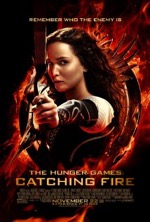
Starring: Jennifer Lawrence
November 2013
This review was originally tweeted in Real-time from the back row of a movie theater and appears @BackRoweReviews. Though efforts were made to tease rather than ruin this movie’s memorable lines and moments, some spoilers may exist in the following evaluation. The original tweets appear in black, while follow-up comments appear in red. For concerns over objectionable content, please first refer to one of the many parental movie guide websites. All ratings are based on a four star system. Happy reading!

Katniss is definitely one person I wouldn’t sneak up behind...especially if her bow & arrow were in hand.
That would be a quick way to spring a leak.
It’s snowing outside with Snow inside. “Convince me,” the prez says.
Stubborn and good with a bow...an accurate characterization of Katniss.
Peeta goes off script. A touching moment.
The occupation of District 12. Dark times ahead.
I pray that things never get so bad that this happens in our country.
Hoffman proposes a “wrinkle” for the Quarter Quell, and it’s a big one.
Finnick offers Katniss a sugar cube. Maybe if he’d offered chocolate he would’ve gotten a better result.
Mags teaches Katniss how to make a fishhook. Soon after, Katniss gives a clinic in archery.
Good scenes that play out much as they did in the book.
The mockingjay dress is quite a spectacle.
Is it scientifically feasible though?
Let the games begin.
A furious commencement to the competition here, just like in the book. But this cornucopia is surrounded by a noticeably different environment than the one in the first Games.
Hoffman orders a cannon prepared for Peeta’s apparent demise.
Haymich sends a spile...a refreshing gift.
A morphling’s sacrifice. What does it portend?
Attack of the jabberjays. Hitchcock would be proud.
Funny how Katniss never runs out of arrows or that they never spill out of her quiver.
The revolution begins. On their way to District 13 in time for the next movie.
Final analysis: excellent adaptation of Suzanne Collins’ superb second novel in The Hunger Games series.
And just like the Harry Potter and Twilight series, Collins’ final book, Mockingjay, will be adapted into two movies.
Excellent directing by Francis Lawrence (I Am Legend), and pitch perfect acting all around.
The film maximizes on all of the major events & emotional moments in the book while adding some new twists.
Rating: 3 1/2 out of 4 stars. Deeper and darker than the first film. Has set the stage for a rousing finale.
Some have boldly averred that this sequel is The Empire Strikes Back of The Hunger Games series. Although far too loft an assertion, Catching Fire is a darker and deeper than the first film. A superb sequel that capitalizes on the solid groundwork established in the first film, the sequel lives up to its name by raising the stakes and tossing its characters into the crucible of political turmoil and civil unrest…and into yet another arena where even more slayings occur. The movie diligently follows Collins’ novel, which seemed to come readymade for the big screen, and who’s to say it wasn’t written with an eye toward a potential cinematic blockbuster. This is one instance where strict adherence to the source material was the wisest choice possible. If I were a big shot at Lionsgate, I’d rush the two remaining films into production immediately to ensure actor Lawrence’s continued involvement with the series. Something tells me that with all the Oscar attention Lawrence has been garnering lately projects like The Hunger Games will soon be a thing of the past for this emerging A-list actress.
Ender's Game (PG-13)
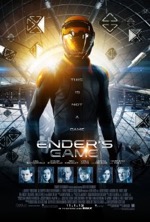
Starring: Harrison Ford
November 2013
This review was originally tweeted in Real-time from the back row of a movie theater and appears @BackRoweReviews. Though efforts were made to tease rather than ruin this movie’s memorable lines and moments, some spoilers may exist in the following evaluation. The original tweets appear in black, while follow-up comments appear in red. For concerns over objectionable content, please first refer to one of the many parental movie guide websites. All ratings are based on a four star system. Happy reading!

Been waiting a long time for this one. Earnestly praying that it lives up to Card’s amazing novel.
Amazing and award winning: Hugo and Nebula…the two highest honors in science fiction writing. Yes, the novel is that good! Possibly the finest example of military sci-fi ever written.
“This won’t hurt a bit.” Famous last words.
Don’t mess with Ender. The bullied becomes the bully.
Caesar, Napoleon...Ender?
Dap, the drill sergeant, is perfect.
“Your mother cheated, that’s why you look like a plumber.” Ha!
It’s been a lifelong ambition of mine to possess the ability to deliver, in the spur of the moment, a cut down this good.
Practice session in the battle room. Nice sequence.
Ender promoted to the army of misfit soldiers.
Bonzo is a bozo.
This kid is a great actor, though…Moises Arias. He played the memorable goof in The Kings of Summer earlier this year.
Lots of shots of characters peering through windows.
A visual motif that echoes John Ford’s use of doorways in The Searchers (1956).
Graduation day. The final simulation.
“Stay calm...shoot straight.” A nice T-shirt saying.
“The way we win matters.” What a line and what a scene.
Final analysis: a faithful adaptation of Card’s novel with gorgeous visuals and top-notch production values.
Rating: 3 1/2 out of 4 stars. For all of its action, the movie broaches some heavy-hitting ethical issues.
Though some will compare this movie to Robert Heinlein’s Starship Troopers (the book, not the campy 1997 movie directed by Paul Verhoeven), the connective tissue between both stories is fairly tenuous beyond a couple major themes and tropes. The acting is superb here and the training exercises and space battle sequences are utterly spellbinding. Universal themes of courage, teamwork and the meaning of honor are effectively woven into a narrative tapestry that somehow manages to cohere despite its surfeit of action sequences; certainly a breath of fresh air from most action oriented blockbusters these days, which consistently suffer from anemic screenplays. Exhilarated that Card’s superlative military sci-fi novel has been realized on the big screen at long last and relieved that director Gavin Hood didn’t mishandle such ingenious source material, I hope the author is as proud of this effort as I am.
Gravity (PG-13)
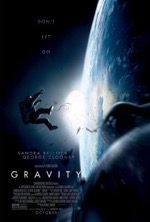
Starring: Sandra Bullock
October 2013
This review was originally tweeted in Real-time from the back row of a movie theater and appears @BackRoweReviews. Though efforts were made to tease rather than ruin this movie’s memorable lines and moments, some spoilers may exist in the following evaluation. The original tweets appear in black, while follow-up comments appear in red. For concerns over objectionable content, please first refer to one of the many parental movie guide websites. All ratings are based on a four star system. Happy reading!

Previews are still running...the optimal time to take a Dramamine. Gonna’ be a bumpy ride.
“Can’t beat the view.” No kidding.
Why doesn’t Bullock have a thruster pack? Not as big of a star as Clooney?
Guess NASA can only afford one…government cutbacks and all.
Marvin the Martian sighting.
A great inside gag.
Don’t know that I’d be sharing my life story with 2% oxygen remaining.
Consider this a nitpick. Although, silence wouldn’t serve the story very well, would it? I mean, Cast Away (2000) in space probably wouldn’t have sold too many tickets.
Why doesn’t Clooney climb over Bullock to safety?
You can apologize for any accidental groping once safely back inside the station.
Fetal position in zero G. Artistic shot.
Should’ve ejected the chute first.
Hindsight is 20/20. However, Bullock is a highly trained astronaut and should know better, emotions notwithstanding.
Soyuz out of gas...time to get out and push.
Princess Leah might volunteer for that job.
Brilliant use of fire extinguisher.
Bullock must’ve seen WALL-E (2008).
Final analysis: should’ve named it Oxygen since the characters and audience are gasping for air all movie.
Rating: 3 out of 4 stars. Visually breathtaking and intense from start to finish.
Immaculately realized by director Alfonso Cuaron and brilliantly framed by cinematographer Emmanuel Lubezki, this is a gorgeous film. Even in 2D the film is so immersive that you actually feel like you’re in outer space. Though some of the film’s science is dodgy, it’s really the film’s visual splendor that makes it an unforgettable cinematic experience. Bullock and Clooney turn in decent performances, but the real star of the film is that gigantic blue globe hovering in space. At movie’s end, when Bullock defiantly, triumphantly drags herself out of the water and stands fully erect on the beach in a low angle shot, do you get the sense that Cuaron is attempting to show the culmination, indeed evolution, of Kubrick’s chimps in 2001: A Space Odyssey (1968)? Or maybe it’s merely a beautifully framed shot.
The World's End (R)
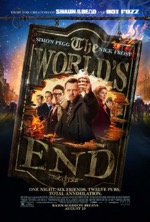
Starring: Simon Pegg
August 2013
This review was originally tweeted in Real-time from the back row of a movie theater and appears @BackRoweReviews. Though efforts were made to tease rather than ruin this movie’s memorable lines and moments, some spoilers may exist in the following evaluation. The original tweets appear in black, while follow-up comments appear in red. For concerns over objectionable content, please first refer to one of the many parental movie guide websites. All ratings are based on a four star system. Happy reading!

Hopefully this will be less offensive than the other recent apocalyptic film, This Is the End.
Though both movies share a similar title, this effort is more creative and less offensive than Rogan’s raunch-fest.
Pegg’s opening narration ends in an unexpected location.
Reunion of pals and a road trip in the Beast.
This wouldn’t officially be a buddy movie without a road trip.
Pegg’s rapid-fire speech to the motel attendant is hilarious.
Wonder how many takes it took.
First stop on the golden mile. A toast to kids wherever they may be.
Mum calling...oops.
Busted!
Fisticuffs in the bathroom. A whole new meaning to blue bloods.
Live on stage: The Marmalade Sandwich.
Truly a snicker worthy band name.
Scars and memories...the things that make us human.
In Cars 2 it was dents. Same dif.
Giant modern art statue is reminiscent of Gort.
The plaque must read: “Klaatu Barada Nikto.”
Final analysis: borrows liberally from The Day the Earth Stood Still and Invasion of the Body Snatchers.
Not nearly as good as Hot Fuzz or Shaun of the Dead. Also, what a strange ending.
Rating: 2 1/2 out of 4 stars. The slow start and strange finish detract from this marginally amusing tale.
Although the movie coaxes occasional chortles from its audience, classifying it as a comedy would be a bit of a stretch. The whole affair feels low budget and the otherworldly twists in these Pegg penned movies are becoming predictable and pedantic…and pedestrian. The simple premise makes for an uncomplicated movie but also a largely unconvincing one. Still the movie is just interesting enough to divert its audience for a couple hours. But maybe that kind of mindless diversion is all part of their master plan.
Elysium (R)
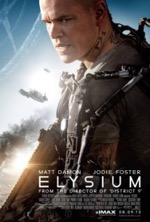
Starring: Matt Damon
August 2013
This review was originally tweeted in Real-time from the back row of a movie theater and appears @BackRoweReviews. Though efforts were made to tease rather than ruin this movie’s memorable lines and moments, some spoilers may exist in the following evaluation. The original tweets appear in black, while follow-up comments appear in red. For concerns over objectionable content, please first refer to one of the many parental movie guide websites. All ratings are based on a four star system. Happy reading!

Space station looks like it was borrowed from Kubrick’s 2001.
Vow made by boy and girl is similar to the one made at the beginning of Pixar’s Up.
Parole officer reminds me of Total Recall’s Johnny Cab.
Shuttles with invalid access codes...I’m having a Return of the Jedi flashback.
Wow, four movie references in a row. I was on a roll.
“Extraction!” Damon’s had better days at work.
Meeting with Spider—Damon gets Borgified.
Foster’s accent is more annoying than Bale’s gravelly Batman speech.
It’s painfully put on…so obviously not her normal mode of speech.
Damon uses pigs as a blanket.
“The hippo wants a friend.” A touching scene.
Facial reconstruction...like a Spielberg effect in reverse.
Final analysis: engaging dystopian yarn that falls short of District 9 despite topical themes and stark realism.
District 9 was also directed by Neill Blomkamp and starred Sharlto Copley, who plays the antagonist here.
Rating: 2 1/2 out of 4 stars. Mildly disappointing, but still a decent popcorn flick.
There are some gorgeous visuals in this film, especially those involving the titular space station. The Brave New World contrast between classes is pertinent as we continue to see the dissolution of the middle class in our society. The near-future world created by Blomkamp here is astounding, spring-boarding off the success of his similarly themed and styled District 9. Damon is solid, but understated in the film and everyone else is just kinda’ there…playing their parts exactly as you’d expect them to be played. For all of the unbridled, unqualified genius exhibited onscreen, the movie is largely unmoving. Sadly, there’s very little movie magic here…which is disappointing since this film appeared to have incredible potential to become a dystopian masterpiece.
R.I.P.D. (PG-13)
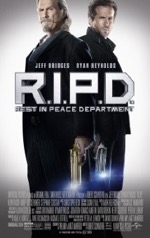
Starring: Ryan Reynolds
July 2013
This review was originally tweeted in Real-time from the back row of a movie theater and appears @BackRoweReviews. Though efforts were made to tease rather than ruin this movie’s memorable lines and moments, some spoilers may exist in the following evaluation. The original tweets appear in black, while follow-up comments appear in red. For concerns over objectionable content, please first refer to one of the many parental movie guide websites. All ratings are based on a four star system. Happy reading!

Reynolds is double-crossed by his A-list partner.
Mary Louise Parker as St. Peter? She’s in two new releases this week...impressive.
Parker also appears in Red 2.
Indian food sure does bring out the monster in some people.
Reynolds’ old partner can traverse realities? Color me interested.
Eternal affairs...clever.
A singularity forming over a city...didn’t we see this in last summer’s The Avengers?
“She billygoated me.” Eww!
Final analysis: a unique concept that isn’t exploited to maximum effect.
In fact, the premise is dumbed down for maximum commercial appeal.
Thematically and conceptually similar to the Men in Black films.
Bridges steals the show as the Custer-esque, chaw-mouthed veteran who shows Reynolds the ropes. A truly unique role.
The way he sits sidesaddle in the patrol car is a nice character touch.
Rating: 2 1/2 out of 4 stars. A sequel is almost certainly assured.
I remember laughing out loud when seeing the trailer for this film, thinking “now here’s a clever conceit.” The germ of that conceit—the premise—is the only part of the film that works. As with most Hollywood productions today, it’s poor execution and cursory character development that render this movie a pale reflection of what it could’ve been in more skillful and creative hands. And, also like too many Hollywood films today, R.I.P.D. is far too vulgar and vapid for its own good. Though Universal Studios will work hard to find a way to resurrect this sad effort into a sequel, this DOA plot should be left six feet under. RIP R.I.P.D.
Pacific Rim (PG-13)
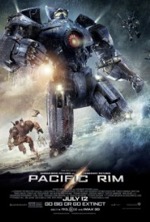
Starring: Steve Carell
July 2013
This review was originally tweeted in Real-time from the back row of a movie theater and appears @BackRoweReviews. Though efforts were made to tease rather than ruin this movie’s memorable lines and moments, some spoilers may exist in the following evaluation. The original tweets appear in black, while follow-up comments appear in red. For concerns over objectionable content, please first refer to one of the many parental movie guide websites. All ratings are based on a four star system. Happy reading!

…with a microscopic plot.
Despite being a fan of del Toro’s earlier films, I’m dubious about this one.
A Transformers vs. Godzilla premise seems anemic and the trailer looks too similar to last year’s Battleship.
In the end, this film might be a hairsbreadth better than Battleship. But that still isn’t saying much.
Jäger bot appears as a giant Ironman.
Correction: Iron Man.
Face-off over a fishing boat.
Whoever wins, I’m pretty sure the boat will lose.
“Wall of Life” is one of the daftest security measures ever conceived.
Why do the creatures attack cities? The entire population of a metropolis would only make one good meal?
Scientist “drifts” with a creature. The key to our survival?
A BSG rip-off...digital vs. analog technology.
In the pilot film of Battlestar Galactica (2003) that sold the show to Sy-fy, Cylons hack into the computers aboard the Colonial Vipers and immobilize them. To stem the tide of the invasion, the colonists must pull the old, pre-computer Vipers out of mothballs in order to repel the Cylon advance.
Didn’t we just see the mass destruction of a city in Man of Steel?
Pearlman becomes baby’s first meal.
“Today we are canceling the apocalypse.” One of the most stilted lines I’ve heard in some time.
An awful line that made me grimace even when I first heard it in the trailer.
Elba’s entire speech is a cheap imitation of Aragorn’s in The Return of the King.
Wind sound effects underwater?
Well, I guess as long as we have explosions in outer space…
Final analysis: have we finally reached the threshold for the scale of a big budget film?
My fondest wish.
FX are amazing, especially underwater, but the story and characterizations are razor thin.
Rating: 2 out of 4 stars, which is generous for this significantly flawed creature feature.
It’s hard to know where to start with this one. This movie is a profound disappointment owing largely to the fact that del Toro is such an accomplished director with a brilliant sci-fi/fantasy/horror imagination. Very little of that imagination is evident here in what amounts to a contrived action first/story last near future monster vs. technology movie. Character development is flaccid and the dialog is downright abysmal. There isn’t a single aspect of this movie that’s compelling (save for the evocative title which is wasted on this mediocre affair). The movie is just an egregious waste of money and resources…and, worst of all, the audience’s time. The story earns 1 star and the FX garners 3 stars, so a rating of 2, which still seems too high, is fair I suppose.
After Earth (PG-13)
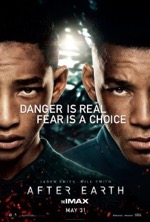
Starring: Jaden Smith
May 2013
This review was originally tweeted in Real-time from the back row of a movie theater and appears @BackRoweReviews. Though efforts were made to tease rather than ruin this movie’s memorable lines and moments, some spoilers may exist in the following evaluation. The original tweets appear in black, while follow-up comments appear in red. For concerns over objectionable content, please first refer to one of the many parental movie guide websites. All ratings are based on a four star system. Happy reading!

Use of sails in the interior decorating is a nice visual motif.
Roll up iPad is amazing! I want one. Now.
This technology is like 5-10 years away, right?
Skydive scene is a thrill ride. A literal and figurative high point for the movie so far.
Unfortunately the story follows the same trajectory and speed as Jaden’s skydive, but is never able to pull up.
Nifty flight suit. Condorman would be envious.
Jaden is cutlass-less. Not good.
Jaden’s new assignment: climb to the top of Mt. Doom.
Straightforward survival story with decent adventure & a nice father/son subplot just in time for Father’s Day.
Rating: 2 ½ out of 4 stars. Next up: Man of Steel. Stay classy!
Although this film isn’t earth-shattering, it deserved a better fate than what it received. I’m not sure if it’s because the movie came too soon on the heels of Oblivion (another dystopian yarn), or if the survival story looked too tepid (and it is in many instances), or if audiences wanted to see more of elder Smith in the movie, or if news that Shyamalan helmed the project outright tanked it, but the stars definitely didn’t line up for this film. One of the poorest performing movies of Will Smith’s career, one wonders if he sacrificed too much to establish his son as a top billed movie star.
Star Trek Into Darkness (PG-13)
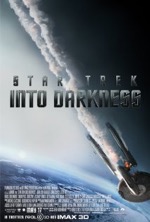
Starring: Chris Pine
May 2013
This review was originally tweeted in Real-time from the back row of a movie theater and appears @BackRoweReviews. Though efforts were made to tease rather than ruin this movie’s memorable lines and moments, some spoilers may exist in the following evaluation. The original tweets appear in black, while follow-up comments appear in red. For concerns over objectionable content, please first refer to one of the many parental movie guide websites. All ratings are based on a four star system. Happy reading!

Red trees...finally an alien-looking planet!
I first saw these trees in the trailer and was blown away by the striking visual of their vermillion branches and leaves against white trunks. What captivated me most as a fan of TOS was the “new life and new civilizations” part of the opening monolog. Unfortunately, we’ve had so many Earth-like climates/habitats in Sci-fi movies and TV shows that the same old desert, arctic, water, forest, jungle, etc., environments have become commonplace and stale. This world feels appropriately otherworldly and has brought back the thrill of deep space exploration that was so palpable in TOS.
Crossing universes...Spock appears to be on Mustafar.
What would Spock do? A good revelation.
WWSD? I wouldn’t want Spock’s cold logic deciding my fate.
Nice stand-alone mission with mud-skinned aliens. Reminds me of a TOS episode.
Nice pork chops, Pike. The 70s called and they want their sideburns back.
“You don’t respect the chair.” Great line and scene with Pike.
Bruce Greenwood is the elder statesman in the new Trek films. Pike possesses a dignity and decorum sorely lacking in the impetuous Kirk, whom he’s taken under his wing. Greenwood’s performance has really grounded Abrams’ first two Trek’s in profound ways.
80s action stars never die...they become Starfleet admirals.
Section 31. Any DS9 fans out there?
The Mudd Incident. Another TOS reference. Sulu tough as nails.
McCoy’s metaphors...funny scene.
This tweet comes before the previous one chronologically. Couldn’t think fast enough.
Exciting firefight with marauders and mystery combatant.
Superb stare down between Kirk and Harrison.
The tension here is palpable...two really good actors in a showdown. Superb dialog in this pivotal scene.
Red alert...gratuitous underwear scene.
Awesome Gorn reference. Torpedo planet looks like it’s on loan from Ridey Scott’s Prometheus.
Dr. McCoy is such a Southern gentleman. Not sure I’d be such a gentleman if I were all alone on a planet with Carol Marcus (Alice Eve).
Notice the shape of the scrap on Kirk’s cheek bone.
The first of many instances of Manly Thumbs vs. Tiny Keypad. Score 1 for the keypad. “Scrap” should be “scrape.”
Admiral Robo’s ship looks like it comes from TNG.
Scotty’s sprint and debris field, good stuff.
My favorite movie line of the year is when Scotty tells Kirk to give him a minute. Impeccable delivery!
Pair o Spock’s redux. Pivotal scene.
It’s always nice to see an old friend.
“Shall we begin?” Not nearly as good as “Go ahead, make my day,” but It’ll do.
Ah, that voice! Just reading the words and I can hear Cumberbatch’s rich baritone voice echoing in my head.
Finally...seatbelts on the Enterprise.
It only took what...48 years?
For film studies buffs, notice the use of plexiglass in crucial scenes throughout.
Plexiglass or transparent aluminum?
A tribble saves the day!
Ah, the fistfight we’ve been waiting for all movie.
5 year mission. Does that mean a new TV show? Wishful thinking, I’m sure.
Rating: 3 out of 4. Same as last one. Perhaps a tad better due to Cumberbatch’s performance. Next up...After Earth with Will Smith.
Final Thoughts/Parting Shots: Okay, there’s so much to say, good and bad, in an analysis of this film, but I don’t want to ramble on like I did for J.J’s first Trek. First off, it’s very sad to say goodbye to one of our heroes in this film. The admiral’s presence will be sorely missed in future Treks. Most of the FX are stellar, but the matte shot of the Klingon moon (Praxis?) is a bit dicey. Some nitpicks: Is it really that short of a warp journey to get from Kronos to Earth (the Enterprise only travels at warp speed for a few minutes before Adm. Marcus’ ship blasts the Enterprise out of warp, depositing it near the moon)? If so, such proximity to the enemy home world would be worrisome… for both galactic superpowers, one would presume. Next, is Earth’s gravitational pull so great that it could draw the Enterprise all the way from the moon into its atmosphere? Seems a bit implausible. I could go on and on regarding the movie’s inconsistencies (like the can of Regulan bloodworms that was opened up by the subplot involving Khan’s “fountain of youth” blood), but I’ll refrain. My biggest snafu is revealing Harrison as Khan. Why is it necessary? Is Harrison any less compelling a villain, as played by Cumberbatch, than Khan? Since there’s so little back story and character development for the villain wouldn’t he work as either Harrison or Khan? And if so, doesn’t that mean the decision to make the villain Khan a contrived one? A gimmick to boost ratings? Some may see this choice as a way of introducing a new generation to the colorful TOS antagonist, but others might see it as needlessly tampering with a classic villain. Speaking of Cumberbatch as Khan, I must admit that I’m not as blown away by his performance as I thought I’d be (I know, I’m probably the only person on the planet who feels this way). One needs look no further than Sherlock to see just how brilliant and commanding an actor Cumberbatch is. Here, due to limited screen time and an underdeveloped character, the actor is effective but a far cry from phenomenal. Again, I might be alone in this assertion, but I feel like Abrams could’ve gotten more out of Cumberbatch…that there was an extra gear the actor could’ve shifted into to make his performance even more memorable. Be that as it may, Into Darkness is a fine follow-up to 2009’s Star Trek, and has expanded the series and taken it into appropriately darker territory. Bring on the next film…Star Trek To the Light Side. Lens flares included.
Prometheus (R)
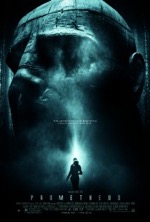
Starring: Noomi Rapace
June 2012
The opening sequence of Ridley Scott’s highly anticipated Alien prequel, Prometheus, is, perhaps, the most startlingly original teaser in the history of sci-fi films. An albino humanoid stands near a mountain stream, drinks some strange viscous concoction and begins retching. The sequence simultaneously begs a host of questions. Who is this strange-looking alien? Where does he come from? Is he on Earth of the distant past or future or some planet that looks just like the Scottish Highlands? And just what exactly is that disgusting grog the guy drinks (bad Romulan Ale)?
These questions are just the tip of the proverbial iceberg in an intentionally murky movie that will probably leave many audience members feeling lost. It seems fitting, then, that one of the film’s script writers is Damon Lindelof, co-creator of TVs critically acclaimed Lost, which was also a mythology heavy, mind-bending slice of top shelf sci-fi. Ironically, Prometheus’ opening sequence is a microcosm of the entire film: beautifully crafted and filmed, yet frustratingly cryptic.
By now, the Alien universe has been so well established (themes, iconography, etc.) that innovation is hard to come by. Many of the film’s new elements work just fine, but old patterns are hard to break and creep in as if on cue. Case in point, no Alien movie would be complete without a decapitated android and here that bill is filled by Michael Fassbender’s eerily serene David, who pops his top late in the film. A narrative mainstay in many Alien films is the lead female being impregnated by an alien; in this instance the hapless heroine is Noomi Rapace’s Elizabeth Shaw. Here, Shaw uses laser scalpels and other hi-tech medical instruments to abort the alien fetus from her own distended belly…easily the most creep-tastic sequence in the film, doubly so for men I’ll wager.
Another cliché: dumb characters don’t stand a chance when the bloodletting begins. Not only are these engineers more doltish than the typical scientists, they can’t regulate the impulse to touch items that can potentially destroy them once inside the alien structure—even when the impending danger is clearly pointed out to them they’re still powerless to resist handling foreign objects. I guess scientists and engineers will always be kids in a candy store whenever alien artifacts and technology are present.
When it becomes obvious after the initial round of introductions which person will be the first victim you know your story is a tad too predictable, and Prometheus certainly doesn’t break that mold. Sad thing is, we really don’t care when these ancillary characters die because, as with Star Trek’s “redshirts,” we don’t know the first thing about them…they’re disposable to us and the story. If there hasn’t been any investment in character development, why should we care if they die? We don’t, and that’s the point.
If there’s one area of the narrative that invites scathing criticism it’s the frequent trips to the alien fortress. After loosing all of their engineers on their first foray, what would induce the remaining characters to go back for a repeat visit? Curiosity? Stupidity? Pressure from the filmmaker who only has half a film at this point and needs a higher body count to earn an R rating? But they do go back, again and again...like lambs to the slaughter. And people keep dying. At some point you’d think the characters would figure out that the alien haystack isn’t the Matterhorn ride at Disneyland.
Worse than the frequent trips to the alien slaughterhouse is that we’re taken along for the ride each time and always from a low angle perspective of the tire rim or a helicopter shot of the motorcade approaching the alien structure. These exterior shots leave us feeling cold, effectively on the outside looking in. Why didn’t Scott utilize these segues to give us some good-natured banter among characters or little glimpses into the back stories of these individuals, a la the Humvee scene early in Iron Man (2008)? As is, these ping-pong ventures between the ship and alien fortress are squandered opportunities to shore up one of the film’s most sorely lacking commodities—character development.
Although the climactic ship collision/crash is visually spectacular, the resulting nonsense of characters trying to get out of its path could’ve been trimmed from the film with little consequence. It’s one thing if you’re Indiana Jones trying to outrun a steamrolling ball of death down a narrow tunnel, but it’s something entirely different if a ship is falling in your direction and you’re in the middle of an expansive plain. This type of imperilment is common in movies and I always end up asking myself, do characters not realize they can run to one side or the other to avoid what’s rolling/moving straight toward them? Why must they run in a straight line in an effort to outrun the object of impending danger? It must be plain idiocy and an utter lack of knowledge regarding the laws of physics and gravity that drives these characters’ actions. Even more egregious is the amount of screen time dedicated to this ostensibly thrilling sequence which fails to advance the plot in any significant way. The entire sequence is nothing more than a self-indulgent excuse to employ a massive set piece in order to generate a shallow thrill for the audience, something Michael Bay would normally do, not Ridley Scott.
In the final analysis, Prometheus will only be admired by those who enjoy a hard sci-fi yarn that grapples with the questions of existence, but ultimately fails to answer those questions in the end. Action junkies will be disappointed in the film as will those who’ve come to expect a certain amount of intensity and gore from the franchise. Though Scott’s original Alien (1979) did far more with a lot less, Prometheus is still a handsomely mounted, visually staggering film. As an art film under the guise of a commercial release Prometheus may, well…alienate a large portion of its audience.
Rating: 2 1/2
The Hunger Games (PG-13)
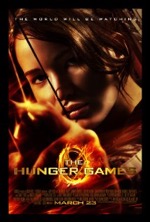
Starring: Jennifer Lawrence
March 2012
Based on Suzanne Collins’ wildly popular teen novel trilogy and directed by Gary Ross, (Seabiscuit), The Hunger Games is one of the most highly anticipated films of the year, superheroes notwithstanding. Starring Jennifer Lawrence (Winter’s Bone) and bolstered by a dazzling array of supporting talent nearly as scintillating as the dress Katniss (Lawrence) wears during the opening ceremonies of the Games, the film posits a disconcerting dystopian “what if.” What if two teenage tributes from each of twelve districts competed, to the death, in order to secure glory for the victor and more importantly, a lifetime of comfort and security for the winner’s family? Oh, and most alarmingly, the events of the game are broadcast live on Panem’s version of television for the viewing pleasure of the masses. Profits are earned from ratings and/or wagers placed on contestants. Consider it a reality show taken to the most unethical and macabre extents imaginable. But not to worry, if the global economic recession continues intensifying the way it has over the last few years, our own version of the Hunger Games will be airing on network TV this upcoming fall. Check your local listings.
The narrative love child of Lord of the Flies and The Most Dangerous Game, The Hunger Games is a highly entertaining, yet deeply disturbing, cautionary tale. The film’s most insidious and controversial attribute is its uncanny ability to coax its audience into reveling in the systematic slaughter of teens. An underlying thesis in many of Alfred Hitchcock’s movies is that all film spectatorship is inherently voyeuristic (Hitch takes this notion to its furthest extreme in his 1954 masterwork, Rear Window). If such a theory is true, then the wholesale massacre that ensues during this film’s action passages makes the audience complicit in its atrocities. To decry the teen violence in the film is one thing (which begs the question of why such protesting individuals are watching this film in the first place), but what if these scenes of imperilment and mutilation are actually enjoyable to a certain segment of the audience? Does that automatically make them psychopaths? Is it wrong to cheer when the “good” teens triumph over the “bad” teens? I mean, it’s one thing to watch adults poking holes in other adults (or aliens, robots, etc) with bullets, knives or laser beams, but it’s something entirely different to showcase teenagers slaying one another. Such is the moral minefield inherent in this seemingly straightforward survival story. But at the end of the day (or film) it’s all just entertainment, right?
The first twenty minutes of The Hunger Games contains more complexity than the entire Twilight saga. Even though both trilogies were written for a teenage readership, Collins’ The Hunger Games deals with weighty ethical and societal issues, while Stephenie Meyer’s Twilight books focus on teen angst, a love triangle and an ancient struggle between vampires and werewolves. Both movies open with a deer being stalked in the forest but the two story lines quickly and radically diverge from that point.
The dystopian mood and aesthetic is evident throughout the film, but is nowhere more apparent than in the city sequences…let’s face it, a forest is a forest, whether it’s the one just beyond District 12 or the CG forest created for the Games inside a dome, a la Star Trek’s holodeck. The soldiers employed for crowd control in District 12 during the reaping, adorned in white uniforms with white bike helmets, recall any number of futuristic enforcers, like the ones seen in THX 1138 (1971) and Soylent Green (1973). And is it my imagination or do these peacekeepers bear more than just a passing resemblance to the white clad imperial lackeys featured in Spaceballs (1987)?
The role of the command center that controls the conditions of the Games has been expanded in the movie and looks like a mix between an Apple store and the interactive virtual displays used by Tom Cruise in Minority Report (2002). Other than a modernized train, outlandish clothing, hair and makeup styles, some modern architecture and a nighttime cityscape, there’s little evidence to indicate that these people live in a futuristic, or post-apocalyptic, society. Credit the producers for minimizing costly exterior city shots and making extensive use of interiors and forest exteriors.
Director Ross hews closely to the source material; in fact, it could be argued that save for a few stylistic and narrative tweaks the movie has an almost slavish adherence to the book. In the majority of instances where this occurs a film will suffer greatly in the adaptation from book to screen but here, because Collins’ story is so rich and textured, the film actually benefits by sticking to what works. “If it ain’t broke, don’t fix it,” seems to be the overriding philosophy of the filmmaker. It’s hard to argue with the result.
In the book, much of the narrative is driven by Katniss’ internal musings and there are long passages where her thoughts and actions, without a single word of spoken dialog, move the story along toward its fateful climax. One of my major concerns with the adaptation from book to screenplay was that those personal thoughts and feelings would be lost unless a cheesy internal monolog was employed. Would we be able to discern, merely from actions or facial expressions, what was going on in Katniss’ mind? As it turns out, my fears were unfounded.
Much of the credit here goes to Ross, his cameraman and sound editor who brilliantly foreground Katniss’ thoughts and feelings with well considered, highly stylized shots. Case in point: after Katniss blows up a stockpile of food, the concussion from the blast knocks her into a state of disorientation. In the book, Katniss worries to herself that she may have gone deaf in one ear. In the movie, this fear is realized with muffled audio, a lens sliding in and out of focus and an extremely shaky Steadicam. These stylized shots are used with the utmost discretion so as not to overplay the effect. In less skillful hands, many of Katniss’ characterizations would’ve been lost in translation, but fortunately Ross and Co. deftly display Katniss’ thoughts onscreen.
All things considered, this is one of those rare instances where the movie is comparable in quality to the book upon which it’s based. The stage is set for a frenzied, fantastical franchise. Whether or not the sequels live up to this inaugural installment of Collins’ trilogy remains to be seen, but either way, this film has left me hungry for more.
Rating: 3
Journey 2: The Mysterious Island (PG)
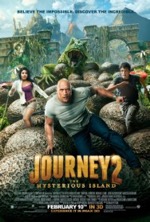
Starring: Josh Hutcherson
February 2012
The follow-up to Brendan Fraser’s Journey to the Center of the Earth (2008), Journey 2: The Mysterious Island extends the franchise which delves into the mythology, creatures and worlds of wonder created by early sci-fi writer Jules Verne. This time around, however, Fraser is out and Dwayne “The Rock” Johnson is in. Josh Hutcherson returns as young adventurer Sean Anderson. Sean’s friction with step-dad Johnson comprises most of the film’s character moments along with the handful of scenes Sean shares with his long-lost grandfather (Michael Caine), his new crush (Vanessa Hudgens) and her father, the skittish pilot (Luis Guzman). Rounding out the cast is Kristin Davis in an itty-bitty bit part as Sean’s mother.
From the title you would assume that the film would be based on Verne’s book of the same name, but you would only be 1/3 accurate. The movie’s narrative is ostensibly based on three literary classics: Verne’s Mysterious Island, Jonathan Swift’s Gulliver’s Travels and Robert Louis Stevenson’s Treasure Island. The common denominator of each tale (besides rip-roaring, old-tyme adventure) is the prominent showcasing of an island as the central locale. Averring that the island in each of these classics is one and the same is a clever and bold conceit, one that keeps the plot wheels steadily churning along through muddy musings and soft-core familial strife in the movie’s early goings.
However, the mash-up premise is quickly jettisoned just about the time Guzman steers his wing-and-a-prayer chopper into, not away from, a violently swirling waterspout. In all fairness, we do get to see a miniature pachyderm a la the Lilliputians as well as Captain Nemo’s Nautilus, but where does the movie borrow from Treasure Island…a gold-spewing volcano? More to the point, what if screenwriters Brian and Mark Gunn (no relation to Ben I’m sure) had capitalized on the original premise by weaving a tapestry rife with allusions and events from the three books instead of merely teasing the concept?
As a quote unquote family film, the movie tries to make object lessons out of wrong choices made by the characters, particularly Guzman’s greedy, gold-luster—he’s drawn to the mountain of gold like a giant bird to a giant bee (oops, one paragraph too early to use that analogy). The story also makes occasional, most often feeble, attempts at foregrounding modern parenting. Guzman wants to send his daughter to college so he goes in search of a bolder-sized gold nugget…with the way inflation is escalating, he might need two. Johnson desperately tires to connect with Hutcherson, but the best advice he can offer the teen is to woo young hotties with Johnson’s patented “pec pop.” Consider this scene the film’s nadir.
The zenith of the film, despite its utter absurdity, is the rapturous flight of the bumblebee’s sequence. The story really takes flight when the adventurers ride giant bees like airborne steeds, and the action kicks into high gear when the bees are stalked by even bigger birds of prey. Honorable mention goes to the sequences involving the sleek (but too small?) Nautilus, although restarting the engines with the charge from an electric eel is a bit farfetched even by this movie’s whimsical standards.
Where the acting is concerned, a more eclectic cast you’re not likely to find and they all turn in serviceable, if not award-winning, performances. Even though all of Johnson’s roles aren’t exactly the same he plays them all as such. On some future film the director will figure out that it’s more cost effective to replace Johnson with a cardboard standup of the actor with looped lines…the result would be no different than his performance here or in any of his other films.
Although the inestimable Caine never misfires, his character, as written, isn’t as enjoyable as would be expected. In fact, it’s hard to remember a Caine character that’s this unlikeable…he needlessly bickers with Johnson’s character and the constant cavalcade of condescension is off-putting. I certainly don’t fault the actor; I fault the Gunn’s for failing to give his character any redeeming characteristics.
In the end, though no better or worse than its predecessor, Journey 2 squandered a golden opportunity to creatively integrate exciting elements from the three literary classics it references into its yarn. Instead, the story defaults to simply serving up a reheated version of last summer’s action flick. Maybe for the next film, the writers can emphasize a solid plot with fleshed-out characters over SFX and action sequences…in other words, the polar opposite of this Journey.
Rating: 2 1/2
Chronicle (PG-13)
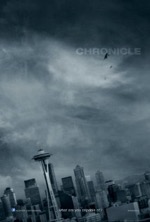
Starring: Dane DeHaan
February 2012
So here we have The Blair Witch Project (1999) meets Cloverfield (2008) meets TVs Heroes (2006-2010) meets every teen angst movie ever made. Shot almost entirely from the POV of the main character on his camcorder, Chronicle centers on a group of high school guys who discover an alien ship buried beneath a field. The result of their exposure to the alien technology is that they begin exhibiting superpowers which, of course, is a recipe for disaster since we’re dealing with horny, hot-headed teenage males.
One of the lads in particular, upon coming to the realization that he’s now an apex predator, starts committing random acts of mayhem…because he can. In the end, the only person who can stop him is his best friend. A city-smashing melee ensues, which recalls the climactic battle between the titular hero and his three nemeses in Superman II (1980), and the results are predictably tragic.
No one can say that this film isn’t a valiant attempt at creating a new sensation, but it rides on the coattails of many similarly themed efforts like the ones listed above. Additionally, there are undeniable shades of Shakespeare here and even allusions to Star Trek—the original series’ pilot saw Captain Kirk killing his megalomaniacal best friend, Gary Mitchell, in order to save his crew and the universe as we know it.
In the final analysis, Chronicle is a unique hand-held project that tells a decent story and is mildly diverting, if not earth-shattering. Maybe Chronicle II will provide some variety by cutting shots taken by two camera-wielding students.
Rating: 2 1/2
In Time (PG-13)
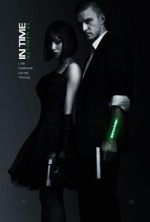
Starring: Justin Timberlake
October 2011
TAKING AIM:
In Time, the trippy techno-thriller from director Andrew Niccol, features futuristic twists on ripped-from-headlines issues like the global recession and the evaporation of the middle class. The film features an intriguing “what if” scenario which taps into universal anxieties, such as growing old and living in the moment amid increasing socio-economic uncertainties. Oh, and don’t look now, but Justin Timberlake is the male lead. Yep, you heard right…Timberlake has earned leading man cred, but should he abandon his day job…er other job, just yet?
TARGET PRACTICE:
In a World…: Where time is the currency, many must die so that a few might have immortality. But we weren’t meant to live forever, as Amanda Seyfried’s affluent Sylvia Weis asserts in a tone so earnest that we almost miss the line’s stilted edge. The movie’s premise, which feels like yet another Philip K. Dick adaptation, is harrowingly cautionary yet easily digestible…we learn the rules of the game quickly. Unfortunately, the metaphor of time as currency looses its novelty after the first hour, just about the time meaningful dialogue or character moments are replaced by shootouts and car chases.
An Investment in Time: Let’s face it, movies are an investment in time (and let’s not forget money…as if we could with today’s exorbitant ticket costs). For poor films we often hear people say “I wish I could get those two hours of my life back.” While the employment of such a line is oh so tempting for a film like In Time, I honestly don’t feel like it would be a fair assessment of the film’s high concept premise, however heavy-handed and unwieldy it becomes by the end.
Borrowed Plots: In the film’s mildly-dystopian future, individuals running out of time must beg, borrow or steal time in order to survive. In a similar practice, Niccol (who serves as writer and director) has liberally lifted story elements from other literary or cinematic sources. Aside from time bandits being called minutemen, the most obvious antecedent here is Aldous Huxley’s eerily prescient 1932 novel Brave New World. In Huxley’s near-future society, individuals are assigned to castes based on genetically engineered abilities or proclivities. Here, the class system is purely based on time: those who have it and those who don’t, those who use it wisely and those who waste it. The movie depicts time zones, which clearly demarcate those who have very little time left in their life, those who have an adequate amount of time left and those who are “time rich.” Another literary touchstone is Victor Hugo’s Les Miserables (1862). Cillian Murphy plays a futuristic cop (dubbed “time keeper”) hell-bent on apprehending the movie’s stars and exhibits more than just a few of the characteristics inherent in the intractable Inspector Javert. As heavily pursued fugitives, Seyfried and Timberlake are a type of Bonnie and Clyde, but these two actors are a far cry from the superlative Warren Beatty and Faye Dunaway, who played Bonnie and Clyde in the landmark 1967 film of the same name. A more obscure source of inspiration for the film can be traced to Nickelback’s 2007 music video for their song “Savin’ Me.” In the video, the balance of a person’s lifespan appears overhead and the main character in the video saves people from falling pianos, etc. He knows a person’s life is about to expire when he sees that their life counter is nearly depleted. A virtually identical system is employed in this film as characters can glance at the inside of their forearm to get an up-to-the-second balance of their life account.
Stepford Society: Early in the film we learn that the near-future humans are genetically engineered to stop aging at twenty-five. Most people would view that arrangement as ideal and highly desirable. On the downside, however, such altered individuals only live to age twenty-six. This plot element is obviously another thinly veiled attempt at making social commentary; this time the eternal quest to look and stay young is called into question. I suppose Botox and nip/tuck will eventually give way to genetic alterations on a grand scale, but why do members of the film’s futuristic society die at twenty-six (barring a risky venture to obtain more time)? Could it be that the plot needed an artificial deadline in order to produce urgency…especially when characters see the last few precious seconds of their life ticking away? And who says twenty-five is the ideal age? Isn’t that a bit, well…ageist? Ultimately, a world where Olivia Wilde is your mother and Amanda Seyfried is your girlfriend may seem perfect, at least on the surface, but isn’t it just a little creepy—much like the enhanced women in The Stepford Wives (1975, 2004), which serves as yet another filmic precursor to this movie?
The Need to Fix Things: In TVs Lost, Dr. Jack Shepherd (Matthew Fox) has the co-dependent compulsion to fix everyone and everything around him. Screenwriters, especially those who write sci-fi films it seems, have the same need to reconcile societal dysfunctions or imbalances by movie’s end. A recent example of this is Bruce Willis’ Surrogates (2009), which features a society where humans live out their lives through android surrogates (again, it’s a cosmetically perfect society since androids never age). The moral dilemma of whether or not to preserve such a perfect, yet shallow, culture falls to Willis, who makes the fateful choice to reset society to its original, flawed status. Here, the inference is that the two leads have determined to change the corrupted system when they resolutely march up the steps of a government building in the movie’s final scene (as if changing nationwide policies could be that simple.) The movie seems to imply that a coup will set everything right…a frightening notion for our current society, despite its pervasive governmental corruption and economic turmoil. So why do writers/producers feel the need to resolve these cautionary tales with touchy-feely endings? Do they think it will result in more butts in seats? Didn’t work out too well for Surrogates, did it? I assure you, a film can be just as compelling by depicting some dark dystopia, plopping some characters into the middle of the mess and allowing them wrestle with the exigencies of life in such a disparate landscape…and then leave them there. Ridley Scott did it successfully in a little film called Blade Runner (1982). Seems to me it’s been pretty well-received over the years. Note to Hollywood: “You don’t have to fix everything.”
PARTING SHOTS:
Tough thought-provoking, the movie’s extended metaphor is overdetermined, especially in the opulent time zone (do the “time rich” dole out their precious time to “time poor” charities?). The movie comes close to making poignant commentary, like the dangers of wasting time for example, but the message fails to penetrate the barrier of contrived story devices and heavy-handed homilies on societal ills. When the premise starts to wear thin, Niccol defaults to a series of action sequences to move the film toward its inevitable, predictable conclusion, since he really has nothing else to fall back on. In Time is a big disappointment because it had something to say but got in its own way. It’s a shame, but in the end the movie prevented itself from having any lasting impact. Only you can determine whether or not the film is worth your time, but for my money it’s only worth about two dollars of yours.
Rating: 2 1/2
Rise of the Planet of the Apes (PG-13)
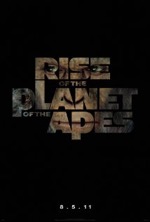
Starring: James Franco
August 2011
TAKING AIM:
The seventh movie in the outlandish sci-fi series is more down-to-earth than its forebears, but is more commonplace and less spectacular as a result of its contemporary plot and settings. An origin story of the decades-spanning furry franchise, Rise of the Planet of the Apes is intended as a series reboot, much like Batman Begins (2005) was for Christopher Nolan’s modern tales of the Caped Crusader. Although the film flirts with a message, something along the lines of not harming animals or how unethical scientists create monsters, it ends up as an irrelevant tale coupled with uninspired direction and largely unremarkable performances, which leads us to…
TARGET PRACTICE:
Let’s Be Frank About Franco: James Franco is serviceable in the lead role, but takes a back seat in nearly every scene he shares with Caesar, the story’s focal point and top ape. Franco’s performance is understated, which is appropriate to the role, but he doesn’t bring anything special to the part of a scientist with a conscience grappling with an ethical dilemma. As such, Franco’s presence and performance are serviceable, but not necessarily memorable. Let’s be frank, Franco has always been a fairly flat actor who works well in an ensemble but really isn’t leading man material, which this film amply proves.
Lithgow Finds Another Furry Friend: John Lithgow just can’t seem to get away from furry animals in his more fantasy themed films. It’s been an eternity (1987) since Lithgow befriended an amiable Sasquatch in Harry and the Hendersons (he had a little more hair back then too). Here, Lithgow gloms onto Ceasar who becomes a therapeutic presence in the life of his character, an Alzheimer’s sufferer. Lithgow’s performance is finely tuned and subtly executed—his swings of lucidity aren’t nearly as dramatic as many other Alzheimer’s portrayals in film, which is refreshing to see. I guess it should come as no surprise that Lithgow could so successfully pull off such a role, but it is confirmation of what we’ve known about the versatile actor for years…he’s got quite a range (I mean, compare his character here to the one he played for six years on TV in 3rd Rock from the Sun). Lithgow’s greatest contribution to the plot is his sometimes quirky, sometimes profound advice to his screen son, Franco. As a foil and voice of reason, Lithgow’s interactions with Franco help to ground a movie rife with fantastic notions. Lithgow provides a major assist to Franco, whose often uninspiring performance needed plenty of support.
Solid Support: Brian Cox walks a fine line between dictatorial overseer at an animal control center and outright villain. We dislike him because he’s deceptive and, ironically due to his choice of professions, because he doesn’t seem to care one whit about animals. But, at the end of the day, Cox’s character just does his job and goes home—presumably to avoid the wholesale destruction of the last half hour of the movie. Cox is certainly an antagonist in the film, but he fails to measure up to bona fide villain status. David Hewlett (Stargate: Atlantis) delivers a memorable turn as a set upon side character who always ends up in the wrong place at the wrong time—that is, clawed into submission by the movie’s main mammalian. To add insult to injury, Hewlett’s character contracts a virus when infected by a doctor’s bloody sneeze. We’d feel bad for him if he wasn’t such a self-important twit throughout the film. Of course, the key performance (via motion capture) belongs to Andy Serkis as Caesar the ape. Serkis continues to amaze in bringing various CG creatures to life (Gollum in LOTR and the eponymous behemoth in the 2005 version of King Kong) and has unassumingly become the monarch of mocap. The physical demands of the role were considerable and Serkis really sells it, especially the close-ups of Caesar’s face and eyes which reveal and array of emotions that, ironically, serve to humanize the advanced ape.
Plot Holes:
Animal Control—No Dogs or Cats?: One of the movie’s main interiors is a facility dedicated to sheltering simians, to the exclusion of other types of animals or pets. Just how many stray simians are there in the greater San Francisco area? Plus, isn’t this a pretty mundane and drab interior for a big budget, summer blockbuster?
Who Needs the FDA?: The black supervisor, who’s resisted using Franco’s drug the whole movie, fast tracks a new variation of the drug based on Franco’s testimony that it works on his dad. Wouldn’t there need to be a series of trials before attempting to use a drug on a living animal? Is the supervisor really that greedy?
The Second Half is Like the Drug After it Wears Off: Gets Dumber and Dumb…: Of all of the possible population centers to terrorize in the City by the Bay, why did the apes select the Golden Gate Bridge? Wouldn’t pedestrians on city sidewalks provide better targets than people sitting in their locked cars? Or better still, shouldn’t the apes attack Gen-Sys to exact revenge for the way they’ve been treated? Could it be that the finale locale was selected by the writers since the bridge would make for an immediately identifiable and exciting set piece? If so, how contrived was that decision?
Going Ape on the Golden Gate: Besides its location, just how silly is this climactic action scene? The escaped apes pound and pounce on stalled cars and occasionally attack a person dumb enough to get out of their vehicle or cops riding on horses…‘cause that was a good idea. In King Kong (1933), the mighty ape swats attacking planes from the sky. Here an ape jumps up into a helicopter and brings it to the ground for no good reason other than the fact that it would make for a cool visual. Derivative? You bet! Dumb? It goes without saying.
Not Even a Slap on the Paw?: Even after all the destruction the ape’s caused, Franco still isn’t frightened by Caesar? I would be. What’s more, wouldn’t he chastise Caesar for instigating such a catastrophe? After all, an evolving ape should know better.
PARTING SHOTS:
If there was any hope that Planet of the Apes could be resuscitated as a franchise, after Tim Burton’s middling effort in 2001, this latest film in the series has effectively pulled the plug. The movie is just this side of awful, and it’s only the fine performances by Serkis and Lithgow that save the film from becoming an utter laugh-fest. Rupert Wyatt’s direction is uninspired and the entire movie feels cash strapped for an ostensibly big budget blockbuster. Hopefully this lackluster effort will forestall any thoughts of producing a sequel to this prequel…there certainly isn’t anything in this film worth aping.
Rating: 2
Cowboys & Aliens (PG-13)
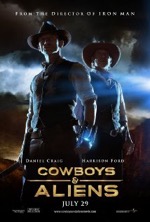
Starring: Daniel Craig
July 2011
Certainly the most original film of this summer’s panoply of big-budget blockbuster hopefuls, Western/sci-fi mash-up, Cowboys & Aliens, comes like a breath of fresh air amid the stale slate of tentpoles featuring transforming machines, wizards and superheroes. The movie’s holy trinity of director Jon Favreau and megastars Harrison Ford (Han and Indy) and Daniel Craig (Bond), pack this cinematic carbine with tremendous firepower, and boy do they deliver a rip-roaring good time.
As stellar as the two stars are, the supporting cast here is nearly as impressive. Olivia Wilde (TRON: Legacy) plays comely Ella Swenson, the film’s eye candy for teenage boys. Sam Rockwell plays the saloon owner, Keith Carradine is the town sheriff and Clancy Brown is the minister. In a similar role to the one he played in Shanghai Noon (2000), Walton Goggins (Justified) is a high-strung, trigger-happy bandit.
Other than the novelty of aliens in the Old West, there isn’t anything earth-shattering about the story. However, Cowboys & Aliens is a fanciful, farcical romp through familiar territory with a futuristic twist. The movie is a thrill-a-minute entertainment that aims at fun-filled diversion and hits the bull’s-eye.
The movie’s mash-up element might be off-putting to certain attendees—some audience members might find space aliens in their Western to be a little weird, while sci-fi fans will probably be disappointed by the paucity of the extraterrestrial element in the film. In the spirit of fairness (and because we’re in the throes of a global recession) the movie is approximately 80% Western and 20% sci-fi, so plan accordingly.
Based on a 2006 graphic novel of the same name, the movie has plenty of the prototypical conventions found in most Westerns like a solitary, rugged individual (Craig in this instance) descending a lonely hillside into a bullet-riddled town and riding off into the sunset at film’s end. The town ruffian (Paul Dano) gets in trouble with the law, requiring his cattle baron father (Ford) to bail or break him out of jail. An uneasy and unlikely partnership is forged between Craig and Ford when a common enemy threatens the town and their very existence.
But for all of the Western movie conventions utilized in the film, there are a number of unique story elements here as well. For instance, most Westerns are told in a linear fashion. Cowboys & Aliens, however, employs a series of flashbacks to fill in Craig’s mysterious abduction. The film also turns some Western film tropes on their ear, like who the “us and them” are in the story. The old adage that maintains “the enemy of my enemy is my friend” undergoes an interesting variation in the film where we have cowboys and Indians joining forces against the alien threat. If anything, this scenario certainly breathes new life into a nearly defunct genre.
Further distinguishing Cowboys & Aliens from traditional Westerns is its postmodern trappings. One of the more exciting scenes in the film is when Craig brings down an alien ship with his alien bracelet—surely a unique tableau in the expansive annals of the Old West. The scene is cathartic on two levels: 1. Good triumphing against evil (a cornerstone of classic Hollywood storytelling, the period when the bulk of Westerns were produced) is always reassuring, and 2. Craig using the alien’s technology against them is an echo of 9-11, but in reverse.
Perhaps the most un-Western element in the movie (other than the presence of aliens, of course) is the Zemeckis-esque flourishes of existentialism. In director Robert Zemeckis’ masterpiece, Forrest Gump, a languid feather drifts in and out of scenes, adding a unique visual referent as well as a purportedly deeper meaning to the events in the story. In Cowboys & Aliens, the repetitive object (or totem perhaps?) is a hummingbird. It’s not to say that hummingbirds didn’t exist during the Old West period, but they’re not the usual bird you’d associate with a Western—maybe a crow or hawk. Is Favreau tampering with the genre’s well-established iconography? With the presence of aliens in the picture, why not?
So there you have it: cinema’s first high profile Western/sci-fi hybrid with postmodern sensibilities and existential embellishments. While the movie never quite eclipses the lofty expectations placed upon it by the ubiquitous media blitz and fans of either the comic book or the movie’s A-list headliners, Cowboys & Aliens is still a wildly entertaining adventure, a quality romp that gives “popcorn movie” a good name. If nothing else, it’s just great to see Ford back in the saddle again.
Rating: 3
Source Code (PG-13)
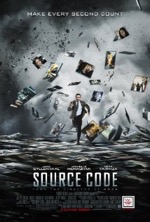
Starring: Jake Gyllenhaal
April 2011
Too soon on the heels of Inception (2010) or The Adjustment Bureau (2011)? Perhaps, but director Duncan Jones’ (Moon) Source Code is more derivative of TV series than heady, mind-trip flicks.
Exhibit A: Quantum Leap (1989-1993). Scott Bakula’s Sam Beckett leapt into different people (and the occasional space chimp) on a weekly basis to rectify some past wrong. In order to identify what person he was impersonating, all Sam had to do was look in the mirror—a concept that Source Code exploits early in its narrative.
Exhibit B: Seven Days (1998-2001) a lesser known UPN sci-fi series centered on the exploits of Frank Parker (Jonathan LaPaglia), a Navy captain who is sent back in time seven days (in Source Code it’s a breezy eight minutes) before a major catastrophe in order to avert it. Source Code borrows liberally from the premise and trappings behind Seven Days, right down to the military officer as the central character, a dubious space/time apparatus and multiple jumps backwards and forwards through time.
Exhibit C: 24 (2001-2010) Counter-terrorist agent Jack Bauer (Kiefer Sutherland) must thwart terrorist plots designed to cripple or nation in a perpetual race against time. Since Source Code deals with acts of terrorism in metropolitan areas, specifically a bomb on the train, we can also cite 24 as a possible antecedent to Jones’ shifty/trippy yarn.
Jones’ direction is taut, especially his stylistic flourishes to signify time travel and time compressed montages for less significant loops, and the performances are solid across the board (although Gyllenhaal and Monaghan’s foisted romance is a bit saccharine and Jeffrey Wright’s attempts at channeling a techno-babbling scientist are less than stellar). The movie fails to soar due to the myriad contrivances upon which its premise and story are based. Even the concept of learning more clues with each new perspective is reminiscent of Vantage Point (2008), which was heavily influenced by Kurosawa’s Rashomon (1951).
The conceit of a time traveler stuck in a causality loop has been explored ad nauseam in the sci-fi pantheon and, unfortunately, Source Code adds very few new riffs on the formula. The only innovation here is Jones’ opaque coda, which will leave at least half the audience scratching their heads as they exit the theater (I’m pretty sure I get it, but I’m not one hundred percent sure myself). The plot was satisfactorily concluded about fifteen minutes from the end, so why did the movie overstay its welcome? Jones’ parting shot is counterintuitive in that it risks confusing a significant segment of the audience over a mind-bending “ah-ha” denouement that could’ve just as easily been left on the cutting room floor. If you get the film’s conclusion, good for you; if not, join the club.
You’ve seen it all before, but maybe Source Code’s fresh faces and unique assemblage of standard plot devices will keep you entertained. I’ve got to admit that I had high hopes for this one, but in the end, Source Code is largely a waste of time.
Rating: 2 1/2
Terminator: Salvation (PG-13)
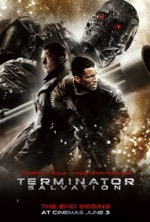
Starring: Christian Bale
May 2009
“We Have Seen the Enemy and He Has a Heart”
There are a lot of firsts in Terminator: Salvation, the fourth film in the series which comes after a six year sabbatical. This is the first film in the series to feature Christian Bale in the role of adult John Connor. This is the first Terminator film not to feature Arnold Schwarzenegger, although a CG version of the original model (nude of course) goes mano a mano with Batman, uh…I mean Bale. This is the first in the series to take place exclusively in the future (except for a brief prologue which is set in 2003). Terminator: Salvation also has a new hand at the helm, McG (We Are Marshall).
Another significant addition to the new film is the abundance and variety of new Terminators, some of which look like they were leased from the Transformers franchise. The new models come in all shapes and sizes and serve a variety of purposes in the story…always at the best moment to advance the story, of course. We have modified HK’s (Hunter/Killers, as we learn from Anton Yelchin’s Kyle Reese), scout ships (which serve a similar function but are a bit larger than the mini-hunters in the Terminator 3-D ride at Universal Studios Hollywood), sleek motorcycles which pop out of the legs of a giant Terminator which looks for all the world like Megatron’s cousin, some nifty serpentine Terminators which lurk in lakes and rivers and an assortment of garden variety Terminators like the T-600. The manifold futuristic mechanizations here are reminiscent of Star Wars, especially the prequels, and the aforementioned Transformer films, which some have accused this film of copying.
All of this naturally gives rise to the question, why all the new types of Terminators? There are more new models in Terminator: Salvation than in all of the previous films combined. This does give the movie a different mood and visual style, but it smacks of the same kind of story contrivance that saw R2-D2 suddenly sprouting thrusters in Star Wars: Episode II—Attack of the Clones; the little droid possessed no such propulsion capabilities in the original trilogy. This reveals the inherent weakness of John D. Brancato and Michael Ferris’ script: everything, from one set of credits to the other, is done for the sake of convenience and expedience in order to move the plot toward a harrowing conclusion and yet another sequel. Expedience, when all is said and done, is the film’s saving grace: for all of its newfangled gimmicks and continuity paradigm shifts, the story never allows you the time to take a breath…an oft-used stratagem employed by summer blockbusters seeking to conceal their lack of story with chaotic action sequences and glossy FX.
In addition to the myriad machines, there are plenty of narrative alterations in the new film, including a centralized rebel command and the newest model of Terminator. What isn’t new here is the murky time paradox, which addles the plot with too much exposition while needlessly exasperating a broad swath of the audience with confusing timelines and genealogies when all they really want to do is sit back and enjoy a popcorn flick. It’s been a while since I’ve seen the earlier films, so the paradoxical elements of the plot are a bit fuzzy in my mind. It seems strange to me that an adult John Connor (son) could exist in the same instant of space-time as an eighteen year-old Kyle Reece (father) without the universe imploding. I’m sure Dr. Brown from the Back to the Future trilogy would have a few choice things to say on the subject.
Be that as it may, the movie contains several intriguing story elements, like: the rebel HQ on a submarine (Michael Ironsides, with his typical tough-as-nails persona, is the rigid commander), a new RF signal which could put an end to Skynet and the latest Terminator/human hybrid, Marcus Wright (played with a great deal of precision by hunky Sam Worthington). The subplot involving Marcus’ ambivalence over becoming a reformed Terminator keeps the audience guessing his loyalties until the bitter end. And is it me, or is there something about Marcus’ composition and manner that just screams Borg?
Though the plot looses focus at times, McG delivers a handful of memorable moments in the film, namely: the bridge ambush, the prison break and shootout through the mine-filled base, the serpentine Terminators attacking Connor and the entire sequence with the giant Terminator. The bridge battle reminds me of similar action sequences in True Lies (1994) and Mission Impossible III (2006), and the pulse-pounding motorcycle pursuit features a less sparse, more debris-filled roadway than the one seen in the similarly dystopian Mad Max (1979). The final battle inside Skynet, which features resistance officers and Terminators scattering in every direction like frantic stormtroopers on a doomed Death Star, is somewhat protracted and fails to deliver the kind of visceral thrills required of a blockbuster finale. The melee never quite draws us into the fight but leaves us feeling hollow over the shallow spectacle…a fitting culmination to a similarly heartless movie.
Terminator: Salvation has left the gate wide open for a sequel. It has also left us with some hope for the future, unlike each of the bleak resolutions in the earlier trilogy. I actually think the new direction for the series has potential…imagine Red Dawn (which is currently being remade) with Terminators subbing for Russians. If the guerrilla war premise catches on, it could sustain the series for a few more movies until all of the Terminators have been terminated.
Rating: 2 1/2
Star Trek (PG-13)
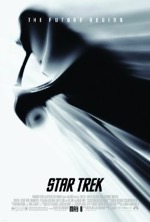
Starring: Chris Pine
May 2009
“New Trek Frontier is More Commercial, Less Cerebral”
“It was the best of times; it was the worst of times.” Charles Dickens’ famous line from A Tale of Two Cities, quoted near the beginning of Star Trek II: The Wrath of Khan during a great character moment between Kirk and Spock, had profound ramifications later in that film. Writer/director J.J. Abrams’ re-envisioned Star Trek, which comes seven years after its foundering forebear, Star Trek: Nemesis, and five years after the ill-fated TV series, Star Trek: Enterprise, is the very embodiment of Dickens’ ambivalent phrase.
Boldly going where viewers have already gone before (i.e., a prequel) is seldom a good idea and rarely produces positive results…I’ll use just three words in making my case, The Phantom Menace (a.k.a. Star Wars: Episode One). But the new trend in Hollywood is to re-imagine, retool or reboot a decades-old movie or TV series, effectively breathing new life into a flatlined franchise. The Batman, Battlestar Galactica, Superman (Smallville, not the flop known as Superman Returns) and James Bond franchises have all garnered commercial success and critical praise for breaking with the established format while maintaining the essence of the original. This reinvention of Star Trek certainly falls into that exclusive cabal of resuscitated series that have found new life by slightly altering the formula.
The new Star Trek is an origins tale or, more appropriately, an alternate origins tale. It’s readily apparent that Abrams and his crack writers, Roberto Orci and Alex Kurtzman, made it their mission to streamline and accelerate the story of how Kirk, Spock and the rest of the Enterprise crew first meet. The result is an ultra-convenient, yet easily accessible version of the crews’ introductions, which pretty much thumbs its nose at the series’ history and continuity. Such blatant disregard for the sacred Trek cannon runs the risk of creating mass riots by diehard fans, but the ever-clever Abrams has an ace up his sleeve. Returning to one of Trek’s classic conventions, Abrams’ stratagem is to employ time travel as a means of wiping the slate clean, thereby recreating the forty-three year old series in his image. A brilliant strategy! If the series should falter at some point in the future, Abrams can hit the reset button, restore the original Trek timeline and retire to some tropical island with smoke creatures and polar bears.
There’s no denying that this film marks a bold new direction for the franchise—which is exactly what it needed since the early demises of Nemesis and Enterprise were directly attributable to fan fatigue. In order to regain the vitality it once possessed in spades the series would have to skew younger, feature more action sequences and tone down the lengthy stretches of expositional dialogue laced with techno-babble. Abrams accomplished all of this, and a great deal more, by presenting the most commercially viable Trek film to date. Unfortunately, harking back to Dickens’ best/worst dichotomy, Abrams’ Trek is also the least cerebral of the lot.
What shines even brighter than Abrams’ ubiquitous lens fares, which surely will annoy some spectators, is the cast. Chris Pine and Zachary Quinto are nothing short of astounding in their portrayals of Kirk and Spock, respectively. Pine and Quinto’s chemistry already rivals Shatner and Nimoy’s, which is quite a boast. Also, you can argue, correctly in either case, that Pine or Quinto anchors the film. Bruce Greenwood brings dignity, nobility and sagacity to the film as Captain Pike. Although frequently overshadowed by Pine and Quinto, Greenwood, who serves as seasoned veteran and elder statesman, skillfully dispenses nuggets of wisdom at crucial junctures in the film, most notably during Pike’s recruitment speech to the brash, black-and-blue Kirk after the hotheaded Iowan youth gets his butt kicked in a bar fight. Pike’s challenge to Kirk, “I dare you to do better,” is undeniably the finest line of dialog in the movie.
Zoe Saldana’s presence isn’t as keenly felt as Pine’s or Quinto’s, but her absence from the movie would’ve left a significant void, especially for female viewers. Saldana’s Uhura is the perfect blend of toughness and tenderness; Nichelle Nichols only exhibited the former on rare occasions (“Mirror, Mirror”). In the comic relief department, we have the bone-dry humor of Karl Urban (Dr. McCoy) and the rapier wit of Simon Pegg (Scotty), who steals the show with a steady stream of hilarious one-liners.
John Cho is a bit understated and underutilized as Sulu (although the “advanced combat training” gag is priceless) and Anton Yelchin’s is over-the-top as the ship’s callow navigator, Pavel Chekov. Yelchin’s faux Russian accent generates patronizing chuckles from the audience, but it’s a mockery of Walter Koenig’s original portrayal of the character and of Russians by extension. In Star Trek IV: The Voyage Home (1986), when Chekov asked to see the “nuclear wessels” everyone in the audience laughed because we were still embroiled in the Cold War and Chekov is Russian (the hilarity of the situation and Keonig’s flawless delivery also added to the levity). By contrast, Yelchin’s Chekov tries too hard to generate laughter with his tongue-twisting lines. The scene where he broadcasts a message via intra-ship communications (why wouldn’t Uhura or another ranking officer do this?) is utterly silly. Other than the villain, Chekov’s accent is the only character miscue in the film.
And speaking of the movie’s nefarious one…Eric Bana, through no fault of his own, delivers the weakest performance of the movie as the megalomaniac Romulan, Nero. I say “no fault of his own” because: a. Bana is a capable actor (reference The Other Boleyn Girl), and b. Orci and Kurtzman rendered Nero as a Muppet with aspirations of becoming Darth Vader. With sound-bite dialog, melodramatic acting and a strange speech impediment a la Christian Bale in The Dark Knight, being a believable baddie just wasn’t in the cards for Bana. Speaking of The Caped Crusader, Nero’s back story reminds me of villainous Mr. Freeze’s in the Batman mythos. Forever separated from his diseased and cryogenically frozen wife, Mr. Freeze frequently takes out his aggressions on Gotham City; but is everyone in Gotham responsible for his wife’s terminal condition? Likewise, Orci and Kurtzman attempt to provide their tragic antagonist with proper motivation, but the whole “You destroyed my planet, so I’m going to destroy yours!” rationale seems sophomoric and more than just a little contrived.
Ironically, as underdeveloped as Nero is, many other elements of the villain’s subplot are equally insipid. The interiors in Nero’s drab, industrialized vessel, Narada, are so similar to Shinzon’s Scimitar in Nemesis that, at times, I had to remind myself that I was watching a new release and not an oldie-but-goodie on DVD. Clearly it’s time for a new vision in the villain vessel department. To extend the similarities of both movies to the villains themselves; both are bald, both have overzealous henchmen and both are acting outside of official Romulan channels…oh, and minor detail, both want to wipe out the Federation with scientifically advanced super-weapons.
What bogs down the story the most is the confusing and convoluted time travel subplot. A tangled yarn that needlessly hamstrings the plot with chunks of exposition (i.e., the mind-meld sequence, which catches us up on the back story involving Nero and the older Spock) while simultaneously opening a gigantic can of Regulan bloodworms, the plot does make sense if you reason it out…but who wants to put that much effort into a popcorn flick? Besides temporal quagmires, other snafus abound; i.e., can the pair-o-Spocks exist in the same place and time, and can you really see Vulcan explode with the naked eye while standing on Delta Vega (the two planets are in different solar systems)? Earth’s moon doesn’t appear as large in our sky as Vulcan does to Spock Prime as he stands on an icy plain on Delta Vega, which, incidentally, was a desert planet in the original TV series. Perhaps the most annoying sequence in the movie—which, admittedly, I would’ve loved as a boy—is the “There’s always a bigger fish” scene on Delta Vega where Kirk desperately sprints away from two carnivorous beasts. Those who’ve seen The Phantom Menace will understand my reference…the sequence is such an obvious rip-off of the Naboo ocean scene, Abrams, a self-professed Star Wars fan, should be banished to Delta Vega for concocting such an utterly transparent and ultimately superfluous segment.
I don’t normally pick on movie merchandise in a review, but before the movie was released, I purchased one of the new phasers and thought the alternating blue (stun) and red (kill) settings were pretty ingenious. However, the phaser’s rotating ray emitter is a pathetic gimmick, especially during the film’s final battle on Nero’s vessel. Kirk cautiously moves through a darkened corridor, raises his phaser close to his face and depresses a button that sends the nozzle swiveling in a rapid 180-degree horizontal arch. As if in a Pavlovian trance, every young boy in every theater around the globe turned to his parents at this exact moment in the film and said, “I want one of those!” Shameless product placement? You bet! The worst part is…the phaser makes absolutely no sense from a functional standpoint. In the heat of battle, one might accidentally incinerate an enemy when he had only intended to momentarily paralyze his opponent or vice versa.
Star Trek walks a dangerous line between retro-cool and self-parody. The ship’s bridge looks like an Apple store, but for all of its glossy sleekness, its overall design still looks 60’s chic. There are plenty of self-references in the film—like arched eyebrows, catchphrases and inside gags—and a number of them feel forced. Similarly, classic lines delivered by the new actors probably sound just fine to those “outside of the body,” but diehard fans might struggle with Karl Urban exclaiming, “I’m a doctor not a…” The explanation of how Kirk came to call McCoy “Bones” is quite clever, though, and the “numb tongue” sequence is not to be missed.
If ever there’s been a movie that’s struck the zeitgeist bull’s-eye, Star Trek is it. In the desperate times in which we live, indeed mirroring the late 60’s in myriad ways, Star Trek offers a ray of hope to our war torn, economically challenged world. Leading off a summer of dark, dismal and dystopian action-adventure flicks (Terminator 4, Transformers 2 and a still darker Harry Potter 6), Star Trek offers an alternate view of the future; if we work hard, keep our wits about us and seek peaceful co-existence with our neighbors. Unless I’ve missed my guess, Star Trek will be a welcome breath of fresh air for moviegoers up to their titanium-plated skullcaps in doom-and-gloom visions of the future. As such, blockbuster status is nearly assured.
Abrams’ first foray into the Star Trek universe has more pluses than minuses and actually tells a more exciting origins tale than the one presented in the original series. Introducing an entire new generation to “The Wagon Train to the Stars,” Star Trek should spawn numerous sequels in the ensuing years. It’s cool, it’s hip, but it’s not quite Star Trek…at least not the Trek we’ve known.
And so the questions begin: has Trek sacrificed its cerebral distinctive for mass appeal? Has Abrams, with his compressed story lines, ubiquitous lens flares, MTV style editing and young and sexy cast, bowed to the gods of pop culture? If it finds wide appeal across all demographics, cultures, etc, will Trek loose its cult status and be relegated to the ranks of generic science fiction?
Time will tell the answers to these questions, but what’s been established in this film is that Star Trek no longer belongs solely to tech nerds, science geeks or fantasy-prone fanatics…it belongs to the masses. First era Star Trek fans now must learn to share their sacred pastime with a new generation of Trek fans who won’t know the difference between a Tribble and a Tricorder. As an acolyte of the Roddenberry/Berman epoch, there’s part of me that wishes Abrams had tampered with someone else’s universe. And yet…another part of me is gratified that Star Trek has finally found the commercial appeal it justly deserves. Oh how that confounding Dickens line vexes.
If Star Trek has set the table for meatier, issues-driven films or even another TV series in the near future, it will have served its purpose. Fresh blood is just what the franchise needs. Make it so!
Rating: 3
Star Wars: The Clone Wars (PG)
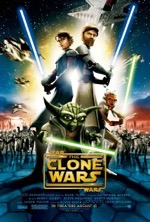
Starring: Matt Lanter
August 2008
“First Wars Animated Feature Ironically Feels Like a Clone”
In the final frontier, the good ship Enterprise is ever ready to respond to one intergalactic crisis or another and, conveniently, always seems to be the closest ship to a cosmic conflagration. Panning over to the galaxy far, far away, of all the Jedi Knights in the Old Republic—and there were myriad during the Clone War epoch—Obi-wan Kenobi and Anakin Skywalker always seem to be right in the middle of some uprising involving the Separatists and their droid armies, or engaging Count Dooku and his assassin apprentice Asajj Ventress in lightsaber duels, or avoiding the traps set by evil mastermind Chancellor Palpatine/Lord Sidious. Indeed, at the outset of the first full-length animated feature in the Star Wars stable, simply titled The Clone Wars, diminutive, inverted-speaking Jedi Master Yoda affirms that among the teeming ranks of Jedi Knights only two Jedi are available to rescue Jabba the Hutt’s kidnapped son…you guessed it, Obi-wan and Anakin.
To say that the film’s intro represents a catastrophic tremor in the Force for Wars fans is a galactic understatement. There’s no Fox fanfare (the movie is being distributed by Warner Bros.), no opening crawl of expository back-story and in place of the familiar, rousing score we’re served a bastardized version of John Williams’ legendary Main Title that goes down like flat 7up. From the outset, this new film feels like a cheaply made knockoff of creator George Lucas’ space saga rather than an official chapter.
The movie opens with a futuristic news reel which focuses on the aftermath of Star Wars: Episode I and II (in case spectators missed the prequels and stumbled into the theater by accident). The first half hour is one continuous battle; essentially a cut and paste job of various action sequences from Episode II and the brilliant animated shorts by director Genndy Tartakovsky, as shown on the Cartoon Network between 2003 and 2005—an animated series based on this film, which serves as a pilot of sorts, will air on the same network this fall.
During a break in the action, reinforcements arrive and we’re introduced to Anakin’s new Padawan, Ahsoka Tano (Ashley Eckstein); a plucky motor-mouth who’s a thorn in her master’s side just like Anakin was with Obi-wan. Ahsoka, who’s amusing for about fifteen minutes, becomes an obnoxious know-it-all by movie’s end. Still, the red-skinned youth is the only fresh element in the movie and her incessant bantering with Anakin is the movie’s only saving grace.
After the video game opening plays out, the second half of the film stumbles into something that resembles a story. Several of the subplots had the potential to develop into something substantive, namely the rescue of Jabba’s son, Kenobi’s lightsaber duel with Ventress, Anakin’s lightsaber confrontation with Dooku, Dooku’s plot to implicate the Jedi in the kidnapping of Jabba’s son and Amidala’s failed negotiations with Jabba’s uncle, Ziro the Hutt. Unfortunately, it’s all wasted effort because none of these narrative threads are given a chance to develop independently from melees, explosions and every other action element that fills twelve-year old boys with awe and excitement.
The main problem here isn’t the insipid plot, stiff animation, beaten-to-death conventions, or playground dialog. It isn’t even the fact that the only original actors to lend their voices are Samuel L. Jackson as Mace Windu, Christopher Lee as Dooku and Anthony Daniels as C-3PO. The biggest drawback to The Clone Wars is that it’s little more than a publicity stunt. As the lead-in to the upcoming animated series, the movie feels like a glorified cartoon; and since each of the main subplots resolve right around the thirty minute mark, the movie can be cut into three episodes and rebroadcasted on TV with little effort. What sours the blue milk here is the knowledge that Lucas green-lit the project solely to promote the new series. Does Lucas even care if the movie makes a profit? It seems like he just wants exposure for the series, which is yet another sneaky way of marketing his brainchild…something he mastered long, long ago.
The Clone Wars, however visually stimulating, is a dreadfully remedial tale that maneuvers the saga dangerously close to self parody. With two mediocre efforts turned in this summer (Indy IV), Lucas’ name on the street is about as good as M. Night Shyamalan’s. If Lucas isn’t careful, he’s going to alienate the remnant of die-hard fans; and when that happens, his fire will have gone out of the universe. All of a sudden, The Star Wars Holiday Special (1978) and the two Ewok TV movies don’t look so bad.
Rating: 2
WALL-E (G)
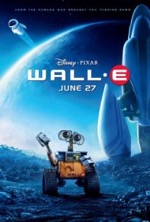
Starring: Ben Burtt
June 2008
“Animated Triumph Takes Us to Infinity and Beyond”
The latest feature film from Disney/Pixar may be an animated movie, but it certainly isn’t a kid’s movie. That’s not to say that kids won’t enjoy it or that it’s inappropriate for children, because that certainly isn’t the case. What I mean is that Pixar has delivered its most adult film to date; a hauntingly beautiful, elegantly whimsical and poignantly instructional CGI tour de force.
WALL-E tells the story of the last “living thing” on earth (other than cockroaches, of course) after humans abandoned their trashed and thrashed home world in search of greener pastures in the heavens. WALL-E (Waste Allocation Load Lifter-Earth), the eternally curious, binocular-eyed robot, has been assigned the unenviable task of cleaning up the desolated surface of our planet all by himself. WALL-E’s existence is fairly routine—gathering trash, compacting refuse into waste cubes and constructing veritable mountains out of the cubes—until a mysterious ship literally lands on top of him. The alien vessel dispatches a probe and quickly shoots back into space.
WALL-E is immediately stricken by the alabaster, egg-shaped probe, whom he soon learns is named EVE (WALL-E pronounces her name “Eva”). EVE barely acknowledges WALL-E’s existence until, in a desperate act to impress the mission-minded probe, WALL-E presents EVE with a gift—the solitary shoot of a plant potted inside an old boot. EVE snatches the plant, stores it inside one of her compartments and immediately shuts down. Try as he might, WALL-E fails to snap EVE out of her self-imposed trance; EVE is completely lifeless, save for a green flower symbol flashing on her sleek surface. Once again, WALL-E is relegated to a life of loneliness.
From that brief synopsis of the movie’s opening act, many would perceive WALL-E to be a dark, dismal, despondent, dystopian yarn, but nothing could be farther from the truth. I know this is quite a boast, but WALL-E has more heart than any previous Pixar picture, which is ironic since it prominently features emotionless, whirring robots as its main characters. Some humans appear in the story, but they certainly don’t resemble our race at present, although the story is clearly warning us against becoming the shallow, convenience and consumer-driven society portrayed in the film. WALL-E, set 700 years in the future, is clearly a cautionary tale, but instead of simply leaving humans to wallow in the slough of our own making, the film illustrates the indomitable spirit of our race; the film powerfully illustrates humanity’s ability to adapt and aspire. Of the few lines of dialog in the film, the best one comes from the captain of the space cruise liner, Axiom. Once his eyes are opened to how life was on Earth, pre-apocalypse, the captain exclaims, “I don’t want to survive, I want to live!”
At the heart of the film is the improbable, unconventional, yet deeply moving romance between WALL-E and EVE. Built upon sacrifice and simple acts of kindness, their artificial relationship is more emotionally resonant than the majority of human love affairs that populate modern cinema. I never thought I’d tear up at an animated film, especially one centered on two lovebird robots, but at times I couldn’t help it. So great is Pixar’s mastery of narrative, and anthropomorphized characters, that it can seemingly control a spectator’s emotions at whim. Pixar artisans are truly digital alchemists.
It almost goes without saying that the movie’s animation is stellar, but Pixar has taken CGI to new heights in WALL-E, especially during the beautifully choreographed fire extinguisher in space sequence. Pseudo-documentary quick zooms infuse the prologue with some energy and the Chaplin-esque physical humor, along with Ben Burtt’s inspired vocalizations, makes for some captivating and amusing vignettes, like when a confused WALL-E places a spork in-between his spoon and fork collections.
From the movie’s lyrical opening to its unconventional resolution, WALL-E is an instant masterpiece and a triumph in feature length animation. What started out as the most dubious Pixar film, judging from the film’s insular trailer, has turned out to be the studio’s most ambitious effort with the biggest payoff; the film is, hands down, the most profound animated movie ever made and very nearly qualifies as the Citizen Kane of its form. Though unabashedly bleak in spots, WALL-E is an affirmation and celebration of life in any form, even the most inconsequential. Hand over the Oscar for Best Animated Movie. WALL-E is out of this world!
Rating: 3 1/2
The Incredible Hulk (PG-13)
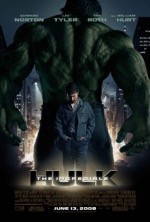
Starring: Edward Norton
June 2008
“A Giant Green Leap Past Lee’s Stylized Flop”
Is there a better word to describe the 2003 version of The Hulk than debacle? Director Ang Lee delivered a cerebral comic-to-movie adaptation that was so painstakingly adherent to its 2D, four-color source material it turned off a large segment of the audience with its dizzying 24-style split screen boxes, headache-inducing action sequences and an angry green giant who fluctuated in size and could leap several miles with every bound. It may have been the ultimate Valentine to the comic book and its fans, but it wasn’t great cinema—judging from its critical rejection and tepid box office.
Compared to Lee’s avant-garde wild pitch, director Louis Leterrier’s vision for the Hulk is right in the middle of the strike zone, and will appeal to fanboys as well as a mass audience. The Incredible Hulk isn’t technically a sequel to The Hulk; more like a re-envisioning. In addition to a change at the helm, the entire cast has been overhauled: Edward Norton as Bruce Banner/Hulk, Liv Tyler as Betty Ross, William Hurt as General ‘Thunderbolt’ Ross and Tim Roth at Col. Emil Blonsky/Abomination.
Norton’s performance is flawless, but the rest of the cast has a hard time fitting into their characters—ironic since, initially, Norton as a superhero seemed like the most dubious piece of casting. Hurt is serviceable but a bit stiff as Gen. Ross, a crusty old war dog who constantly demands bigger guns and more backup. Tyler is too soft-spoken in her likewise understated turn—the Lord of the Rings actress defaults to her Elvish serenity in a role that required a wider emotional range. Roth is skilled at making bad guys believable, but here the actor is powerless to forge swaggering hothead, Blonsky, into a viable villain. The entire cast is victimized by shallow character development from writer Zak Penn. Assuming that his audience is already aware of the Hulk’s back-story, the ironically named Penn does little to expand the boundaries of the characters beyond what’s been established in the comic book. In essence, the characters kowtow to the rhythm and demands of the script. The word contrived comes to mind.
And speaking of contrived, the climactic battle between The Hulk and The Abomination—which comes complete with a Godzilla-style rampage through the streets of NYC—is a conventional resolution that caps a twenty-six minute slugfest between the mutant titans. The sequence is a surfeit of eye candy which, appropriately, comes crashing down after the sugar high of car tramplings, helicopter hurlings and Hulk smashings wears off. Strangulation as a means of vanquishing a foe is extremely banal and renders the eagerly anticipated climax that much more disappointing.
There are many other disappointing elements in the film, like Bruce’s perpetual inability to give Gen. Ross’ men the slip. The early stages of the film establish Bruce as an expert at lying low, so why can’t he simply disappear again? And then there’s the flaccid love triangle between Bruce, Betty and one of Betty’s colleagues (he’s in the movie for maybe five minutes and I don’t remember his name). As soon as Bruce resurfaces, Betty (apparently) dumps her boyfriend and returns to Bruce’s side as if nothing had happened during his absence. The whole sordid mess is quickly and conveniently set aside to make way for another action scene. There’s that word again…
Contrived as it is, there are some entertaining aspects to the film. Besides Norton’s finely attenuated performance, there are several amusing cameos: Stan Lee and Lou Ferrigno reprise their brief stints from Lee’s Hulk, and Robert Downey Jr. shows up as Tony Stark. Stark’s alter ego, in case you’ve been on an extended vacation off-planet, is Iron Man. Stark’s presence here marks the first cross-pollination of superheroes in a Marvel movie and also lays the groundwork for a much anticipated Avengers movie.
The Hulk is one of the finest examples of Man vs. Himself in modern mythology, and though angst hovers over the movie like a dark cloud, Leterrier, fortunately, doesn’t let it consume the film. The director pays fitting tribute to Bill Bixby, who played small screen Banner from 1977 to 1982, by revealing a brief glimpse of the actor on a TV in the background of Banner’s flat. Composer Craig Armstrong also pays homage to the TV series by employing a clever statement of “The Lonely Man” theme in his score.
Even though The Incredible Hulk underachieves, it’s still a giant leap ahead of its predecessor. Rumors persist that Norton was dissatisfied with the final cut of the film, so we’ll see if he comes back to join Barry Bonds in Hulk III: Steroid Smackdown.
Rating: 2 1/2
Cloverfield (PG-13)
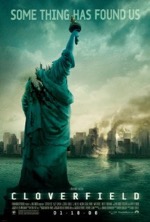
Starring: Mike Vogel
January 2008
“Standard Disaster Flick with Distracting, Nauseating Visuals”
The older I get the less I enjoy roller-coasters; these days it doesn’t take much for me to get motion sickness. As such, I seldom frequent amusement parks, but when I do, I know exactly what I’m getting myself into. With Cloverfield, the new J.J. Abrams-produced scare-fest, I went in expecting to see a movie but came out feeling like I’d just stepped off a roller-coaster, having experienced all of the side effects but none of the fun.
The easiest way to define Cloverfield is: The Blair Witch Project meets Godzilla. The entire film is shot from the POV of a single camcorder in a very shaky, jittery and wobbly fashion. After about fifteen minutes of handy-cam hell, I found it increasingly difficult to keep my popcorn from coming back up. I ended up closing my eyes to avoid hurling on the person in front of me, and, as strange as it seems, I still could follow the narrative with little difficulty. I guess rampaging creature movies are like baby’s butts: if you’ve seen one, you’ve seen them all.
The movie opens with a going away party thrown by Jason Hawkins for his brother, Robert, whose recent promotion will require him to relocate to Japan. We’re briefly introduced to Jason’s girlfriend, Lily, and his uncouth friend, Hud, (who becomes unwitting documentary director) before the “creature” makes its bombastic entrance, instantaneously transforming the streets of Manhattan into a horrific tableau of death, destruction and panic-ridden pandemonium. Evacuees, hoping to find safe haven on the other side of the Brooklyn Bridge, converge upon the structure en masse; but anyone who’s seen a Godzilla movie or the recent I Am Legend, will know instinctually that such an exit strategy will surely meet with an untimely demise.
Leaving no Godzilla convention untapped, the creature dispatches a platoon of youngling foot soldiers which are used like vacuum attachments—to clean up those hard-to-reach places. Oh, and speaking of plot contrivances; why is it that characters presented with a means of escape will invariably return to the danger zone to save someone or some thing? The most annoying example of this phenomenon I’ve ever seen—in any film—is when Sigourney Weaver’s Ripley leaves the safe confines of her spaceship and risks being eaten by an Alien to save her blasted cat (apologies to PETA). Here, the object of reckless abandon is a wounded woman, so I suppose the actions of the main characters are more heroic—if equally foolhardy.
Credit director Matt Reeves with delivering a highly experimental creature feature, even though the experiment is an ignominious failure of ironically gigantic proportions. Despite being financed by a major studio, Reeves’ attempt at creating the newest sensation in ultra-real entertainment comes off looking like a high-end home video…and I certainly wouldn’t have paid ten bucks to see that, had I known.
Scriptwriter, Drew Goddard, taking a cue from earlier disaster films like Titanic, skillfully ushers his characters through the movie’s earth-shattering events; a narrative device that’s used to personalize and humanize a tragedy while setting up a powerful payoff during a catastrophic climax. Unfortunately, that kind of emotional empathy doesn’t work for Cloverfield because character development is virtually non-existent from the word go. When one of the characters is imperiled, it’s like watching a stranger’s plight on the news; you might pity them, but if you don’t know who they are, it’s difficult to feel genuine sympathy for the individual.
Cloverfield weighs in at a lean eighty-five minutes, yet still manages to overstay its welcome due to its unrelenting, dizzying mode of filming. To say that Cloverfield—the beneficiary of an ingenious marketing campaign, stratospheric expectations and Herculean hype—is a massive disappointment would be a colossal understatement. However, even if the viewing experience had been a pleasant one, the dismal and abysmal story still would have ruined a film that’s more nauseating than it is frightening.
Many questions are left unanswered, like where does the creature come from? Or why, in the sprawling metropolis of NYC, does the creature always seem to be right on top of our heroes? Perhaps the biggest unanswered question is the significance of the title. It sounds cool, but what does it mean? There’s no reference to a Cloverfield anywhere in the movie. I suppose, however, that Cloverfield is acceptable as a euphemistic title since Herky-jerky wouldn’t have sold a single ticket.
Rating: 1 1/2
I Am Legend (PG-13)
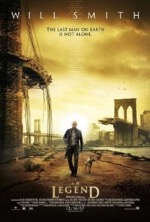
Starring: Will Smith
December 2007
“We Have Seen the Enemy and It is Us!”
Based on Richard Matheson’s novel of the same name, published in 1954, I Am Legend is the third filmic adaptation of his dark, dystopian yarn (1964’s The Last Man on Earth and 1971’s The Omega Man). Though the film diverges from Matheson’s novel in a few key areas, most notably the resolution, this I Am Legend retains the book’s melancholy tone and macabre themes while giving the story a modern upgrade.
The movie takes place in 2012, three years after a virus (engineered to cure cancer) turns airborne and eradicates 5.4 billion people, effectively transforming NYC into a weed-infested wildlife preserve. Col. Robert Neville (Will Smith) has natural immunization to the virus and tries to unravel what went wrong with the supposed miracle cure. His day consists of pilfering supplies from abandoned apartments, hunting deer with his dog, Sam, and working in his lab to find a cure for the virus. At dusk, Robert boards up his apartment, turns off all the lights and curls up with Sam and his rifle in the bathtub. The shrieking screams of “the creatures” who roam the streets at night plague Robert’s fitful sleep as he shivers in fear and prays for the dawn.
Besides merely scaring the audience senseless (which it does with all the subtlety of an exploding bomb), I Am Legend is also disturbing on deeper, more salient levels, not the least of which is the scientific plausibility of a designer virus, however well-intentioned in its application, actually wiping out our entire species. It’s conceivable that our scientists could do it in haste—or by accident. Jeff Goldblum’s indicting line in Jurassic Park, “…your scientists were so preoccupied with whether or not they could, they didn't stop to think if they should,” readily comes to mind here. And what about radical terrorists who would resort to germ warfare to defeat their enemies? As terrifying as the movie’s “dark seekers” are, these shocking scenarios are far more unsettling.
One of the rules for crafting any good piece of fiction is “Show, don’t tell.” Director Francis Lawrence (a former pop-video creator), expertly adheres to that maxim while forging Matheson’s brainchild and Mark Protosevich and Akiva Goldsman’s adapted screenplay into his own frightening vision of our world gone horribly wrong. As we closely study Robert’s actions, questions naturally arise, like: Why does Robert have the alarm on his wristwatch set to go off at different times during the day? What is the significance of the various appearances of butterflies in the film? Who set the trap that snares Robert, and why does he fall for it? And, does the mannequin’s head turn or is it just a motion-created optical illusion? Or was that just my imagination?
“Because there is so little dialogue,” Smith told EW, “every moment has to be rich with human experience.” Ergo, I Am Legend can be viewed as a kind of near-future Cast Away, with the main differences being location (distant island vs. devastated metropolis), sidekicks (blood-painted volleyball vs. intrepid German Shepherd) and stars (Hanks vs. Smith). At first glance, Smith would seem to be no match for Hanks, but Smith’s acting here is amply textured and cleverly nuanced. In his most ambitious role to date, Smith plays a man in the throes of loneliness who hangs onto sanity by a thread; a physically and psychologically demanding performance that, in its own way, rivals his career-defining turn in The Pursuit of Happyness—the gold standard for Smith films.
I Am Legend has great atmosphere during the day (thanks in large part to the keen eye of LOTR’s cinematographer, Andrew Lesnie), but the night scenes feel like a glorified zombie movie, however intense. The movie’s most riveting sequences take place during daylight hours—Robert chases Sam into an abandoned warehouse and Robert confronts mannequin, Fred, who’s moved during the night. The special effects are also a mixed bag—the CGI is quite good early on, but as the movie progresses the visuals get hokier (did they run out of F/X funds?), particularly on the dark seekers, whose half-baked appearance and movements resemble an average video game character.
Despite these niggling details, I Am Legend is an exhilarating thrill-ride that features spine-tingling encounters, pulse-pounding pursuits and disturbing revelations about the human condition under extreme conditions. With its eerily realistic shots of nature reclaiming Times Square, engaging flashbacks, Oscar-caliber lead acting and heart-stopping action scenes; I Am Legend has set the bar for near-future outbreak films to near-unattainable heights. If the movie’s done its job, it will haunt you with its horrific “what if” scenario long after you’ve left the theater: lingering side effects may include anxiety, paranoia or excessive jumpiness. You’ve been sufficiently forewarned!
Rating: 4
Meet the Robinsons (G)
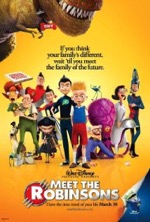
Starring: Daniel Hansen
March 2007
“Light-years Ahead of Other Animated Family Films”
The latest animated offering from Walt Disney Studios, Meet the Robinsons, presents a story of friendship, courage and the importance of family. Directed and co-written by Stephen J. Anderson (who also provides three voices in the movie), this time travel tale, based on William Joyce’s children’s book, A Day with Wilbur Robinson, features the vocal talents of Angela Bassett, Adam West and Tom Selleck.
As an infant, Lewis was abandoned by his mother on the doorstep of an orphanage…now a precocious twelve-year-old, Lewis just wants to know what it’s like to have a family. A science geek by nature, Lewis makes a memory scanner out of a toaster, a safari hat, rubber bands and anything else he can get his hands on—MacGyver should be so lucky!
Unfortunately, it’s Lewis’ inventions that have sabotaged all 124 of his adoption interviews. Seizing the opportunity to display his work to prospective parents, Lewis proudly shows off his contraptions…which always seem to malfunction in spectacular fashion, sending everyone in the room ducking for cover and leaving Lewis feeling unworthy and unwanted. Lewis’ adoption agent tries to pep him up, pointing out his brilliant future as an inventor. Disheartened by constant rejection, Lewis replies, “I have no future. Even my mom didn’t want me.” Just when Lewis abandons all hope of being adopted, he makes the acquaintance of Wilbur Robinson—a self-professed “time cop”—at his school’s science fair. Wilbur shoves Lewis into his invisible time car and the two boys soon embark on an amazing journey into the future, where Lewis meets Wilbur’s eccentric, freethinking family and encounters the evil Bowler Hat Guy.
Though the first half is slow to develop, there’s just enough action in the movie—like the savage T-Rex attack—to keep most kids actively engaged. However, evaluating the movie from a kid’s perspective reveals a few potential areas of concern for parents. The evil Bowler Hat Guy is pretty silly throughout the movie, but without warning and at random times, he transforms into a darker, more sinister figure. The lanky antagonist often speaks of crushing Lewis’ dreams and ruining his life, but the biggest red flag comes when the villain admonishes Lewis’ roommate to let his anger fester and to “let hate be your ally.” Though the statement is later redeemed, the nuance of the scene may be lost on many younger viewers, some of whom might take the statement as permission to act upon what they’ve heard. There’s also an alternate future which paints dark images of a world overrun by electronic hats with spider-like appendages; an adolescent rendering of The Terminator’s Skylab, the scene may be too frightening for younger kids.
On balance, the movie reinforces such virtues as working hard and pursuing a dream, and contains more than just a few heartwarming moments. Many of the Robinson’s mannerisms seem strange to Lewis, but he finds their kindness, encouragement and non-judgmental approach to life to be a welcomed change to his rigidly regulated existence at the orphanage. When another of Lewis’ inventions goes haywire in the future, the entire Robinson family celebrates his blunder; “From failing, you learn!” they excitedly exclaim. Such unconditional acceptance prompts Lewis’ statement, “If I had a family I would want them to be just like you.”
Despite a few minor defects, Meet the Robinsons is a valiant attempt at restoring Disney animation to its former glory while ushering in a bold, new era of high-quality CGI films. The movie concludes with an inspirational quote from Uncle Walt himself, “Keep moving forward!” There have been some flops over the years, but I’m sure Walt would agree that Meet the Robinsons is a step in the right direction.
Rating: 3
Deja Vu (PG-13)
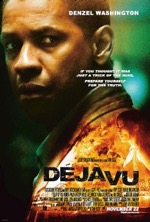
Starring: Denzel Washington
November 2006
“The Feeling That You’ve Seen This Plot Before”
In 2001, the Oscar for Best Actor went to Denzel Washington for his portrayal of a crooked cop in Training Day. With an Oscar in one hand and an ever-growing list of box-office hits in the other, one wonders why Denzel settled for the diverting, yet middling love story, Déjà Vu, which co-stars Val Kilmer, Jim Caviezel and the comely Paula Patton (Hitch).
The movie opens with a domestic terrorist attack on a ferryboat in a New Orleans harbor (hasn’t the city already suffered enough?). Detail-retentive ATF agent, Doug Carlin (Washington), responds to the disaster and takes on the challenge of solving the mystery surrounding the death of Claire (Patton), a young, attractive woman who washed up onshore two hours before the bombing with burn marks and chemical traces consistent with the other ferryboat victims. A visit to Claire’s house reveals even more time incongruities: Having never met Claire, Doug is startled when he plays back a voicemail message he left on Claire’s answer machine. Doug also discovers a cryptic admonition spelled out in alphabet magnets on Claire’s refrigerator door, “U can save her.”
The story takes a sci-fi twist when Agent Pryzwarra (Kilmer) invites Doug to join his special team of techno-geeks, who employ state-of-the-art technology to play back events from the recent past. At first, Doug is awed by the hi-tech equipment, but ongoing timeline discrepancies drive him toward disturbing revelations about Claire, whom he’s rapidly falling in love with, and his Geek Squad cronies.
The main bane of most time travel stories is a flawed or confusing paradox, and Déjà Vu, unfortunately, suffers the effects of this narrative nemesis. This Jerry Bruckheimer produced, Tony Scott directed film had all the potential to be a first-rate thriller, but it suffers from scientific inconsistencies and plot holes big enough to drive an ambulance through. From a dramatic standpoint, the movie’s elegant wrap-up is effective and maybe even a tad heartwarming, but the film leaves its audience with the nagging feeling that they’ve fallen victim to cinematic prestidigitation. Even with the Temporal Mechanics for Dummies seminar at the movie’s midpoint, the convoluted plot—which plays fast and loose with the very theories it espouses—fails to deliver the stand-and-applaud climax the writers were clearly anticipating.
The only groundbreaking concept in the movie is the scene where Doug tracks the killer to his hideout with the help of a goggle rig that transmits images from four days earlier, before the bombing took place. The high-speed pursuit—where Doug keeps one eye on the past and one eye on the road—is, arguably, the most memorable sequence in the film, but it’s all so much visual Teflon…hollow thrills that are quickly forgotten once the movie fades to black.
Washington does his usual good job as the unimpeachable agent and Caviezel plays an adequate cold-blooded killer, but both characters are severely underserved, particularly Caviezel’s Oerstadt. We witness Oerstadt’s bloodletting, but we don’t know anything about him or what motivates him to commit such heinous acts. Oerstadt, a washed-out military man, does issue one spine-tingling line however, “One man’s terrorist is another man’s patriot.” As for the other actors, Kilmer is mere set dressing and Patton does solid work in a limited role.
Déjà Vu would have been a runaway success if not for the muddy cause and effect plot which bogs down a story that otherwise would have been immensely enjoyable. It’s just too bad the writers couldn’t use the movie’s technology to go back in time and fix some of their mistakes…and fix some of their mistakes.
Rating: 2 1/2
The Lake House (PG)
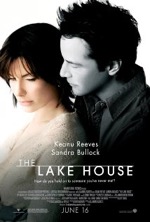
Starring: Keanu Reeves
June 2006
“Timeless Romance with ‘Speed’ Stars”
This type of movie has been done before, most notably in Frequency (2000), which starred Dennis Quaid and a pre-Jesus Jim Chaviezel as father and son separated by time but able to communicate via a HAM radio, which receives an ethereal signal boost from unusual solar flare activity in both time periods. At one point in that movie, Quaid, living thirty years in the past, places a wallet in a Ziploc bag and hides it under a loose floorboard, telling his grownup son in the future where to find it. Chaviezel immediately retrieves the wallet and uses it as a clue to track down a serial killer.
Mailing across time is taken to a whole new level in The Lake House, director Alejandro Agresti’s temporal romance starring Speed duo, Sandra Bullock and Keanu Reaves. Kate Forrester (Bullock) is a doctor at a large Chicago hospital; seeking refuge from the frenetic pace of city life, Kate moves into a lake house on the north shore. Once settled in, Kate finds a forwarding note from the previous tenant, Alex Wyler (Reaves), inside the mailbox (which becomes the focal point of the movie and the conduit through which the characters communicate with each other). Mistaking the note as a prank, Kate writes a response to Alex, sets the letter inside the mailbox and raises the flag. As soon as Kate turns to go, the flag drops. Inside the mail box is another message from Alex, ardently claiming veracity on his part and belying any notion of a practical joke. As Kate and Alex continue exchanging notes over the next few days, they make an astonishing discovery—though Kate and Alex inhabit the same physical space, they exist in two different times. Kate lives in the present day (2006), but Alex is writing her from 2004.
Though the movie’s plot is a little too convoluted at times, it’s a tight yarn with an interesting character study, particularly in Kate’s case. At some point, Kate realizes she’s falling for a man she can never have; a bitter reality that exemplifies her life and ongoing struggle to find fulfillment. One of the finest scenes in the movie is when Alex takes Kate on a virtual walk with the assistance of a map and prerecorded cassette tape; Alex’ commentary is conveyed in a series of voice-overs, and, as an architect, he describes some of Chicago’s landmark buildings in great detail. It’s a touching moment, but when complications surmount and a relationship with Alex seems more and more impossible, Kate severs all communication with Alex. Kate concludes that Alex was “just a beautiful fantasy where time stood still,” and decides to move on by letting go of the past.
The movie’s unconventional resolution caps off a moving, thought-provoking love story that succeeds by placing emphasis on plot and character and not on a contrived or commonplace romance…the fact that the leads barely encounter each other aids the movie in subtle yet powerful ways, producing yearning in the characters as well as the audience. Some mysteries remain unexplained, however; such as how the couple can communicate in the first place. It may seem coincidental that both Kate and Alex have the same pet, a female dog oddly named Jack, but I believe the canine is the key to their ability to communicate with each other across time. Jack barks and runs away when Alex’ friend, Mona, makes a pass at him and the dog leads Alex to Kate’s birthday party where couple first meet. At times, the dog almost seems sentient. Could it be that Jack (an alien or supernatural being in disguise) is orchestrating events to bring the lovelorn couple together? It’s as good an explanation as any, I suppose.
Though the pacing is slow at times, the movie has great atmosphere—Agresti makes excellent use of the breathtaking lake house set, built, according to the story, by Alex’ absentee father, Simon (Christopher Plummer). Simon’s discourse on the proper use of light in architecture is memorable, though not necessarily crucial to the story. As for Bullock and Reaves, their acting isn’t memorable in the least, but that’s exactly what the script requires…less-nuanced performances would have overpowered the plot and distracted the audience from what turns out to be a first-rate love story, garnished with a sprig of suspense and seasoned with a sci-fi paradox.
Jane Austen’s Persuasion is referenced on several occasions in the movie and that novel’s themes of waiting for the right time and receiving a second chance find modern expression in The Lake House.
So the next time you go outside to mail a letter, if your mailbox flag suddenly drops after you raise it, it’s probably just a loose screw, the pull of gravity or a stiff breeze. But just in case, check it anyway.
Rating: 3
Aeon Flux (PG-13)
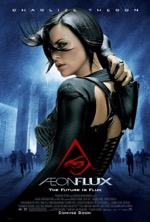
Starring: Charlize Theron
December 2005
“Won’t Even Be Entertaining in An Aeon”
Based on the MTV animated short films of the same name, Aeon Flux takes place in the distant future (the 25th century to be precise), where a domed city protects the remnant of humanity from a rapidly-evolving jungle which is reclaiming the earth. This surviving colony of humans erected the city-state to stave off the encroaching threat and provide an egalitarian existence for its denizens—the survivors of a bio-engineered virus that ravaged earth’s entire population in 2011.
Enter Aeon Flux (Charlize Theron), model citizen of Bregna by day, butt-kicking Monican (rebel) by night. Aeon’s sister, Una Flux (who came up with these names?) is executed for her suspected ties to the Monicans and Aeon accepts a mission to murder council leader, Trevor Goodchild (Marton Csokas), and thereby exact revenge for her sister’s death.
After a series of martial arts fights, Aeon finally confronts Trevor: Trevor proves his veracity to Aeon and they immediately jump into bed together. Viewing the tryst on a spy camera, Trevor’s brother, Oren (Jonny Lee Miller), stages a coup and instructs all security forces to shoot Trevor on sight. When Aeon reveals her recent, recurring nightmares, Trevor explains that the two of them were married in another life and were cloned, along with the rest of humanity, centuries ago (infertility was an unfortunate side-effect of the virus’ cure). Trevor had sanctioned cloning as a means of self-preservation, but now, new cloning methods threaten to pollute the remainder of the human race. Partnered by fate, Aeon and Trevor must retrieve his research and destroy the movie’s version of Sky Lab, called Relis Station (it’s what you get when you crossbreed a blimp and a giant jellyfish), before humanity is plunged into extinction.
As you’ve guessed by now, Aeon Flux isn’t Oscar fodder; in fact its dark, dreary and dreadful attempt at re-envisioning Aldous Huxley’s, Brave New World isn’t stylish on either end the camera unless you consider director Karyn Kusama’s penchant for fast-cuts and blurry action sequences to be the paragon of movie magic. The plot is abysmal and the dialogue is remedial—and with its high body count and gratuitous violence, there’s nothing remotely redeeming about this apocalyptic tale. The movie’s performances are as anemic as the plot: that Oscar-winning Theron would stoop to this level is utterly stupefying. Did her desire to be the next big-screen action queen prevail over her common sense? Did she sign the contract script unseen? It’s the only possible explanation. Csokas performance, as the “supposed” bad guy, is flat and passionless; he delivers his lines with as much conviction as a wet rag—which might explain why he had so few lines in The Lord of the Rings.
The special effects are solid enough in the film, but somehow the ball-bearing explosives and razor-sharp grass scenes really don’t seem all that original anymore. Where’s the innovation? It’s almost a perquisite now that action/adventure and sci-fi films must have ground-breaking effects, or compensate with a great script, A-list actors or an esteemed director. Aeon Flux has none of the above, much to its demise, and therefore, will be quickly forgotten.
God forbid there should be a sequel, but if there is, I issue this ultimatum: Either it employs a much better script or we’ll nickname it Aeon Sucks.
Rating: 1 1/2
Zathura (PG)
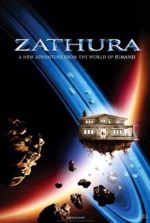
Starring: Josh Hutcherson
November 2005
“A Galaxy of Fun Awaits Those Who Can Pronounce It”
The name is Zathura…not Zanthura (as was incorrectly pronounced by blonde bombshell Jennifer M. on Apprentice 4). Based on the children’s book of the same name by author Chris Van Allsburg (Jumanji), Zathura is a lot better than it looks at first glance (the trailer doesn’t do the movie justice by a light year). Once you throw the laws of physics out the airlock—like director Jon Favreau does with great dispatch early on in the film—Zathura is a fun-filled romp through outer space and a meaningful tale of reconciliation between two quarreling brothers.
Zathura’s plot is virtually identical to Jumanji’s…kids are left home alone and they stumble upon an old board game; curiosity gets the best of them and they start playing, learning very quickly that their hasty decision might lead to their demise. Both books/movies focus on a series of turns—which become more disastrous with each successive round—where the players desperately attempt to set things back to normal while evading destructive forces or aggressive enemies that seem to materialize out of thin air. Where Jumanji featured jungle animals (including a heard of rhinos, which wreaked havoc while charging down the middle of town), Zathura offers up a universe of hazards, most notably a rogue robot that needs to be reprogrammed and the croc-like Zorgons (not to be confused with the Vorlons from Babylon 5 or the Vogons from The Hitchhiker’s Guide to the Galaxy). Each turn raises the stakes and when things look like they couldn’t possibly get any worse, the game ends and the pieces reset, but not before lives are changed and lessons are learned.
Though Tim Robbins’ presence—as a beleaguered father and sport car designer, recently separated from his wife—is barely felt in the movie, he turns in his normal, polished performance (it would have been nice to see him again at the end, however). Of Robbins’ three screen kids, teen daughter, Lisa (Kristen Stewart), is the most oblivious and superfluous character in the movie…she’s really only here for comic relief (Lisa is cryogenically frozen in her bathroom) and as an object for teenage boys to ogle at.
The two boy leads, Danny (Jonah Bobo) and Walter (Josh Hutcherson), anchor the movie, especially Danny, whose wide-eyed amazement at the wonders of the universe is the movie’s most-endearing feature. The visual of the house drifting in space is memorable, and the twist involving the astronaut is finely executed.
Zathura is much more than a glorified sci-fi role-playing game; it’s a charming and clever story that dispenses a good moral about sibling rivalry and is a fun way to get lost in space for two hours.
Rating: 2 1/2
Serenity (PG-13)
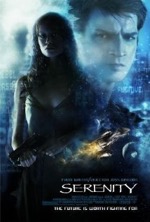
Starring: Nathan Fillion
September 2005
“There’s Nothing Serene About This Bizarre Space Western”
In 2002, Joss Whedon, of Buffy the Vampire Slayer fame, created an old west meets sci-fi TV series dubbed Firefly, which lasted less than a year (fifteen episodes, three of which never aired) on Fox. Gaining a small cult following and earning widespread praise from critics, Firefly never really found an audience and soon went the way of Birds of Prey, another truncated genre show that failed to take flight on The WB the same year. The progenitor of cancelled sci-fi shows, Star Trek, was pitched to NBC as a “Wagon Train to the stars” in the mid-Sixties. Though Star Trek and its multiple spin-offs scarcely resemble the original selling point, Firefly was the literal embodiment of that concept.
So here we have Serenity, a movie furthering the adventures of Captain Malcom Reynolds (Nathan Fillion) and his ragtag crew as they steer their equine cargo vessel (easily the ugliest spaceship I’ve ever laid eyes on) through Alliance territory with their mysterious passenger, River (Summer Glau). River has superhuman reflexes and strength (think Sydney Bristow on speed); her fight scenes are really the most enjoyable part of the film, besides Fillion’s oft-witty, off-kilter sense of humor.
As the crew ferries River to a secret destination, they have a series of misadventures while learning more about her “special” abilities—she’s a genetically engineered killing machine with telepathic abilities (wouldn’t have guessed that one). To add spice to the otherwise bland plot is the unrelenting pursuit of the cannibalistic Reavers (I knew the writers were smoking something), war-like aliens with ugly mugs and a disposition to match. The origin of the Reavers is revealed near the movie’s mid-point—they were once humanoid beings mutated by the radiation fallout of a nuclear holocaust—a sequence that harkens back to the Morlock back-story in The Time Machine (1960). However, what the scene gains in dramatic punch, it looses in originality.
As one who never saw an entire Firefly episode, I found Serenity’s learning curve a bit too steep for enjoyment, especially its customs and speech. The Southern-fried lingo is so anachronistic within the sci-fi milieu, it almost mutates the film into a comedy; not because the dialogue is particularly clever, but because the spurs and six-shooter speech is so abundant and so awkward it’s downright laughable, and that’s for sure and for certain. Also, the film’s politics are muddy and the moral relativism, “I don’t care what you believe in as long as you believe in something,” posited by the priest is as uninspired as the movie itself.
Serenity is a grim and violent piece of sci-fi that feels like a glorified TV show and will undoubtedly head straight to video as it heads off into the sunset.
Rating: 1 1/2
War of the Worlds (PG-13)
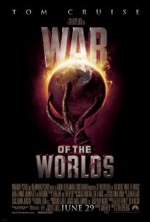
Starring: Tom Cruise
June 2005
“A Soulless Remake Filmed on Cruise Control”
Tom Cruise and Dakota Fanning under the stellar direction of Steven Spielberg in a remake of H.G. Wells’ classic story, The War of the Worlds, is a sure-fire winner, right? As we’ve seen in Hollywood this year (at the time of this writing, the box office is in its twentieth week of a demoralizing slump), all bets are off, especially in a summer replete with remakes.
Remaining fairly faithful to the source material while giving it a modern face-lift, this version of the timeless alien invasion tale takes place in New Jersey and focuses on a divorced dockworker and his two children. The plot is basically the same as all previous renditions: aliens invade earth with terrible, laser-spewing machines that wreak havoc on our cities and citizens until our environment gets the best of them. What’s new here, besides updated special effects, is a shift in perspective: Byron Haskin’s 1953 opus featured a global struggle with leading scientists and top military officers as the main characters. In Spielberg’s take, it’s all about the Ferrier family…Cruise’s deadbeat dad, Ray, Justin Chatwin’s loner-rebel son, Robbie, and Fanning’s doe-eyed daughter, Rachel. The earth-shattering, world-ending events are seen through their eyes, exclusively, and what this approach gains in intimacy it looses in soul and scope.
Even with it’s antiquated special effects, the original movie was far more riveting and fear inducing because it dealt with widespread panic and large-scale destruction. When the atomic bomb fails to leave so much as a scratch on the alien vessels, the viewers are filled with a dreadful realization—our best weapons can’t stop the alien advance. This new War of the Worlds never reaches that level of frantic intensity.
Cruise hits all of his marks but does little to advance the story in any practical or emotional sense, and Fanning has more screams than actual lines in the movie—it’s an oversight of mammoth proportions that a young actress of her caliber was relegated to looks of horror and squeals of terror. The only memorable performance in the movie is Tim Robbins’ Ogilvy, the frantic man who waves Ray and Rachel into an abandoned farmhouse—a frenzied throng is fleeing the onslaught of the tripods and only these three people think to seek refuge in the weather-worn house (more discrepancies to come). Ogilvy is one creepy cuz, but he stands out as the only three-dimensional character amid the coursing sea of cardboard humans in the picture.
As promised, here are just a few of the movie’s many inconsistencies, quandaries or just plain stupid ideas: The alien machines were underground for millions of years and only now decide to attack us? What were they waiting for? In the beginning of the movie, the machines shoot people and turn them into ashes; later on, the machines harvest people, using blood for fuel. Why the change in extermination tactics? The peanut butter sandwich scene is utterly doltish—there has to be an abundance of food in the well-appointed house. Why was so much screen time dedicated to the ferryboat panic when the tripod immediately capsized it? The alien evasion in the farmhouse is reminiscent of the kitchen scene in Jurassic Park and the aliens themselves look like cousins of the invaders in Independence Day.
One of my favorite adapted screenplay writers, David Koepp (Jurassic Park), turned in a soulless, witless script here with some genuine clunkers like the reunion scene where Robbie exclaims, “It’s me dad. It’s me dad.” It’s a shamelessly sappy moment in a supposed action blockbuster. Instead of tugging at the audience’s heartstrings, as was clearly intended, the line sends them reaching for their keys.
Maybe it’s just that the 50’s version was one of my favorite movies when I was a kid, but this new War of the Worlds fails to satisfy in nearly ever way, save for the terror-instilling, blood-curdling tripods (the finest element in the movie). Retaining the opening, mood-setting narration was a nice touch, and tapping Morgan Freeman to perform the voice-over was a masterstroke. Also, John William’s Jaws-inspired soundtrack stands out as one of the movie’s only highlights.
War of the Worlds is as mechanized and methodical as its tripods. It attempts to generate sympathy by focusing on the Ferrier’s, but fails to make the desired connection due to underexposed characters. Suggestion: Save your money and rent the original movie. Or better yet, just read the novel.
Rating: 2 1/2
Star Wars: Episode III—Revenge of the Sith (PG-13)
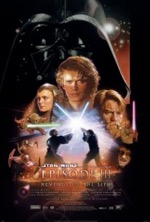
Starring: Ewan McGregor
May 2005
“Lucas Signs Off With a Vengeance”
“The circle is now complete. When you left I was but a learner. Now, I am the master.” Darth Vader’s formerly cryptic words in Star Wars: Episode IV—A New Hope now find clarity and resonance in light of the dark, tragic and force-shifting events that occur in George Lucas’ latest and last Star Wars film: Episode III—Revenge of the Sith.
For about the first fifteen minutes of the film, I thought I was in for the same pedestrian plot overshadowed by whiz-bang effects like in the last two episodes—a massive battle rages over city-planet, Coruscant, and Obi-Wan Kenobi (Ewan McGregor) and Anakin Skywalker (Hayden Christensen) dodge exploding vessels and fend off an onslaught of vulture and buzz droids—but when the Jedi warriors tag-team nefarious Count Dooku (Christopher Lee) under the watchful and gleeful gaze of Chancellor Palpatine (Ian McDiarmid), I saw the potential for the kind grand storytelling last seen in the original trilogy. The lightsaber battle is eerily similar to the one featured at the climax of Return of the Jedi, only this time, Palpatine/Sidious knows he has his man in the tortured, hate-infused dynamo, Anakin Skywalker, who beheads Dooku at Sidious’ request…unwittingly opening a position on the Sith roster which he will rapidly fill.
Rapid is a word that aptly describes Episode III, both in Anakin’s accelerated descent into the Dark Side of the force and in the film’s hyper-speed pacing. Much of the movie is typical Star Wars camp—especially the ever-leaden dialogue and passionless love scenes—but Episode III boasts several show-stopping action sequences and dramatic crescendos, including: Mace Windu (Samuel L. Jackson) and company arriving to arrest Palpatine, Anakin’s fateful choice to follow Sidious, Anakin’s cleansing of the Jedi temple, Yoda and Sidious engaging in a wizard’s duel and, of course, the final, epic showdown between teacher and pupil—a haunting scene that’s been common knowledge in fan circles since the late seventies. Add to that the gut-wrenching montage of clone troops turning on their Jedi leaders and you have a visually stunning, powerfully moving film.
What’s refreshing about Episode III is that it’s the first prequel to properly balance story and special effects. It’s been rumored that Lucas had more focus and passion this time around and you can see that renewed enthusiasm for his oft-neglected brainchild translated onto the screen. The visionary auteur has also waved his Jedi fingers to evoke a wider range of emotions from his actors this outing, except for Natalie Portman, whose lack of story involvement seems to have cued her uninspired performance. Hayden Christensen’s acting has vastly improved from his “Obi-Wan is holding me back” days; he delivers a believable, multi-layered performance that lends credibility to Anakin’s seemingly sudden transformation into Darth Vader.
Episode III’s spotlight is squarely fixed upon Christensen’s character, but the movie would have found itself charbroiled in a lava pit without stellar support from the two Mc’s. McGregor’s turn as the older, wiser Obi-Wan anchors the movie in much the same manner that Liam Neeson’s Qui-Gon Jinn did in Episode I—there’s a new level of maturity and weight to Obi-Wan and his scrappy fighting style lends personality to the movie’s static and prolific lightsaber confrontations. McGregor’s impassioned, “you were supposed to be the chosen one” monologue contains finer dialogue and more unbridled, visceral emotion than the rest of the prequel trilogy combined—it’s THE moment of the entire Star Wars myth. McDiarmid is absolutely delicious as the insidious Darth Sidious (Lucas and his names!); he’s so good at presenting the virtues of the Dark Side that he makes Anakin’s swift conversion plausible. The Scottish thespian’s sinister basso profundo is one of the best effects in the film—Sidious’ hypnotic timbre in tandem with convincing stories, like the chilling tale of Darth Pleagus, draws Anakin into his web of deception and is the solitary reason why the audience buys into Anakin’s accelerated transfiguration.
Lucas enlisted the help of his good friend, Steven Spielberg, on some of the movie’s most heart-pounding action sequences, and you can tell—no more silly pod races or droid factory chases created with an eye on the arcade. The special effects are crisper than ever (except for the constipated clone troopers), and in some cases are too refined…R2-D2 seems to undergo a series of upgrades for each new film, begging the question, “Why couldn’t he do that before?”
Pundits have said that if you’re consciously aware of the score when watching a movie, the composer has failed in his/her role of servicing, not dominating, the narrative. I never thought I’d ever write these words, but John Williams’ derivative sound track for Episode III severely disappointed me—besides recycling material from nearly every other Star Wars film, he also regurgitated the main title from The Lost World (1997) for the attack on the Wookie homeworld. The greatest living motion picture composer should have delivered a more “original” score for his final trip to a galaxy far, far away.
Episode III approaches epic status and has effectively returned the films to their space opera roots. This is arguably the best episode since the original Star Wars and is a gratifying and satisfying conclusion to Lucas’ sprawling space saga—he’s tidied up all the loose ends and signed off in grand fashion. When Obi-Wan delivers infant Luke to Aunt Beru on Tatooine in the final scene—the desert planet’s twin suns poised to dip behind the painted horizon in a familiar tableau—it doesn’t take a Sith sense to know that Star Wars has come full circle.
Rating: 3 1/2
The Hitchhiker’s Guide to the Galaxy (PG)
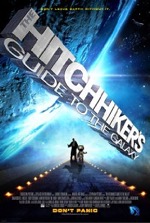
Starring: Martin Freeman
April 2005
“High Concept Fare With a Large Dose of the Bizarre”
What would you do if a fleet of bulldozers showed up on your front lawn and you were handed a legal document stating your house was to be demolished to make way for a new highway? Better yet, what would you do if you knew for certain that you only had two more minutes to live before the earth was wiped out by greedy aliens bent on destroying our planet to make way for a new intergalactic express route? If you choked on a popcorn kernel reading that last one, take this as your cue to run, not walk, out of any theater showing The Hitchhiker’s Guide to the Galaxy, the new sci-fi romp based on the best-selling book by Douglas Adams.
However, if you’re stout of heart and can stomach the vile behavior and hideous appearance of the sumo-sized bureaucrats named Vogons (or endure several minutes of their torturous poetry), you might just be in for an amusingly whimsical, albeit bizarre, journey through the warped and unpredictable reaches of outer space. In any event: “Don’t Panic!” And whatever you do, don’t forget to bring your towel.
Arthur Dent (Martin Freeman) is the hapless, witless soul who must sacrifice his house on the altar of progress, but fortunately, his good friend, Ford Perfect (Mos Def), is not from our world and beams himself and Arthur onto the Vogon mothership just before it makes meteorites out of the earth. Escaping the rusty, grimy Vogon ship is a death-defying task, but Arthur employs the wisdom of the wickedly satirical Hitchhiker’s Guide and he and Ford are soon floating free in space. Did you know that it’s possible to survive in space for a few seconds by holding your breath? Either did I.
Fortune, again, smiles upon Arthur and Ford as they’re beamed aboard a friendly vessel that just happens to be in the vicinity. The stolen, spherical ship belongs to the President of the Universe, Zaphod Beeblebrox (Sam Rockwell of Galaxy Quest fame), who has two heads/personas, a manic depressant robot named Marvin (voiced by another Galaxy Quest alum, Alan Rickman), and a girlfriend named Trillion (Zooey Deschanel), who had a brief fling with Arthur in the not too distant past. Beeblebrox is on a mission to visit mythical world, Magrathea, but along the way he runs into his campaign opponent, John Malkovich, who makes a brief appearance as the priest of a sneezing cult. Ultimately, Malkovich’s character is just a grace note in the zany script and his presence is utterly superfluous, as he never appears again in the film.
When the party finally reaches Magrathea, they discover the super-computing oracle, Deep Thought. In the distant past, Deep Thought cogitated that the answer to life, the universe and everything is 42. Now, after pondering for eons, Deep Thought will reveal the “ultimate question.”
If all of this is a bit difficult to follow (or swallow), it’s because Adams’ story is dense and shallow at the same time. The story’s aliens, customs, planets, etc. are all well thought-out and fully realized, but the character development is spare and many plot elements are bizarre, ludicrous or obnoxiously random. Here are just a few examples: Dolphins, the third most intelligent species on our planet, have been trying to warn us of our impending doom for years, but we’ve misinterpreted their attempts at communication as playful flips and tricks. On the Vogon homeworld, giant flyswatters pop up out of the desert sands and smack unsuspecting travelers in the face (the scene is actually pretty humorous). An omniscient being—who just happens to have a spare earth sitting around—tells Arthur that it’s mice, not men, who really rule our world. My favorite oddity, however, is the “Improbability Drive,” an obvious poke at Trek’s warp drive, which spews the ship out into alternate realities—the “yarn universe” sequence is nothing short of genius.
For all its inherent strangeness, The Hitchhiker’s Guide to the Galaxy has several saving graces—it’s witty, clever and wildly imaginative. This makes the movie viewable, if not instantly accessible. It will be interesting to see if Hitchhiker’s ticket sales will permit us to visit The Restaurant at the End of the Universe.
Rating: 2 1/2
The Forgotten (PG-13)
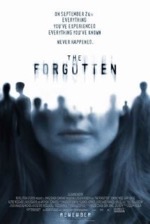
Starring: Julianne Moore
September 2004
“Solid Start, Forgettable Ending”
For three quarters of the movie, I was utterly gripped by the intriguing scenario and rampant paranoia that courses through this unconventional thriller. The film is made even more powerful by believable performances from Julianne Moore, Gary Sinise, Anthony Edwards and Alfre Woodard. Unfortunately, acting is the only element that is believable in the movie, as the story takes a significant left turn near the coda, destroying any momentum established in earlier acts.
Telly Paretta (Moore) lost her pre-teen son, Sam, in a plane crash and hasn’t been able to move past said traumatic event ever since that fateful day. Her memory of her son hasn’t faded one iota since his passing, but every item (picture, articles of clothing, etc.) of Sam’s has begun vanishing…one piece at a time. She accuses her husband (Edwards) and her shrink (Sinise) of conspiring to erase all traces of Sam’s former life. According to the two men, Telly never had a son, a revelation that becomes even more disturbing when she finds no records of the plane crash at her local library. Telly confronts her neighbor, a middle-aged drunk (Dominic West) and helps him remember his daughter that was also on the same plane. Together, Telly and her newfound friend seek to uncover this sinister plot that’s wiped away all physical evidence of their children’s existence. These events set up an interesting question in the viewer’s mind: is Telly crazy, or is some outside agency seeking to discredit and/or mentally destroy her?
Such an intriguing notion should have led to a riveting climax, but instead, the balloon deflates when an otherworldly twist is introduced into the plot. The children were abducted by aliens? This was all one big experiment to test the depths of the maternal instinct?? Even by its own rules, the “alien” subplot doesn’t hold up under scrutiny. How can aliens—with the ability to abduct a plane full of children, erase people’s memories, “beam” people up to the mother-ship and, indeed, even put events back to the way they were before the incident—be hampered by a time constraint on their test? If they can manipulate time, shouldn’t they be able to run the same test on the same person indefinitely? Time is relative, after all.
Therein lays the problem with The Forgotten. Tough hackneyed, a government conspiracy or scientific cover-up would have been a much more satisfying conclusion to such a solid foundation. Even though the special effects are few, they’re groundbreaking and breathtaking. Those scenes, combined with fine performances are the only things that keep the movie from becoming utterly forgettable.
Rating: 2 1/2
Sky Captain and the World of Tomorrow (PG-13)
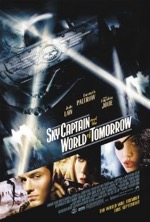
Starring: Gwyneth Paltrow
September 2004
“Long on Title, Short on Plot”
The “1/2” is for a solid cast, overall creativity and the groundbreaking manner in which the movie was filmed. The “two” is for an average tale that is further diluted by props, machines and plot devices that are so farcical and fantastical that they become a huge distraction—even to this reviewer, who can normally suspend his disbelief to the final frontier and beyond.
If Sky Captain and the World of Tomorrow could be distilled into one word it would be “derivative.” The movie borrows from many genre films and borders on plagiarism. Sky Captain (Jude Law) has a dash of Han Solo and a wardrobe similar to Indiana Jones’. And speaking of Indy, Raiders of the Lost Ark rip-offs abound, like the plane flying over the map trick or a fateful trip to the snow-capped mountains of Nepal. The attack on the hangar is suspiciously similar to the one seen in Pearl Harbor. Inside the hanger, as those with a steely eye will observe, is a T.I.E. fighter cockpit from Star Wars. The many plane/ship upgrades are an elaborate tip of the hat to the James Bond movies and the bizarre creatures on the tropical island look like they escaped from Jurassic Park. The robots themselves look like cousins of the Iron Giant and the mechanical, whirring noises they make are like something right out of the sound library from the original War of the Worlds. Also, Dex’s (Giovanni Ribisi) ray gun resembles a Buck Rogers sidearm.
Then there’s the plot. Dr. Totenkopf (canned footage of the late Sir Lawrence Olivier—one of the movie’s only masterstrokes) abducts all of the brilliant scientists previously involved in a top secret project and forces them to create giant robots and other such machines of mass destruction. Totenkopf’s ultimate goal is to create a second ark (rocket ship), which will ferry all of Earth’s animals (plus a few of his own creations) to a new planet, free from the evils of this present world. Trick is, all life on earth will be incinerated when the ship’s rockets burn up our atmosphere—proper judgment for the way we’ve mismanaged the planet. And it’s up to Sky Captain and his Swiss Army plane, along with his bickering partner, Polly Perkins (Gwyneth Paltrow) and his old flame, Franky Cook (Angelina Jolie) to save the day.
Hokey? You bet! And it’s a shame, because the movie features good characters with good dialogue, performed by good actors. The effects are nothing short of amazing and the visual style is moody and unique. If anything holds the movie back it’s the contrived storyline. In the final analysis, Sky Captain and the World of Tomorrow is a brilliant disappointment.
Rating: 2 1/2
AVP: Alien vs. Predator (PG-13)
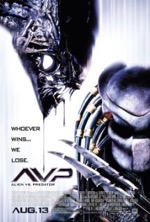
Starring: Sanaa Lathan
August 2004
“Lots of Hype, Not Much Bite”
“Whoever wins, we loose.” The movie’s slogan refers to the humans in the movie, but can just as easily apply to those in the audience…especially if you’ve paid full price. Alien vs. Predator, or AVP, is a lackluster affair that creates a patchwork plot from the highlight reels of the Alien and Predator series. There’s little innovation here, just a few new faces, namely adventurer, Alexa Woods (Sanaa Lathan) and wealthy industrialist, Charles Bishop Weyland (Lance Henriksen) and some updated special effects.
A plot device that runs through both series is that all the secondary characters get thrashed and one main character, somehow, escapes certain death. Be it Sigourney, Ah-nold, or Danny, they all found a way to beat their extra-terrestrial nemeses and in some cases, earned their respect along the way (and in Sigourney’s case, held on just long enough to make a sequel).
AVP’s premise is simple: Weyland discovers an ancient temple beneath the frozen surface in Antarctica. Before his drill team arrives, they discover a shaft has already been cut down to the temple (that should be their first clue to leave the premises). Upon entering the ancient remains, the team learns two valuable bits of information: 1, there’s an Alien hatchery in one of the chambers and 2, the Predators have arrived to do some hunting. The twist: the humans unwittingly steal the Predator’s special weapons, and without them, the Aliens just might be able to defeat the Predators and overrun the earth (oh no).
The story employs a cheesy gimmick (just one, you ask?) with the labyrinthine halls inside the temple; the chambers keep shifting like a giant Rubik’s Cube, separating characters and throwing some right into the path of razor-sharp incisors. The temple reconfigures every ten minutes, which is convenient since that’s the rate at which the humans are being slaughtered. The character development is weak for one reason, the writers don’t want the audience to become too attached, because they’re all gonna’ die anyway.
A motto that’s tossed around too often, and much too frivolously, is, “The enemy of my enemy is my friend.” The Predators have butt-ugly mugs and fight like members of an intergalactic gang, but they do have a code of honor: they won’t kill Weyland because he’s dying of a fatal illness and they show their respect to Woods after she helps kill Big Mama Alien (the trophy ceremony is virtually identical to the one in Predator 2).
Beyond the abysmal plot, there’s nothing redeeming about the movie, save for the brief camaraderie between human and Predator, which brings up an unanswered question: are we friends with the Predators now? Are the Predators getting soft or is it just the screenwriters?
Rating: 2
I, Robot (PG-13)
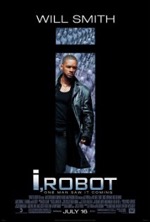
Starring: Will Smith
July 2004
“Near-future Thriller With More Than Artificial Intelligence”
I have to admit, I, Robot was a lot better than I thought it was going to be. The script was “suggested” by Isaac Asimov’s classic book of the same title, but bears little resemblance to the original, save for the three laws of robotics and how a conflict in logic makes robots go haywire.
The movie opens with the suicide—later determined to be a homicide—of Dr. Alfred Lanning (James Cromwell), and detective Del Spooner (Will Smith) is called in to investigate. Spooner, who detests robots, soon picks up the trail of the fugitive robot and, after an extensive chase scene, brings the artificial man to justice. What Spooner uncovers in his investigation, however, is just the tip of the proverbial iceberg and a much bigger, sinister plot threatens to unleash itself upon the futuristic version of Chicago, circa 2035. Dr. Susan Calvin (Bridget Moynahan) is the only one who believes Spooner’s paranoid theory (no robot has ever killed a human before) and, along with the assistance of good robot, Sonny, helps Spooner fight off hoards of renegade robots while attempting to destroy the faulty computer brain that has turned the new NS-5s into aggressive, killing machines.
Smith doesn’t swagger as much in I, Robot as in Independence Day or the Men in Black films. There’s a bit more depth to his character this time around and Smith brings a maturity of craft to bear upon the part as the android-loathing detective—a role both emotionally and physically demanding.
The special effects in I, Robot are top notch and the near-future technology is especially ingenious: like holographic caution tape, futuristic freeways and cars (some with perfectly circular tires) and, of course, the eerily human-looking robots. Though visually tantalizing, I, Robot is derivative of other sci-fi extravaganzas: the armies of robots harkens back to the armies of battle droids in Star Wars: Episode I, or the throngs of clone troops in Star Wars: Episode II. Also, V.I.K.I, the main computer in control of all NS-5s, invokes marshal law and starts taking over the city by force—“humans must be governed for their own good,” the cold, logical, positronic mind reasons. This is the prelude to a scenario not unlike the Skynet tragedy as featured in the Terminator trilogy.
Even though it’s less than original, I, Robot is a great action flick that keeps you on the edge of your seat with an unexpectedly good storyline and I-popping I-candy to go with your popcorn.
Rating: 2 1/2
The Day After Tomorrow (PG-13)
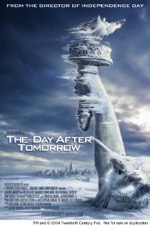
Starring: Dennis Quaid
May 2004
“Farcical, But a Fun Ride”
The eighties gave us The Day After, a story about the bitter reality of a nuclear holocaust. Now, the new millennium has delivered us a fresh breed of disaster film in The Day After Tomorrow, which brims with a variety of natural calamities and an amazing array of effects to bring them to life.
Granted, the movie is much more enjoyable when you suspend your disbelief right from the opening credits. As unbelievable as it is to accept that global warming can cause an ice age, it's even more of a scientific fallacy to think that an ice age will expend itself after just one week. But that's exactly what happens in Roland Emmerich's (Stargate and Independence Day) big budget, big name flick that stars Dennis Quaid and Jake Gyllenhaal.
Here's the Reader's Digest version: Jack Hall (Quaid) is a renowned paleoclimatologist (say that ten times fast and I'll buy you a sno-cone) who predicts a coming catastrophe due to radical climate shifts. Jack's son, Sam (Gyllenhaal), is on his way to New York City to compete in a high school academic competition. Of course, that's when the earth goes into an epileptic fit, releasing tornadoes in Los Angeles, forming massive tidal waves in Manhattan and unleashing uber-blizzards at the poles.
The rest of the movie is about survival and the human condition in severe conditions. Jack and his two partners strike out to rescue Sam and his classmates, who have retreated into the warmest room of the New York Public Library and have been burning books to stay warm. Jack's vehicle breaks down just outside of Philly, and he walks the rest of the way to Manhattan over snow and ice in just a couple days (is your disbelief still suspended?). In the end, Jack rescues his son, but the resolution is bittersweet because the northern U.S. is now an icebox.
Other than special effects, I don't see The Day After Tomorrow winning any major awards, and there are several reasons why. Even with shallow character development (Sela Ward and Ian Holm were tremendously underserved), a derivative plotline and shoddy science, the biggest injustice in the film is its blatant political agenda. However extreme and speculative, the environmentalists have made their point about the side effects of mass energy usage.
The movie became a platform and to its own detriment—The Day After Tomorrow would have been much more enjoyable without the sermon on conservationism. And what about the other message during the reverse-immigration scene, when thousands of Americans flood into Mexico, seeking warmer environs and the ensuing politically correct speech delivered by the newly-promoted president of the U.S.? Again, The Day After Tomorrow was a great popcorn movie, but these "preachy" moments made me choke on a kernel. Oh, and one more thing, what business does a wild pack of wolves have roaming into a disaster picture?
Rating: 3
Godsend (PG-13)
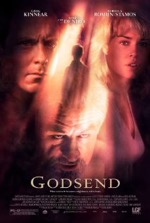
Starring: Robert De Niro
April 2004
“Disturbing for the Sake of Being Disturbing”
This is a hard movie to rate. On the one hand, Godsend is an excellent movie when it comes to acting, directing and screenwriting. However, it’s so dark and disturbing, and devoid of any kind of virtue or edification, that the natural tendency is to grade down. This isn’t the first time a movie of this genre has been produced, and there certainly have been finer examples, (i.e. The Sixth Sense and What Lies Beneath), but the fresh angle here is the salient topic of cloning and genetic manipulation.
If there’s any saving grace to Godsend, it’s that it paints a graphic picture of the potential terrors that await us as scientists continue flirting with genetics. Whereas Jurassic Park was frightening because it revealed the dangers of cloning dinosaurs, Godsend is even more terrifying because it deals with re-creating a human being.
Here’s the scenario: Paul and Jessie Duncan (Greg Kinnear and Rebecca Romijn-Stamos) loose their eight-year-old son, Adam (Cameron Bright), in a car accident. At Adam’s funeral, Dr. Richard Wells (Robert DeNiro), approaches the Duncan family and offers them a chance to get Adam back through a cell cloning process he has recently perfected. Reticent at first, the Duncan’s break down and ultimately agree to go through with the process. Eight years later, after the second Adam (the symbolism is as subtle as a 2X4 to the head) grows past the experiences of his predecessor, new memories and behaviors begin to emerge. It’s later discovered that the new personality comes from Dr. Wells’ deceased son—Wells introduced some of his son’s D.N.A. into Adam’s—who just happened to be homicidal and suicidal (he burned a school to the ground around him along with other students and teachers). The ending doesn’t really resolve anything and leaves everything wide open to individual interpretation, making it the weakest link in an otherwise thought-provoking script.
The first half of the movie is a bit slow, but does a good job of painting the main characters, their dilemma and their fateful choice. But, the second half of the film is little more than a horror movie in the vein of Bad Seed or The Good Son. Godsend services the audience by presenting a human cloning experiment gone horribly wrong, but it does a disservice by remaining morally ambiguous—presenting a case where cloning was bad “in this instance” because of D.N.A. tampering. It’s one thing to clone an animal and quite another to clone a human, or to put it a different way, we can clone a body, but can we clone a soul? This is the kind of moral/religious question the movie conveniently avoids, and maybe the safer route is the better one—after all, it’s just a movie.
Godsend is anything but, and manufactures goose bumps with haunting dream sequences, musical flourishes and things that jump at the camera. It’s a wild ride, but certainly isn’t for the faint of heart.
Rating: 2 1/2
Paycheck (PG-13)
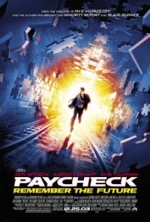
Starring: Ben Affleck
December 2003
“Futuristic Thriller With a Twist”
Part spy thriller, part sci-fi movie, “Paycheck” is one hundred percent action flick that starts out at a fevered pitch and never slows down. Based on a short story by Phillip K. Dick (Blade Runner), “Paycheck” introduces an inventive, yet disturbing, vision of the future; a “what if” scenario. What if highly trained computer experts and bio-engineers were implanted with a marker at the beginning of a top-secret project and, when the job was completed, their memories were wiped all the way back to the point of marker insertion? What if you lost three years of your life (memories), but received remuneration for your services somewhere in the ballpark of eight figures? But what if the project you worked on was illegal, and the F.B.I. shows up and you have no memory of what you’ve been doing for the last three years?
Michael Jennings (Ben Affleck) is on the run from his former employer and the feds., and all he has to aid him in his search for answers to the past is a manila envelope filled with a dozen ordinary items that he had the foresight to send himself before the memory wipe. A latent memory of a significant other leads Michael to Rachel (Uma Thurman), the one person who can help him get back into the lab and destroy the machine that he built…a device that will lead to great catastrophe in the future.
Oversimplified? Far-fetched? A bit confusing? You bet! But if “Paycheck” has any redeeming quality, it’s that it doesn’t linger in one place too long. John Woo (Mission Impossible 2) does a good job of building intensity and sprinkling in action sequences at appropriate times until the explosion-filled climax.
Ben Affleck has tried his hand at being the lead in a thriller before (The Sum of All Fears), but his low-key—almost passionless—portrayals will prevent him from becoming an action star for the foreseeable future. Uma Thurman, a fairly well respected actress in drama, comedy and action circles adds very little to the movie—her vanilla performance will be forgotten shortly after the movie vacates theaters.
Even with mediocre elements, “Paycheck” somehow, inexplicably, manages to become more than the sum of its parts. This is, undoubtedly, due in large part to the genius of the source material the movie draws upon, proving once again that a slightly above average story can bail out average performances. “Paycheck” is a good popcorn movie that works great after you’ve suspended your disbelief, and works even better when you’ve only paid the matinee price.
Rating: 2 1/2
Timeline (PG-13)
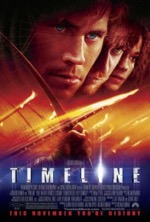
Starring: Paul Walker
November 2003
“Mediocre Romp Through Time”
A faithful (if greatly abridged) adaptation of Michael Crichton’s novel of the same name, Timeline is a fun, popcorn movie that entertains but doesn’t trick you into thinking that it’s a major blockbuster hit…because it’s not. It is, however, a great way to get lost in the past for two hours.
The story breaks down like this: a well-financed tech company (ITC) has discovered a way to send someone back in time. Professor Johnston is trapped in France in the year 1357, and it’s up to his son, Chris, and Chris’ history-buff companions to rescue the professor from a life in the past. To add tension and urgency to their quest, the team only has six hours to retrieve the professor before they are automatically returned to the present day. And, to make matters worse, the group arrives on the day of a massive battle between the English and French armies, and they’re trapped on the loosing side.
There’s no one area of Timeline that’s spectacular, but as a whole, the movie works quite well. The acting is decent, though most of the faces are unfamiliar, save for Paul Walker (2 Fast 2 Furious) and Neil McDonough (Minority Report). The historical costumes, sets and props all look authentic and the directing by Richard Donner (Lethal Weapon) is deft; though, the movie lags in a couple of places. The ending battle sequences are excellent, revealing the more visceral side of combat in the fourteenth century—the catapult shots and flaming arrow scenes were riveting.
If there’s a downside to Timeline, it’s the cursory character development and lack of scientific explanations with regard to the time machine. Granted, there isn’t enough time in a two hour movie to delve into every aspect of how the time machine was built and operates, but the fact that it does exist is treated in such a “by the way” manner that it diminishes its role in the movie and undermines the credibility of the movie as a whole.
In the novel, Crichton takes the time to give a point-by-point explanation of the machine and the science that governs it—the idea of faxing a copy of a person back in time is absolutely brilliant. In the movie, however, that concept is only hinted at and the writers, instead, have chosen to use a wormhole attuned to 1357 as the conduit for transportation to the past. Since the method of time travel is vague and confusing, it’s hard to buy into anything that happens in the past, and that’s the major problem with Timeline. With the complexity of the science involved and a larger ensemble of characters to develop, this is probably one Crichton novel that shouldn’t have been translated into a movie. I suppose time will tell.
Rating: 2 1/2
The Hulk (PG-13)
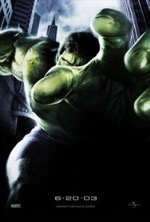
Starring: Eric Bana
June 2003
“Dark, Depressing, Distracting and Disappointing”
The Hulk is a big, jumbled mess that is so preoccupied with being the next big-screen sensation that it fails to entertain in nearly every way. Ang Lee’s avant-garde directing style is so distracting (relentlessly accosting the viewer’s eyes with a variety of wipes, split-screen or multi-panel effects), that it should be mandatory for the box office tellers to hand out two aspirin with each movie ticket.
This version of The Hulk is based on the comic book, not the 70’s TV show, and is the worse for it. In the TV version, Bruce Banner would transform into the Hulk if he broke his finger, or if he was attacked, or if he saw someone being victimized and “got angry.” In the movie, Bruce has no such catalysts for transformation; but becomes the Hulk when “repressed memories” (puh-leez) from his childhood trigger a physiological response and turn him into the not-so-jolly green giant.
The comic incarnation established that the Hulk has the ability to leap/bound three miles at a time, and whereas this is probably really cool on the page, it’s cheesy as heck on the silver screen. To make matters worse, the Hulk jumps from one mountaintop to another for close to five minutes, producing dizziness and thoughts such as, “Okay, I get the point already!” Another trait that doesn’t lend itself to the believability of the film is the Hulk’s immense size; he’s several feet taller than his comic book alter ego and simply looks too large.
The film’s pacing is excruciatingly slow, especially in the beginning, where the audience has to wade through nearly an hour of exposition before the Hulk’s first mutation, and most of the back-story is boring and confusing. Good storytelling involves showing, not telling, but The Hulk takes this principle to absurd extents…way too many things are left unexplained. Like, was there really a nuclear blast in the past or was that just a part of little Bruce’s horrific memories? Or, what in the world does David Banner turn into at the end of the movie (some kind of ectoplasmic balloon)?
If there’s a bright spot in The Hulk it’s the acting. Eric Bana is surprisingly convincing as the Hulk; he doesn’t allow over-emotionalism to stilt his performance. Jennifer Connelly is good as Betsy Ross, but her role certainly isn’t Oscar-worthy, and her on-screen father, General Ross, is played to the hilt by the rugged, no-nonsense, Sam Elliot. Nick Nolte portrays David Banner (or is he just playing himself?), a mad-scientist type who clearly has some mental and emotional issues to work through—kudos to the casting director.
The biggest failure in The Hulk is the disservice it pays to its target audience—young boys. The Hulk never once uses his super-human abilities for constructive purposes, but rather, destroys anything and everything in sight without the slightest consideration or compunction: there’s nothing heroic in the Hulk’s actions and he becomes little more than an oversized thug in the movie. Seething anger and unbridled hatred fuel this version of the Hulk, and as such, makes him a poor role model for kids.
The final word: as corny as it was, the 70’s TV show was infinitely more believable, and ironically, more entertaining than this new, unimpressive knockoff.
Rating: 1
X2: X-Men United (PG-13)
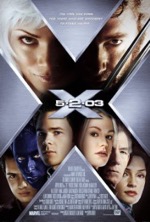
Starring: Patrick Stewart
May 2003
“Mutants Unite…and Go Nowhere”
As sequels go, X 2 succeeds on several levels—most notably with the addition of Nightcrawler (Alan Cumming) and a broader array of special effects—and has established the enduring comic mythos as a viable movie franchise. Clearly paving a path for another sequel (can you say, Phoenix?), X2 has all of the requisite action sequences and pyrotechnics necessary to achieve blockbuster status. But, amid the media hype and fan fervor, a question arises: “Is the sequel as good as the movie it evolved from?”
At the end of the first X-Men movie, Professor Charles Xavier (Patrick Stewart) boldly states to his one-time-friend and archenemy, Magneto (Ian McKellen), that he pities anyone who “comes to that school looking for trouble.” The school in question is the good professor’s academy for gifted youngsters, and someone does show up—with several dozen special ops. troops—and kidnaps a few of the young mutants. The mastermind of the attack is Stryker (Brian Cox), a retired military genius, who later abducts Prof. X and hatches his plot to annihilate all of mutant-kind. Along the way, we discover that fan-favorite, Wolverine (Hugh Jackman), was actually physically altered (implanted with adamantium plating) by Stryker, who unleashes Lady Deathstryke (Kelly Hu) on the lupine warrior, and a whirlwind battle ensues between Wolverine and Stryker’s newest creation. Multiple melees erupt in the film’s climax; a dam breaks, a X-man defects to the dark side and a X-woman meets an untimely demise.
All in all, X2 is an action-packed movie with some cultural relevance and a few moments with a human connection. The “Gee Whiz” factor is quite high on X2, but it fails to capture the clarity and intimacy of the original. The greatest contributor to this problem is the ever-growing pantheon of mutants. My biggest contention with the Batman films was the way the producers/writers packed the sequels with multiple villains, effectively splitting the audiences’ attention, and thereby, diminishing the impact of the antagonists. Here, the movies are overstuffed with good guys—keeping track of names, powers and current locations of the heroes becomes a chore even for the aficionados among us. And ultimately, despite all of the movie’s thrills, chills (Iceman) and spills, X2 never really goes anywhere, but merely opens the door to another chapter in the continuing war between humans and mutants.
X2 is popcorn entertainment that adequately moves the series forward, but hopefully the next mutation will involve a better script.
Rating: 2 1/2
Star Trek: Nemesis (PG-13)
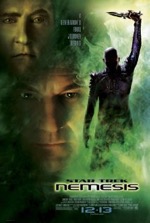
Starring: Patrick Stewart
December 2002
“Trek to the Edge”
Nemesis, the tenth installment in the Trek franchise is anything if not high octane. All the regulars are back (including a meaner-looking Enterprise), and the thrills and twists keep coming at an unrelenting, slightly sub-Star Wars pace. Several major shocks to the system occur near the climax of the film’s near-epic plot, which leave the viewer wallowing in a pool of bittersweet disbelief.
The picture gets out of the starting blocks a bit slowly with a wedding between two principal characters, Riker and Troi (Jonathan Frakes and Mirina Sirtis), and a slogging sub-plot that brings Captain Picard (Patrick Stewart), Data (Brent Spiner) and Worf (Michael Dorn) to the desert planet of Kolarus III, where they encounter the disassembled remains of B-4, an android identical to Data (also played by Spiner).
Meanwhile, a coup d’etat is brewing on Romulus (home to Trek’s first villains), hatched by the warmongering natives on the sister-world, Remus. The Reman Viceroy (Ron Pearlman) once became guardian and protector to a young human boy in the dilithium (think gasoline for starships) mines of his homeworld, where oppressive Romulan guards bred resistance and animosity into the Reman and his young charge, Shinzon.
Now an adult, and self-proclaimed Praetor of Romulus, Shinzon (Tom Hardy) invites Picard and the Enterprise to the new Romulus under a banner of peace and under the watchful gaze of the Viceroy and his “predator” warbird, Scimitar. After a vis-à-vis fraught with tension, Shinzon is revealed as Picard’s clone—a failed experiment of the Romulan government, which intended to swap Picard with Shinzon when he was of age.
Events escalate when Shinzon—now rapidly aging—reveals his plot to annihilate the earth with outlawed thalaron radiation. A final showdown ensues between the Enterprise, the invisible Scimitar and some unexpected guests.
Nemesis is a grand Trek, painted on a large canvas. It’s fairly easy to detect plot and tone similarities between this film and screenwriter John Logan’s previous, Academy award-nominated, script for Gladiator. What works particularly well here is the duality of Picard and his alter ego, Data and his doppelganger and their significance to the plot (even Remus has light and dark halves).
However, for all of its surprises and salience, Nemesis still falls short of the “perfect” Trek: the dénouement is emotional, but somewhat uncertain where the Enterprise crew, as well as the future of the franchise, is concerned. This is only the second PG-13 rated Trek movie, and one can’t help wonder if that other film, First Contact, wasn’t a better example of high-powered Trek.
Rating: 3
Solaris (PG-13)
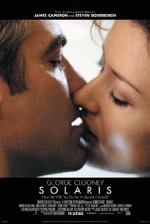
Starring: George Clooney
November 2002
It’s not often that I utterly despise a sci-fi movie, but here’s the exception. Dark, claustrophobic and static (not to mention, boring), the movie has no redeeming qualities. Solaris is pure, mind-numbing existentialism.
Rating: 1
Signs (PG-13)
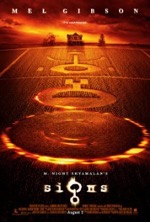
Starring: Mel Gibson
August 2002
From the writer/director/producer of The Sixth Sense, Signs is a taut thriller that delivers on its promise to keep you on the edge of your seat. Hitchcock would be proud of this effort, which harkens back to V and War of the Worlds, yet maintains its own identity. Signs has a great twist ending and a faith-affirming moral.
Rating: 3
Men in Black II (PG-13)
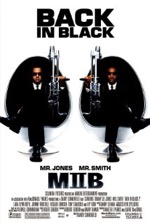
Starring: Tommy Lee Jones
July 2002
The animated short about the Chub Chubs was much more entertaining than the M.I.B. sequel, which suffered from an anemic plot and scant, if not non-existent, character development. I’d already seen the best scenes in the trailer. This one is mediocre at best.
Rating: 1 1/2
Minority Report (PG-13)
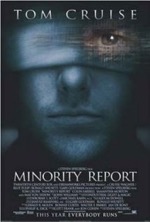
Starring: Tom Cruise
June 2002
This is the first film in 2002 to deliver on all the hype and actually offer quite a bit more. An oft-dark vision of the future, Minority Report posits the notion that you can change the future; a powerful message even without the excellent plot and eye-popping effects.
Rating: 3
Lilo & Stitch (PG)
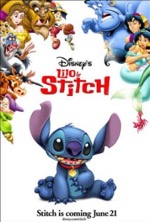
Starring: Daveigh Chase
June 2002
Lilo & Stitch is at its best when dealing with friendship and family and at its worst when it tries to be funny and when it tries parodying Men in Black. Lilo & Stitch isn’t Disney's finest, but it’s entertaining just the same.
Rating: 2 1/2
Star Wars: Episode II—Attack of the Clones (PG-13)
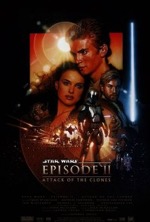
Starring: Ewan McGregor
May 2002
I instantly liked this movie and maintain that it’s a hyperspace jump ahead of Episode I. Christensen’s acting left me cold, but Attack of the Clones has some semblance of a plot with a couple of major twists near the end. Verdict: Better than Episode I, not nearly as good as the original trilogy.
Rating: 3
Clockstoppers (PG)
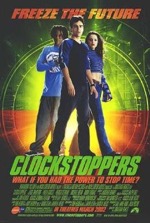
Starring: Jesse Bradford
March 2002
A little on the pedestrian side, Clockstoppers succeeds at being a first-rate teen movie that never takes itself seriously and has a lot of fun—if not campy—moments along the way. There’s nothing Oscar-worthy here, just a fun, family flick.
Rating: 2
The Time Machine (PG-13)
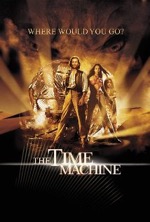
Starring: Guy Pearce
March 2002
This modern take on H. G. Wells' classic sci-fi novel has some new plot twists and a new romance, but doesn’t have the soul of the original. At the end, the time traveler may have had a promising future, but as a viewer, I had unfinished business in the past.
Rating: 2
K-PAX (PG-13)
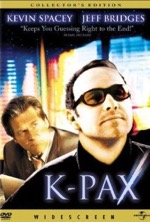
Starring: Kevin Spacey
October 2001
K-PAX is a slightly off-kilter movie that's enjoyable just for that reason. Bridges and Spacey deliver fine performances and the plot is engaging enough to keep you guessing until the emotional climax. The message K-PAX leaves you with is powerfully poignant.
Rating: 3
Planet of the Apes (PG-13)
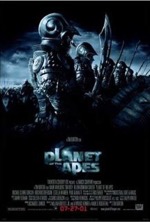
Starring: Mark Wahlberg
July 2001
This new Planet of the Apes doesn't have it all, but it has enough engaging elements to make me recommend it. Character development is predictably weak, but the plot is surprisingly solid and kept me guessing right up to the final, fateful twist.
Rating: 2 1/2
A.I. Artificial Intelligence (PG-13)
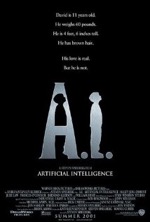
Starring: Haley Joel Osment
June 2001
Two diametrically opposed directing styles collide in A.I., producing a moody, avant-garde film. Every aspect of the movie soars except for the story, which makes the movie memorable for its unfulfilled potential. Osmet is a gem.
Rating: 2 1/2